Preferred Citation: Gibbons, Mary Weitzel. Giambologna: Narrator of the Catholic Reformation. Berkeley: University of California Press, c1995 1995. http://ark.cdlib.org/ark:/13030/ft9n39p3vz/
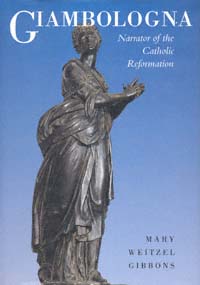 | GiambolognaNarrator of the Catholic ReformationMary Weitzel GibbonsUNIVERSITY OF CALIFORNIA PRESSBerkeley · Los Angeles · Oxford© 1995 The Regents of the University of California |
For my
grandchildren
and their
parents
and in memory of
their father
Preferred Citation: Gibbons, Mary Weitzel. Giambologna: Narrator of the Catholic Reformation. Berkeley: University of California Press, c1995 1995. http://ark.cdlib.org/ark:/13030/ft9n39p3vz/
For my
grandchildren
and their
parents
and in memory of
their father
Preface and Acknowledgments
I first became interested in Giambologna's reliefs in 1974, in a graduate seminar at Rutgers University given by Virginia Bush. Of all the Florentine sixteenth-century reliefs I studied at that time, Giambologna's seemed to me the most striking, though they were, as I later discovered, surprisingly little known. Eventually my research focused on a cycle of reliefs that was part of the Grimaldi Chapel, a significant monument of Giambologna's later years. This book continues and develops my study of this monument. In several talks on the Grimaldi reliefs, I have had the opportunity to expand my thoughts, to probe the political and religious context out of which the works came, and to understand more fully Giambologna's brilliant exposition of narrative in this Passion cycle. This little-plumbed side of Giambologna's art has been so compelling that I continue to be absorbed in it and hope that this book will bring it more of the attention it deserves.
The staffs of libraries and archives gave me invaluable assistance: the Harvard Center for Renaissance Studies at Villa I Tatti; the Kunsthistorisches Institut and the Archivio di Stato in Florence; the Marquand Library, Princeton University; the New York Public Library; the Frick Collection; the Institute of Fine Arts Library, New York University; the Avery Library, Columbia University; the Spear Library, Princeton Theological Seminary; the Burke Library, Union Theological Seminary, New York; the Bibliothèque Nationale, Paris; and the Civica Biblioteca Berio, Archivio di Stato, and Archivio Storico di Comune in Genoa.
Countless friends and colleagues have generously helped—especially Pamela Askew, William Barcham, Olga Berendsen, Kathleen Weil-Garris Brandt, Phyllis Caroff, Gino Corti, James Draper, Nicolas DeMarco, Carol and Roberta Flechner, Mary Ann Graeve Frantz, Constance Greiff, Brian Henry, Monica Hirsch, Katherine Krupp, Susan Kuretsky, Mary Lang, Sarah Blake McHam, Leatrice Mendelsohn, Derek Pearsall, Elizabeth and Vittorio Romani, Pamela Sheingorn, Catherine Stecchini, the late James Stubblebine, and Stephen Zwirn.
For help in procuring photographs I would like to thank Mirta Barbeschi, Karen Edis-Barzman, JoAnne Bernstein, Piero Boccardo, Franco Boggero, Ida Maria Botto, Michael Bury, Roberto Ciardi, Janet Cox-Rearick, the late Gian Vittorio Dillon, Maria Galassi, Louise Gibbons, Marcia Hall, Sante Lanzi, Ornella Francisci Osti, Antonio Quattrone, Jack Spalding, Laura Tagliaferro, Richard Tuttle, and David Wilkins.
My readers, Malcolm Campbell, George Gorse, and Sheila ffolliott, have given the kind of encouragement, constructive criticism, and valuable suggestions I had hoped for but never expected. They played an important part in improving the book.
The Fine Arts Editor of the University of California Press, Deborah Kirshman, gave me encouragement and constructive criticism, as I completed the manuscript for this book. Her assistant, Kimberly Darwin, helped me with endless details. Stephanie Fay edited the manuscript with a keen eye, patience, and unflagging care. And Nola Burger created a sensitive and lively design.
Finally, I thank my children, David and Elizabeth, who helped me keep my ultimate goal in sight through their gentle prodding.
Chapter 1—
Preview
Giambologna (1529–1608) has been considered the quintessential sculptor of the late maniera, his so-called art statuary exemplifying the refined taste of the Medici court from 1570 until his death.[1] Scholarly attention has focused on famous designs of his, such as the Rape of the Sabines (Fig. 1) and Mercury (Fig. 2), that circulated throughout Europe in small bronze replicas. The virtuosity and popularity of Giambologna's designs have fostered the assumption that he had little or no concern for subject matter. Giambologna's obvious involvement with sculptural technique and composition has led to assessments of his work like that of Charles Avery: "His lack of concern with specific subject matter or deep emotional expression . . . left him free to concentrate on the technical aspect, extending his virtuosity to the limits of the materials with which he worked."[2]
This limited view of Giambologna's oeuvre implies that the artist could not be deeply concerned simultaneously with subject matter and technique, that these two ingredients in a work of art are separate. Posterity has seized on an incident furthering this belief that was reported by Raffaello Borghini in Il riposo; it concerns the naming of the Rape of the Sabines .[3] The statue was apparently not executed on commission. According to Borghini, Giambologna was working on a large marble group of a man lifting a woman with an older man below to prove his mastery of complex compositions on a large scale. One day, not long before the statue was completed in January 1582, Borghini himself stopped by Giambologna's studio and, discovering that the work had no title, gave it its name.
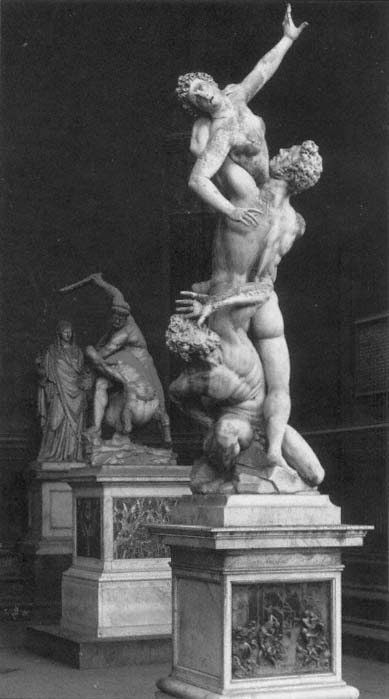
Figure 1.
Giambologna, Rape of the Sabines, 1582. Marble, 410 cm. Loggia dei Lanzi, Florence.
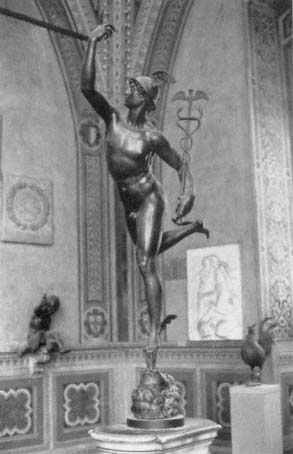
Figure 2.
Giambologna, Mercury, 1580. Bronze, 170 cm. Museo Nazionale, Florence.
There is no doubt that the Sabine marble represented an extraordinary technical feat in which Giambologna solved, on a monumental scale, the difficult problem of relating three figures in the midst of violent activity. But even more significant, he created a statue that not only offers multiple viewing possibilities but requires that the spectator circle it to understand it fully. It is the paradigm of the figura serpentinata, a form that began with Leonardo, was explored by Michelangelo, and was brought to full realization by Giambologna.[4] This form, pointing to the changed relationship between viewers and work of art at the end of the sixteenth century, gave viewers a part to play in the "narrative" of a work of art; no art demanded their participation more insistently than sculpture. Multifaceted sculpture, a topic much discussed during
the sixteenth century, is related to the new connection between viewer and work of art. In the mid-sixteenth century the issue was a significant part of the paragone debate whether painting or sculpture was superior. Cellini, for example, in his response to Benedetto Varchi's Inchiesta of 1546 on the relative merits of painting versus sculpture, stated that a freestanding sculpture would ideally have no fewer than eight satisfactory views.[5] According to the proponents of sculpture, its capacity to present multiple views helped make it indisputably superior to painting. What may have started out as a theoretical debate had far-reaching and significant results by the end of the century. Giambologna, in works such as the Rape of the Sabines, not only took up again the challenge of the paragone controversy and ostensibly reestablished the supremacy of sculpture but, more important, created a new link between viewer and work of art.
Pope-Hennessy, recognizing the narrowness of the long-held opinion that Giambologna ignored subject matter, has countered it with specific reference to the Sabine marble:
The fact is not that the group has no subject, but that it represents the highest common factor in a number of alternative scenes. Its meaning was from the first self-evident; only its context was in doubt. Nowadays, in our modern art-historical writing, we use the terms "subject" and "programme" as though they were interchangeable, but we must distinguish between them here. Giovanni Bologna's was a reaction against the concept of programme, and the reason for it was that he took the concept of subject so seriously.[6]
A view like Avery's, unlike Pope-Hennessy's, ignores a considerable body of Giambologna's work—almost all of it, in fact, from the 1580s on. During the last thirty years of his life Giambologna revealed himself to be a gifted narrator, making a significant contribution to the narrative tradition, as is evident especially in his relief cycles for the Grimaldi Chapel, San Francesco di Castelletto, Genoa (begun 1579); the Salviati Chapel, San Marco, Florence (1579–89); and the Equestrian Monument of Cosimo I, Piazza Signoria, Florence (Fig. 3).
My purpose here is to revise our unjustifiably narrow view of Giambologna and to define his contribution to the pictorial narrative tradition by considering one of the three monuments just named, the Grimaldi Chapel, an underrated masterpiece.[7] Although this study embraces the entire Grimaldi Chapel, viewing it as a whole, the focus, as the subtitle
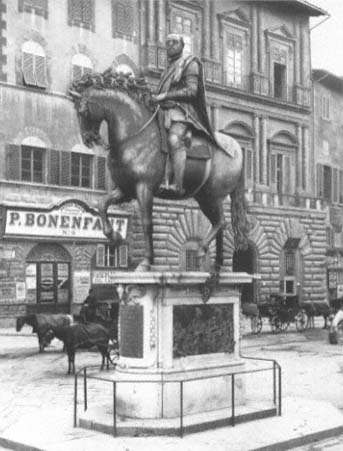
Figure 3.
Giambologna, Equestrian Monument of Cosimo I , 1587–93. Bronze,
c. 700 cm. Piazza Signoria, Florence.
of the book indicates, is its narrative relief cycle. Scholarly interest in narrative has burgeoned in recent decades. A number of art historians have appropriated the methods of literary studies, incorporating, for example, aspects of structuralism and semiotics into their work.[8] The end of the twentieth century has become a self-consciously methodological age as we try to discover new meanings and relationships in familiar visual material. Scholarship on narrative has moved from description, following the story line, to an analysis of narrative structure and its multivalent roles in its time and place. No canonical treatment of narrative form has emerged from narrative analysis, however, in either art-historical or literary studies. Nor have scholars agreed on definitions or
a fixed vocabulary applicable to the material. I have chosen to treat the Passion cycle in the Grimaldi Chapel as the product of a complex interaction and interweaving of historical forces involving the artist, the patron, the immediate religious setting, the larger religious context of the Catholic Reformation, and the social and political situation in Genoa during the last quarter of the sixteenth century. Given what I think is the complexity of the forces at work, I have thought it best to be eclectic in my analysis, following the example set by Giambologna himself in his approach to narrative.
After more than a century of domination by foreign powers, Genoa, the site of the Grimaldi Chapel, had by 1550 regained its international importance, this time as a commercial and banking center of the Spanish Hapsburgs. Andrea Doria had miraculously saved the city from the French and in 1528 restored the old nobility to power through the establishment of the Republic. Thenceforth the government was headed by a biennially elected doge, assisted by five censors, eight governors of the Senate, and eight procurators. In addition, there was a Major Council of four hundred nobles, from which was formed a Minor Council of one hundred. A further characteristic that distinguished Genoa from other Italian city-states was its system of alberghi, or "neighborhoods," each controlled by a noble family. All aspects of life (family, business, religion, culture, politics) were integrated into the alberghi; thus the public and the private were inseparably linked.
Undoubtedly, posterity's neglect of Giambologna's Grimaldi Chapel has resulted from its location in Genoa, out of the mainstream, and its destruction in the nineteenth century. The bronze sculpture for the chapel comprised six freestanding Virtues, a Passion cycle in relief, and six angels (Plates 2–12, Figs. 4–7), now preserved at the University of Genoa.[9] The Grimaldi Chapel was situated in San Francesco di Castelletto (Fig. 8), a typical Italian Gothic church of basilican plan with a nave and two side aisles, its facing of light and dark marble stripes characteristic of that period in Italy (Figs. 9, 10).[10] With internal dimensions of about 250 by 85 feet, San Francesco was roughly comparable in size to San Lorenzo in Florence. The Grimaldi Chapel occupied an honored position, in the transept immediately to the right of the main altar (Fig. 11). San Francesco was not an ordinary Franciscan parish church but a Conventual Franciscan church and convent with an illustrious history.[11] As the mother church of the Franciscan order, San Francesco was the
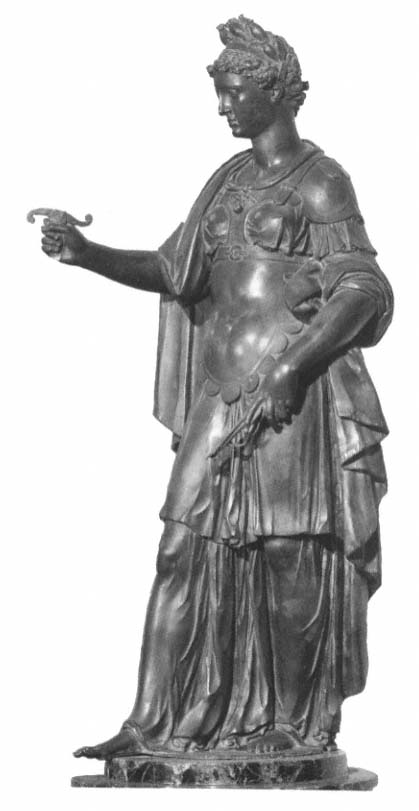
Figure 4.
Giambologna, Justice, 1584. Bronze, 175 cm. Università, Genoa.
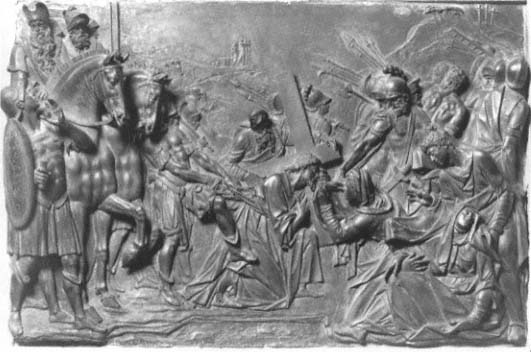
Figure 5.
Giambologna, The Way to Calvary, c. 1585–87. Bronze, 47 × 71 cm. Università, Genoa.
site of many of its general chapter meetings. The convent was founded about 1230, only four years after the death of Saint Francis and two years after his canonization. In 1250, when the building of the big church was begun, Pope Innocent IV granted permission for burials there, stimulating many wealthy Genoese to choose San Francesco as their final resting place.[12] Among these was Andrea Fieschi, a brother of the pope and a significant donor to the early building program of the church. In 1311 the church acquired a further distinction when a noble foreigner, Margaret of Brabant, queen of Luxembourg, died in Genoa and was buried there. The carving of her tomb brought the distinguished sculptor Giovanni Pisano to Genoa in 1312–13.[13] The burial of the queen in San Francesco was followed fifty years later by that of the near-mythical Simone Boccanegra (d. 1363), first doge of Genoa.[14]
The church's vulnerable position, on a hill above the center of the city beside the fortress of Castelletto, was largely responsible for the vicissitudes of its existence. In time of war there was the danger of bom-
bardment; from 1505 to 1537, for example, the friars abandoned San Francesco for fear of attack. Imperial troops sacked the church in 1522. In the mid-sixteenth century the friars carried on a sporadic renovation of their church. The embellishment of the interior proceeded slowly until the 1570s and 1580s, when activity reached its peak under the guidance of Brother Giovanni Battista Fornari.[15] It was during this period of activity, in 1579, that Giambologna received the commission for the Grimaldi Chapel. By then, the street just below San Francesco, known as the Strada Nuova (now Via Garibaldi), had become a fashionable residential street for the Genoese nobility; many of its splendid palaces had already been built.[16] On high ground overlooking the city, the Strada Nuova provided a more commodious and a healthier place to live than the older medieval quarters down near the port. Even more important, however, was the symbolic value attached to this street. The old nobility had been granted permission to develop it by the comune . It became the symbol of their power but also of Genoa's triumph over humiliation at the hands of external powers, for its location just below the old fortress of Castelletto, the site of many Genoese defeats, proclaimed the city's ultimate victory over past misfortunes.
A coincidence of facts points to Galeazzo Alessi as the designer of this magnificent new street. Documents show that the area was developed gradually, beginning in mid-century, on the initiative of the Padri di Comune and that the proceeds from the sale of property went to the Fabrica della Catedrale, where Alessi was heavily involved in renovations in the 1550s and 1560s.[17] It is reasonable to assume, therefore, that he was involved in some capacity in the plan of the street, if only as a consultant. The grand palaces on the Strada Nuova embodied the aspirations of the Genoese nobility that Andrea Doria had stimulated in the 1520s when he brought Perino del Vaga to Genoa.
Luca Grimaldi (son of Francesco), patron of the Grimaldi Chapel, was a member of the old nobility, his family allied to the Guelph party. Members of the family were stockholders in the powerful Banco di San Giorgio and for generations had served the city government in various capacities, including ambassador, procurator, senator, and doge.[18] An older relative of Luca Grimaldi, also Luca Grimaldi (son of Gerolamo), was among the first nobles to buy property in the area where the Strada Nuova would be laid out. In 1564 he sold a large portion of his land, 3,400 square meters, to another Grimaldi, Nicolò, Il Monarca, a noble-
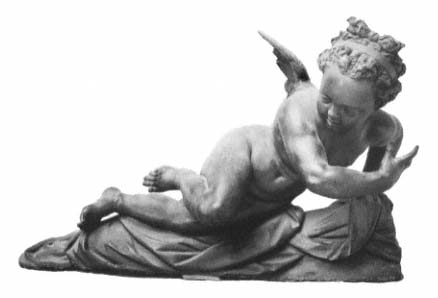
Figure 6.
Giambologna, Angel, 1582–83, bronze. Università, Genoa.
man whose great wealth enabled him to become the principal banker to Philip II.[19]
Our Luca Grimaldi was one of several members of the family who were connected to the Church of San Francesco di Castelletto. Presumably he assumed responsibility for the Grimaldi Chapel when his father died.[20] At the time the contract was signed with Giambologna, Luca Grimaldi was living in an old quarter of the city near the Church of San Luca, close to the port and the Banco di San Giorgio. In 1580, the year after signing the contract with Giambologna for the rebuilding and decorating of the family chapel in San Francesco, Grimaldi acquired the palace of his cousin Luca di Gerolamo Grimaldi adjacent to the church and in all likelihood moved in (Fig. 10),[21] thus physically uniting the secular and religious parts of his life. The plague of 1577, during which Grimaldi was minister of health, might well have motivated him to rebuild the family chapel in 1579.[22] He was only seizing the opportunity to be known as the patron of the most sumptuous chapel in a church that members of the various branches of the Grimaldi family had been associated with for well over a century. Ansaldo, one of the largest stock-holders in the Banco di San Giorgio, made substantial donations to the Monastery of San Francesco. In turn, the monastery promised that a mass would be celebrated in perpetuity each year on his birthday, No-
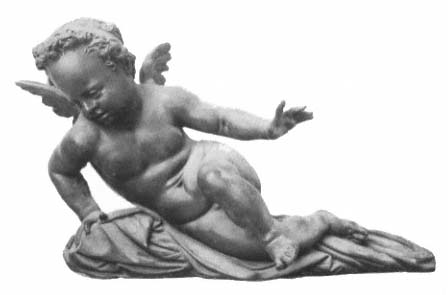
Figure 7.
Giambologna, Angel, 1582–83, bronze. Università, Genoa.
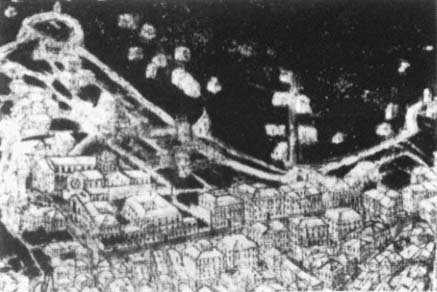
Figure 8.
Gerolamo Bordoni (?), View of Genoa , with San Francesco di Castelletto at center
left, below the fortezza , c. 1616. Collection of Marchese Ludovico Pallavicini, Genoa.
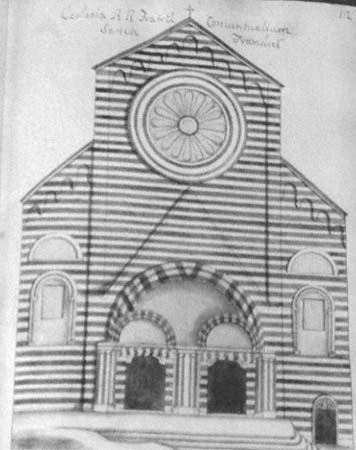
Figure 9.
Facade, San Francesco di Castelletto, Genoa. Drawing from
Domenico Piaggio, Monumenta Genuensia , early eighteenth century,
Ms Mr. V.3.3, fol. 12, Civica Biblioteca Berio, Genoa.
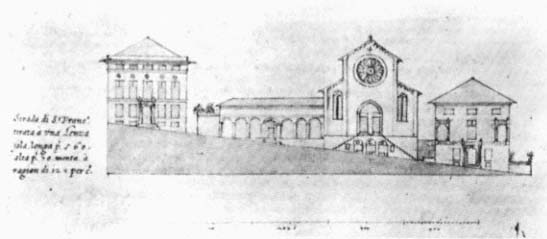
Figure 10.
Eastern prospect, Salita di San Francesco di Castelletto, with the palace of Luca Grimaldi to the right.
From P. B. Cattaneo, Ms 1595–1600, Civica Biblioteca Berio, Genoa.
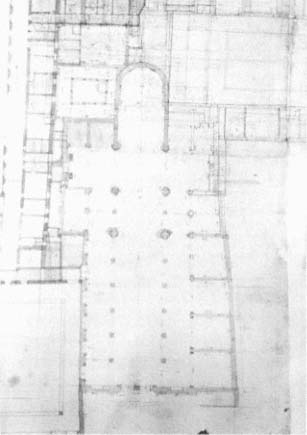
Figure 11.
Ground plan, San Francesco di Castelletto, with the Grimaldi
Chapel to the right of the apse, c. 1785, no. 791, Collezione
Topografica, Museo Sant'Agostino, Genoa.
vember 20, in the Chapel of the Holy Cross.[23] In 1573 Battista di Gerolamo Grimaldi, father-in-law of our Luca Grimaldi, had the oculus of the church repaired, substituting the Grimaldi coat of arms for the broken blue rose.[24] And in 1579 Luca Cambiaso completed a Last Supper that had been commissioned by Francesco Grimaldi, Luca's father, for the refectory of the monastery.[25]
Undoubtedly, the embellishment of San Francesco was stimulated in the 1570s and 1580s by the building activity nearby, but the spirit of reform initiated at the Council of Trent must have played a part as well. Provincial synods, such as the one held in Genoa in 1567, and apostolic visitations provided a strong stimulus not only for the reform of local
clerical behavior but also for the renovation of buildings.[26] Some two centuries later, under the Napoleonic government, the Franciscans were suppressed, the church and convent were expropriated by the government, and the church was gradually denuded of its marbles, bronzes, and paintings. The process of demolition was completed by 1820.[27]
Despite the tragic demise of San Francesco, the preservation of Giambologna's bronzes for the Grimaldi Chapel at the University of Genoa indicates that the chapel, much admired during its existence, continued to be held in high regard. In his chronicle of 1674 Raffaello Soprani exhibits his civic pride as he notes that Genoa was the site of one of Giambologna's major works. The magnificence of the Grimaldi Chapel was so dazzling, the bronzes of such high quality, he exclaimed, that they not only deserve great admiration in themselves but also leave no doubt that even if Giambologna had done no other work in his life, this monument had earned him the title of the best and most excellent maestro.[28]
The scant information about Giambologna's early years is summarized by Baldinucci, who gleaned his information from Borghini and Vasari, both of whom knew Giambologna firsthand. Baldinucci says that Giambologna came from Douai, now in France but at that time in Flanders. He went to Italy when he was about twenty-five and remained there until his death.[29] Although the artistic climate and opportunities in Italy during the last half of the cinquecento seem to have suited him perfectly (he may never have returned to Flanders), to the end of his life he remained strongly attached to his native land, always indicating his place of birth when he signed his works. The inscription on the Altar of Liberty in Lucca reads, "Ioannis Bolonii Flandren opus A.D. MDLXXIX" (work of Giovanni Bologna of Flanders, 1579). And he intended that his own funeral chapel in Santissima Annunziata in Florence provide a mausoleum for expatriate Flemish artists like himself.
Giambologna's middle-class parents had intended that he become a notary. Talent and inclination prevailed, however, and he entered the workshop of the Flemish sculptor Jacques Du Broeucq (1505–1584), where he served his apprenticeship in the late 1540s and early 1550s. During this time Du Broeucq was at work on the elaborate rood screen for Sainte-Waudru in Mons (Fig. 12).[30] It was there that Giambologna learned to carve marble in the round and in relief.
Du Broeucq, one of the principal importers of the Italian Renaissance style to Flanders, no doubt was inspired by the visit he had made to
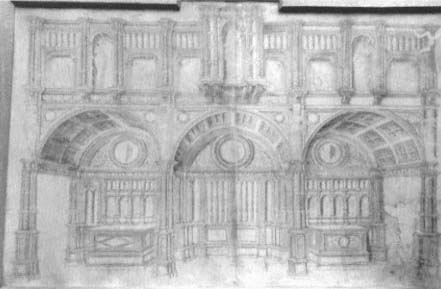
Figure 12.
Jacques Du Broeucq, study for the architectural framework of the
Sainte-Waudru rood screen, 1535.
Archives de l'Etat, Mons.
Italy between 1530 and 1535.[31] He belonged to a growing group of sixteenth-century Flemish artists stimulated by Italian art, more and more of whom made the long journey south, returning with new artistic ideas and finally establishing the Flemish version of the Italian Renaissance style by the mid-sixteenth century. It was undoubtedly Du Broeucq who urged Giambologna to make his own study trip to Rome.
Du Broeucq's sculpture for Sainte-Waudru in Mons is one of the best examples of Flemish Italianate Renaissance style. His rood screen, partially destroyed in the nineteenth century but now largely reassembled, was an ambitious work comprising ten freestanding figures—seven Virtues, Moses, David, and Christ—and twenty-six scenes in relief, most of which relate events of Christ's Passion. The freestanding statues are solid, robust, almost peasant types with a tinge of classical calm absorbed from Rome. The stalwart figure of Fortitude, who grasps her broken column and gazes solemnly down toward the viewer, is typical of Du Broeucq's freestanding works.[32] The reliefs, pictorial in their definition of settings, three-dimensional in their rendering of figures, also reflect an acquaintance with ancient Roman relief. At the same time, they
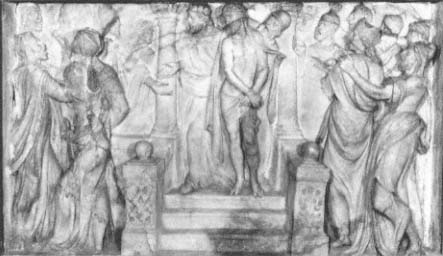
Figure 13.
Jacques Du Broeucq, Ecce Homo, Sainte-Waudru rood screen, c. 1546, marble.
retain a distinctly northern flavor. The Ecce Homo (Fig. 13), for instance, is packed with swaying, elongated figures who shout and gesticulate in response to Pilate's question. The emotion of the crowd, not spatial credibility or clarity, is the artist's interest here.
Having learned his trade as an apprentice with Du Broeucq, Giambologna must have been eager to go and see Rome for himself. According to Borghini and Baldinucci, he spent two years there, probably 1554–56. During that time he undoubtedly devoured all the riches, both ancient and modern, that Rome had to offer. Borghini and Baldinucci report that he made many wax and clay models, a few of which survive. Two ancient works visible in Rome that could not have failed to excite Giambologna were the Laocoön (Fig. 14), discovered in 1506, and The Punishment of Dirke (Fig. 15), unearthed only in 1546. Both exhibit the powerful energy that is a fundamental constituent of so many of Giambologna's later works. Surely he also studied, among the many works in Rome, monuments that Du Broeucq admired, such outstanding examples of Roman narrative relief as the Column of Trajan and the Arch of Constantine.[33] The restrained classicism of Andrea Sansovino's Sforza and Basso monuments in Santa Maria del Popolo would also have appealed to him. And he must have visited the Vatican frescoes of Michelangelo and Raphael more than once, mesmerized by their combination
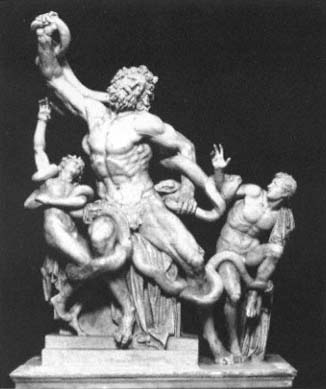
Figure 14.
Laocoön , first century B.C. Marble, 184 cm.
Museo Vaticano, Rome.
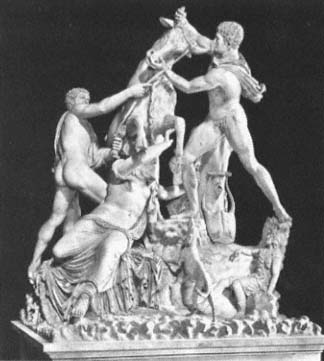
Figure 15.
The Punishment of Dirke , original of 150 B.C. Marble, 370 cm.
Museo Nazionale, Naples.
of powerful energy, suavity, and grace. Baldinucci recounts an entertaining incident that purportedly took place between Giambologna and Michelangelo; whether true or not, it does set up an Italian artistic genealogy for Giambologna. According to the story, the young sculptor one day took one of his models to Michelangelo, who promptly destroyed it, fashioned another to please himself, and advised Giambologna to learn how to make a proper bozzetto before embarking on the finished product.[34] More certain, though not provable, are Giambologna's visits to the workshop of Guglielmo della Porta, where he could have learned bronze casting and seen restorations of ancient works.[35] The exposure to both ancient and Renaissance works was to inspire Giambologna throughout his career and very early superseded any lingering Flemish idiosyncrasies of style he might have acquired in his homeland.
About 1556, models in hand, Giambologna began the long return trip to Flanders, stopping off in Florence on the way. Initially he found support and work through the wealthy patron Bernardo Vecchietti.[36] The combination of Vecchietti's contacts and Giambologna's talent eventually led to continuous patronage by the ruling Medici: Grand Dukes Cosimo, Francesco, and Ferdinando. Such a receptive and welcoming environment evidently induced Giambologna to remain in Florence for the rest of his long life, during which he became the most famous and influential sculptor in Europe between Michelangelo and Bernini.
When he received the Grimaldi Chapel commission in 1579, Giambologna was fifty years old and enjoyed noble patronage as court sculptor to Grand Duke Francesco de' Medici of Florence. Writing a hundred years later, Baldinucci attributed Giambologna's fame to Medici patronage: "The celebrated Flemish sculptor Giovanni Bologna, thanks to having fallen into the hands of a magnanimous prince, achieved not only perfection in his art and riches but such fame as to render him immortal forever."[37]
Giambologna's reputation extended throughout Europe, principally because of his bronze statuettes, which were much in demand.[38] This reputation was protected by the high quality of the work that issued from his busy shop, where he supervised many well-trained assistants, who later went off to work for princes in northern Europe. Rarely did Giambologna leave Florence, and when he did, his position as court sculptor obliged him to secure the grand duke's permission to work for another patron.[39] Even the Holy Roman Emperors Maximilian II and
his son Rudolf II were unsuccessful when they tried to lure Giambologna to work for them.[40] This was the situation when Luca Grimaldi decided that he wanted the great Giambologna to decorate his family funeral chapel. How he lured him is an intriguing question that will be treated in Chapter 2.
Giambologna's efforts for his noble Genoese patron were very much in tune with the spirit of the Catholic Reformation in the late sixteenth century.[41] The Grimaldi Chapel is only one example, another being the Salviati Chapel in Florence, of how the prevalent view of Giambologna as a superficial mannerist is completely off the mark. Efforts at reform in the visual arts focused on a straightforward presentation of narrative and the elimination of any elements that might be considered distracting, implausible, or lascivious. Prominent among the reformers were Cardinal Gabriele Paleotti and Giovanni Andrea Gilio da Fabriano, both of whose treatises circulated widely.[42] But Giambologna went further than simply following their dicta in his work for the Grimaldi Chapel. He explored and exploited the narrative possibilities of relief to create a dynamic interaction between viewer and work of art. By adapting the multiple-view technique normally applicable only to freestanding sculpture, he succeeded in his relief sculptures in involving the viewer, through time, as an active participant in the unfolding narrative. After Giambologna, Bernini carried this involvement of the spectator to its apogee, integrating the pictorial and narrative characteristics of relief into freestanding sculpture.
Chapter 2—
The Setting
The appearance of the Grimaldi Chapel, which can be re-created according to available sources, although these are incomplete, sets the stage for a critical analysis of its art program and the narrative style of its reliefs. To reestablish the original context for Giambologna's bronzes, a task central to my argument, I summarize here what is known about the chapel and reinterpret some of the sources.[1]
The Grimaldi Chapel bronzes, now in the chapel and Aula Magna of the University of Genoa, comprise seven reliefs depicting scenes from the Passion of Christ, six Virtues, and six angels. The reliefs are Christ before Pilate, The Flagellation, Christ Crowned with Thorns, Ecce Homo, Pilate Washing His Hands, The Way to Calvary , and The Entombment (Plates 7–12, Fig. 5). The Virtues are Faith, Hope, Charity, Justice, Fortitude , and Temperance (Plates 2–6, Fig. 4). Of these works, all but The Entombment are mentioned in the contract for the chapel executed on 24 July 1579.[2] There was also a bronze crucifix, since lost, as well as two paintings, The Sacrifice of Isaac and Joseph Sold into Egypt (Fig. 16; Plate 13), by the Pisan artist Aurelio Lomi, probably painted in the 1590s.[3] Levati, biographer of the Genoese doges, mentions a magnificent tomb, which must have disappeared with the church, and a bronze statue of Grimaldi that has not surfaced. Evidently there were also stuccos, destroyed with the church, for Giulio Negrone refers to them in his oration celebrating the coronation of Luca Grimaldi as doge in 1605.[4] Figures 17 and 18 show
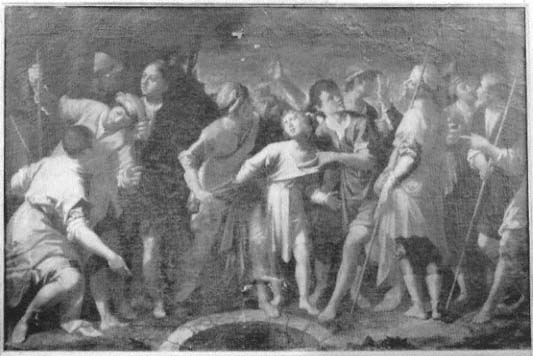
Figure 16.
Aurelio Lomi, Joseph Sold into Egypt , c. 1597.
Convento di San Antonio, Gaggiola (La Spezia).
my suggested placement of the Grimaldi Chapel's principal features and its original appearance.
At the height of the sixteenth-century renovation activities in San Francesco di Castelletto, Giambologna entered the picture. From correspondence, it is clear that he was called to Genoa by the doge and governors, who negotiated directly for his services with Francesco de' Medici, grand duke of Tuscany.[5] Although it is not clear whether these services included work for the Grimaldi Chapel, it is reasonable to assume that they did because the contract for the chapel was signed during Giambologna's trip to Genoa in July 1579. It seems unlikely that the idea to have Giambologna decorate the Grimaldi Chapel occurred suddenly to Luca Grimaldi while the sculptor was in Genoa on other business. The correspondence, which reveals that Giambologna's assignment in Genoa was of public importance, suggests that the Grimaldi Chapel was intended as a major Genoese monument. Local talent, however, was ap-
parently far too modest to satisfy Genoese aspirations; only the best in all Europe would do. Other artists had been imported in the past by the Genoese, including Matteo Civitale (1436–1501) and Andrea Sansovino (c. 1467–1529), who were called by the Padri di Comune to work in the Chapel of Saint John the Baptist in the duomo, and Perino del Vaga, who remodeled and redecorated the Palazzo del Principe for Andrea Doria from about 1528 to 1533.[6] Galeazzo Alessi, the Perugian architect, was also a significant presence in Genoa in mid-century, designing Santa Maria Assunta in Carignano, renovations in the cathedral, various villas, and other works.[7]
The altar chapel in San Matteo that Giovanni Montorsoli executed between 1543 and 1547 for Andrea Doria, though not similar in layout to the Grimaldi Chapel, was the most lavish and prestigious precedent for it in Genoa.[8] Doria, as patron of both secular and religious art, intended to unite these two spheres in one glorious triumphant statement celebrating the supremacy of Genoa and his part in it. There is a relic of the cross in the crypt of Doria's funerary chapel, as there was in the Grimaldi. Grimaldi, unlike Doria, could not expect to make an entire church into a family mausoleum, but he could rival and even surpass the Doria in the decorative splendor achieved in a single chapel. Montorsoli's marble statues around the apse of San Matteo are impressive but hardly as magnificent as Giambologna's golden bronzes of Virtues and reliefs in combination with the colored marbles, stuccos, and paintings of the Grimaldi Chapel.
The precise influence the Genoese exercised over Francesco de' Medici to secure Giambologna's services remains a mystery. It may have had to do with a mission entrusted to Luca Grimaldi in 1577 to carry official congratulations to the duke on the birth of his son.[9] Either on this mission or at another time Grimaldi was also able to resolve a jurisdictional dispute over the territory of Lunigiana, greatly to the relief of Genoa. A rare glimpse of the bite of individual personality appears in a letter Grimaldi wrote from Florence to the doge, in which he relates some details of his visit. He was irritated that the grand duke was not in town when he arrived and annoyed that he was lodged, not in the ducal palace, where the ambassador of Savoy stayed, but in the house of Bartolomeo Fornari, who, nevertheless, showed him every courtesy.[10] In addition to diplomatic contacts such as the one just described, other ties between Genoa and Florence were customary; undoubtedly the powerful Genoese Banco di San Giorgio was doing business with the Medici
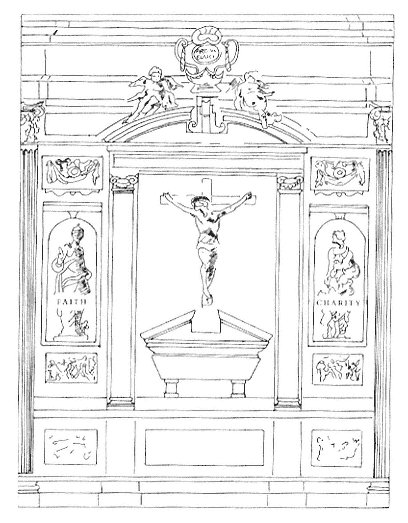
Figure 17.
Author's reconstruction of the altar wall, Grimaldi Chapel.
as well. Fortunately for Genoa, Grimaldi, and posterity, Grand Duke Francesco did release Giambologna for the commission. And by all accounts the Grimaldi Chapel lived up to expectations. Negrone was unstinting in his praise, observing that it was "full of devotion" because of the many important indulgences attached to it, declaring that it had become a model of its kind and had stimulated other wealthy families to decorate the churches of Genoa in an opulent manner.[11]
The link between Giambologna and Luca Grimaldi may have been created during Luca's ambassadorial mission in 1577. At that time Giambologna and his future patron might easily have met, and Grimaldi must certainly have seen the sculptor's work.[12] At some point, if not in Flor-
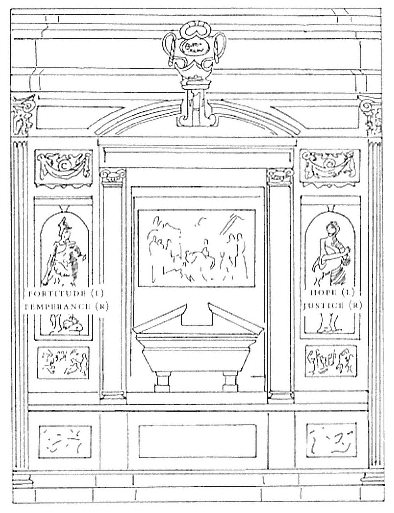
Figure 18.
Author's reconstruction of the lateral walls, Grimaldi Chapel, with
position of Virtues indicated.
ence then in Genoa, Grimaldi saw Giambologna's bronze statuette the Rape of the Sabine (Fig. 19), made for the duke of Parma. He was so impressed with it that he stipulated in the Grimaldi contract that the Farnese statuette was the standard against which Giambologna's chapel bronzes would be judged.[13] The choice of bronze for the chapel sculpture is in itself remarkable. Giambologna was just as expert in marble as in bronze, and while he was creating the bronze reliefs for the Salviati Chapel in San Marco, Florence, he was making the saint statues for the same chapel in marble. Bronze, highly regarded since antiquity as a medium, was given first place by Pliny in his Historia Naturalis and by Pomponius Gauricus in his De Sculptura of 1504.[14] Ancient precedent,
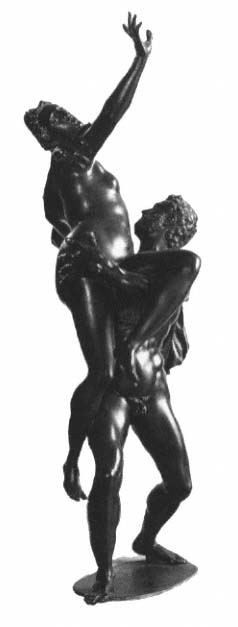
Figure 19.
Giambologna, Rape of the Sabine , 1579.
Bronze statuette, 98 cm.
Museo e Galerie Nazionali di Capodimonte, Naples.
the aesthetic appeal of bronze, and a desire on the part of both patron and artist to surpass prior monuments all must have figured in the choice.
Another link between Luca Grimaldi and Giambologna was probably the painter Luca Cambiaso, who witnessed the Grimaldi Chapel contract and whose involvement in the chapel will be discussed later. According to Soprani, Cambiaso was presented to the grand duke in Florence in 1575 and undoubtedly had the opportunity not only to meet
Giambologna, if they had not met before, but also to see his work. Possibly Cambiaso himself urged Grimaldi to engage Giambologna for his chapel. The Genoese painter Giovan Battista Paggi was a further tie between Genoa and Giambologna, who befriended Paggi while he was living in Florence during the 1580s and 1590s.[15]
Although there are lacunae in our information on many details of the Grimaldi commission, we can read between the lines for clues. The correspondence between the Genoese government and Francesco de' Medici (8 May, 26 May, 28 July) indicates that Giambologna was responsible for architectural decoration while in Genoa; we might thus assume that the decoration for the Grimaldi Chapel was included.[16] Andrew Morrogh's suggestion that Giambologna derived his ideas for the Salviati Chapel from Palladio is intriguing; if borne out, it would explain the similar articulation of the Grimaldi Chapel walls.[17] Assuming, then, that Giambologna, even if only through adaptation, was responsible for the architectural design of the Grimaldi Chapel, we must look to other architectural works by him for clues to its appearance. Three monuments illustrate the pedimental decoration and wall arrangements he favored: the Altar of Liberty, 1577, in the cathedral of Lucca; the Salviati Chapel, completed in 1585, in the Church of San Marco in Florence; and the artist's own burial chapel, the Soccorso Chapel, in Santissima Annunziata, Florence, begun in 1594. The two works closest in date to the Grimaldi Chapel, the Altar of Liberty (see Fig. 24) and the Salviati Chapel (see Figs. 20–22), are more exuberant, more sculptural in design, and spatially more complex than the later chapel in the Annunziata (see Fig. 25), where the architectural decoration is flatter and more subdued, even to the point of austerity. In all three monuments, however, Giambologna's organizing motif was the tripartite scheme also used for the walls of the Grimaldi Chapel.
Of the three works just mentioned, the Salviati Chapel is the one most similar to the Grimaldi in scale, layout, and decorative components. In fact its design just preceded that of the Grimaldi Chapel. Built and decorated on commission from the Salviati family, the chapel is Giambologna's most important extant architectural and sculptural complex. According to documents heretofore unpublished, payments for the Salviati Chapel had begun at least by 13 June 1579.[18] On that date Jacopo di Zanobi Piccardi, a stone carver from Rovezzano, was to be paid 100 gold scudi for marble to be brought from Carrara for the Chapel of Saint Antoninus, San Marco, Florence. The plans for the Grimaldi Chapel, if they were devised by Giambologna, can hardly have
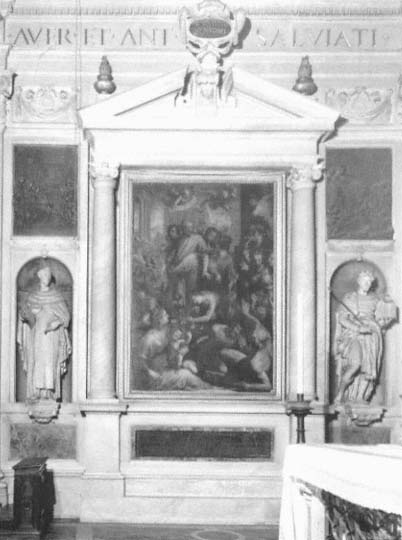
Figure 20.
Giambologna, Salviati Chapel, c. 1579, left wall.
San Marco, Florence.
been worked out before his visit to Genoa in July 1579, by which time the Salviati Chapel was already under way. This chapel thus serves as the major visual source for reconstructing the Grimaldi Chapel. The bronze reliefs for the Salviati Chapel were also begun, and presumably therefore designed, earlier than those for the Grimaldi.[19]
In the Salviati Chapel (Figs. 20–22) the central motif of each of the three walls is an aedicula framing a painting, consisting of an engaged
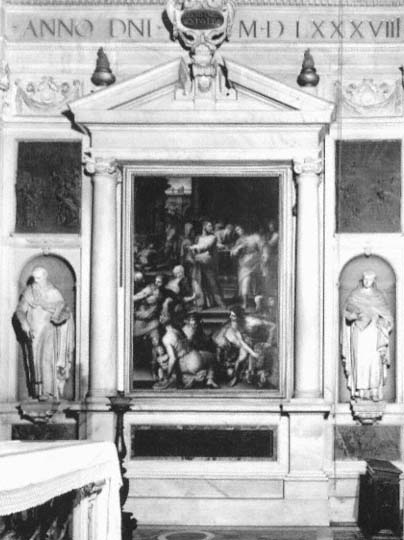
Figure 21.
Giambologna, Salviati Chapel, c. 1579, right wall.
San Marco, Florence.
column on each side raised on a socle and crowned by a triangular broken pediment on the lateral walls and a segmental broken pediment on the altar wall (Fig. 23). The dadoes under the column bases are enlivened by colored marble panels. The aedicula in each case is flanked by statues of saints in roundheaded niches, and the whole wall is enclosed by colossal composite pilasters, with an entablature above running around the three walls of the chapel. Angels recline on the segmental
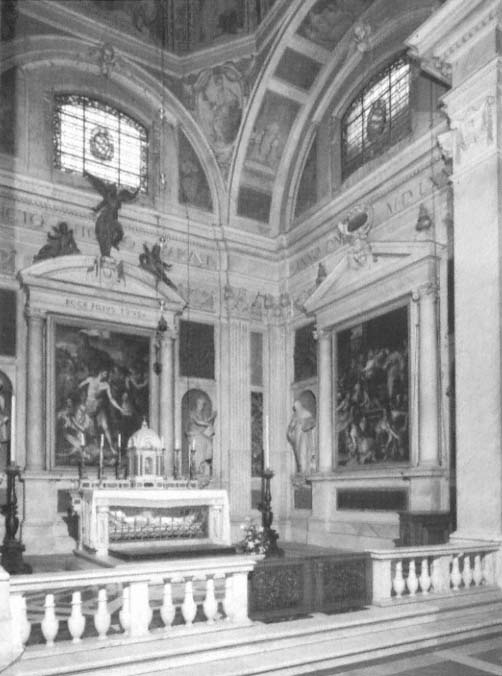
Figure 22.
Giambologna, Salviati Chapel, c. 1579, altar wall.
San Marco, Florence.
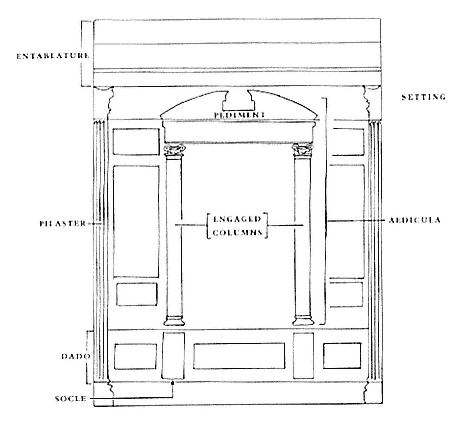
Figure 23.
Diagram of architectural terms, Grimaldi Chapel.
pediment of the central aedicula, as they do on the Altar of Liberty (Fig. 24), but the architectural decoration and decorative detail produce a simpler and more subdued overall effect in the Salviati Chapel than they do on the Altar of Liberty. The aediculae in the chapel, instead of projecting like porticoes, as in the Altar of Liberty, are set back against the wall with minimal projection. While the pediments have a break at the peak, the moldings are not otherwise interrupted, as they are in the Altar of Liberty, by an entirely different motif. Giambologna's own burial chapel, the Soccorso Chapel (Figs. 25, 26), austere in design and color by comparison with the two earlier works, does have the same combination of niches filled with sculpture flanking a central image, but it lacks aediculae.
Probably all the aediculae in the Grimaldi Chapel resembled the one on the altar wall of the Salviati Chapel, with its segmental pediment. The posture of the angels (Figs. 6, 7) intended for the pediments in the
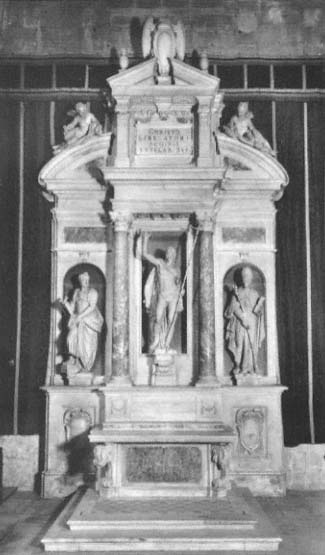
Figure 24.
Giambologna, Altar of Liberty, 1577–79, marble.
Duomo, Lucca.
Grimaldi Chapel suggests this, corresponding as it does to that of the angels on the Altar of Liberty and on the Salviati altar wall. In a drawing of a proposed design for the altar wall of the Salviati Chapel (Fig. 27), angels recline on a simple broken pediment; evidently the scheme was unsatisfactory, because it was discarded in the final execution. The sumptuousness of the Grimaldi Chapel would have been enhanced by colored marble panels set not only into the walls above the Virtue stat-
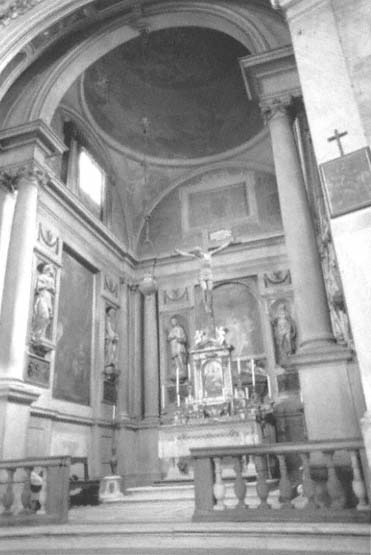
Figure 25.
Giambologna, Soccorso Chapel, c. 1594.
Santissima Annunziata, Florence.
ues but in the dado as well, as in the Salviati Chapel, where at least seven different colors of marble are visible on the walls and in the floor: black, black flecked with rose, white, maroon with rose, red, umber, green.[20] To bring all the elements of the design together, colossal composite pilasters would then have framed each wall at the corners. Above, the three walls would have been tied together by a continuous entablature. In sum, the only significant differences in architectural design be-
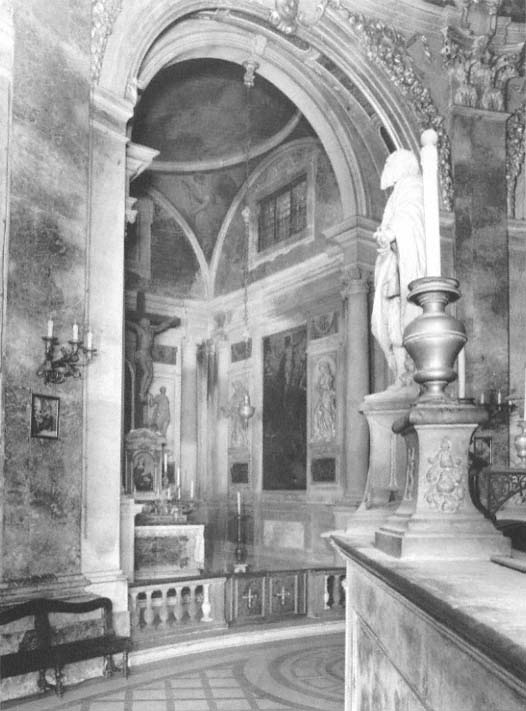
Figure 26.
Giambologna, Soccorso Chapel, c. 1594, right wall.
Santissima Annunziata, Florence.
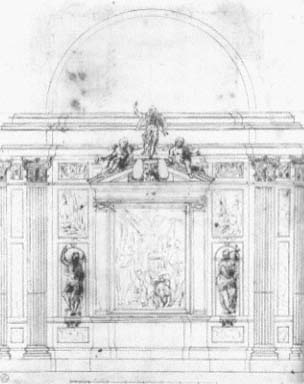
Figure 27.
Study for the altar wall of the Salviati Chapel, c. 1580, no. 237A,
Gabinetto Disegni e Stampi degli Uffizi, Florence.
tween the Grimaldi Chapel (Figs. 17, 18) and the Salviati (Figs. 20–22) seem to have been the shape of the side wall pediments and the placement of the bronze reliefs and marble panels. Otherwise, the combination of paintings framed by aediculae and niches with sculpture was probably similar.
Although the Salviati Chapel must be the principal guide to a reconstruction of the Grimaldi, there are other, more general, precedents. The idea of combining painting and niches with sculpture in one chapel, as was done in both the Salviati and Grimaldi chapels, developed in the sixteenth century. Giambologna would have been familiar with such combinations in both Rome and Florence. When he arrived in Rome for the first time in 1554, Vasari and Ammanati had just finished the Del Monte Chapel (Fig. 28) in San Pietro in Montorio, an important work combining painting and niches with sculpture.[21] The wall
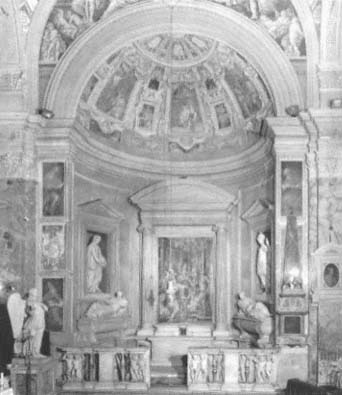
Figure 28.
Vasari and Ammanati, Del Monte Chapel, begun 1550.
San Pietro in Montorio, Rome.
arrangement in the Del Monte Chapel resembles a single wall of the Grimaldi Chapel. Shaped like a deep niche, the Del Monte has over the altar one large painting framed by an aedicula with a segmental pediment and flanked by Virtues, each in a niche. In Florence, when he was still struggling to make a name for himself in the 1560s, Giambologna was involved in sculpture for the Chapel of San Luca in Santissima Annunziata. This elaborate chapel (begun 1565; Fig. 29) for the artists' guild also combines painting and sculptural niches.[22]
One Genoese precedent, close in time to the Grimaldi Chapel, is the Lercari Chapel, situated to the left of the choir in the Cathedral of San Lorenzo (Fig. 30). Here, on the lateral walls, in a tripartite architectural framework, four Virtues (Faith, Hope, Charity, and Prudence) in niches flank paintings that simulate sarcophagi surmounted by seated effigies of the patrons. A relief is located above each niche; covering the entire
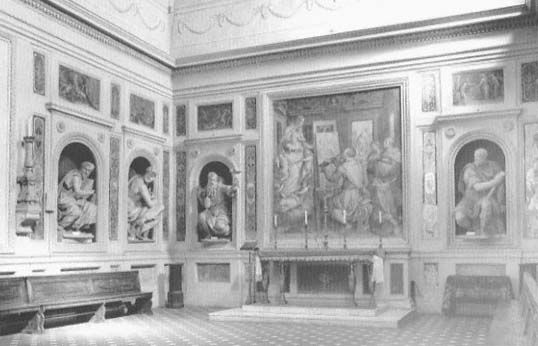
Figure 29.
Chapel of San Luca, c. 1565–76.
Santissima Annunziata, Florence.
wall above each funerary monument is a painting (Marriage of the Virgin and Presentation in the Temple ).[23] Grimaldi was undoubtedly impressed by the Lercari and favored the inclusion of the Virtues and the combination of three-dimensional sculpture and relief with painting. Another influential factor must have been the involvement of Luca Cambiaso, who witnessed the Grimaldi contract, probably helped in its planning, and had worked in the Lercari Chapel.
A final clue to the broad articulation of the Grimaldi Chapel walls is found in other sumptuous family chapels built by wealthy Genoese in emulation of the Grimaldi. Among these were the Senarega Chapel in the cathedral (1583–93), the Immacolata Chapel and Chapel of Saint John the Baptist in San Pietro di Banchi (1588–90), and the Pinelli (begun 1595; Fig. 31) and Serra chapels (begun 1590) in San Siro. Like the Grimaldi Chapel, the Senarega and the chapels in San Pietro are located in the most prestigious parts of the church, flanking the main altar. Even if there are differences in emphasis and detail, the general articulation of the walls of these chapels is similar to that of the Grimaldi, with the
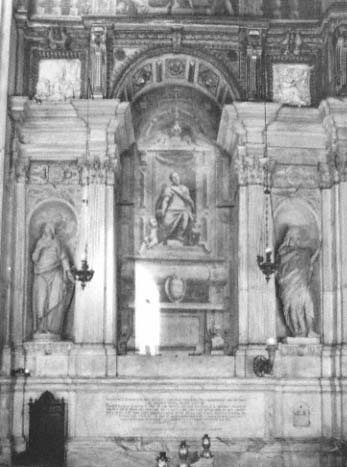
Figure 30.
Lercari Chapel, c. 1565–70. San Lorenzo, Genoa (Prudence on the right).
central aedicula containing a painting, crowned with a pediment, and flanked by statutes in niches. The use of bronze for the statutes and reliefs, however, is unique to the Grimaldi. These later chapels surely reflect the Grimaldi Chapel and confirm its appearance but add no new information to what has been already gathered from other sources.[24]
Several crucial points relating to the chapel's decorative components emerge from a careful reading of the contract and subsequent guide-books. In addition to the six Virtues and Passion reliefs, already mentioned, the contract specifies six bronze angels, a pair over the central image of each wall of the chapel. Two of these images were to be painted panels; the medium for the third was not given. In Soprani's
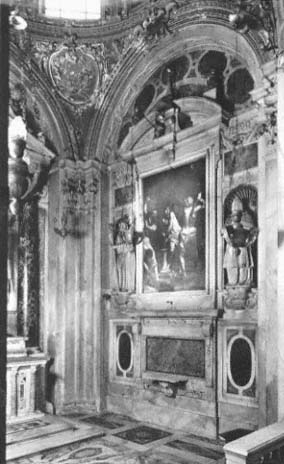
Figure 31.
Pinelli Chapel, 1595–1603. San Siro, Genoa.
1674 guide to artists in Genoa we find, not surprisingly, that the Virtues stood in marble niches, that another relief had been added, making seven, and that there were two oil paintings (Fig. 16; Plate 13) by Aurelio Lomi.[25] It may seem strange to us that Cambiaso, who was closely connected to Grimaldi, was not the author of these paintings. But apparently who was to paint them was decided only after the contract was signed, because they are not specifically assigned; furthermore, by 1583 Cambiaso had left Genoa to work at the Escorial in Spain; he died there in 1585. Moreover, Lomi was a highly regarded and popular painter, judging by his many commissions in and around Genoa and Padua, mentioned by Soprani.
Ratti's 1768 edition of Soprani's book, besides identifying the seventh relief for the Grimaldi Chapel as The Entombment (Plate 12; Ratti says it was the altar frontal) and stating, "Per l'Altare medesimo ei gitto in bronzo l'Immagine del Crocifisso" (For the same altar he cast in bronze the image of the crucifix),[26] also gives the subjects of Aurelio Lomi's two paintings: the Sacrifice of Isaac and Joseph Sold into Egypt.
Although the Grimaldi contract specified Prudence as one of the six virtues and Christ before Pilate as one of the six reliefs, Ratti has substituted Temperance for Prudence and Christ Presented to the High Priest for Christ before Pilate.[27] The change from Prudence to Temperance, which seems confirmed by the statute itself, nevertheless remains problematic. Prudence was traditionally such an important virtue—the first of the cardinal virtues after the three theological ones, according to Aquinas—that it is hard to imagine that it was entirely eliminated from the Grimaldi program or conflated with Temperance and given a subordinate role with only a compass to indicate its presence. Even though the virtue of temperance became increasingly important from the thirteenth century with the revival of Aristotle's Ethics and its emphasis on the golden mean, prudence continued to have an honored place.[28] The prominence of the figure of Prudence in the Grimaldi context emerges in the two orations delivered for Grimaldi's coronation in 1605, which dwell on the virtue at some length. Furthermore, Prudence is depicted with Justice holding the Grimaldi coat of arms on the frontispiece of the published Oratione .[29] Perhaps the lost bronze statue of Grimaldi himself, mentioned at the beginning of this chapter, was intended to embody prudence in some way that we can never know. Or Prudence could have been represented in the chapel's stuccos.
The addition to the chapel after the contract was signed in 1579 of the crucifix and The Entombment mentioned by Ratti, as well as the apparent substitution of Temperance for Prudence, may have been prompted by two factors: the probable transfer of relics of the cross and crown of thorns to the chapel after the signing of the contract and the apostolic visitation of the bishop of Novara, Monsignore Francesco Bossio, in 1582. As will be discussed in connection with the program of the chapel, the practice of venerating relics was reaffirmed by the Council of Trent. It was Luca Grimaldi who had the cross and crown of thorns relics placed in the family chapel. He probably added the crucifix and The Entombment relief in response to the visit of Bossio, who specified that there be a bronze or silver cross in every chapel unless the image
of the crucifix was painted in the altarpiece or on the wall. In the case of the Grimaldi Chapel the crucifix would have been appropriate, for the chapel itself was dedicated to the holy cross. As concluding scenes for the Passion cycle, already stipulated in the contract, both the crucifix and The Entombment made logical additions. The original plan provided for paintings without enumerating their subjects. Lomi's two paintings, The Sacrifice of Isaac and Joseph Sold into Egypt, both represented Old Testament analogues to the Crucifixion. They not only emphasized the chapel's dedication to the holy cross but also focused attention on the act of sacrifice. And Christ's sacrifice on the cross was reenacted with each celebration of the Eucharist.[30]
The visual evidence just reviewed—Giambologna's extant architectural decoration; the precedents of important chapels in Florence, Rome, and Genoa; and the reflections of Giambologna's work in later Genoese chapels—augments the information deduced from the contract and the guidebooks. This evidence establishes that the Virtues in the Grimaldi Chapel flanked the central image on each wall, whether it was a painting or a sculpture. It also gives a reasonably accurate picture of the aediculae. The location of the Passion reliefs remains to be determined.
That the contract specified six Passion reliefs of the same size (the seventh being much larger) and six Virtues suggests that these works were paired on the three walls of the chapel. But the location for the Passion reliefs either above or below the Virtue statues must be established. Giambologna's two extant chapels in Florence, the Salviati Chapel (Figs. 20–22) in San Marco, designed just before the Grimaldi, and the artist's own burial chapel in Santissima Annunziata (Figs. 25, 26), acquired by the artist in 1594, suggest the answer.
Giambologna placed the six narrative reliefs above the statues of saints in their niches in the Salviati Chapel, where these reliefs have a vertical format, about 1.47 × 1.10 meters, instead of a horizontal one and are much larger than the Grimaldi relief panels, which are .47 × .71 meters. The height of the Salviati reliefs is one and a half times the width, whereas the proportions of the Grimaldi are the reverse, with the width about one and a half times the height, like the dark marble panels set into the wall beneath the saint statues in the Salviati Chapel. Because of their size and format the Salviati reliefs had to be placed above, rather than beneath, the saint statues. If we look at one of the Salviati reliefs, Saint Antoninus Reconciling the Signoria (Fig. 32), we see clearly that
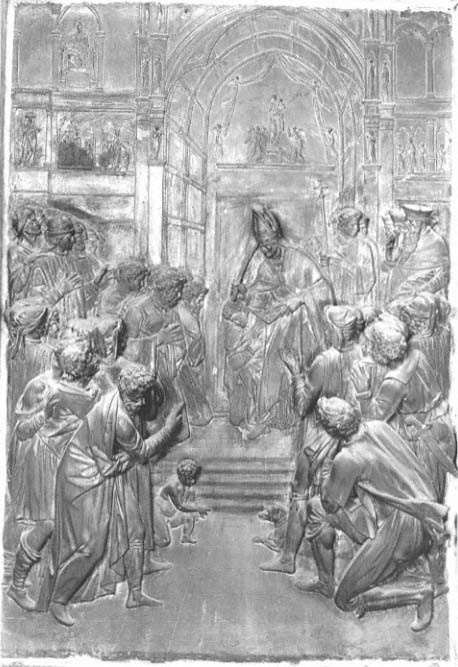
Figure 32.
Giambologna, Saint Antoninus Reconciling the Signoria , 1581–87. Bronze, 147 × 110 cm.
Salviati Chapel, San Marco, Florence.
Giambologna designed them with the viewpoint of the spectator in mind; the ground planes are tipped up and the perspective adjusted for easier viewing. The depth of the relief is also adapted to the viewer, with the heads and upper bodies of the figures sculpted in higher relief whereas the lower bodies are much flatter. Giambologna's manifest concern for the spectator in the Florentine chapel would have been expressed in the Grimaldi Chapel as well.
Fortunately, Giambologna's own burial chapel in Santissima Annunziata helps verify that the reliefs in the Grimaldi Chapel were placed beneath the statues. A set of the six Passion reliefs virtually identical to those mentioned in the Grimaldi contract decorates this chapel.[31] Apparently Giambologna was so pleased with the Grimaldi reliefs that he persuaded Grand Duke Ferdinando I to give the six replicas to him for his chapel, where he had them placed below the statues, undoubtedly reflecting the arrangement of the Grimaldi Chapel, for there is no reason to suppose that in the Annunziata chapel Giambologna would have departed from the earlier arrangement. Thus in the Grimaldi Chapel the spectator's viewpoint for the reliefs—in contrast to that for the reliefs in the Salviati Chapel—was calculated at about a foot above eye level (approximately five feet, five inches). The photograph of Christ Crowned with Thorns in the Annunziata chapel (Fig. 33) confirms this placement, and the calculation itself argues conclusively that the reliefs were beneath the statues. From a purely aesthetic point of view, the Grimaldi reliefs could have been placed over the Virtue statues, but then they would have been indecipherable and their entire narrative import would have been lost, an unacceptable solution. The contract for Giambologna's burial chapel, dated 1594, specifically gave the artist a free hand in devising his own program and decoration, as long as his choices did not violate the decrees of the Council of Trent.[32] Locating these Passion reliefs above the statues certainly would have violated the Council's demand for clear comprehension of the narrative.
The location of the Grimaldi reliefs under the Virtue statues would have followed a long-established tradition in painted and sculpted altarpieces of placing narrative scenes below standing figures. Thus the relationship of the reliefs to the statues above them is the same as that of predella panels to the painted figures of saints above them. Many fifteenth- and sixteenth-century sculpted altarpieces, such as Benedetto da Maiano's Altar of the Annunciation (Fig. 34) and Andrea Sansovino's Corbinelli altar (c. 1490, Santo Spirito, Florence), display the same for-
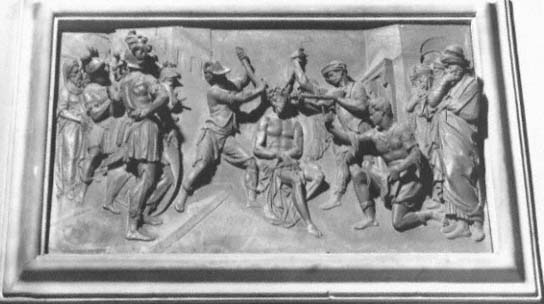
Figure 33.
Giambologna, Christ Crowned with Thorns , 1585–87. Bronze, 47 × 71 cm.
Soccorso Chapel, Santissima Annunziata, Florence.
mat. If Benedetto's altarpiece were dismantled and its statues and narrative scenes reassembled as separate parts on the walls of a chapel, the saints standing in niches above the reliefs, the resulting ensemble would look something like the Grimaldi Chapel. This configuration changes the relationship between the component parts and between those parts and the viewers, who now have a kinesthetic experience. No longer confined to one spot, as they were while contemplating Benedetto's work, they now feel impelled to move around the chapel, interacting as participants in the Passion narrative and responding actively to the Virtues. Concurrently, the space of the chapel is activated; sculpture, viewers, and space are interdependent parts of one complex.
Because the Grimaldi Chapel was a family funeral chapel, any recreation of the setting must account for the location of sarcophagi and the altar. Luca Grimaldi's will, dated 5 June 1611, three days before his death, gives only the instruction that he be buried in his chapel, the Chapel of the Holy Cross, in San Francesco di Castelletto. According to Federico Federici in his Scrutinio della Nobilità of 1641, Luca's wish was carried out and he was indeed buried there: "Luca Grimaldo q.
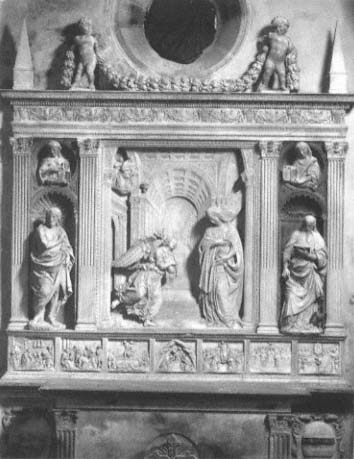
Figure 34.
Benedetto da Maiano, Altar of the Annunciation, c. 1474–75, marble.
Sant'Anna dei Lombardi, Naples.
francesci . . . fu sepolto nella sua Capella superbissima e Regia nella Chiesa de S. Francesco" (Luca Grimaldi, son of Francesco, was buried in his most splendid and royal chapel in the Church of San Francesco). Luca's father, Francesco, was already buried in the Chapel of the Holy Cross, as Giulio Pasqua records in a manuscript of 1610, Memoriè e Sepolcri che sono nelle chiese e ne' suburbi di Genova: "1544 Sepulcrum francisci di Grimaldis qm. Raphaelis."[33] Other members of the Grimaldi family must have been buried there as well.
Sarcophagi are found in crypts as well as attached to chapel walls. A major chapel like the Grimaldi often had a crypt, used for both relics and sarcophagi.[34] Giambologna's Salviati Chapel in Florence has one, as
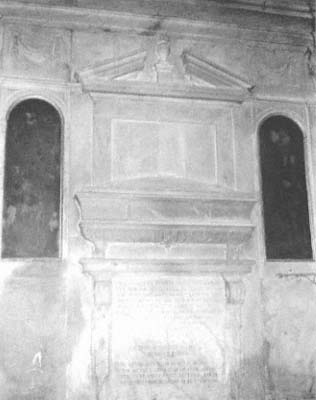
Figure 35.
Nicolò Doria Chapel, begun 1578 (detail).
San Matteo, Genoa.
does the earlier Genoese chapel of Andrea Doria in the apse of San Matteo. Although Doria's tomb is in the crypt of his chapel, there are sarcophagi located on the walls of other Doria family chapels in the nave of San Matteo—for instance, in Nicolò Doria's chapel (Fig. 35) to the left of the high altar and also on the walls of Ottaviano Doria's chapel to the right (c. 1587).[35] In all probability there were sarcophagi in the crypt of the Grimaldi Chapel and at least two, if not three, additional ones in the upper chapel on the side walls.[36] The horizontal format of the two paintings by Lomi (Fig. 16; Plate 13) makes it likely that below each was a sarcophagus, an arrangement like that on the altar wall of Giambologna's own burial chapel, the Soccorso (Fig. 36) in the Annunziata. To accommodate the wall sarcophagus in the Soccorso, the painting above was made smaller than the two paintings on the side
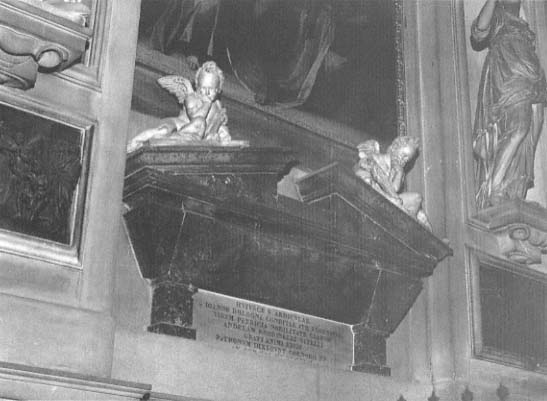
Figure 36.
Giambologna, Soccorso Chapel, c. 1594, altar wall.
Santissima Annunziata, Florence.
walls. And in the Grimaldi Chapel, as in the Soccorso, according to what we can surmise from Soprani and Ratti, a crucifix hung in the place of honor over the altar.
Visual considerations favor an island altar for the Grimaldi Chapel, similar to that in the Soccorso. Two statues in niches and an aedicula and pediment with bronze angels almost certainly made up the altar wall; the missing bronze statue of Luca Grimaldi was also probably located there. An altar attached to the wall would have required a truncated aedicula, thus distorting its proportions and crowding the statues in niches to either side. An island altar with the crucifix suspended above, in contrast, would have accommodated all these elements comfortably and would have allowed for a sarcophagus below the patron's statue as well.[37] The Lercari Chapel arrangement of Virtue statues in
niches flanking a central image (Fig. 30), already mentioned as a Genoese precedent for the Grimaldi, gives an idea of what I envision the configuration of the altar wall of the Grimaldi to have been.
To place the Passion scenes in their proper sequence is relatively easy. There is no reason to suppose that they appeared in any order other than that specified in the chapel contract, that is, Christ before Pilate, The Flagellation, Christ Crowned with Thorns, Ecce Homo, Pilate Washing His Hands , and The Way to Calvary . This order follows the dramatic narrative in John 18:28–19:17 and in the Canonical Office.[38] That the Grimaldi cycle began immediately to the left of the chapel entrance seems certain; the replicated cycle in Giambologna's own chapel begins on the left, a sequence dictated by the Western convention of reading from left to right. My analysis of the Passion cycle as a linear narrative, according to which the story unfolds sequentially, also argues for this arrangement (see Chapter 5).
Determining the order of the Virtues in the Grimaldi Chapel, however, is problematic. The contract specified representations of the three theological virtues—faith, hope, and charity—and three, instead of the customary four, cardinal virtues: justice, fortitude, and prudence. In the final execution, as we have seen, temperance was represented rather than prudence, which appeared elsewhere or perhaps in some other guise. In determining the specific location of each Virtue it would be helpful to discover a visual or textual tradition relating specific virtues to specific Passion scenes, but none exists. In the late Middle Ages there does seem to be a tradition associating patience with the scene of Christ Bearing the Cross (patience being one aspect of fortitude) in, for example, Saint Hildegard of Bingen's Liber Scivias , the Biblia Pauperum , and vernacular literature such as Chaucer's Parson's Tale .[39] But this hardly provides a complete program. One much later text links virtues and the Passion, but only in the most general way: the 1566 catechism, written consequent to the deliberations of the Council of Trent, says that Christ exhibited all the virtues in his Passion, namely, patience, humility, charity, meekness, obedience, and firmness of soul.[40] No special events of the Passion exemplifying these or other virtues are singled out, however. In the rare instances when their representations are combined with the Passion in a single monument, there is no discernible pattern to the juxtaposition. On the original rood screen in Sainte-Waudru, Mons (Fig. 12), where Giambologna had worked as a young apprentice to the Flemish sculptor Jacques Du Broeucq, the seven Virtues stood beside
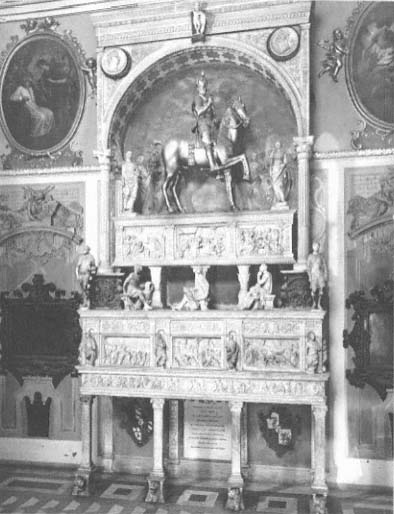
Figure 37.
Giovanni Antonio Amadeo, Bartolommeo Colleoni monument, c. 1473–80, marble.
Colleoni Chapel, Bergamo.
Passion scenes, but it is not possible to make specific connections.[41] Nor is there any detectable thematic relationship between Virtues and Passion scenes in Bartolommeo Colleoni's monument (Fig. 37) in his chapel in Bergamo, where the Virtues flank the Passion scenes.[42]
On some monuments the placement of the Virtues accords with their hierarchical importance, as on the Mons rood screen, where the three theological Virtues were above the four cardinal Virtues. Charity held the honored central position at the top, for as Saint Paul, 1 Corinthians
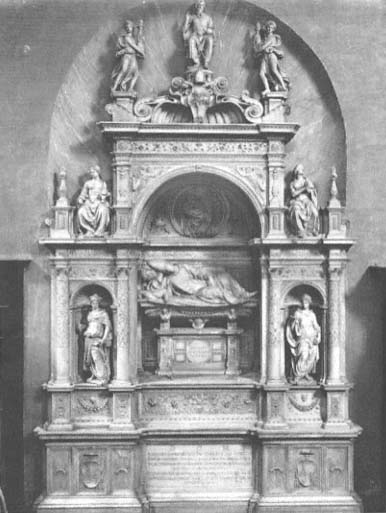
Figure 38.
Andrea Sansovino, Sforza tomb, c. 1505, marble.
Santa Maria del Popolo, Rome.
13:13, makes clear, "So faith, hope, love, abide, these; but the greatest of these is love." Furthermore, in its sixth session, in 1547, the Council of Trent reaffirmed the importance of charity, along with faith and hope, in the doctrine of justification.[43] And if we look at Virtues on Italian tomb monuments, we find that the theological Virtues usually occupy the more esteemed positions.[44]Faith, Charity , and Hope encircle the head of the recumbent effigy in Antonio Pollaiuolo's tomb of Sixtus IV, while the four cardinal Virtues in relief are seated in pairs on either side
of the body, Prudence opposite Temperance and Fortitude opposite Justice . Andrea Sansovino's twin tombs for the Sforza (Fig. 38) and Basso families in Santa Maria del Popolo, Rome, display two theological and two cardinal Virtues each. Below God the Father, Charity, in the form of the Madonna and Child , and Faith and Hope occupy the attic portion while Justice and Prudence , on the Sforza tomb, and Fortitude and Temperance , on the Basso tomb, stand in niches flanking the sarcophagus.
For the Grimaldi Chapel, which had three walls, each with niches and a central image, the Virtues must have been grouped in pairs. In proposing which Virtue stood in which niche, I have considered both design and theology, particularly the importance of faith, hope, and charity in church thought.[45] Thus, Fortitude (Plate 6) and Justice (Fig. 4), representing those virtues most closely associated with worldly concerns, would face each other, one to the left and the other to the right of the chapel entrance, their composition determining their location. The best placement for Fortitude —with her left hand extended, her right pulled back, and her torso turned slightly to her right—is to the spectator's left, whereas that for Justice is to the spectator's right.
Hope (Plate 2), the active, and Temperance (Plate 5), the contemplative virtue, would have formed a complementary pair facing one another in the inner niches of the lateral walls. Hope , her body tightly coiled with intense yearning, gazes up toward the source of salvation; her best placement is to the viewer's left. Temperance , who can be viewed comfortably from any position, counterbalances the passion of Hope and fits well on the right wall of the chapel, to the spectator's right.
Charity (Plate 4), as the first theological Virtue, should be near the altar, her design allowing for a wide range of viewpoints; these considerations place her securely on the altar wall. She could occupy either niche there. Her group, comprising three figures, is the most complex design of all the Virtues. Her pronounced contrapposto stance makes a place for one child in the hollow of her body, and the resulting turn of her head and shoulder to her right permits the other child to stand against her right leg. Faith (Plate 3), as one of the theological virtues, makes a logical companion to Charity , and her contrapposto stance with her weight on her inside leg complements that of Charity , whose weight is also on her inside leg.[46] Although she can be viewed from several points, the most satisfactory are front and left; her niche would be to the left of the altar, leaving Charity to occupy the niche on the right. To summarize my proposal: Fortitude to the left and Justice to the right at the entrance to
the chapel, followed by Hope to the left and Temperance to the right, and finally Faith to the left and Charity to the right on the altar wall.
Using the reconstructed appearance of the Grimaldi Chapel I propose here (Figs. 17, 18), I proceed in the chapters that follow to unravel the meaning of the decorative program and to assess Giambologna's contribution to visual narrative at a crucial stage in its history.
Chapter 3—
Faith, Good Works, and the Catholic Reformation
The part played by the Virtues in the Grimaldi Chapel program—both their prominence and Giambologna's portrayal of them—merits attention. As personifications of abstract concepts the Virtues embodied good works and were also intended to inspire a chain of associations in the penitent, who would presumably meditate on them to find the Christian path to eternal life. According to Catholic doctrine Christ's Passion connects the virtues and salvation. Humankind's only hope for salvation lay in Christ's atonement at the Crucifixion. This he accomplished because he possessed every virtue and could therefore triumph over vice. Many medieval texts dealt with the virtues, typically pairing them with their corresponding vices.[1] But as early as Giovanni Pisano's tomb of Margaret of Brabant, queen of Luxembourg, in San Francesco di Castelletto (1312–13) the virtues appear in tomb sculpture without the vices.[2]
Christian preoccupation with salvation, both on the part of individuals and in official church circles, was not new to the sixteenth century but became more pronounced at the time of the Reformation. A major controversy between Catholics and Protestants concerned the means to achieve the salvation fervently sought by all. Early in the century, in sermons, letters, and tracts, Martin Luther initiated the battle, declaring vehemently that salvation was attainable through faith alone, that is, through the passive acceptance of God's grace. While not denying the beneficial effects of good works during life, Luther nevertheless believed that individuals could not actively achieve their own salvation.
Throughout the century the dispute continued, with learned men from both sides eloquently arguing their viewpoints. The Book of Regensburg of 1541, an attempt to reconcile the opposing sides, failed.[3] It was obvious that the church could not remain united. The beginning of the Council of Trent in 1545 only gave official recognition to this irrevocable split. At the same time, movements within the Catholic church itself reaffirmed and strengthened just such traditional beliefs as the value of good works. The most influential of these resulted in the formation of the Society of Jesus, which was approved by Pope Paul III in 1540; in the reforming crusade of the Jesuits an active spiritual life, involving good works, figured heavily. Ignatius of Loyola had worked out a whole program of religious exercises, published in 1548 as The Spiritual Exercises , so practical that all Christians could use them as a help to salvation.
Good works are the outward manifestation of inner virtues, argue the Catholics. The presence in the Grimaldi Chapel of the Virtues as well as the Passion cycle reflects both the timely concerns of the Council of Trent, which renewed the medieval link between the virtues and Christ's Passion, and a long tradition in tomb iconography. Although Virtues themselves are not remarkable in a funerary context, their combination with a Passion cycle, as I mentioned in Chapter 2, is highly unusual.
Furthermore, they rarely appear as monumental, fully independent statues that happen to stand in niches, as in the Grimaldi Chapel. More commonly, statues of saints and/or prophets occupy such niches, as in Giambologna's Salviati Chapel in Florence. Two other instances, however, of the Virtues' appearing in a similar setting are the Del Monte Chapel in Rome of the early 1550s (Fig. 28), which includes Justice and Religion, and the Lercari Chapel of the 1560s in the Cathedral of San Lorenzo, Genoa (Fig. 30). In the Lercari Chapel the three theological Virtues plus Prudence flank paintings simulating sarcophagi with seated effigies. As I have mentioned, Luca Grimaldi surely took note of this chapel belonging to a fellow aristocrat and prominently situated immediately adjacent to the choir of the Genoese cathedral. Luca Cambiaso's involvement included at least the statue of Prudence.[4] In no other respect, however, does the Grimaldi program resemble the Marian program of the Lercari, which includes frescoes of the Marriage and Purification of the Virgin.
By the end of the sixteenth century, the inclusion of Virtues in tomb monuments, though not as monumental freestanding statues, was a
well-established tradition in Italy and northern Europe, so that their appearance in Luca Grimaldi's chapel is not surprising. In Italy, from the late Middle Ages on, many tombs included Virtues, usually as under-life-size niche figures in wall tombs. Virtues are found as integral parts of the program on such royal tombs as those built in the fourteenth century for the Anjou family in Naples by Tino di Camaino.[5] They are also found on such tombs of saints as that of Saint Dominic in San Domenico Maggiore in Bologna, sculpted in the thirteenth century.[6] By the Renaissance they appear on the tombs of powerful church figures: Pollaiuolo's for Sixtus IV and Innocent VIII, where the Virtues are sculpted in relief, and Andrea Sansovino's for Cardinals Basso and Sforza (Fig. 38).[7]
The custom of placing Virtues on the tombs of rulers, saints, and churchmen was not confined to Italy. Royal tombs in France and the Low Countries often included Virtues. Two prominent examples are the Giustis' tomb of Louis XII and his wife Anne (1515–31) in Saint-Denis, Paris, and Jean Mone's tomb for Wilhelm of Croy in Héverlé (1520s). Virtues continued to be a prominent feature of tomb programs in both Italy and northern Europe throughout the sixteenth century and well into the seventeenth.[8]
While tradition may partially account for the Virtues in the Grimaldi Chapel, the doctrinal beliefs and practices codified at the Council of Trent relate more directly to their inclusion there. At the sixth session of the Council of Trent, in 1547, virtues and the concept of good works figured prominently in the same decree on justification that stressed the Passion. As I have already mentioned, the battle between Catholics and Protestants over what constituted justification was one of the most fiercely fought of the whole Reformation. The Protestants' belief in justification by faith, if allowed to take hold, would have undermined and abolished many of the basic practices of the Catholic church.[9] The Council of Trent, consequently, undertook the urgent task of clarifying and reasserting the basic tenet.
The decree in which this was accomplished states that the presence of the virtues of faith, hope, and charity is one sign of a spiritual state worthy of justification:
Man through Jesus Christ, in whom he is ingrafted, receives in that justification, together with the remission of sins, all these infused at the same time, namely, faith, hope and charity. For faith, unless hope and charity be
added to it, neither unites man perfectly with Christ nor makes him a living member of His body. For which reason it is most truly said that faith without works is dead.[10]
Specifying the crucial role of virtues and good works in justification, the decree also states:
Having, therefore, been thus justified and made the friends and domestics of God, advancing from virtue to virtue, they are renewed, as the Apostle says, day by day, that is, mortifying the members of their flesh, and presenting them as instruments of justice unto sanctification, they, through the observance of the commandments of God and the Church, through faith cooperating with good works, increase in that justice received through grace of Christ and are further justified, as it is written: He that is just, let him be justified still; and, Be not afraid to be justified even unto death; and again, Do you see that by works a man is justified, and not by faith only?[11]
Finally, elaborating on the importance of good works as concrete manifestations of virtue, the decree says:
Therefore, to men justified in this manner, whether they have preserved uninterruptedly the grace received or recovered it when lost, are to be pointed out the words of the Apostle: "Abound in every good work, knowing that your labor is not in vain in the Lord. For God is not unjust, that he should forget your work, and the love which you have shown in his name"; and, "Do not lose your confidence, which hath great reward." Hence, to those who work well "unto the end" and trust in God, eternal life is to be offered, both as a grace mercifully promised to the sons of God through Christ Jesus, and as a reward promised by God himself, to be faithfully given to their good works and merits.[12]
In addition to its concern with justification, however, the council, at its fourteenth session, in 1551, reaffirmed the sacrament of penance as necessary for salvation, a doctrine that had featured prominently at the Fourth Lateran Council in 1215, a time when the church was also under pressure from heretical groups. Each communicant had to prepare to receive the sacrament of penance. Preachers helping their congregations with this preparation used manuals of instruction that explicitly linked both the theological and the cardinal virtues to salvation.[13]
Promoting and elaborating on Tridentine decrees, in this case on the role of sacred images, Gabriele Paleotti, one of the leaders of the Catholic Reformation, declared that the representation of the virtues, which come from the perfection of the Christian life, was secondary only to the representation of religious and sacred things.[14] He went on to recommend that artists wishing to represent the virtues look both at how respected writers represented them and at how saints and other persons exemplified them.
Tridentine thought not only influenced the selection of the Passion cycle and determined the inclusion of Virtues in the Grimaldi Chapel but also provided a textual source, the catechism of 1566, that joined these two elements:
In the Passion alone, we have the most illustrious example of the exercise of every virtue. Patience, and humility, and exalted charity, and meekness, and obedience, and unshaken firmness of soul not only in suffering for justice-sake, but also in meeting death, are so conspicuous in the suffering Saviour, that we may truly say, that, on the day of his Passion alone, he offered, in his own person, a living exemplification of all the moral precepts, which he inculcated during the entire time of his public ministry.[15]
This catechism, produced under the direct order of Pius V, was the first of its kind and served as the primer for communicants everywhere. Its contents were to be memorized by all good Catholics. The relationship between the virtues and Christ's Passion that it suggests reveals the mode of thinking from which the Grimaldi program sprang, although it establishes no specific connection between individual virtues and events in the Passion story. Other sources from the Middle Ages similarly link the virtues with the Passion. Saint Anselm, for example, said that the gifts of the Holy Spirit and the virtues emanating from them could not be attained by humankind except through the merits of Christ's Passion.[16] And medieval artists illustrated the Christian cardinal virtues, derived from Cicero, by joining them to scenes of Christ's Passion.[17]
Luca Grimaldi was attuned to this Tridentine spirit in giving prominent place to the Virtues in his chapel. He might even have devised its program. A silver medal made in his honor attests to his intellectual accomplishments: on one side is his bust with "Lucas Grimaldi an. aet. suae XXVII" (Luca Grimaldi at the age of twenty-seven), and on the
other are two birds flying in a woods with the words "Hoc me Dirigite in lucos" (By means of this, direct me into the groves).[18] The two orations delivered when Grimaldi became doge of Genoa in 1605 illustrate the preeminence of the virtues in his society. Their panegyric character does not diminish their usefulness as indicators of contemporary attitudes. They fall into the genre of epideictic rhetoric used for special public occasions such as funerals of eminent people and coronations.[19] Part of Renaissance humanism's revival of ancient rhetoric, this type of oratory was designed to inspire in listeners both an appreciation of the individual being eulogized and a commitment to their own moral improvement. References to specific deeds and events in the person's life as well as to history were essential ingredients of this oratory; in such a context virtues figured heavily. The orations of Boggiano and Negrone exhibit these characteristics. They praise Grimaldi as an exemplar, a man blessed with every virtue. And they invoke specific instances to demonstrate their points.
Giovanni Giorgio Boggiano, who held doctorates in both philosophy and medicine, begins his oration in the Senate chamber by hailing the Republic of Genoa as a new Jerusalem, whose citizens enjoy liberty and, like their rulers, put the good of the Republic first. The exemplary behavior exhibited by the Genoese, who care for the physical as well as the spiritual lives of all citizens, is manifest in tangible ways: in the many superb palaces, churches, and other public buildings of the city.[20] Naturally, this extraordinarily upright state is governed by an equally moral prince: the new doge, Luca Grimaldi. Boggiano emphasizes the distinguished manner in which Grimaldi and his relatives and antecedents have served the Genoese republic. The rest of the oration enumerates and elaborates on Grimaldi's many virtues: humility, charity, courage, wisdom, justice, temperance, and piety. To demonstrate his charity and courage Boggiano cites an example from the plague in 1577, when Grimaldi, as commissioner of health, devoted all his energy to protecting those not stricken and healing those who fell ill.[21] To do this, Boggiano tells us, Grimaldi, at the risk of his own life, ventured into the plague-stricken city. Justice, too, figures heavily in Boggiano's speech, which praises Grimaldi's prodigious talents in settling disputes, in public as well as in private, calling him "our Solomon." Grimaldi's piety and faith, according to Boggiano, were manifest in the frequency with which he took the sacraments of penance and the Holy Eucharist.
Giulio Negrone, the Jesuit who delivered the much longer oration in the cathedral the day after the coronation, devotes his entire speech to
the virtues; he defines those needed by a good prince and praises Grimaldi for possessing them.[22] At the beginning Negrone mentions liberality, magnificence, and religion, defining Grimaldi's liberality as his successful handling of his inherited wealth, his achievement of a perfect balance between generosity and vigilance. The highest praise, however, goes to Grimaldi as patron of the chapel in San Francesco, for it demonstrates the depth of his faith and his magnificence, setting an example that stimulated other wealthy Genoese to construct chapels equally resplendent.
To match the splendor of the Grimaldi Chapel, however, would have been hard, if not impossible, for bronze, the medium of the Grimaldi sculptures, was highly prized and difficult to cast. No earlier chapels of comparable richness existed in Genoa. Only three even approached the sumptuousness of the Grimaldi: the fifteenth-century Chapel of Saint John the Baptist in the cathedral, commissioned by the city government rather than by a private patron; the main chapel in San Matteo, commissioned from Montorsoli by the Doria family in the 1540s; and the Lercari Chapel (Fig. 30) in the cathedral, commissioned from Bernardo Castello in 1565.[23] None of them contained bronzes.
Negrone, frequently summoning the authority of Aristotle, treats at some length the elements both of justice, particularly its administration, and of temperance required for good government. He sees the doge, in all his actions carried out for the good of the Republic, as the "lieutenant of God."[24]
Many sources other than the orations link Luca Grimaldi's name to the chapel he built. Genealogical records, chronicles, and guidebooks attest to its fame and leave no doubt that Grimaldi, though a man of distinguished civic accomplishments, preferred to be remembered as the pious and generous patron of the Chapel of the Holy Cross in San Francesco.[25] Given the role the virtues played in Tridentine doctrine, subsequently promulgated throughout the church, and their vital part in spiritual life, it seems safe to say that they were represented in the Grimaldi Chapel as a deliberate statement on Grimaldi's part: to demonstrate his orthodoxy by testifying to his belief that the good works he performed during his earthly life qualified him for the life to come.
As figural sculpture the Grimaldi Virtues represent a new genre in Giambologna's oeuvre. Until this time, his female statues had been almost exclusively nude figures of the antique Venus type; exceptions include his 1578 Charity , modeled in stucco for the doorway of the retrochoir of Santissima Annunziata opposite Giambologna's future fu-
neral chapel, and a civic Prudence in terracotta, made for the 1565 wedding festivities of Francesco de' Medici and Giovanna of Austria.[26] After making the six robed female religious works for Grimaldi, Giambologna never did any more. All his other religious statues were male figures. Thirty years before the Grimaldi commission, when he was still an apprentice, Giambologna became well acquainted with Du Broeucq's Virtue statues for the jubé , in Sainte-Waudru in Mons.[27] But subsequently he had matured in Italy, where his figural work shows that he absorbed the lessons of antique sculpture as well as the work of Michelangelo, Andrea and Jacopo Sansovino, Raphael, and Andrea del Sarto.[28] In Michelangelo's works he found tension and energy to enliven his figures. And as a balance to these qualities he found grace and ease of contrapposto in the work of the Sansovinos, Raphael, and Andrea del Sarto.
For the major religious commission of the Grimaldi Chapel Giambologna adapted and modified his familiar elegant female type: the Virtues' faces are almost indistinguishable from one another, but the figures are individualized through posture, gesture, drapery, and attributes. As in all his figural works, an imaginary spiral core of varying tautness, in harmony here with the character of each Virtue, operates as the motivating force. This is elaborated by the gestures and drapery of each figure. Thus Charity (Plate 4) stands so as to enclose the rambunctious infant she holds on her left hip, while turning her head to her right to include the standing child who clings to her right hand and hip. But Charity 's traits of magnanimity and abundance are best transmitted by her richly complex drapery, which falls smoothly to reveal her thighs, bunches up around her hips and pelvic area, and cuts a great swath over her right shoulder, falling in a wide cascade down her back. Hope 's (Plate 2) feverish yearning is vividly conveyed not only by her clasped hands and upturned head but even more by the way the drapery on her right side seems swept up by some ineluctable force, all the more noticeable in contrast to that on her left side, which falls in relatively straight, undisturbed folds. Portrayed as a young female warrior, unarmed but helmeted, Fortitude (Plate 6) wears a short pleated skirt with the lion skin of Hercules thrown over her left shoulder. She stands in a relaxed contrapposto but alert to her environment. Justice (Fig. 4), viewed from the front, looks far more militant than Fortitude , for she is armed with a sword and wears a cuirass. But from her left side Justice appears the most static of the Virtues, holding her scales against her hip, with drapery falling in heavy layered folds from her shoulder to the floor. Temperance
(Plate 5), the perfect embodiment of balance, is conceived in a relaxed contrapposto S curve, her ample drapery clinging to her breasts, stomach, and legs to reveal this stance. Generous folds of drapery loop over her chest and shoulder, around her hips, and from her high waistband, falling in several tiers down her back. Although stately in mien, Giambologna's Temperance , by comparison with Cambiaso's severe, columnar Prudence in the Lercari Chapel (Fig. 30), exhibits a springy contrapposto that activates the figure. Both statues are clearly inspired by classical precedents, but the ponderous contrapposto and heavy voluminous drapery of the Cambiaso create a severity markedly different from the suave, slender Grimaldi figure, whose drapery so clearly defines her posture and enhances the impression that even though a niche figure, she is freestanding.
Giambologna's statues, infused with a vitality that produces a vivid sense of each virtue, served as meditational aids. As personifications of complex abstractions, they mediated between the worshiper and the goal of salvation. Fortitude, for instance, was thought to include magnanimity, constancy, trust, confidence, patience, and perseverance. The prayerful contemplation of the image of Fortitude not only brought courage to mind but activated the chain of its associated aspects; a series of meditational exercises enabled the worshiper eventually to reach the desired penitential state. As "corporeal similitudes," in the words of Saint Thomas Aquinas, these personifications of virtues impress on the memory the qualities the Christian must continually strive to attain. Whereas narrative scenes, inspired by Prudentius's Psychomachia , representing the conflict and triumph of the Virtues over the Vices, were common in the Middle Ages, personifications of the concepts without narrative became customary in the later Middle Ages and after. They allowed for a wider range of meanings than could be associated with a literal battle scene.[29]
Although the inclusion of the Virtues in the chapel can thus be accounted for, some details of their representation are puzzling. Customarily Fortitude, not Justice, wears a cuirass. Giambologna must have been familiar with another example where Justice is similarly armored—for instance, Bronzino's Innocence tapestry, designed in 1544 for Cosimo de' Medici.[30] Here, she swoops down, scales in one hand, sword in the other, to rescue Innocence. Conceivably, the Grimaldi Justice wears the cuirass to stress her militant defense of the law, a theme heavily accentuated in Negrone's oration.[31] Other attributes of Giam-
bologna's Virtues are unusual as well. Bury's suggestion that Pierio Valeriano's De Hieroglyphica , first published in Basel in 1556, was the source for these unusual additions, which include the laurel of Charity, the poppies of Justice, the skull of Fortitude, and the figs, reins, ruler, and lamb of Temperance, seems reasonable, but other sources may also have played a part,[32] as the combination of traditional and unusual attributes suggests. Valeriano's compilation of the emblematic tradition is comprehensive, but surely the programmer of the Grimaldi Chapel had access to other texts as well. Grimaldi's own impresa, "Hoc me Dirigite in lucos," comes from the same eclectic tradition as Valeriano's. And Negrone plays on Luca's name when speaking of the illustrious Grimaldi family, saying, "Che per mezo di un LUCA si facesse lucente, e luminosa, & a questo modo . . . fusse cristallo."[33]
Whatever sources were gleaned for the Virtues in the chapel program, they represented Luca Grimaldi's hope that his endeavors during his earthly life had made him ready to receive the reward of eternal life. They not only perpetuate a tradition in funeral iconography but also refer more precisely to the importance of good works reaffirmed by the Council of Trent and embraced by Grimaldi himself. Justification was necessary for salvation, but as the decree stated, "Faith without works is dead."[34] Complementary to the Virtues, the Passion cycle, discussed in the chapter that follows, represented the promise of salvation through Christ's sacrifice on the cross.
Chapter 4—
Salvation and the Council of Trent
The multivalent meanings of the Grimaldi Chapel program argued here should be understood as reflecting both Luca Grimaldi's concern for his own soul at the Last Judgment and the church's reform program. Although Grimaldi was no different from thousands of others with his resources, his choices for the program of his chapel were unusual in their combination and emphases. They reveal both his awareness of decrees laid down by the Council of Trent and his willingness to accede to them. The major components of the chapel's decorative program, the six freestanding statues of Virtues, already discussed, and the narrative relief cycle of Christ's Passion, were stipulated in the contract of 1579. To these were added a crucifix, the relief of the Entombment (Plate 12), and two paintings, The Sacrifice of Isaac and Joseph Sold into Egypt (Fig. 16; Plate 13). These additions enriched, and focused more clearly, the essential meaning of the original program. The crucifix added the central episode to the Passion story, referred specifically to the dedication of the chapel to the Holy Cross, and fulfilled the requirement for such an image made by Monsignore Bossio during his 1582 apostolic visitation to Genoa.[1] Both the crucifix and The Entombment focused on the outcome of Christ's trial and the culmination of his Passion: his death. The Sacrifice of Isaac is a well-known prefiguration of Christ's Crucifixion, whereas Joseph Sold into Egypt provides an analogue to Christ sold by Judas and a counterpart to Pilate's exchange of Christ for his own political security.[2]
As I mentioned in discussing the Virtues, I know of only two other examples combining Passion cycles and Virtues in funerary art, and their
programs differ from that of the Grimaldi Chapel.[3] One is part of the large, complex program of the Colleoni Chapel in Bergamo (Fig. 37).[4] Here five Passion scenes alternate with Virtues on the lower sarcophagus, which contains Bartolommeo Colleoni's remains. The upper sarcophagus, whose contents remain a matter of conjecture, is surrounded by an infancy cycle combined with statuettes of heroes. Whether or not Colleoni himself devised this program, the link of his own remains with the Passion cycle and Virtues remains noteworthy. Unlike the Grimaldi Passion scenes, those on the Colleoni monument (The Flagellation, The Way to Calvary, The Crucifixion, The Deposition, and The Resurrection ) focus, not on the trial, but on the body of Christ as the sacrificial offering.
Another funerary monument from northern Italy that combined a Passion cycle and Virtues was made in the 1520s by Agostino Busti, Il Bambaia, for Daniele Birago's family chapel in San Francesco Grande, Milan. Afterward dismantled and scattered, it has now been partly reconstructed in the Villa Borromeo on Isola Bella, Lake Como. The Birago, dedicated to the Passion of Christ, with a cycle much more extensive than that in the Grimaldi Chapel,[5] includes twelve Passion scenes, six of them identical to the Grimaldi Chapel reliefs in their stress on Christ's trial. Unfortunately the present reconstruction at Isola Bella, which includes saints and evangelists as well as Virtues, cannot be relied on to provide links between Passion scenes and Virtues.
A group of Flemish rood screens, in Mons, Tessenderloo, and Aerschot, suggest that a tradition of combining Passion scenes with Virtues may have existed in that context. The one in Sainte-Waudru in Mons (Fig. 12), unfortunately dismantled and partially destroyed at the time of the French Revolution, is of particular interest because of Giambologna's apprenticeship in the 1540s under its designer, Jacques Du Broeucq.[6] Hedicke's reconstruction of the screen, based on an original drawing for it, shows a Passion cycle of twenty-three scenes in relief and seven freestanding statues of Virtues decorating the upper portion of the screen. Although the Virtues and Passion scenes constituted the major part of the program, it also included prophets and three other biblical events. The destruction of almost all rood screens in northern Europe as well as in Italy and the corresponding lack of a scholarly study of their iconography leave unanswered vital questions: whether the Mons screen was typical, the extent to which its program was determined by the liturgy, and the function of the screen as the place from which the Gospel and Epistle were read.
Even the isolated examples cited do not provide a coherent source for either the general program of the Grimaldi Chapel or its concentration on Pilate's role in the narrative cycle. Pilate assumed enormous importance for the Catholic Reformation church as the symbol of the moral conflict inherent in judgment. As Roman governor, the earthly judge of Christ, and a fallible human being, Pilate faced a dilemma: if he freed Christ, his political career was finished; if he condemned him, his moral position was indefensible. Thus Pilate in his role vis-à-vis Christ encapsulated some of the most pressing contemporary concerns of the church; in art, the trial of Christ before Pilate could serve as a metaphor for these concerns.
A series of links between the patron of the chapel, Luca Grimaldi, and the Catholic Reformation in the aftermath of the Council of Trent accounts for the unique features of the Grimaldi Chapel. What emerges from an investigation of these complex interconnections is the strong likelihood that Luca Grimaldi or a close advisor, rather than Giambologna, planned the program for the chapel. Grimaldi's involvement with the construction of his chapel was intense and his piety well known.
By 1579, when the Grimaldi Chapel contract was signed, the Catholic Reformation was fully under way, stimulated by the vigorous leadership of Pope Gregory XIII. The Council of Trent, the longest of all the general councils of the church and the most far-reaching in its effects, had closed sixteen years before. It had met three times (1545–47, 1551–52, 1562–63). The immediate impetus for calling the council in the 1540s may have been the failure of efforts to reconcile the Lutherans and Rome at the Colloquy of Regensburg in 1541. But the need for reform within the Roman Catholic church had been recognized long before Luther's urgent call. In May 1542 Paul III issued a bull calling the assembly for the following fall at Trent. Circumstances, including war between Francis I and Charles V, Farnese family quarrels, and difficulties securing lodging in Trent, delayed the opening until 1545. When the council convened, the Catholic church was on the defensive; eighteen years later, in 1563, when it ended, the church was in a much stronger position and the papacy was taking the offensive. Among the doctrinal matters the council confronted were the meaning of the Eucharist and the Mass, the redefinition of justification, and the veneration of relics. High on the list of disciplinary matters was the reform of the clergy, particularly with respect to residency requirements and proper
education. The decrees issued by the Council of Trent served as the blueprint for a massive reform effort that lasted well into the seventeenth century. This monumental body of legislation was subsequently applied locally by zealous reformers, such as Carlo Borromeo and Gabriele Paleotti. The provincial synods ordered at Trent were crucial to the reform process, providing the means to elaborate on and implement the conciliar decrees. Borromeo set the example by calling his first Milanese synod in 1565; soon after, in 1567, Cipriano Pallavicino called the first Genoese synod.[7] Visitations by officials to local parishes followed.
The relics in the Grimaldi Chapel—a piece of Christ's cross and a piece of the crown of thorns, both Passion relics—constitute the first link between Luca Grimaldi and Tridentine reform. The veneration of holy relics by the Catholic church, practiced for centuries, was attacked vehemently by Protestants in the sixteenth century. Answering this attack, the Council of Trent, at its twenty-fifth session, in 1563, reiterated the importance of the practice.[8] The Genoese synod of 1567 also called for the veneration and proper display of relics. The detailed instructions for their care and exhibition, given by Monsignore Bossio during his visit to the Genoese Cathedral of San Lorenzo, were recorded in a significant document of 1582.[9] Local parishes, such as San Francesco di Castelletto, were expected to follow these instructions.
Great prestige attached to the possession of relics. Luca Grimaldi's power and position must have enabled him to have the two relics of Christ's Passion, already in the church, moved to his family chapel.[10] Piety as well as the aggrandizement of self and family was involved in this move. The inscription identifies the relics as
Sacre Crucis, eis spine corone, plurimisque Sanctorum reliquus templo nuper huc Translatis, Lucas Grimaldus Francisci filius, sacrarium hoc P.C.A.S.
Luca Grimaldi, son of Francesco, piously set up and dedicated this shrine for several relics of the saints, and of his holy cross and crown of thorns, recently transferred here to this chapel.
Thus it is clear that they were already in the church when Grimaldi acquired the chapel, which was dedicated to the holy cross. The precise relationship between the Grimaldi Chapel and the relics is not clear, but enough is known to establish a plausible connection.
The relics of the cross and crown of thorns had been donated to the Church of San Francesco in 1322 by Niccolò di David, no doubt partly in recognition of the Franciscans' special devotion to the Passion of Christ. A chapel of the holy cross had existed in the church at least from 1406, when records mention that an Ansaldo Grimaldi, Luca's distant relative, left money for perpetual masses to be said there.[11] Although the relics are not mentioned in connection with this chapel, it seems safe to assume that it contained them. This chapel, however, was not the one Luca Grimaldi acquired, for the inscription clearly states that Luca moved the relics of the cross and of the crown of thorns to his own chapel. In all probability he had the dedication transferred to this chapel as well. Its location adjacent to the high altar, its sacred relics, and its dedication to the holy cross all indicate that Grimaldi was one of the most prominent communicants of San Francesco di Castelletto at that time.
The Grimaldi Chapel, as the repository of Passion relics, was undoubtedly the site where each year on Good Friday the rite of the Adoratio Crucis (Adoration of the Cross) took place.[12] This rite goes back at least to the fourth century, for the pilgrim Egeria describes it in her account of her pilgrimage to Jerusalem in 381–84.[13] According to the local historian Domenico Cambiaso, the Adoratio was particularly popular in Genoa.[14] It was incorporated into the Missa Praesanctificatorum (Mass of Good Friday), preceded by two lessons, the reading of the Passion from the Gospel of John, and a series of special prayers. With minor variations, it was observed all over Western Europe from the seventh or eighth century. According to the Regularis Concordia of Saint Athelwold, which conforms to the authorized use of Rome, the ceremonial opens with two deacons holding the cross before the altar chanting "Reproaches," to which subdeacons and a chorus respond. The cross, which has been laid on a cushion, is uncovered, and three antiphons and a hymn are sung. Then the abbot, with half the chorus, prostrates himself and sings the seven penitential psalms, kissing the cross to close the ceremony.[15] The Adoratio was followed by the extraliturgical Depositio , the symbolic placement of Christ's body (the cross) in the sepulcher; the Elevatio , the raising of the cross early on Easter morning; and the Visitatio , the visit of the three Marys to Christ's empty tomb. The scenario might have been as follows: a reliquary, undoubtedly a cross, containing pieces of the cross and crown of thorns, was brought up from the Grimaldi Chapel crypt into the chapel proper for the cele-
bration of all the Good Friday and Easter morning rites. As the symbolic sepulchrum domini the chapel altar, with Giambologna's relief of the Entombment mounted as an antependium on the front and the crucifix suspended above, would have been the center of these ceremonies. Together with the rest of the Passion cycle on the chapel walls, the two paintings (Joseph Sold into Egypt [Fig. 16; Plate 13] and The Sacrifice of Isaac ), family tombs attached to the walls, and the Virtues in niches, these components of the Grimaldi Chapel provided the perfect setting for the drama of Easter, the Christian promise of salvation.
The Passion of Christ, a central concern of the Catholic reform movement, resonated in the program of the Grimaldi Chapel. Granted the role of the relics and the dedication of the chapel in the choice of a Passion cycle, other religious and historical forces undoubtedly influenced the selection as well. Among those to be explored in this chapter are the Council of Trent's renewed emphasis on the Sacrament of the Eucharist and the doctrine of justification, and the observance of special Franciscan devotions.
A central controversy between Catholics and Protestants during the sixteenth century was the meaning of the Eucharist. The Catholic Reformation church's efforts to clarify it and renew eucharistic devotions rested on the doctrine, paramount in Catholic belief, that the Eucharist reenacts Christ's sacrifice, the central event of the Passion. Renewed emphasis on the events of the Passion thus became the means for strengthening devotion to the Eucharist.
Tridentine decrees both stimulated and reflected the reforms that took place in the church, emphasizing the Passion and making Christ's sacrifice the climax of the Mass. In its twenty-second session, in 1562, the Council of Trent reiterated the truth of the doctrine of Transubstantiation, reaffirming, in the face of the heretical ideas of Luther, Calvin, and Zwingli, that in the Mass the living God is present in the Eucharist.[16] With this declaration the Council of Trent reemphasized and codified the doctrine promulgated by early church fathers like Cyprian. Twenty years after the conclusion of the council, Robert Bellarmine defended the doctrine of Transubstantiation in lectures at the Roman College and made it the cornerstone of his refutation of Protestantism in his Disputationes de controversiis (1586–93).[17]
A corollary of the controversy over Transubstantiation was the discussion of the Real Presence of Christ in the Sacrament of the Eucharist. Luther did not deny the Real Presence; according to Zwingli, however,
"The true body of Christ is present to the contemplation of faith. . . . But that the natural body is really present in the Supper by way of essence, or is orally taken and eaten . . . we not only strenuously deny, but steadfastly assert to be an error contrary to God's word."[18] To combat this and other heresies, the Council of Trent, in its 1551 session, declared:
After the Consecration of the bread and wine, our Lord Jesus Christ, true God and man, is truly, really and substantially contained under the perceptible species of bread and wine. . . . If anyone denies that the body and blood, together with the soul and divinity, of our Lord Jesus Christ, and therefore, the whole Christ, is truly, really, and substantially contained in the Sacrament of the most holy Eucharist, but says that Christ is present in the Sacrament only as in a sign or figure, or by His power: let him be anathema.[19]
One of the practical results of the new emphasis on the Eucharist was the modification of the liturgy. In 1562 the Council of Trent appointed a commission to study abuses in the mass, with the ultimate goal of producing a standard missal.[20] This was accomplished in 1570, when Pius V proclaimed the missal, based on the Roman version, the standard one for the whole church. Another result of the intense preoccupation with the Eucharist was the incorporation of the Office of Corpus Domini in 1568 into the Breviarium Romanum , again exemplifying the Catholic Reformation church's regularization and codification of traditional church practice.
The publication of the catechism of 1566 was another part of the campaign to codify vital church beliefs; its contents reflect a similar concern with the Eucharist and the Passion. The catechism states, for example, that "the Eucharist is superior to all [sacraments] in holiness and in the number and greatness of its mysteries."[21] Explaining in detail the significance and benefits of the Passion, the catechism concludes with an admonition: "The History of Christ's passion is to be frequently inculcated on the people."[22]
In an attempt to involve the laity more in worship, the Council of Trent, at its twenty-second session, in 1562, issued decrees urging lay participation in the mass and the reception of the Eucharist with every attendance at mass.[23] Influential spokesmen for the council, like Carlo Borromeo and Alphonsus Salmeron, went further and advocated daily
communion, as Ambrose had centuries earlier when he said, "If bread is daily why do you take it after a year, as the Greeks in the east are accustomed to? Receive daily what is of benefit to you daily."[24] The council was thus attempting to revive a practice of the early church that had fallen into disuse during the Middle Ages, when communion, mandatory only once a year, was infrequently received.[25] As the Catholic Reformation church recognized, frequent reliving of the Passion of Christ through participation in the Eucharist was essential in strengthening faith and thereby combatting heresy. The cult of the Eucharist in San Francesco di Castelletto was a particular interest of the Confraternity of Union and Charity, a group of "nobili antichi" (old nobles) connected to that church.[26] San Francesco, which belonged to the second tier of important religious spaces, the cathedral occupying the first, was a center of this eucharistic revival in the Tridentine period. Presumably, a prominent family chapel such as the Grimaldi was the site of frequent masses and was open to communicants other than family and clergy. How important these masses and other services were we may surmise from the discovery that Luca Grimaldi's father, Francesco, provided for them in his will of 1565 and codicil of 1567. He put aside 1,700 lire from his "luoghi" (shares of stock) in the Banco di San Giorgio, the income from which was to be used for the celebration of masses, for other religious services, for the upkeep of the Grimaldi Chapel, and for the maintenance of the Church of San Francesco and the monastery.[27] Luca himself designated 200 lire, the income from which was to be used in perpetuity for the annual celebration of a mass for the care of his soul.[28]
Borromeo, in his time the most ardent exponent of devotions to the Passion, not only advocated daily Communion but also instructed that ciboria containing the Sacrament be made for high altars and, furthermore, that these ciboria be decorated with scenes from the Passion of Christ.[29] He thus made visually explicit the inevitable link between the Eucharist and the Passion. It is tempting to think that Borromeo's influence was felt in Genoa in the 1560s when the program for the elaborate Corpus Domini silver casket, which had been commissioned by the comune for the cathedral, was changed from a cycle including scenes from the Old and New Testament to one representing only the Passion (Fig. 39).[30] His close ties to the city, both personal and official, are well known. Borromeo's nephew Don Ferrante Gonzaga was engaged in
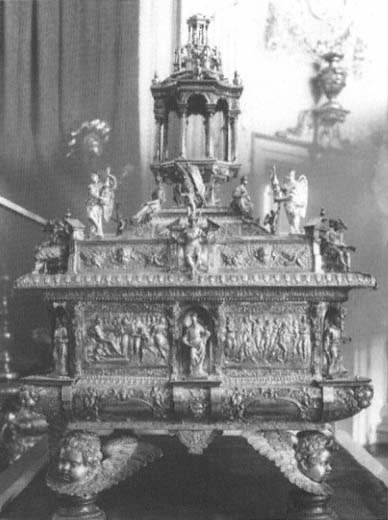
Figure 39.
Corpus Domini silver casket (Christ before Pilate and The Flagellation ),
c. 1565–68.
Treasury, San Lorenzo, Genoa.
1582 and married in 1586 to Giovanni Andrea Doria's daughter Vittoria; his correspondence with successive doges covers more than twenty years.[31]
Christ's Passion, a divine truth presented as a historical narrative, served church doctrine and practice, involving the laity more ardently in worship. In both the catechism of 1566 and the Apostles' Creed the
church focused on the historical Christ by clearly fixing the time of the Passion as the governorship of Pontius Pilate and its place as the lands of Judea. Christ's sacrifice became part of historical reality; his physical suffering proved his humanity and consequently the greatness of his sacrifice. Events surrounding the Passion and details of the physical suffering that Christ endured, documented by Scripture, provided a moving drama with which communicants could empathize and identify.
As important an issue for the Catholic church as that of the Eucharist or Transubstantiation was the doctrine of justification. At the center of the battle between Protestant reformers and Catholics was the question whether justification could be achieved by faith alone, as Protestants claimed, or must be accompanied by good works, as Catholics believed. For Catholics, Christ's Passion was an essential part of justification. A passage relating the Passion to salvation, a concept especially relevant for a funeral chapel, is found in the decree regarding the doctrine of justification issued at the sixth session, in 1547, at Trent.
But though He died for all, yet all do not receive the benefit of His death, but those only to whom the merit of His Passion is communicated; because as truly as man would not be born unjust, if they were not born through propagation of the seed of Adam since by that propagation they contract through him when they are conceived, injustice as their own, so if they were not born again in Christ, they would never be justified, since in that new birth there is bestowed upon them, through the merit of His Passion, the grace by which they are made just.[32]
Reiterating the importance of the Passion for achieving justification, the decree states that Christ "merited for us Justification by His most holy Passion on the wood of the cross."[33] The Tridentine decree thus clearly links Christ's Passion to justification itself.
Franciscan devotions may have been a further stimulus in the selection of a Passion cycle for the Grimaldi Chapel. Two of these devotions, to the Passion of Christ and the closely related Via Crucis, are clearly connected to the Grimaldi program. In a Franciscan convent and church like San Francesco di Castelletto, which dated back to the time of Saint Francis, these devotions must have drawn special strength from the feeling of connection to the early days of the order.
Saint Francis himself set the example for the Franciscans, who held Christ's Passion in special veneration. So compelling was the meaning
of Christ's Passion for Saint Francis that he miraculously received the stigmata and became an alter Christus, the paradigm for this experience.[34] "His consuming passion was to achieve an utterly literal imitation of the God-Man, especially the humility of the Incarnation and the clarity of the Passion."[35] The popular Franciscan text Meditations on the Life of Christ reveals the power of Saint Francis's example. Written in the late thirteenth century, it exhorts the reader to experience step-by-step all the physical and psychological pain Christ suffered at the hands of His tormentors.[36] Of the Passion in general, the text says,
He who wishes to glory in the Cross and the Passion must dwell with continued meditation on the mysteries and events that occurred. . . . Therefore I exhort you that, if you have studiously considered the things said above on His life, you much more diligently concentrate the whole spirit and all the virtues, for here is shown more especially this charity of His that should kindle all our hearts.[37]
After leading the reader through each painful step of the Flagellation and its effects on Christ, the Franciscan author urges, "Here, then consider Him diligently for a long time; and if you do not feel compassion at this point, you may count yours a heart of stone."[38]
In recognition of the order's special relationship to the Passion, the pope in 1342 made Franciscans the guardians of the Holy Sepulcher and custodians of the Via Crucis in Jerusalem. The Franciscans thus assumed the mission of promoting devotion to the holy places associated with Christ's Passion. The vivid experience of retracing Christ's steps on that last agonizing journey served to stimulate its depiction in painting, sculpture, and other media throughout the Christian world. After several centuries, devotions centered on the Passion crystallized into the fourteen stations of the cross, which Pope Clement XII officially established in 1731, chiefly because they had been popularized by the Franciscan friar Lawrence of Porto Maurizio.[39] A standardized meditational exercise on the significance of Christ's Passion was consequently assured: the stations of the cross required the worshiper to follow step-by-step Christ's journey to Calvary.
Between 1342 and 1731 the devotion to the stations of the cross evolved gradually; before codification the number and selection of scenes varied. The prominent Franciscan Bernardino Caimi provided a strong impetus in the development of the stations. He had served as
custodian of the holy sites in Jerusalem in 1478 and apparently had been much affected by his experience. Acutely aware of the devotional value for pilgrims of visiting the places where Christ's Passion actually took place, Bernardino conceived the idea of reproducing these sites in his native Lombardy. After his return from Jerusalem he searched for the appropriate location, which he found in the hills surrounding Varallo, northwest of Milan. The realization of Bernardino's brilliant concept, known as the Sacro Monte, took three hundred years, but long before its completion it became a favorite place of religious pilgrimage.[40] Bernardino's original plan for topographical authenticity was altered in favor of a dramatic unfolding of the events of Christ's life, and the design expanded over the years to include forty-four chapels. Although not restricted to the Passion, the narrative at Varallo does focus on it. The popular realism of the life-size scenes enabled pilgrims to relive each event represented. If Bernardino Caimi initially inspired this New Jerusalem in the Lombardy hills, Carlo Borromeo became its promoter and overseer, spreading the fame of the Sacro Monte as a pilgrimage site.[41] Borromeo considered visits to the Sacro Monte so vital that although seriously ill, he made a pilgrimage there only a few days before his death in 1584.
The selection of Christ before Pilate as the first scene in the Grimaldi Chapel establishes an important connection between Franciscan devotions and the Grimaldi Passion cycle.[42] This scene corresponds to the first one in both the Passion section of the Meditations on the Life of Christ and the stations of the cross, two Franciscan devotions. The match therefore seems more than fortuitous, especially since at the time the Grimaldi Chapel was being planned, no doctrinal codification, or even artistic convention, determined the beginning scene of Passion cycles. This lack of codification clearly emerges in Francesco Panigarola's Cento Ragionamenti sopra la Passione di Nostro Signore, commissioned by Borromeo and published in Genoa in 1585.[43]
Although the factors I have discussed all determined the choice of some sort of Passion cycle for the chapel, they do not account for the unusual politico-historical emphasis of the Grimaldi cycle, its focus on Christ's civil trial. Additional determinants of the scenes selected for the cycle relate not only to Catholic Reformation thought but also to contemporary religious drama and to Luca Grimaldi's personal history. If the Passion cycles are classified, according to their emphasis, as historical, devotional, or physical, the Grimaldi cycle clearly belongs among
the historical. With its thematic and dramatic orientation to the political meaning of the Passion, it largely eschews the devotional or emotional overtones of the other two types. Even by comparison with other historical Passion cycles the Grimaldi is unique in stressing the figure of Pilate. This exceptional focus highlights his role as political judge. The two paintings in the Grimaldi Chapel (The Sacrifice of Isaac and Joseph Sold into Egypt [Fig. 16; Plate 13]), added sometime after the signing of the contract in 1579, refer to Pilate typologically, augmenting this singular program. Isaac's deliverance from the hands of his father corresponds antithetically to Christ before Pilate; that is, it recalls Christ's deliverance into the hands of the Jews. Joseph being sold by his brothers parallels Christ being sold by Judas and, by extension, Pilate yielding Christ in exchange for his own political security.[44]
The uniqueness of the Grimaldi program becomes even more apparent in a comparison with two other nearly contemporary Passion cycles of the historical type, both of which Giambologna must have known. One is the silver casket made for the Corpus Domini feast in Genoa (Fig. 39), the other the painting cycle in the Oratorio del Gonfalone in Rome.[45] Although both stress the historical elements of the Passion, neither puts any special emphasis on Christ's trials, whether the religious, before Caiaphas and the Sanhedrin, or the political, before Pilate. Moreover, unlike the Grimaldi cycle, neither the casket nor the Gonfalone cycle presents a temporally and dramatically compressed portion of the Passion story. The Corpus Domini cycle has one scene representing the religious trial and one the political: Christ before Caiaphas and Christ before Pilate . Of all the possible trial scenes that could have been represented, the Gonfalone cycle includes only one, Christ before Caiaphas, and that is part of the religious judgment. The Gonfalone cycle covers a selection of the major events, from the Entry into Jerusalem to the Resurrection. Otherwise, only much longer cycles, such as Albrecht Dürer's Small Engraved Passion of 1508, contain any comprehensive treatment of the trial.
In contrast, the program of the Grimaldi Passion cycle (Plates 7–12, Fig. 5) emphasizes the political trial and its consequences. Pilate, along with Christ, becomes a principal actor in the drama. In addition to the two paintings typologically referring to Pilate, two of the six reliefs show Pilate judging Christ, and a third depicts Pilate showing Christ to the people. Half the cycle as it was first planned, then, involves Pilate. The other three reliefs represent direct results of Pilate's decisions. Pilate may
even be present among the group of bearded older spectators in The Flagellation (Plate 8), Christ Crowned with Thorns (Plate 9), and The Way to Calvary (Fig. 5).
Although no visual tradition exists to explain the Grimaldi focus on Pilate, historical circumstances suggest reasons for it. The Council of Trent reflected the church's desire to clarify and codify existing doctrine and practices and to eliminate those considered unacceptable. Its determination to explain and systematize extended to religious and historical events. Thus Pilate was a pivotal figure in the Passion story. He was, first, a necessary part of God's grand design for the redemption of humankind.[46] Without him, Christ could not have been crucified and, consequently, humanity could not be saved. Pilate's function as the instrument of God could thus explain the scandal of the Messiah's being crucified as an ordinary criminal; and Pilate's unjust behavior could be viewed as necessary to the fulfillment of God's plan. The official historian of the Catholic Reformation church, Cesare Baronius (1538–1607), writing in his Annales ecclesiastici, published soon after the Grimaldi Chapel was completed, states the church's position on Pilate when he says, "These things were being handled by a certain divine management, so that the Son of God might suffer the punishment of the cross for the redemption of mankind."[47]
Baronius's biblical narrative was clearly constructed to serve the didactic program of the Catholic Reformation church. This historicism, manifest in the evocation of the church's apostolic period, explains the prominence of Pilate in contemporary church writing and doctrine. Baronius is the exemplar. In his efforts to be thorough and accurate, to present as complete a history of Christ's life as possible, he gives a detailed account of the Passion story, treating all the particulars of Pilate's actions as well as the reasons behind them. Baronius affirms Pilate's crucial role for the Catholic reform church when he invites the reader to "linger awhile among these things that were performed by Pilate."[48] Basing his text on the authority of the early sources, Baronius laces his Annales with references to the Gospels and to other ancient writings.[49]
Baronius, as the church's spokesman, viewed Pilate not only as God's instrument in his plan for man's salvation, but also as a figure essential in validating the historical Jesus. The whole of Jesus' life became part of history as well as divine revelation, so it was important to recount its events as they actually happened. None of these was more significant than his death and its circumstances; therefore Pilate's tenure as Roman
governor of Judea under Tiberius assumed enormous historical significance. Early in church history the importance of fixing the time of Christ's Passion was recognized when the Apostles' Creed stated that Christ "suffered under Pontius Pilate." The later historical and didactic attitude of the church emerged in the 1566 catechism, whose fourth article states:
But, if we find it here recorded with such historical minuteness, that Jesus Christ suffered when Pilate was procurator of Judea, the pastor will explain the reason—it is, that by fixing the time, as the Apostle does, in the sixth chapter of his first Epistle to Timothy, so important and so necessary an event may be ascertained by all with greater certainty; and to show that the event verified the prediction of the Saviour: "They shall deliver him to the Gentiles, to be mocked, and scourged, and crucified."[50]
Having established the historical veracity of the events of Christ's Passion, the church cast Pilate as the instrument of God and unwilling executor of the people's will.
The Grimaldi cycle follows the thinking of the church, showing Pilate torn between a sense of justice and political expediency.[51] The Jews' demand that Christ be crucified forced Pilate, out of fear for his own political survival, to condemn him. This view of Pilate began in the Gospels, was expanded in the apocryphal Acts of Pilate, and appears in many other accounts of the story written by historians and theologians such as Justin Martyr, Eusebius, Tacitus, Ambrose, and finally Baronius.[52]
In the Gospel accounts of the trial, Pilate emerges as nearly blameless in condemning Jesus, while the Jews, by implication, are guilty. Luke 23:1–24 and John 18:28–40 and 19:1–16 illustrate this point of view through narratives composed chiefly of dialogue between Pilate and Christ. Jesus appears repeatedly before Pilate, who interrogates him and finds no justification for punishment. To placate the crowd, Pilate orders Christ flogged. When this tactic proves futile, Pilate, hoping to avoid responsibility, offers the crowd a choice between Barabbas and Christ, thinking the crowd will choose that the criminal be crucified. The worst that can be said of Pilate, according to this way of thinking, is that he was weak. The decision was, in any case, inevitable.
The apocryphal book Acts of Pilate offers more detail and is probably the most extensive treatment of the trial and of Pilate's part in Christ's
death.[53] Pilate emerges not only as an innocent but as a positively sympathetic character, who tries to save Jesus by questioning him, by obtaining corroboration of his innocence from Herod, and finally by ordering the flagellation, an alternative and much lesser punishment that he hoped would appease the mob. Pilate did not intend the flagellation as a prelude to crucifixion; as he himself said, according to Luke 23:16, "I will therefore chastise and release Him." Ultimately, as we know, Pilate fails because of the unremitting demands of the crowd. As further proof of Pilate's good intentions, the author of the Acts narrates the story of Pilate's conversion to Christianity on his return to Rome from Judea. Of the early commentators on the trial of Jesus only Philo and Josephus deviate from this benign view of Pilate, portraying him as a corrupt and unjust administrator who loved violence.
Patristic writers like Ambrose and Augustine follow the same view as the Gospels and the Acts of Pilate but are even more explicit in condemning the Jews.[54] In his commentary on Luke, Ambrose wrote,
similiter in hoc typum omnium iudicum arbitror esse praemissum, qui damnaturi essent eos quos innoxios aestimarent. tolerabiliores tamen gentiles esse quam Iudaeos coniuncta Pilato persona demonstrat et magis eos posse diuinis ad fidem operibus admoneri. quales autem illi qui dominum maiestatis crucifixerunt! nec inmerito homicidae absolutionem petunt, qui flagitabant innocentis exitium. tales leges iniquitas habet, ut oderit innocentiam. scelus diligat. in quo tamen nominis interpretatio speciem dat figurae; Barabbas enim patris filius latine dicitur. illi ergo quibus dicitur: uos ex patre diabolo estis, uero dei filio patris sui filium antichristum praelaturi esse produntur.[55]
(Likewise in this matter, I think that of all judges one type is in the forefront—the ones who are ready to condemn those they think are innocent. Nevertheless, the role played by Pilate demonstrates that the gentiles are more tolerable than the Jews, and more capable of being admonished to the faith by means of divine works. But what a sort are those who crucified the lord of majesty! Those who demanded the death of an innocent man ask no absolution for their unjustified homicide. Iniquity is ruled by its hatred of innocence and its love of wickedness; concerning which thing, the interpretation of the name gives an image to the figure. Barabbas means "son of the father" in Latin. Therefore, those to whom it is said, "You are from your father the devil" appear as ones who will prefer Antichrist, the son of their father, to the true Son of God.)
Ten centuries later, Baronius revived many details and attitudes of Ambrose's account, carrying on the Gospel tradition but condemning the Jews more vehemently and exonerating Pilate:
Pilate began a hearing in accordance with the serious offense, asking him whether he was the king of the Jews. But when it had been understood that his kingdom was not of this world, again going out of the Praetorium and up to the leaders of the priesthood, who were waiting outside, he testified that he found no reason for the death penalty in that man. And he had led Jesus with him, and when many Judeans accused him and he did not respond to them, although he was urged to deal with these charges by the governor, Pilate indeed marveled much. . . . But with the priests and ministers clamoring that he should be crucified, Pilate, when again he bore witness that he found no reason for death in him, still desired to set him free. Finally, nevertheless, with those men urging and forcing it upon him, that if he were to let him go he would be an enemy of Caesar, he sat before the tribunal and, reckoning that there was no possibility of freeing him, since they were clamoring rather violently and the uproar was becoming greater, affirming that he was undertaking to do a most unfair thing, he called for water. When it had been received, he washed his hands before the people, saying: "I am free from the guilt of the blood of this righteous man, and you yourselves have witnessed it." The people then answered him: "His blood is upon us and upon our sons." Then Pilate, when Barabbas had been released, handed over Jesus to them to be crucified.[56]
Pilate's act of washing his hands assumes great importance for Baronius, who says, "He washed his hands and professed his own innocence of the deed, not at all in accordance with Roman custom or any custom of the gentiles."[57] Baronius asserts that Pilate followed Jewish custom in performing this act. Because it symbolically exonerates Pilate from the guilt of Christ's death, it must be stressed, in the Catholic Reformation view, as part of God's grand plan. The hand-washing scene had not been especially popular in art since the early Christian period, a time similarly preoccupied with establishing the historical validity of Christ's life on earth. Its presence in a short cycle like the Grimaldi leaves no doubt that it coincides with Tridentine thought, establishing one more link between the chapel program and the official church position.
Baronius's concern for historical accuracy and detail arose from the same concerns as the reports and writings by Tridentine reformers on art. Ecclesiastical leaders like Carlo Borromeo and Gabriele Paleotti elaborated on the general statement about sacred images issued by the Council of Trent at its twenty-fifth session, in 1563, urging a return to historical truth in works of art depicting religious events.[58] Surviving records indicate that artistic production in Genoa came under close scrutiny. Church synods were held to explicate Tridentine decrees as early as 1567, when one was organized by Archbishop Cipriano Pallavicino.[59] Subsequently, apostolic visitations, such as that of Monsignore Bossio in 1582, resulted in specific directives to each church in the city.[60] By this time the Grimaldi Chapel was under way. Surviving records on San Francesco di Castelletto indicate the thoroughness with which such inspections were conducted. Bossio looked closely at architectural, sculptural, and painting decoration to ensure their conformity to Tridentine regulations.[61]
Pilate may have been useful in the church's efforts to establish the historical validity of Christ's life, but the story of his confrontations with Christ also provided material for a compelling drama. The minidrama of the Grimaldi cycle transforms the eternal time of Christ's Passion into the stage time of a play, which in turn is analogous to our experiential time. Moreover, so striking is the resemblance of certain features of the Grimaldi cycle to mystery plays that one cannot help seeing a link between the two. As in a mystery play, the major portion of the cycle constitutes one dramatically cohesive episode from the Passion story: the trial of Christ and his condemnation at the hands of Pontius Pilate. Furthermore, the episodes chosen from this portion of the drama unfold sequentially, as they would in a traditionally constructed play. Unlike many other Passion cycles in Italy and northern Europe, whether painting or sculpture, the Grimaldi does not give what can be considered a comprehensive coverage of events from the whole Passion story, from the Entry into Jerusalem through the Resurrection, but illustrates only a small portion of it, in which the episodes are interdependent and tightly linked. From the opening scene, Christ before Pilate (Plate 7), through The Way to Calvary (Fig. 5), each relief in the Grimaldi cycle depicts an event causally tied to the preceding one. Thus Christ is flagellated as a result of his appearance before Pilate and is then crowned with thorns. After these two punishments he is brought before the
people by Pilate in the hope that the crowd will grant him a reprieve. When they refuse, Pilate washes his hands and directs the soldiers to lead Christ away to begin his journey to Calvary.
The popularity of the Passion as a subject for dramatic performances throughout Europe is attested by the abundant texts of plays and records of performances from the fourteenth, fifteenth, and sixteenth centuries.[62] Until recently, the study of Passion drama in Italy has lagged behind that in England, Germany, and France. A few isolated studies show that Passion plays were performed in Italy in the late Middle Ages. In fact, what may be the earliest one in the West was written at the Abbey of Montecassino in the twelfth century, and Good Friday plays were performed at Perugia in the thirteenth century.[63] There were performances of Passion plays at Siena around 1200, at Padua in 1243 or 1244, and at Cividale in 1298 and 1302. The records of these performances seem to coincide, at least in general, with the depiction of Passion cycles on the aprons of the most popular image of the dugento, the painted cross. The relationship between art and religious drama thus long predates the Grimaldi Chapel cycle.[64]
It seems likely that the parallels between the Grimaldi Passion cycle and religious drama are more than fortuitous. How close the correspondence could be is evident in one of the Good Friday Passion plays performed in Perugia in the thirteenth century. Based on the Gospel of John, it contains dramatic sequences comparable to those of the Grimaldi cycle. Although the Perugia play includes many more scenes, and thus more detail, than the Grimaldi cycle, only six locations are used.[65] Limiting the number of locations, a device used in both the play and the cycle, focuses attention on that short period of time that encompasses Christ's trial and condemnation. Furthermore, the episodes unfold, as already noted, in a tightly knit sequence, a characteristic of stage drama.
From the thirteenth through the eighteenth century Passion plays were performed in and around Genoa, in private homes as well as in churches.[66] The popular ludus peregrinorum (the play of the journey [to Emmaus]) is an example of this practice. In time these performances must have deviated from their strictly religious intent, for the church in the sixteenth century issued warnings against their performance. Finally, during a period of intense religious conservatism, in 1574, the provincial synod of Genoa forbade the performance of Passion plays, declaring,
Le rappresentazioni che hanno per oggetto la dolorosa istoria della Passione del Signore, e le mirabili geste dei santi, e pongono sotto gli occhi del popolo in modo sensibile per mezzo della scena quei santi argomenti; . . . la malizia e nequizia dei tempi nostri le ha talmente pervertite che esse invece di lagrime eccitano il riso, e in luogo di pii affetti muovono a perversi desiderii.[67]
(Those plays, whose purpose was to relate the painful story of the Passion of the Savior and the miraculous deeds of the saints, and to put those holy arguments before the eyes of the people in a sensitive treatment of the scene, have been so perverted by the malice and wickedness of our times that instead of tears they incite laughter, and in place of pious feelings they move to perverse desires.)
Despite this official prohibition performances continued, apparently too compelling to stop.
Regardless of the synod's policy vis-à-vis the performance of Passion plays in Genoa, the Grimaldi cycle captured their dramatic effect, which remained to exert its power over the beholder. Each time an act of devotion was performed in the presence of these scenes, the viewer would recall once again the vivid experience of attending a Passion play. Such a concentrated dramatization of the trial of Christ before Pilate inevitably involved the worshiper in its gripping story and must have been an effective aid in reliving the Passion.
Another striking characteristic of the Grimaldi cycle involves the forceful stress on the act of judgment and its attendant conflicts. This issue of authority at the moment of judgment dominates the action of the Grimaldi cycle and suggests that it had special meaning for the patron. The unusually strong emphasis on Pilate's role in Christ's fate, and on the question who has authority to judge, points to a direct relationship between the patron and events in his own life. Grimaldi's involvement in public life and service to his government has been well established. It does not seem too farfetched, therefore, to suggest that contemporary circumstances played a large part in determining the iconographic choices made in the Grimaldi Chapel.[68] Boggiano's references in his 1605 oration to Grimaldi's abilities as a public and private mediator are tantalizingly unspecific. Boggiano mentions the many civic offices Grimaldi held and the official duties he performed, from ambas-
sadorial to administrative to judicial, and he praises Grimaldi for his tireless efforts in settling public as well as private disputes.[69]
That the issue of judgment was paramount during Luca Grimaldi's lifetime is clear from contemporary letters and accounts. That most severe dispenser of judgment, the office of the Inquisition, had been greatly strengthened in the sixteenth century. Correspondence between Rome and local authorities in many parts of the Italian peninsula reveals that the church considered heresy one of its severest problems. Genoa, because of its proximity and commercial ties to Reformation centers like Geneva, was of particular concern. In the second half of the sixteenth century the government of Genoa vied more or less continuously with the papacy over the authority to judge local cases of heresy and to mete out appropriate punishment.[70] Pius V (1566–72) and Gregory XIII (1572–85), the most vigilant of popes, mistrusted Genoa's ability to deal with heretics and kept a watchful eye on the city's treatment of them.[71]
An incident during the reign of Pius V illustrates the controversy between Genoa and the papacy over this jurisdictional matter and suggests the prevailing atmosphere in Grimaldi's city at the time.[72] This struggle, recounted in letters, lasted from October 1567 to May 1569; it concerned an apparently dangerous heretic named Bartolomeo Bartoccio of Città di Castello. In 1550 he had fled to Geneva and was known to be proselytizing for Protestantism in northern Italy in 1567. Genoa, having arrested him at the request of the papacy and having subsequently been threatened with economic reprisals by Geneva and Bern, asked for permission to release him. Thus caught between her material and spiritual well-being, Genoa attempted to negotiate a solution to the problem. The pope, however, remained intransigent, not only refusing to accede to Bartoccio's release but also demanding that he be sent to Rome for trial before the Inquisition. Reluctantly, Genoa complied with the pope's orders and handed over the prisoner to Rome. Continued efforts to gain clemency failed, and Bartoccio was burned at the stake on 25 May 1569. Genoa evidently felt unable to risk an open break with the papacy, unlike Venice in the early seventeenth century.[73] The interdict of 1606 was the punishment Venice suffered for continuing to resist the papacy's attempts to impose its political leadership there in a long succession of incidents.
Genoa's dilemma in her struggle with the papacy has a counterpart in the choice Pilate faced between saving his own political skin (thus
disregarding his conscience) and acting according to his sense of morality (thus risking his career). Similarly, Genoa had to decide whether to act in its own best economic interests, thereby defying the papacy, or to submit to ecclesiastical authority. During much of this period of tumultuous relations between Genoa and the papacy, Luca Grimaldi was a member of the Genoese government and, as such, close to the center of the ongoing controversy. At the time of the Grimaldi Chapel contract in 1579, he had been in public service at least twenty years. As one of the ruling elite he served at various times on the Council of One Hundred and the Council of Four Hundred; he also filled magisterial offices such as procurator of the Republic and was given many ambassadorial duties. Another indication of just how close he was to the inner circle of the Genoese government is the manner in which he secured the services of Giambologna, through a direct appeal by the doge and governors of the Republic of Genoa to the grand duke of Florence.
Because of Grimaldi's long years of participation in the Genoese government, he not only must have known what was going on in government circles but must also have been directly involved in much of it. Genoa was an oligarchy ruled by the doge in conjunction with his councilors. Since each doge was elected from the councils to serve only two years, many council members could expect to become doge. Luca Grimaldi himself achieved this office in 1605, at the venerable age of seventy-five.
It is not difficult to imagine the dialectic the Bartoccio case continued to evoke in Grimaldi's official circles. Questions about the nature of judgment must have persisted, and inevitably, Grimaldi would have been concerned with them. It is likely that in his capacity as a member of the government, drawn from the council, he served a turn as an advisor in the court proceedings of the Inquisition.[74] The scenes for the Passion cycle in the Grimaldi Chapel were chosen in an atmosphere so charged with awareness of the conflict between religious and secular responsibilities that those depicting Pilate were almost inevitable choices. These explicit references to judgment surely reflect Grimaldi's responsiveness to current church thought as it often conflicted with governmental affairs.
We have a substantial picture of Grimaldi's public persona as a pious, highly respected member of the ruling power structure. It is not surprising that the program of his family funeral chapel reflected what appears to have been his orthodox mentality. Although the issue of salvation
was a universal concern, it must have been especially pressing for Luca Grimaldi and his contemporaries in the late sixteenth century. The church was beset by controversy both within and without and, as we have seen, was preoccupied with the topic of justification because of its direct bearing on salvation. Furthermore, Geneva, a center of heresy and an important commercial connection, was just over the Alps from Genoa. For a conformist like Grimaldi the best way to ensure his and his family's salvation was to be as inclusive and comprehensive as possible.
Chapter 5—
Giambologna's Narrative Method
The climate of Tridentine reform that affected the program for the Grimaldi Chapel also demanded a new strategy for conveying the message of the Passion cycle. A major goal of Catholic Reformation church authorities was to increase worshiper participation in church ritual. This could be achieved through a clear presentation of the central Christian mystery: Christ's sacrifice for humanity's salvation. The narratives illustrating this and other religious truths thus had to be easily comprehended. Furthermore, the emotional reactions of the people depicted in the visual images had to lead to appropriate responses in the communicants. To fulfill these requirements of the church, artists of Giambologna's generation revised their manner of representation. To couch this change in the language of Hayden White's literary analysis, a narrative order was imposed on the events to be represented—those of Christ's Passion for the Grimaldi Chapel—making the message readily accessible to the viewer.[1] The pictorial form of illustrating a "story," whether painting or relief sculpture, gives the artist a choice of modes that depends primarily on the message to be delivered: is it to convey information, is it to commemorate, or is it to instruct? To achieve the desired emphasis, whether it be emotive, cognitive, or a combination of the two, the artist must construct his work according to conventions the audience recognizes and knowledge it shares. The form of the image is determined by the historical, cultural, and conceptual context as well as by the physical environment, which
includes the site and placement, and the medium. To be successful, the artist must integrate all these elements and fulfill the commission.
Giambologna's task was to impose a narrative order on the events of Christ's Passion so that the dogma of salvation would be immediately intelligible to the communicants. This had to be done according to the requirements of the Catholic Reformation. The Grimaldi reliefs (Plates 7–12, Fig. 5) although small and few in number, are a striking example of both the artist's and his patron's reactions to the church's reforms of the late sixteenth century. Although the changes that occurred in painting at this time were charted more than sixty years ago by Walter Friedlaender, similar changes in sculpture have been largely ignored.[2] The Grimaldi relief cycle provides an opportunity to begin filling this lacuna in sculpture studies.
Scholars have acknowledged, without elaborating on, the profound changes Giambologna's work displays after about 1580. Solutions he found appropriate in the 1560s were no longer satisfactory in the 1580s, when, in response to the new demands of religious narrative, Giambologna's work departed strikingly from the maniera . The Grimaldi reliefs represent a change from a rhetorical to a more direct method of storytelling required by new patronage and a changing cultural climate. Giambologna, a genuine eclectic, drew on a variety of sources in making this change. How he accomplished it and the innovations he introduced, particularly in spectator involvement, are the focus of the remainder of this book.
This chapter analyzes the techniques Giambologna employed to carry out his plan to present a program for Christian salvation. It discusses narrative issues, compositional technique, space as a storytelling device, the relationship of viewer to image, and the multiple-view technique. It explicates the historical context of narrative relief as well as Giambologna's contribution to the tradition. Finally, it outlines his divergence from the maniera , his contact with Luca Cambiaso in Genoa, and the inspiration he undoubtedly received from Guglielmo della Porta in designing the last Passion relief, The Entombment .
Giambologna's understanding of pictorial narrative and his innovative techniques for producing the effects he sought place him in the forefront of the reform movement of the 1580s. Furthermore, they reveal his contribution to bridging the gap between sculpture and painting, an accomplishment taken further by Bernini and Algardi, whose sculpture incorporates even more painterly characteristics. As we have seen, the
success of his efforts in Genoa apparently induced Giambologna in the 1590s to ask Grand Duke Ferdinando I to return a duplicate set of the Grimaldi Passion reliefs to him for use in his own funeral chapel in Santissima Annunziata.3
The Grimaldi commission presented Giambologna with certain limits within which he had to work. He was given the subject matter of his narrative and the site for it. The ostensible subject, the Passion of Christ, derived ultimately from the Gospels, a text familiar to any visitor to the Grimaldi Chapel. Furthermore, religious and political strategies, discussed in Chapter 4, were embedded in the Passion narrative. But the preeminent goal was to convey the message of salvation through Christ's sacrifice, as defined by the church. The audience's understanding of that message was shaped by the artist's presentation. To cite a comparable situation described by Richard Brilliant in his analysis of Etruscan cinerary urns, the process of seeing here is inductive; worshipers recognize the subject, the events of Christ's Passion, and are stimulated by memory to place them in the larger context of salvation.[4] The episodes chosen set off a recall of the entire tragic but triumphant story, which worshipers then relive through this visual mediation. The process of making, in contrast to seeing, is deductive in that it excerpts episodes from the story. As we have seen, the Grimaldi cycle illustrates a concentrated portion of the much longer Passion narrative. Giambologna's job was to illuminate the central Christian mystery by transforming it into a historical narrative intelligible to all.
Vidya Dehejia, in analyzing modes of visual narration in early Buddhist art, proposes seven categories applicable to narrative relief in the West as well.[5] Among these are monoscenic, continuous, linear, and synoptic. The Grimaldi cycle, composed of separately framed scenes arranged in a clear sequence, conforms most closely to the linear but also has elements of continuous narrative in its repeated portrayal of the protagonist. Alberti, although he does not discuss narrative modes or narrative relief as such in his De Pictura , authoritatively argues for the prime importance of istoria in pictorial art, effectively uniting what he perceives as its high moral value and its aesthetic form.[6]
The challenge of the Grimaldi commission proved a rich opportunity for Giambologna, who at fifty, well into middle age, was known chiefly for his statuary. As court sculptor to Grand Duke Francesco de' Medici of Florence, he not only enjoyed patronage but also supervised a large shop that produced works for all the courts of Europe.[7] Nevertheless,
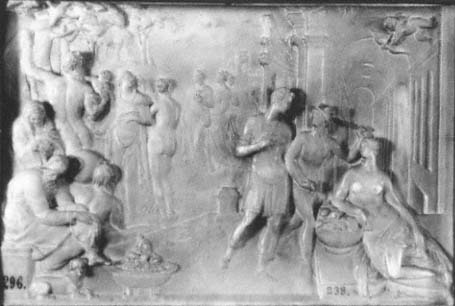
Figure 40.
Giambologna, Allegory of Prince Francesco de' Medici , c. 1560–61. Alabaster, 31 × 45 cm.
Museo del Prado, Madrid.
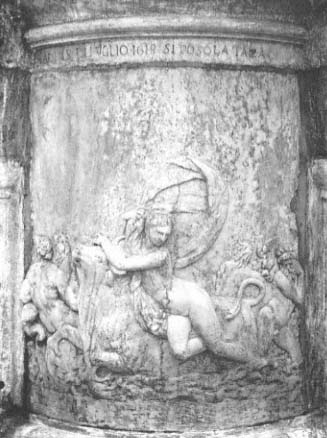
Figure 41.
Giambologna, Rape of Europa , c. 1574–75, marble.
Oceanus Fountain, Boboli Gardens, Florence.
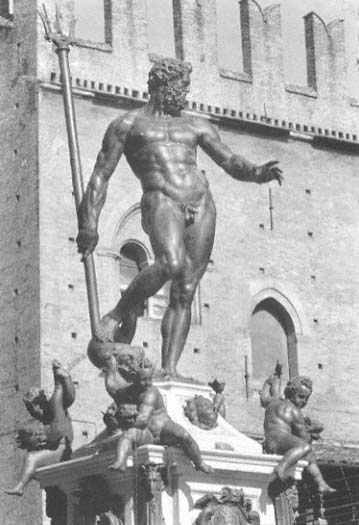
Figure 42.
Giambologna, Neptune Fountain, 1563–66. Bronze, 335 cm (Neptune figure).
Piazza del Nettuno, Bologna.
he was relatively inexperienced in relief sculpture, the Allegory of Prince Francesco de' Medici (Fig. 40) and the stone reliefs on the base of the Oceanus Fountain (Rape of Europa , Fig. 41) representing the extent of his work in that genre. In bronze, his expertise encompassed large works, such as the Neptune Fountain (Fig. 42) as well as many small statuettes in the same vein as the Studiolo Apollo (Fig. 43). The problems of narrative were even less familiar to him, and he had rarely dealt with religious subject matter, the Altar of Liberty (Fig. 24) for the cathedral in Lucca (1577–79) being the notable exception. Giambologna's only
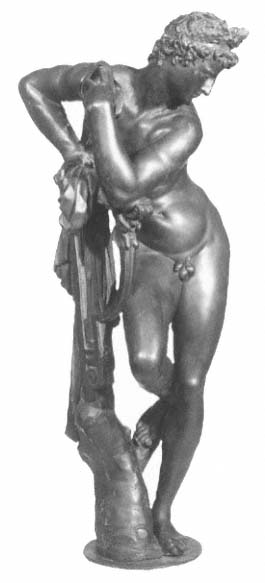
Figure 43.
Giambologna, Apollo , 1573–75. Bronze, 88.5 cm.
Palazzo Vecchio, Florence.
other religious and narrative work comparable in scale and significance to the Grimaldi Chapel was the Salviati Chapel (Figs. 20–22), just under way when the contract for the Grimaldi was signed. Both these relief cycles, with their new emphasis on narrative clarity and dramatic focus, belong to the reform age.
During the period when Giambologna was working on the Grimaldi Chapel commission, we recall that he was also finishing the famous Rape of the Sabines (unveiled in 1583; Fig. 1) and its relief. The differences, both obvious and subtle, between this work, even admitting its interpre-
tation as a political allegory of Medici rule, and the Grimaldi reliefs dramatize the revolutionary change being ushered in by the latter.[8] The two commissions share some of the same stylistic characteristics, but their goals are patently different.
In the Rape of the Sabines , solving a difficult problem of design is a principal goal. The statue is the paradigmatic embodiment of virtù, an ethical quality the sixteenth century ascribed to the arts; the demonstration of virtuosity that first engages the viewer is itself an indication of the artist's possession of virtù .[9] In the Grimaldi reliefs the story itself first compels attention. Remembering that a sixteenth-century viewer was attuned to the moral value of this demonstration, unlike the twentieth-century viewer, puts this argument in a historical, rather than a polemical, perspective. The Sabine statue, a true multiple-view work, met sixteenth-century theorists' demands that statues provide satisfying views from all sides. Spectators moving around the work experience continuously evolving views, which give the illusion of an action in progress. Even the relief (Fig. 44), with its extensive setting and pictorial form, although ostensibly a narrative, presumably intended to elaborate on the statue above, relegates the "story" to a subsidiary role, emphasizing, rather, the display of magnificent nude bodies engaged in physical struggle. One sees in this visual embellishment a parallel to the art of rhetoric in the late sixteenth century.[10] It is apparent that the impact of the relief on an audience conditioned by such theory does not lie in any story it illustrates but derives from the beauty of the design and its components: the complex intertwining of bodies, their torsion and sweeping gestures. Raffaello Borghini's story, already recounted, confirms what the eye perceives, that the aesthetic problem was the main preoccupation in both the freestanding group and the relief on the base. It is not that the statue and its relief are without subject but that the narrative content is secondary.
Two works by a single artist that are as diverse as the Rape of the Sabines and the Grimaldi reliefs owe their differences to context and function. The Rape of the Sabines is a secular work made, as far as we know, not to fulfill a commission but to appeal to the discriminating judgment of the cognoscenti. It certainly conformed to the taste of Grand Duke Francesco de' Medici, whose enthusiasm about it prompted him to have it placed prominently, next to Cellini's Perseus in the Loggia dei Lanzi, Piazza Signoria. In contrast to the Sabine statue, the Grimaldi cycle, falling in the religious sphere, had to satisfy other requirements; surely
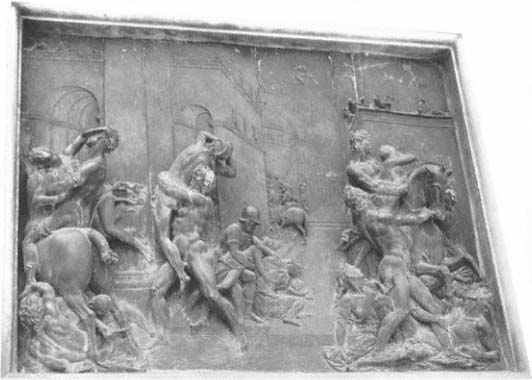
Figure 44.
Giambologna, Rape of the Sabines , 1582–83. Bronze relief, 74 × 89 cm.
Loggia dei Lanzi, Florence.
it would have been affected by the Council of Trent's general statement on art at its twenty-fifth session, in 1563, which set the stage for specific directives on the representation of sacred subjects. Local synods, led by powerful churchmen such as Gabriele Paleotti and Carlo Borromeo, then elaborated on these.[11]
Within the overall structure of his narrative Giambologna's technical means are visible principally in the composition of the reliefs: in the spatial layout and the figural and architectural groupings. But he went further than simple narrative clarity. He introduced the multiple-view technique in conjunction with multipoint perspective, thus inviting the spectator's active participation and psychological involvement in the developing narrative.
Each of the Grimaldi reliefs is similarly organized on a tripartite division of the major elements of the composition, as others have observed.
In Christ before Pilate (Plate 7), for example, there are three distinct groups of figures—Pilate's on the right, Christ's in the center, and the soldiers on the left. The architectural setting reinforces the division of the groups.
Though out of fashion in the mid-sixteenth century, this tripartite scheme had been a common compositional device in the fifteenth century and the early sixteenth. It appears as an organizing principle in theory too. Alberti's De Pictura was made up of three parts, a structure derived from the classical educational text.[12] He defined an artistically composed painting as one that represents exemplary events, expresses moral conviction, and embodies a figural allegory.[13] In the visual arts, this traditional tripartite Renaissance scheme, conspicuous in Masaccio's Tribute Money and followed in works such as Fra Angelico's Descent from the Cross (1430–34; Museo di San Marco, Florence) and Ghirlandaio's Miracle of the Spini Child (Fig. 45), was carried into the sixteenth century in Raphael's Vatican frescoes and tapestry designs, among other works. In both the Fra Angelico and Ghirlandaio the figures on either side of the central group serve as buttresses to the main event and stabilize the scene. The witnesses stand immobile as they watch the central group. A perspective view into the distance establishes the locale and gives a sense of vast space. An equally symmetrical but less severe use of the tripartite composition is apparent in Raphael's School of Athens , where architecture provides the structure but where the figures are placed in harmonious groups throughout the space instead of being relegated principally to the foreground, as in the Fra Angelico and the Ghirlandaio.
Florentine painters like Santi di Tito and Jacopo da Empoli, who were instrumental in transforming painting toward the end of the sixteenth century, turned for inspiration to Andrea del Sarto, in whose work they found the way to a revival of direct narrative, which characterized this reform in art.[14] Giambologna, too, when planning the Grimaldi reliefs, turned to painting, much as some earlier sculptors had done. Benedetto da Maiano, for example, drew freely on Ghirlandaio's designs for the Sassetti Chapel in Santa Trinità in composing his Saint Francis cycle for the pulpit in Santa Croce, Florence (Fig. 46). During Maiano's time relief often attempted to rival the pictorial qualities of painting and the distinctions between sculpture and painting, between three-dimensional and two-dimensional media, were virtually eliminated. Given his strong pictorial interest, Giambologna naturally turned to Andrea's Scalzo fres-
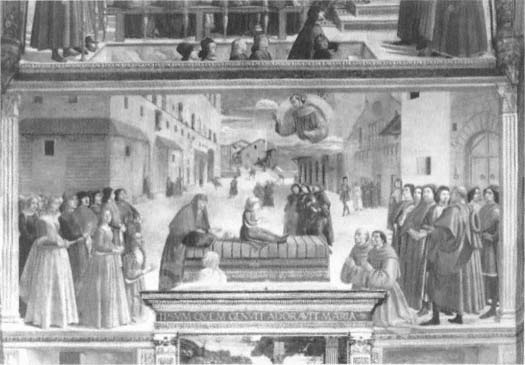
Figure 45.
Domenico Ghirlandaio, Miracle of the Spini Child , 1483–86, fresco.
Sassetti Chapel, Santa Trinità, Florence.
coes, a well-known cycle painted for the Confraternity of the Discalced Carmelites in Florence (1515–17, 1521–26).[15] Like relief, the Scalzo paintings are monochromatic; they are even composed to have a sculptural effect.[16] Furthermore, their subject, events from the life of John the Baptist, is similar enough to that of the Grimaldi cycle to have provided a rich fund of compositional ideas for Giambologna. Andrea's combination of clear exposition and suave, sophisticated figure style must also have appealed to Giambologna. A closer look at some of the individual Scalzo scenes shows how Giambologna used them as a starting point for his own designs.
Andrea's paintings, although monumental in scale, have an intimate effect in comparison with similar designs by Raphael, such as The Conversion of the Proconsul (cartoon in Victoria and Albert Museum, London). The reduced scale and simplified architecture as well as the smaller number of figures and their physical proximity made Andrea's cycle an
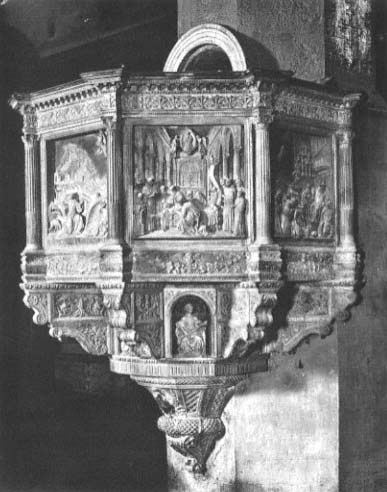
Figure 46.
Benedetto da Maiano, Pulpit, c. 1474–75, marble.
Santa Croce, Florence.
appropriate point of departure for Giambologna. Like Andrea in The Banquet of Herod (Fig. 47), Giambologna based his organizational plan on the familiar tripartite centralized scheme (Christ before Pilate , Plate 7). And like Andrea in The Decollation of the Baptist (Fig. 48), he evidently reveled in the display of muscular anatomy, tempered, however, by the smoothness evident in the figures of The Flagellation (Plate 8). Nonetheless, the differences between Giambologna's reliefs and Andrea's paintings are telling. Giambologna has modified Andrea's rigid tripartite scheme, as a comparison of The Banquet of Herod with the Grimaldi
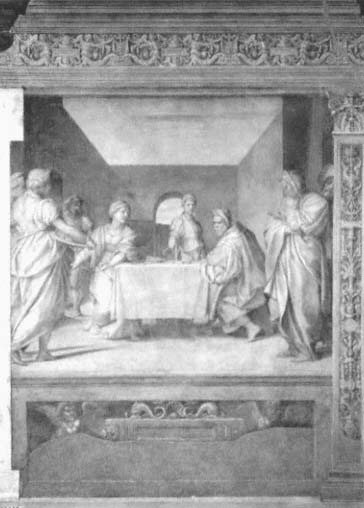
Figure 47.
Andrea del Sarto, The Banquet of Herod , 1521–26, fresco.
Chiostro dello Scalzo, Florence.
Christ before Pilate shows. Whereas Andrea's design, chiefly through its architecture, is emphatically centralized and static, Giambologna's appears slightly shifted to the left by the wall behind the main group. Austere architecture is present in both works, but Giambologna uses it to create a complex succession of spaces that recede into the background and effectively intensify the drama. The dynamic quality of The Flagellation owes much to Giambologna's use of a vanishing area around the place of action, rather than a single vanishing point in the center of
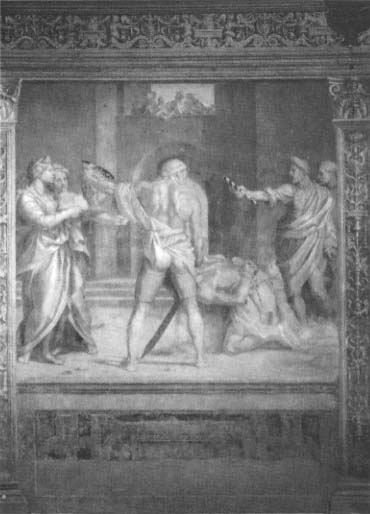
Figure 48.
Andrea del Sarto, The Decollation of the Baptist , 1521–26, fresco.
Chiostro dello Scalzo, Florence.
the scene, as in Andrea's Decollation of the Baptist . Giambologna's figures shift their weight as if in the midst of activity; Andrea's executioner is planted squarely in the center of the picture, feet firmly on the ground and weight evenly distributed. The action depicted in the relief is still in progress; that in the painting has been completed. In sum, Giambologna provides a richer and more subtle narrative.
Although he adopted the tripartite system for the Grimaldi reliefs, Giambologna varies it from relatively strict symmetry to a more asym-
metrical arrangement. In all the reliefs there are two groups close to the viewer on either side of a principal group, placed back slightly. This affords the viewer a clear passage into the scene while simultaneously defining the spatial limits of the event. Four of the reliefs, Christ before Pilate, The Flagellation, Christ Crowned with Thorns , and The Way to Calvary (Plates 7–9, Fig. 5), are symmetrical, with the central placement of the main figures emphasizing the tripartite arrangement. The central group in these four reliefs is the first to catch the viewer's eye. The side groups act as parentheses. In Ecce Homo (Plate 10) and Pilate Washing His Hands (Plate 11), which are more asymmetrical, the main groups are shifted off to one side, leaving the crowd to occupy the left half of Ecce Homo and Christ's group to occupy the right center of Pilate Washing His Hands . Significantly, these variations in the triadic grouping serve the dramatic needs of the narrative. The crowd's responsibility for condemning Christ and its participation in the condemnation in Ecce Homo are accentuated because the crowd itself is shown as a unified group clamoring for and pressing in on the defenseless victim. In Pilate Washing His Hands , the placement of Pilate's group to the left and Christ's deeper and to the right of center heightens the import of the subsidiary event.
Diagonals figure prominently in the organization of the composition and the handling of space. For example, in Christ before Pilate (Plate 7) and Pilate Washing His Hands (Plate 11) they underline the psychological significance of the deep corridors of space between Pilate and Christ. Further, they organize the figures into groups, creating relationships between individual figures in the groups that highlight the dramatic events of the story. This technique is particularly evident in Pilate Washing His Hands , where the striking impact of the diagonally positioned group leading Christ away is largely due to its placement. The physical force of the exit and the import of Pilate's decision are thus accentuated. Similarly, a strong dramatic clarity prevails in Christ before Pilate and in Ecce Homo .
Diagonals not only organize the figural groups but also relate them to one another within a scene to focus and clarify the action. Christ Crowned with Thorns (Plate 9) is a case in point. The soldier on the left, nearest the spectator, links the central group with Christ to the crowd packed under the arcade at the left. He stands obliquely to the picture plane, glancing emphatically back over his shoulder at the group in the arcade, but with his body turned to face Christ's group in the center. By connecting the groups, his figure establishes the flow of the narra-
tive. The same figure also links the relief with the spectator's space. His right arm, conspicuously bent and resting on his hip, boldly breaks the surface of the relief and emerges on a diagonal directly into our space. His legs—the outer one flexed slightly, the inner one more—are positioned to produce the illusion of movement if the viewer shifts to either right or left. The same articulation is used in the figure of the tormentor to Christ's right. A close analysis of the placement of Christ's body in space reveals a similar composition. Different parts of his body are subtly adjusted to relate to both groups of spectators within the panel and to those looking from outside the relief as well. The turn of Christ's head to the left side of the scene is powerful enough to balance the direction of his torso and legs, which are turned to the right. The inclination of his head, as well as that of other figures, and the exchange of glances between them, operate diagonally, reinforcing the illusion of depth and relating parts of the scene to one another.
Joined to the function of diagonals and crucial to the dramatic success of these scenes is Giambologna's construction of the space in relation to the figural grouping. He conceived space dynamically and has, accordingly, given it an active role, thus intensifying the viewer's perception of the human confrontations. In the reliefs of Donatello, Giambologna must have found inspiration for the manipulation of space to create dramatic tension. In Donatello's Feast of Herod relief (Fig. 49), for example, the use of space intensifies the emotional content of the episode. Although it is the severed head of the Baptist that makes all the spectators recoil, those crowded at the right seem to have been pushed back even further from the horror they see, leaving a void at the foreground that is singularly effective in conveying their revulsion.
Giambologna's continuation and development of Donatello's idea may be seen in the panel Christ before Pilate (Plate 7), where the space created by the barrel-vaulted colonnade serves both as a compositional and as a dramatic focus. The viewer's eye is arrested at this point and the mind is engaged in the dramatic confrontation between the main characters of the drama. The plunging space separates Christ and Pilate physically and psychologically, while the archway over the space connects them visually. Once this connection is established, the bridge created by the archway draws the viewer's eye into the conflict. Thus pictorial space is used to express the main actors' psychological isolation from one another, while the architectural design binds them together in the same physical environment.
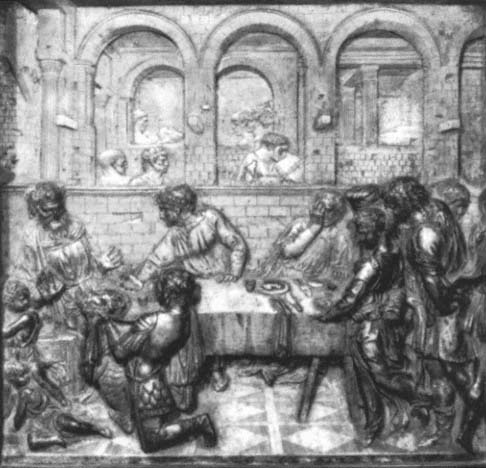
Figure 49.
Donatello, The Feast of Herod , c. 1425. Gilt bronze, 58 × 58 cm.
Baptistery, Siena.
Architectural components enhance the expressive role of space, serving as structural devices and playing against the illusionism in each relief. Deep spaces created by architectural settings in both Ecce Homo (Plate 10) and Pilate Washing His Hands (Plate 11) help produce a strong emotional effect. In Ecce Homo , a scene fraught with conflict between Pilate and the crowd, prominent steps and a long narrow street between loggia and buildings separate the two groups. The steps provide the physical bridge, whereas the space between buildings emphasizes psychological
separation. Pilate Washing His Hands , in which Pilate's wish to be absolved from the responsibility of condemning Christ is countered by the soldiers dragging Christ off, is even more poignant. The void placed conspicuously almost at the center of the composition embodies the sense of separation and ultimate tragedy of the scene.
Space, besides being an active participant in the relief scenes, works interdependently with time. As the narrative unfolds, the viewer is presented with long vistas down arcades and streets and incomplete views of buildings, as in Christ before Pilate (Plate 7) and The Flagellation (Plate 8). Perhaps Giambologna's ideas for these sweeping vistas came from his Florentine contemporaries Mirabello Cavalori and Girolamo Macchietti, with whom he had worked side by side a decade earlier in Prince Francesco de' Medici's Studiolo in the Palazzo Vecchio. Both Cavalori's Wool Factory (early 1570s) and Macchietti's Baths of Pozzuoli (Fig. 50) are remarkable for their breathtaking vistas down corridors created by architectural surroundings.[17] To return to Christ before Pilate , the partial view strongly implies the presence of what is unseen. Space becomes infinite and continuous and suggests that the scene could change at any moment; more people and more buildings might appear. The impression of transience introduced here by Giambologna's use of the fragmentary is an attempt to relate the represented event to the viewer's own experience in life. A highly pictorial treatment of the backgrounds is counterbalanced by the tangibility of the foreground groups, a technique in which figures emerge almost fully rounded to form a bridge between the illusion of three-dimensional space and the reality of the observer's space.
As I remarked earlier, one of Giambologna's major concerns in the Grimaldi reliefs was the relationship between the viewer and the event depicted, a concern that had occupied artists for more than a hundred years. Alberti had recommended that each work of art have one figure whose sole function was to make contact with the spectator and to point out the action in the picture.[18] There are numerous examples of such figures in both painting and relief from the early fifteenth century through the sixteenth. Apparently following Alberti's prescription, Fra Angelico in his San Marco altarpiece (Fig. 51) placed the saint conspicuously in the left foreground, where, by glance and gesture, he invites the viewer to focus on the Madonna and Child, seated well back in space in the center of the painting. Botticelli's 1472 Adoration of the Magi (Uffizi, Florence) also uses such a device.
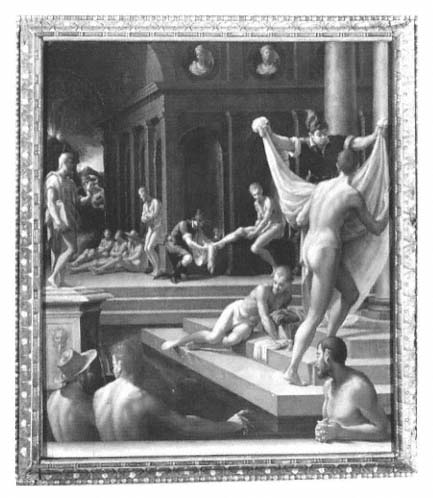
Figure 50.
Girolamo Macchietti, The Baths of Pozzuoli , 1570–72.
Studiolo of Francesco I, Palazzo Vecchio, Florence.
By the early sixteenth century, contact with the spectator in the work of the first-generation mannerists assumed a major, often exaggerated, importance. The two youths carrying the body of Christ in Pontormo's Santa Felicità Entombment (Fig. 52) almost dominate the work because of their insistent contact with the viewer, as they stare intently out of the painting. In maniera paintings such as Bronzino's Christ in Limbo (Fig. 53), it is standard to have at least one prominent figure look straight at the spectator. Diverting attention from the focus of the narrative, these conspicuous interlocutors follow the tradition of rhetorical embellishment and ornament esteemed by Florentine cognoscenti like the artist-critic Giorgio Vasari and his close friend and intellectual advisor Vincenzo Borghini.
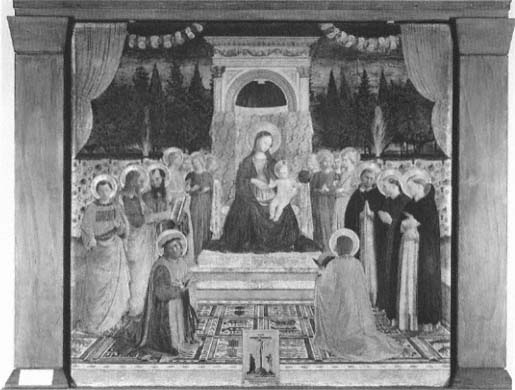
Figure 51.
Fra Angelico, Madonna and Saints , c. 1438–40. Panel, 219 × 227 cm.
Museo di San Marco, Florence.
In the Grimaldi reliefs, Giambologna changes the viewer's relationship to the work of art from a self-conscious appreciation of the aesthetic content to a direct involvement in the story. The intention is not, as in maniera works, to call attention to the contact figure by isolating it from the rest of the composition but to put the viewer in closer touch with the scene. Consequently, Giambologna places one or more sculpted spectators at the edge of the relief, often overlapping the frame and thus penetrating the viewer's space. Donatello's fifteenth-century San Lorenzo pulpits, outstanding examples of interaction between viewer and image that had been reinstalled in the nave of the church in the sixteenth century, were important precedents for Giambologna. Spectators in his works, as in Donatello's, create a tangible physical connection to the viewer's environment. With respect not only to the viewer but also to the episode illustrated, the spectators in each Grimaldi panel bridge the gap between fictive and real space and invite the viewer to
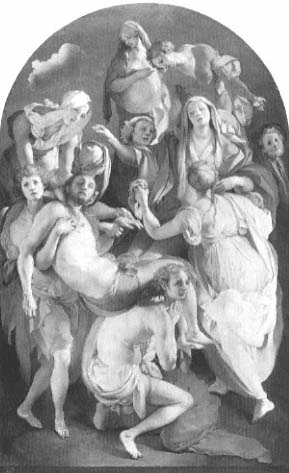
Figure 52.
Jacopo Pontormo, The Entombment , 1525–28. Panel, 312 × 193 cm.
Santa Felicità, Florence.
enter the scene. The figures in the crowd in Ecce Homo (Plate 10) are examples. They stride in at an oblique angle from both sides, that is, from the viewer's space. The open foreground of the relief makes the viewer part of the crowd. Similarly, in Pilate Washing His Hands (Plate 11), viewers can easily take their place beside the man stroking his beard at the left edge of the panel.
But Giambologna's principal way of changing the relationship between viewer and work of art was his creation of multiple views in his reliefs, as in his freestanding sculptures. A sculptural composition having multiple views, that is, having more than one or two satisfactory view-
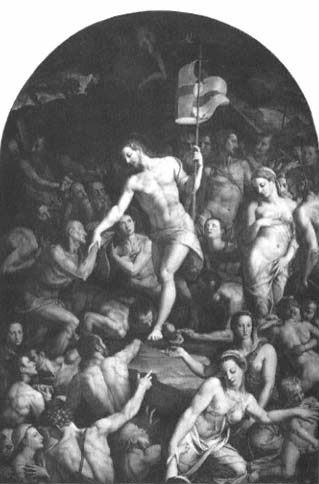
Figure 53.
Bronzino, Christ in Limbo , 1552.
Museo di Santa Croce, Florence.
ing points, enabled, indeed required, the viewer to assume more than one position. Although the spectator can take in only one view at a time, a succession of views in a work so constructed exists in the mind as an ongoing experience. Giambologna's Rape of the Sabines (Fig. 1), for example, impels the viewer to circle the work to gain its full impact. The concept of multiple views, current in Florence in the mid-sixteenth century, is most commonly associated with freestanding sculpture. Although it may seem impossible to apply it to relief, which cannot be circled, it works within the limitations determined by the planar character of the relief.
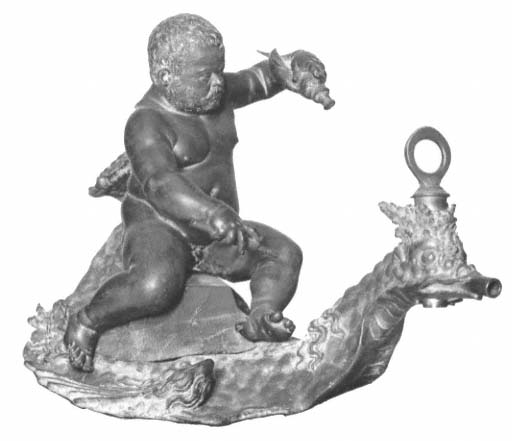
Figure 54.
Giambologna, Morgante , c. 1582. Bronze, 36.5 cm.
Museo Nazionale, Florence.
The ideal realization of the multiple view was a matter of considerable debate among theorists and artists. Although Cellini, for example, in his reply to Benedetto Varchi's Inchiesta of 1546 on the relative merits of painting vis-à-vis sculpture, wrote that a statue ought to have eight views, his opinions on this subject were not always consistent.[19] Vasari explains in his Vite that a statue should look equally satisfying from all sides. Echoing Vasari's opinion, Raffaello Borghini, in Il riposo , 1584, says that freestanding sculptures should be made so that they can be admired from all sides. Giambologna, closely associated with the group that congregated at the Villa Il Riposo to discuss this and many other aesthetic issues, must have been concerned with them himself. A sculpture less well known than the Rape of the Sabines but equally brilliant, the little bronze fountain figure Morgante (Fig. 54) illustrates how perfectly
Giambologna understood the concept of the continuous multiple view, which could be realized only in sculpture.[20] In these works the kinematic effect created by constantly evolving views produces the illusion of an action in progress, requiring the physical participation of the viewer.[21] Each position of the spectator is linked to the one before and to the one that will follow, to create a chain of temporal and spatial experience. As the spectator changes position, the work of art appears to move into a subsequent moment of the action or event. Time thus becomes an issue in the meaning of the work. The unfolding of time through the active participation of, rather than the passive viewing by, the spectator creates a dynamic interaction between viewer and work of art. Throughout his career Giambologna was occupied with the problem of multiple views in freestanding sculpture. The Grimaldi commission gave him an opportunity to develop the technique, this time in relief and with the objective of producing a viewer-oriented narrative of Christ's Passion.
Perhaps Giambologna had a further motive, conscious or not, for using multiple views in the Grimaldi reliefs: his desire to add another chapter to the paragone debate. Relief is a pictorial competitor of painting, but it is also a bridge between sculpture and painting and therefore a means of eliminating the separation and accomplishing the unification of the arts, an issue of prime significance in the late sixteenth century.[22] In his 1546 Inchiesta Varchi had elicited the opinions of famous artists such as Michelangelo, Cellini, and Bronzino on the relative merits of painting and sculpture. Cellini's claims concerning multiple views put sculpture ahead. In about 1553, however, Bronzino, in his double-sided painting of Morgante (according to an article by Holderbaum), successfully refuted Cellini's claims for sculpture.[23] In the 1580s Giambologna took up Bronzino's challenge in the bronze Morgante , ostensibly reestablishing the supremacy of sculpture. Extending this innovation into the medium of relief was Giambologna's extraordinary accomplishment.
The implications of combining the multiple-view technique and multipoint perspective in narrative relief are worth considering. Such works of art have no single ideal viewing point, or even fixed alternative viewing points, but can be seen from different angles, from which their subjects read differently. Furthermore, different views evoke different responses. Any of the Grimaldi reliefs may be seen satisfactorily from many positions, but at each they take on a different shade of meaning. Multipoint perspective is a necessary corollary of multiple views. Ac-
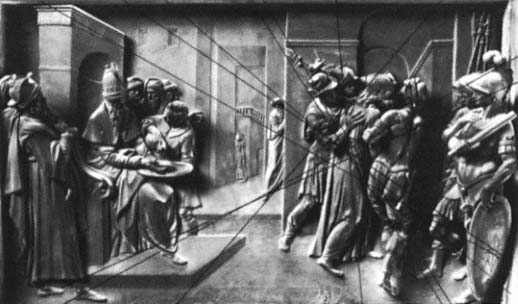
Figure 55.
Giambologna, Pilate Washing His Hands , c. 1585–87. Bronze, 47 × 71 cm, with overlay.
cording to this system, a fixed or single vanishing point is replaced by a vanishing area in which orthogonals converge (Fig. 55). As a consequence, the action portrayed appears to unfold, and the viewer is freed from the fixed viewing point.
If we take as a demonstration three views from different vantage points of Pilate Washing His Hands (Figs. 56a–c), we can see how this phenomenon works. These three, among the many views possible, show an unfolding narrative. The multiple-view technique that creates this narrative also permits relief to function like freestanding sculpture.[24] A viewer standing at the left side of the relief close to the relief figure near that edge (Fig. 56a) sees the scene from that figure's vantage point. Christ's frail body on the far side of the relief nearly disappears under the rough handling of the two soldiers who push and drag him away. Twisting sharply and tensing their muscular bodies, the soldiers stride off with their prisoner in a compact group, which is set on a striking orthogonal. The viewer looking at the back of Christ's head as he is being pulled away clearly sees three soldiers lined up at the right edge
of the relief. The most prominent of the three overlaps the frame; the turning of his body propels the viewer's eye toward the center of the relief. Here, the corridor of space between the buildings seems traversable even as it distinctly separates the activities of the two main actors in the story. From this vantage point the face of a significant actor in the drama, the young black boy who pours the water for Pilate's hand washing, is riveting.
From a position directly in front of the relief (Fig. 56b), the overtones of the event change subtly. The irregular triangular space in the center foreground emphatically separates Pilate's group from Christ's, making the action instantly comprehensible. Viewers have a clear, if somewhat detached, view of the scene, comparable to that of an audience watching a play. From this vantage point the acute orthogonal created by the bodies and legs of the soldiers shoving Christ away propels the eye directly from the lower right corner of the relief to Pilate's group on the other side. His group, in turn, arranged on a less acute orthogonal, directs the eye down the street into deep space. The clear and judicious placement of the figures in their architectural setting thus both separates and relates these two groups.
Still a third viewing point, from the right of center (Fig. 56c), produces another impression of the event, one that involves the viewer more intensely in the drama, partly because the group with Christ is now physically closer. This intense involvement begins with the view of the bulging muscular back of the soldier grasping Christ. His physical effort, evident in all of his flexed muscles, is matched by the intentness of his gaze into Christ's face. Just as engrossed, the soldier on the other side of Christ stares at the back of Christ's head, pushing vigorously from behind. The dramatic effect of these two powerfully activated figures is strengthened by their proximity to the fragile figure of Christ, who makes no effort to resist. The simultaneous view of Pilate, who concentrates on his hand washing while the young black servant stares into his face, heightens the import of the hand-washing ritual. The figure at the left edge of the relief who overlaps the frame, into whose face we look, leads back again to Christ's group.
The result of assuming a succession of vantage points in front of Pilate Washing His Hands would be variations of the three impressions of the scene just described. Although any view of the relief presents an understandable image, a shifting physical relationship yields subtle changes of meaning.[25] Accordingly, the story is not limited to one interpretation.
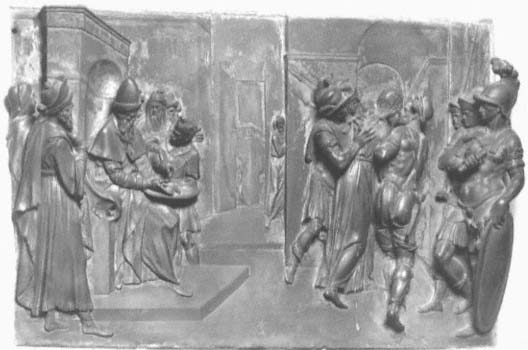
Figure 56a.
Giambologna, Pilate Washing His Hands , from the left.
Università, Genoa.
Shifting views can, for example, focus on Pilate's effort to absolve himself of the responsibility for Christ's condemnation or on the plight of Christ in the hands of the soldiers. The multiple views expose the richness and complexity of a story, laden with psychological and moral questions, that might otherwise have been limited in time and space.
The other Grimaldi reliefs similarly exemplify the effect of varying points of view on a viewer's interpretation of the subject. A frontal view of Ecce Homo (Fig. 57a) suggests to the viewer the noisy clamor of the gesticulating crowds on either side of Christ. From the left (Fig. 57b), however, the fragile bent figure of Christ above the throng gains the viewer's undivided attention. A similar effect prevails in The Way to Calvary (Figs. 58a–c), despite its flatter surface. The dramatic meeting of Christ and Veronica commands the attention of the viewer who stands just to the right of center of the relief (Fig. 58b). Moving close to Veronica's own position, farther to the right, the viewer is able to experience her more personal involvement as she looks into the face of Christ
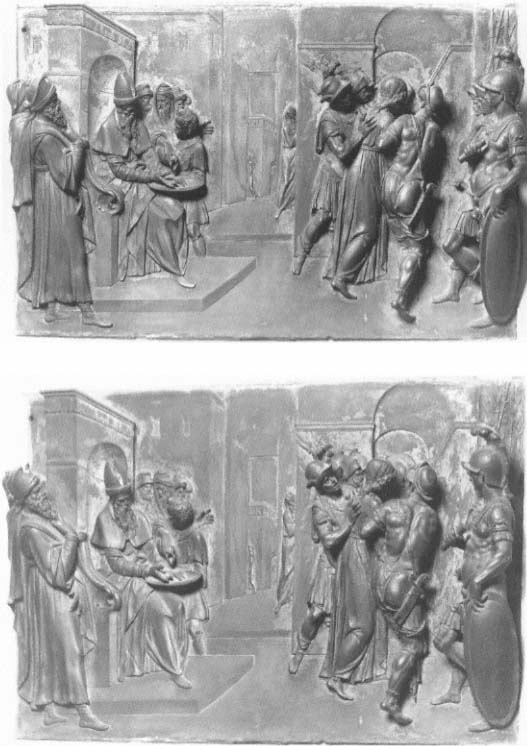
Figure 56b (top of page).
Giambologna, Pilate Washing His Hands , frontal view.
Università, Genoa.
Figure 56c (above) .
Giambologna, Pilate Washing His Hands , from the right.
Università, Genoa.
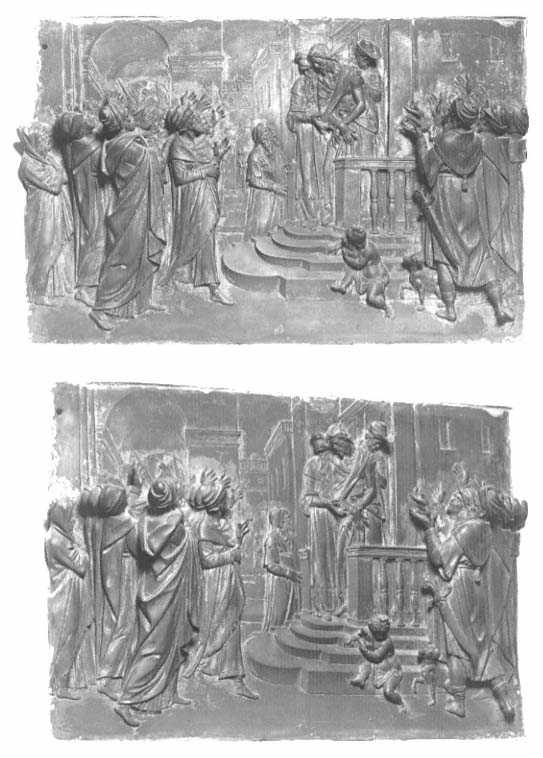
Figure 57a (top of page).
Giambologna, Ecce Homo , c. 1585–87. Bronze, 43 × 71 cm, frontal view.
Università, Genoa.
Figure 57b (above) .
Giambologna, Ecce Homo , from the left.
Università, Genoa.
(Fig. 58c). The advancing row of horses and soldiers at the left conveys the inevitability of this death march.
Thus Giambologna's narrative reliefs, by presenting the spectator with many possible views, effectively attack what might be called the tyranny of the single point of view and give the spectator a freedom of choice and an opportunity to become deeply involved in the nuances of the story, an altogether more subjective approach to visual representation than had occurred previously. A consideration now of some earlier masterpieces of pictorial relief can help us judge Giambologna's place in the history of the genre. He was both eclectic and synthetic in his achievement.
Many works of two great revivers of pictorial relief in the early Renaissance, Ghiberti and Donatello, whose Feast of Herod (Fig. 49) has been discussed, were visible daily to Giambologna in Florence from his arrival in 1556.[26] Reminiscences of Ghiberti's flowing rhythms and lyricism are found in some passages of the Grimaldi reliefs, especially in the figure of Christ in The Flagellation (Plate 8), strikingly similar in form and effect to the Christ of Ghiberti's Flagellation (Fig. 59) on the north doors of the Florentine Baptistery. The grace and beauty of both are reminiscent of the late classical style of Praxiteles, as seen in the Apollo Sauroctonus.[27] The ancient work's celebration of soft sensuous male beauty becomes in the Christian context of the Flagellation a reflection of the beauty of the divine.
The opportunity to study Ghiberti's relief cycle of Christ's life on the north doors of the Baptistery as well as his magnificent cycle of Old Testament scenes on the Gates of Paradise must have had its effect on Giambologna. Taking his cue from Ghiberti in creating a supportive but unobtrusive setting, Giambologna established a proportional relationship between figures and architecture similar to that in the north doors, as a comparison of Giambologna's Pilate Washing His Hands (Plate 11, Fig. 56b) with Ghiberti's (Fig. 60) shows. Giambologna's relief seems a further development and elaboration of the basic idea formulated by Ghiberti over a hundred years earlier, in which the figures dominate but the architecture provides the essential locus and helps accent the principal figures. Ghiberti's relief, however, has only the barest hint of spatial illusionism in the background, which crowds in on figures that almost completely fill the foreground. In the Ghiberti panel, unlike the Grimaldi, nearly all the space derives from that created by the figures themselves. Rather than crowding his figures on the foreground plane as Ghiberti did, Giambologna has distributed them in a gradually receding
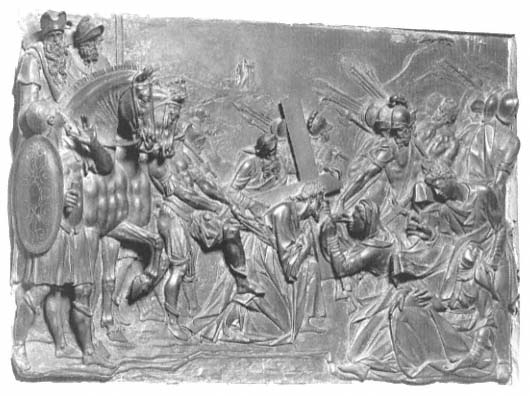
Figure 58a.
Giambologna, The Way to Calvary , c. 1585–87. Bronze, 47 × 73 cm, from the left.
Università, Genoa.
space, which derives its limitless appearance partly from the architecture of the setting. Furthermore, Ghiberti seems not to have taken the spectator's position into consideration, as Giambologna so clearly has.
Some of the feeling of spatial illusionism and amplitude in Ghiberti's Jacob and Esau (Fig. 61) has been adapted by Giambologna, whose rectangular format, however, lends itself to a tighter structure in which the figures are relatively more important; Ghiberti's nearly square format results in an airy composition that exudes a sense of tranquillity and harmony despite the intensity of the event. Giambologna's narrative, in contrast, is laden with dramatic tension.
More significant, however, is the difference between Ghiberti's simultaneous narration, in which several episodes of a story are represented in the same picture frame, as it were, and Giambologna's multiple views.[28] In simultaneous narration observers seem to have the freedom to "read" the image as they will, but in fact, if the story is to be understood, there is only one way to read it, in the correct temporal sequence.
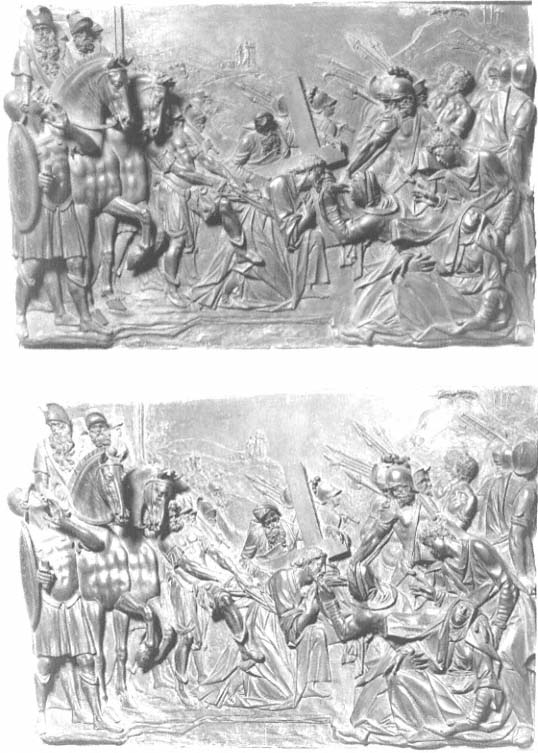
Figure 58b (top of page).
Giambologna, The Way to Calvary , frontal view.
Università, Genoa.
Figure 58c (above) .
Giambologna, The Way to Calvary , from the right.
Università, Genoa.
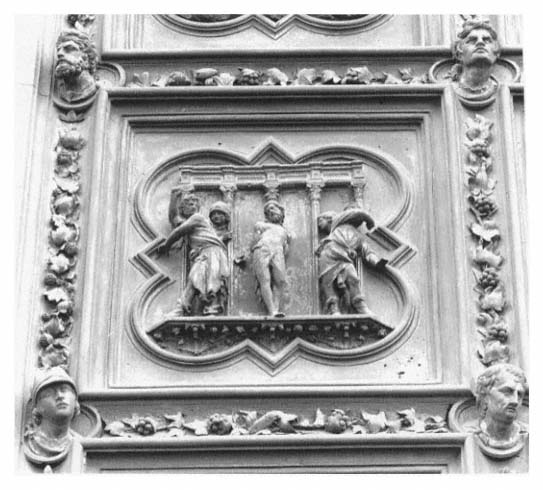
Figure 59.
Lorenzo Ghiberti, The Flagellation , c. 1416–19. Gilt bronze, 46 × 40 cm.
North doors, Baptistery, Florence.
In contrast, Giambologna's multiple views of a single episode give the viewer the opportunity to experience shades of meaning in an unfolding narrative.
But the multiple-view device operates only when accompanied by infinite, or continuous, gradations of relief, as in the Grimaldi cycle. Ghiberti's Pilate Washing His Hands (Fig. 60) admirably demonstrates the difference between continuous and noncontinuous gradations. Each layer or level of Ghiberti's figures projects a uniform distance from the plane, to which the figures themselves are parallel or oblique. They are not, in other words, composed, like Giambologna's, in spirals that give the effect of continuous gradations of relief. His technique not only
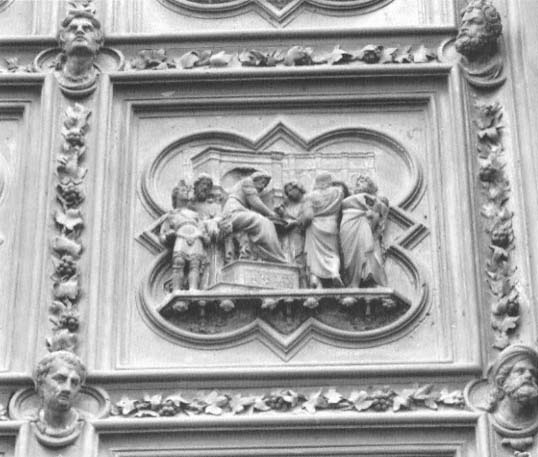
Figure 60.
Lorenzo Ghiberti, Pilate Washing His Hands , c. 1416–19. Gilt bronze, 46 × 40 cm.
North doors, Baptistery, Florence.
gives convincing three-dimensionality to the figures but also suggests movement in and out of a space that is not divided into either compartments or successive parallel planes. Many single figures demonstrate continuous gradation from high relief to schiacciato . One such notable figure is Simon of Cyrene, who helps Christ carry his cross (Fig. 62) in The Way to Calvary . The head, modeled in high relief, projects toward the spectator, casting a prominent shadow, while the left arm flattens out behind an arm of the cross, only to reemerge as Simon's hand grasps the top of the cross near Christ's head. Similarly, the head of Christ in Ecce Homo (Fig. 63) is actually detached from the ground; his bare arm is modeled in the round, while much of his body seems to recede into
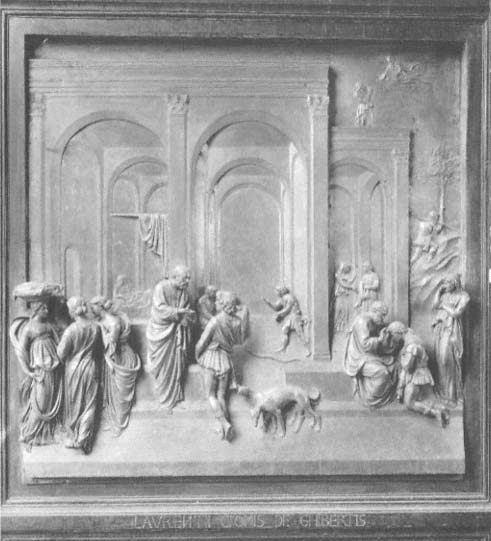
Figure 61.
Lorenzo Ghiberti, Jacob and Esau , c. 1435. Gilt bronze, 70.8 × 70.8 cm.
Gates of Paradise, Baptistery, Florence.
the matrix of the panel. Equally impressive is the handling of the man standing in the center foreground of the crowd (at the left in Fig. 63). His far side and midsection cling to the panel, while his head, shoulder, cape, and right leg (see Plate 10) bend out toward the viewer. Infinite gradations, such as those found in single figures like these, play a prominent role in the overall effect of each relief in the cycle. Again in The Way to Calvary (Figs. 58a–c), although it is the relief with the least pro-
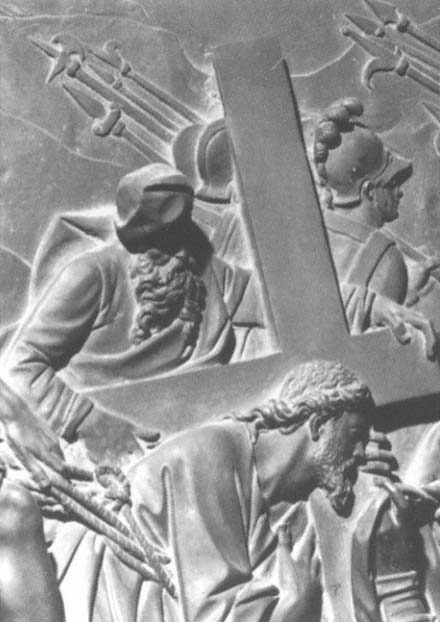
Figure 62.
Giambologna, Simon of Cyrene, detail from The Way to Calvary , c. 1585–87, bronze.
Soccorso Chapel, Santissima Annunziata, Florence.
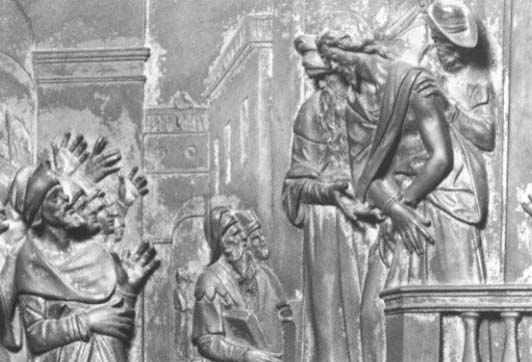
Figure 63.
Giambologna, Ecce Homo ,c. 1585–87, detail, bronze.
Università, Genoa.
jection, continuous gradation from high to low is clearly visible. Between the projecting body of the soldier at the far left, who stands in the viewer's space, and the shoulder of the soldier to the right of the horses, the projection of the figures continuously diminishes so that the figures in the distant landscape appear as little more than "graffiti."
When devising ways to enliven the Passion scenes, Giambologna undoubtedly recalled Roman art, which makes extensive use of continuous gradations in relief. As a young sculptor he had spent two years, 1554–56, in Rome.[29] The accounts of his Roman sojourn, however meager, all attest to his admiration for Roman sculpture, recording that he made many models of famous works in wax and clay, which he brought with him to Florence in 1556.[30] Roman reliefs existed in abundance for him to see. On this first visit, as well as on subsequent trips to Rome, Giambologna would have been fortunate enough to see such monuments as the passageway reliefs on the Arch of Titus, still free of the disastrous effects of air pollution. The Roman genius for creating the excitement and immediacy of an event, particularly in art of the
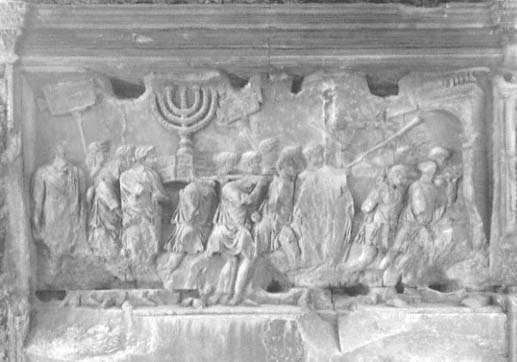
Figure 64.
Procession of Spoils of Jerusalem , A.D. 81, marble.
Arch of Titus, Rome.
Flavian period, must have sparked Giambologna's interest.[31] The Procession of Spoils of Jerusalem (Fig. 64) from the Arch of Titus exhibits a spatial illusionism, similar to that of the Grimaldi reliefs, created by figures that emerge gradually from the subtlest low relief in the background to higher and finally almost fully rounded forms in the foreground. Such is the sense of immediacy that the action seems to take place before our eyes. Other elements of these reliefs also resemble elements of Giambologna's—relationships between figures and setting, for example, in which figures dominate while the setting provides support for the evolving drama. Ostensibly realistic details detectable in the Grimaldi panels, such as the accurately rendered dress of the Roman soldiers and the handling of the soldiers' spears, evoke the flavor of the early first-century Roman world and place Christ's Passion in its historical setting. Relief in the Grimaldi cycle varies from a maximum projection of 10 centimeters to a minimum of barely 1 centimeter, so that the figures emerge and recede in a spatial arena that mimics the space of the spectator. Concomitantly, figures twist and turn through spatial planes, creat-
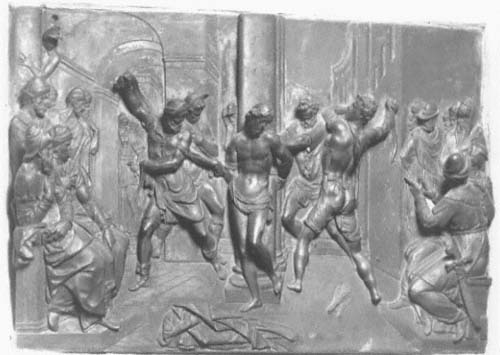
Figure 65a.
Giambologna, The Flagellation , c. 1585–87. Bronze, 47 × 73 cm, from the left,
Università, Genoa.
ing the illusion of a spiraling motion that leads the eye continuously around the panel as if an extended contrapposto infused the whole composition.[32]
How well this device works with that of multiple views may be seen in the familiar example of Pilate Washing His Hands (Plate 11, Figs. 56a–c). The body of the muscular soldier dragging Christ away is a spiral that culminates in his head, leading the eye around behind the figure of Christ to the other soldier pushing Christ from behind. The action of this group is thus completed. Simultaneously, the tilted head and bent arm of this second soldier carry the eye to the other side of the scene where Pilate is washing his hands. In Pilate's group the sharp torsion of the black boy's body unites the group behind him and focuses the viewer's attention on Pilate, whose chest and shoulders turn toward the viewer while the lower part of his body extends toward Christ and the soldiers.
The most active of the reliefs, The Flagellation (Figs. 65a–c), demonstrates how the twisting and turning of figures through spatial planes
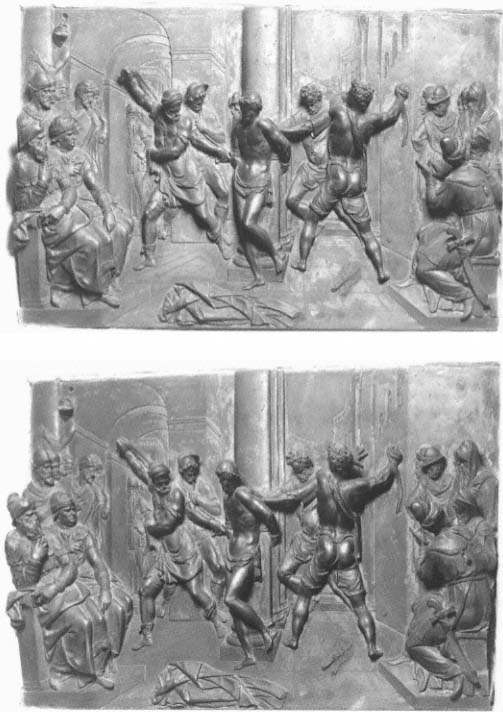
Figure 65b (top of page).
Giambologna, The Flagellation , frontal view.
Università, Genoa.
Figure 65c (above).
Giambologna, The Flagellation , from the right.
Università, Genoa.
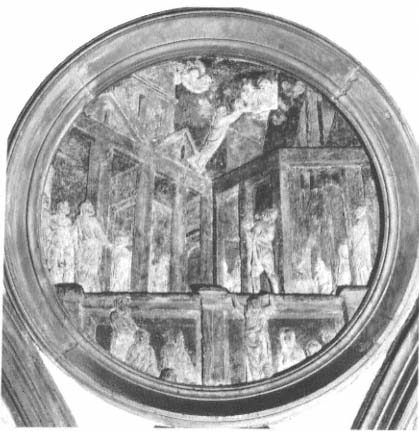
Figure 66.
Donatello, Assumption of Saint John , 1437–43. Stucco, 215 cm diam.
Old Sacristy, San Lorenzo, Florence.
create a strong effect of centrifugal movement around the body of Christ and help integrate the side groups into the action. These groups respond reciprocally to the actions of the flagellators. Whereas the seated spectators in the right corner turn predominantly in, echoing the flagellator whose back is turned to the viewer and balancing the flagellator facing front, those at the left turn out toward the viewer but look in. Giambologna has composed the figure of Christ to incorporate all these directions, so that, here as elsewhere, it unfolds in a slow spiral, turning continuously in space to relate to surrounding figures as well as to the many possible positions of the viewer. The spiral of the body, the three-dimensionality of the figure, and the opposing directions of the head and chest relate the side groups to the center. Because parts of
Christ's body turn in contrapposto, it appears to extend laterally, but this impression is counterbalanced and complemented by the way it has been modeled in gradations of relief to create undulation in depth.
Shifting or multiple viewing points required an approach to perspective different from that of the single vanishing point canonical in the fifteenth and the early sixteenth century. As already explained, Giambologna's solution to this problem was to create a vanishing area in which a number of orthogonals cluster rather than converge on a single point.[33] Undoubtedly, Donatello's reliefs introduced Giambologna to the drastic manipulation of perspective such as that in the Old Sacristy Assumption of Saint John (Fig. 66), where the saint seems squeezed toward his heavenly goal by the sudden convergence of the orthogonals marked by the buildings below. An even more daring manipulation takes place in San Lorenzo with The Three Marys at the Tomb (Fig. 67). Here the vanishing point lies outside the relief, in the spectator's space, at the place where the Risen Christ is imagined to be. Carrying Donatello's innovations further in his creation of a vanishing area, Giambologna induces a sense of continuous movement and introduces temporality into the narrative. It works in the following ways.
In Christ before Pilate (Plate 7) the vanishing area lies around the elbow of the soldier holding Christ; it lies in the crowd on the left in Ecce Homo (Plate 10, Figs. 57a–b). Consequently, the viewer's eye lights first on the most active part of the composition, whence it is directed toward the narrative center. Other reliefs of the cycle have been handled in a similar way. Directing attention to the dramatic climax of the story, the vanishing area in Pilate Washing His Hands (Fig. 55) lies in the group leading Christ away, the result of the decision implicit in Pilate's action. The effect of the convergence of orthogonals around the flexed knee of the flagellator pushing against Christ from behind in The Flagellation (Plate 8, Figs. 65a–c) is to attract attention to the vigorous circular movement set off by the legs of all the flagellators. The effect of vanishing areas, as opposed to fixed vanishing points, is enhanced by their location off center and away from the principal actors in the story. As a result of these stylistic devices the narration becomes virtually dynamic; the viewer's eye moves continuously around the scene.
Giambologna's approach to narrative, as defined here by the Grimaldi reliefs, constitutes a striking departure from that chosen by practitioners of the maniera , and even from his own early Allegory of Prince Francesco de' Medici (Fig. 40). Three examples, one each by Benvenuto Cellini
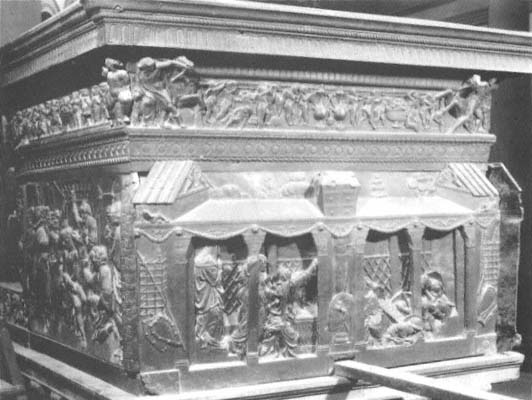
Figure 67.
Donatello, The Three Marys at the Tomb , 1460–70. Bronze, 123 × 292 cm.
South pulpit, San Lorenzo, Florence.
(1500–1571), Pierino da Vinci (d. 1554), and Vincenzo Danti (1530–1576) highlight the distinction.[34]
The relief by Cellini (Fig. 68) beneath his Perseus statue in the Loggia dei Lanzi, Florence, illustrates the myth of Perseus freeing Andromeda.[35] Commissioned by Duke Cosimo in consultation with Cellini, the statue with its relief was intended from the beginning for the Piazza Signoria, a civic monument with dynastic and historical references. The representation of the myth is the paradigm of a maniera relief, in which the artist, through ornamental effects and superb craftsmanship, has turned a romantic tale of rescue into an object of aesthetic significance. Cellini uses the synoptic mode of representation, in which several episodes of the story are combined in the same frame in no apparent order but with an effect that is visually exciting. Relationships between figures, such as Perseus and Andromeda, and spatial intervals are not clear; rational time
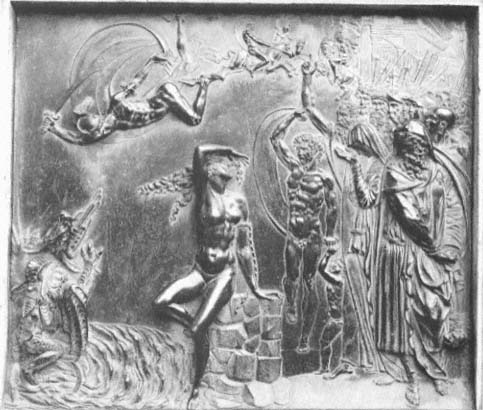
Figure 68.
Benvenuto Cellini, Perseus Freeing Andromeda , c. 1554. Bronze, 82 × 90 cm.
Museo Nazionale, Florence.
sequences have been suspended. Andromeda, awaiting her rescue, turns to view a figure that is not in her field of vision, while Perseus hurtles through a sky devoid of space and air. Andromeda, precariously balanced on a mass of rocks in the center of the scene, has been turned into an object of art whose sleek lines and glistening surfaces arrest and seduce the eye. Her provocative posture and alluring figure obliterate any interest the viewer might have in the incidents of the story; she could just as easily be an inanimate object and create nearly the same effect. Clear storytelling has been sacrificed to linear patterns and finely wrought surfaces designed to tantalize the viewer. The whole intent behind Cellini's relief contrasts sharply with that of Giambologna's Grimaldi reliefs, which place the design in the service of the narrative.
Inspired by a trip to Rome in 1549, Pierino da Vinci produced a marble relief in a consciously antique mode.[36] Entitled Cosimo I as Patron
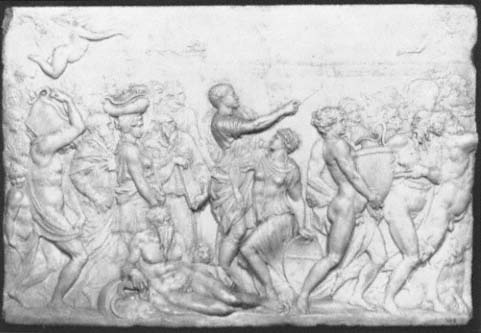
Figure 69.
Pierino da Vinci, Cosimo I as Patron of Pisa , c. 1550, marble.
Museo Vaticano, Rome.
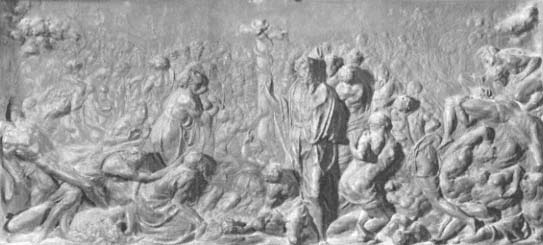
Figure 70.
Vincenzo Danti, Moses and the Brazen Serpent , 1559, bronze.
Museo Nazionale, Florence.
of Pisa (Fig. 69), the relief is an allegorical tribute to Cosimo, clothed in a narrative virtually devoid of setting; the emblematic message is carried by the figures. Pierino displays classically inspired male and female figures as they disport themselves in a procession reminiscent of those on antique sarcophagi. The postures of the figures are designed to show their heroic physiques to best advantage. Particularly conspicuous in this respect are the figures of Pisa supported by Cosimo in the center, the river god at Cosimo's feet, and the nude youth carrying the vase. Although the relief might be considered an appropriate accolade to Cosimo as ruler of Pisa, whatever historical narrative Pierino represented has been transformed by the visual rhetoric.
The religious context of Vincenzo Danti's bronze relief Moses and the Brazen Serpent (Fig. 70), unlike Cellini's and Pierino da Vinci's reliefs, is similar to that of the Grimaldi.[37] Commissioned by Cosimo, Moses and the Brazen Serpent , an analogue for the Crucifixion, was probably intended as the central section of an altar antependium, to be flanked by the Flagellation and the Resurrection and placed in the Chapel of Leo X in the Palazzo Vecchio. As distinct from Giambologna, Danti eschews a clear exposition of the story; instead he creates febrile excitement as light flickers erratically over the surface of the relief, picking out patterns that define neither anatomy nor space. The work is full of intense emotion and confusion as twisting bodies tortuously intertwine, project, and then, just as suddenly, recede into the matrix of the panel. In Danti's relief, drama and emotion result from the artist's extraordinary manipulation of the medium, in contrast to the Grimaldi reliefs, where the narrative itself elicits the emotion. Danti, an exact contemporary of Giambologna's, still operates in the maniera style of the mid-sixteenth century.
As we have seen, the maniera method gave Giambologna no solutions to his narrative task. The rich sources of inspiration for compositional structure that he found in Florence and Rome were supplemented by the brilliant religious narrative solutions he found in northern prints.[38] Since the early sixteenth century, numerous prints by northern artists had circulated freely throughout Europe. Among these were Passion cycles by Martin Schongauer, Dürer, and Lucas van Leyden. In addition to providing examples of monochromatic compositions with plastic and spatial effects much like those of relief sculpture, such print cycles approximate the fictional discourse of literature in their comprehensive relation of the story. Unlike many painted or sculpted cycles, they are
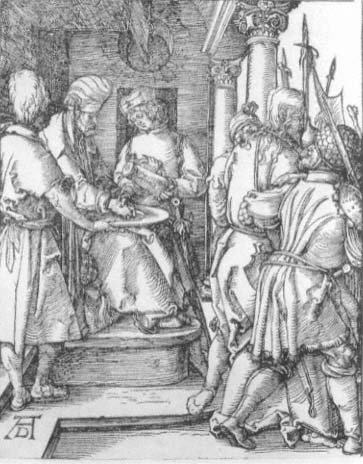
Figure 71.
Albrecht Dürer, Pilate Washing His Hands , Small Passion, 1509–11,
woodcut, B. 36.
not episodic but temporally continuous, like the Grimaldi cycle. Dürer's two versions of Pilate Washing His Hands (Figs. 71, 72), one from the Small Passion of 1509–11 and the other from the Engraved Passion, illustrate what ideas Giambologna chose to adapt from him. The latter combines Pilate's hand-washing ritual with its immediate consequence, the leading away of Christ, both shown in close-up. Two factors link the two groups: their proximity and the placement of Christ's group on a diagonal that leads the eye to Pilate. Giambologna has gone beyond either of Dürer's versions in his development of psychological interaction. To achieve this he has taken Dürer's striding group and moved it to the right and into deeper space, thus creating two foci, which are
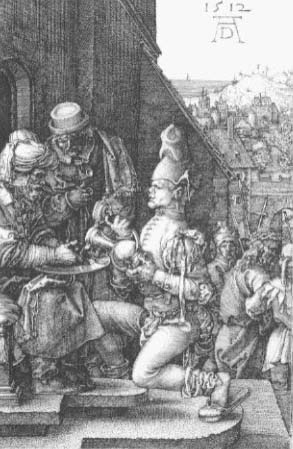
Figure 72.
Albrecht Dürer, Pilate Washing His Hands, Engraved Passion,
engraving, B. 11.
combined with a strategic use of space. A print such as Lucas van Leyden's Christ before Annas (Fig. 73), from the Round Passion of 1509, could have suggested to Giambologna the deep corridors of space he used so effectively in, for example, Christ before Pilate (Plate 7).
When Giambologna went to Genoa in July 1579 to confer with Luca Grimaldi about the chapel commission and to sign the contract, he was surely shown the magnificent Corpus Domini casket (Fig. 39), a treasure of the Cathedral of San Lorenzo, several of whose scenes in silver relief were designed by Luca Cambiaso.[39] Cambiaso was linked to Giambologna's patron as witness to the chapel contract and as creator of the Last Supper commissioned by Luca Grimaldi's father for San Francesco
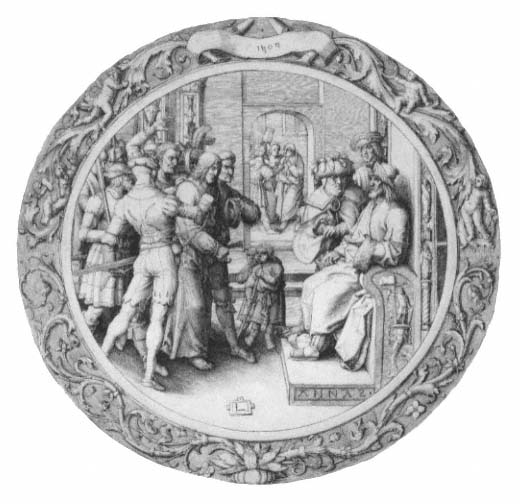
Figure 73.
Lucas van Leyden, Christ before Annas , 1509, engraving, B. 59.
di Castelletto.[40] What would have been more logical than for Grimaldi to have consulted Cambiaso, Genoa's "first" artist, when making plans for his chapel in the same church? Despite Cambiaso's responsibility for several of the Corpus Domini casket designs, the final execution by Flemish artists working in Genoa bears no relation to the style of either Cambiaso or Giambologna. Nevertheless the compositions of several of these Passion scenes, especially The Flagellation (Fig. 74), Christ before Pilate (Fig. 39), and Ecce Homo , are notably similar to those of the Grimaldi Chapel. Circumstances and certain similarities, then, argue for
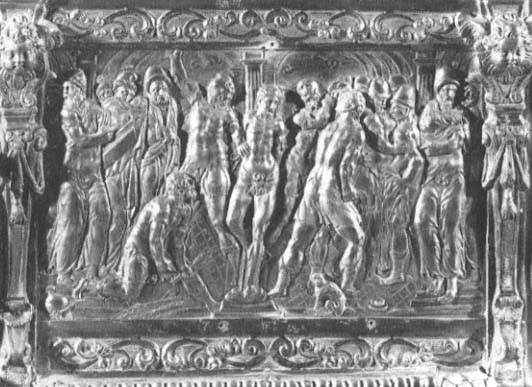
Figure 74.
Corpus Domini silver casket, 1565–68, detail, The Flagellation .
Treasury, San Lorenzo, Genoa.
Luca Cambiaso as a major influence in the designs for the Grimaldi Chapel reliefs.
Cambiaso's concern with the Passion of Christ in many of his surviving drawings and paintings, particularly of the 1570s, suggests that he and his patrons were responding to the ideas of the Catholic Reformation promoted at Trent.[41] Grimaldi, in planning his chapel program, would have found in Cambiaso a like-minded and expert consultant. Cambiaso's involvement in the subject of the Passion led him to leave Italy for Spain in 1583 to work for Philip II at the Escorial. Unfortunately, none of Cambiaso's extant drawings depicting Passion scenes can be matched to the document recording his responsibility for several of the Corpus Domini casket designs. However, Uffizi no. 13744 (Fig. 75), one of his drawings depicting the Flagellation, is a good candidate, with its similarities to the córresponding relief both on the Corpus Domini
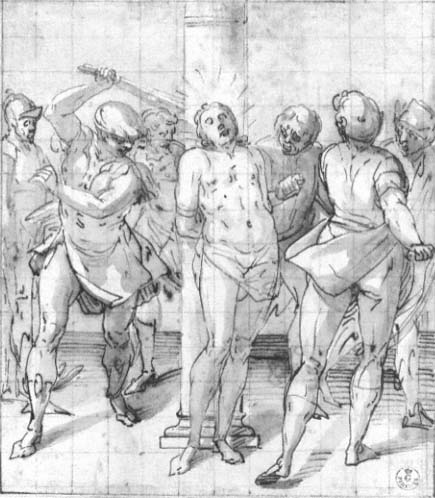
Figure 75.
Luca Cambiaso, The Flagellation , drawing no. 13744, Gabinetto Disegni e Stampi degli
Uffizi, Florence.
casket and in the Grimaldi cycle. The positioning and the posture of the two principal flagellators are essentially the same in all three versions. But the Flemish executor of the Corpus Domini relief has radically changed the proportions of the figures, made the bodies appear lumpy and inorganic, and virtually eliminated the spatial effects of the Cambiaso, so that the marvelous portrayal of action is totally lost. Giambologna, in contrast, has completely understood Cambiaso's design, translating it into relief with his own modifications.[42] Both artists aimed to catch violent physical action in progress: the flagellators are about to
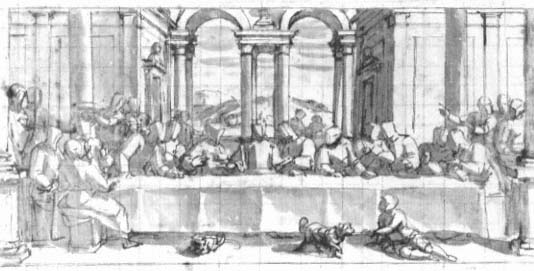
Figure 76.
Luca Cambiaso, Last Supper , c. 1579, drawing no. 1749, Gabinetto Disegni e Stampi degli Uffizi, Florence.
strike another blow. Both artists use Christ and the column as the fulcrum around which the flagellators revolve, but Cambiaso's figures seem freer to plunge in and out of space than those of Giambologna, which move laterally. The heroically proportioned bodies in both works function powerfully; and in both, spatial intervals provide ample room for the action of the figures. In addition, Giambologna must have understood Cambiaso's well-known affinity for scenographic effects, for he used them to poignant end in the spatial flights of his relief backgrounds. Cambiaso's Last Supper of 1579 in the refectory of San Francesco di Castelletto, perhaps reflected in the drawing Uffizi no. 1749 (Fig. 76), undoubtedly displayed such features.
The Entombment (Plate 12), the relief Soprani recorded as being in the Grimaldi Chapel in 1684, calls for special attention. It does not appear in the 1579 contract for the chapel, nor have any documents emerged to prove that it is a work by Giambologna. Nevertheless, there are reasons to believe he was responsible for it; certainly it seems well within his stylistic range.[43] The potentially unsettling observation that The Entombment differs too much from the other six Grimaldi reliefs may be resolved by recognizing, first, that the subject is devotional, not narrative like the six other reliefs, and that it thus requires a different treat-
ment. Its function as the altar antependium accentuates this distinction. Giambologna's ability to add a psychological dimension to the work is comparable here to what he achieved in the other six reliefs, and certain stylistic similarities exist. He retains a variation of the tripartite system, only, as in The Way to Calvary (Fig. 5), the figures are placed close to the viewer, grouped around the dead body of Christ in the center foreground. The gaping void of the sarcophagus next to Christ dramatizes the cruel fact of his death. Its purpose here is comparable to that of the deep spatial corridors that communicate psychological meaning in the other Grimaldi panels. It eloquently separates the dead Christ from Mary Magdalen, the Virgin, and John, those who were closest to him in life. The archway of the tomb on the right and the view of Calvary and Jerusalem in the background complement the grouping of the figures. Several of the figural types in The Entombment resemble those in the other Grimaldi reliefs: the man standing with his back to the viewer at the right edge is similar to the figure at the same edge of Christ Crowned with Thorns (Plate 9); and John and the Virgin in The Entombment are the same types as their counterparts in The Way to Calvary .
For The Entombment Giambologna, appropriately, turned for ideas to the work of Fra Guglielmo della Porta, keeper of the papal seal. Born and trained in northern Italy, della Porta came to Rome as a young man in about 1537 and remained until his death in 1577.[44] He was successful enough to attract the patronage of members of the Farnese family, including Paul III, and to head a large shop located on the Via Giulia. There he engaged in the business of copying antique statues and made both marble and bronze works of his own design. Because his was the major, if not the only, center for bronze sculpture in Rome from 1550 to 1575, one imagines his workshop as a beehive of activity, a meeting place for the many young sculptors who came to learn and work. Giambologna was probably among them from about 1554 to 1556, when he was in the city. What better place to learn what was going on, perhaps to work as an assistant, and to meet with his fellow countrymen, who are recorded as being in the shop.[45]
Unfortunately, little is known of this chapter of Giambologna's activity except what Vasari and Borghini recount about the clay models he made and the amusing anecdote Baldinucci retells about a supposed meeting with Michelangelo, already recounted.[46] Even if Giambologna did not meet della Porta as early as 1554-56, the two artists did ultimately become friends. Letters written in 1574 between della Porta in
Rome and Giovanni Antonio Dosio in Florence mention Giambologna, who no doubt saw della Porta in 1572 when he was in Rome with Vasari and Ammanati.[47] At any rate, by the time he designed the Grimaldi reliefs, Giambologna knew della Porta and his work. These historical circumstances, along with stylistic considerations, allow della Porta's influence to emerge as a major factor in The Entombment relief.
Guglielmo della Porta had been an accomplished relief sculptor since his youth, when, before coming to Rome, he worked in Genoa with Perino del Vaga for Andrea Doria; in the cathedral with his uncle, Gian Giacomo della Porta (c. 1485–1555); and with Niccolò da Corte (c. 1500–1550). During Giambologna's Roman sojourn in the 1550s della Porta was designing the equestrian monument of Charles V,[48] never realized, which was to include bronze reliefs illustrating the Passion of Christ. According to a description written about 1559–60,
L'historie, che vi vanno, sono i 14 misterij della passion di Cristo, i modelli de quali sono gia a buon termine, essendo gia quattr'anni che furno cominciati, et queste istorie saranno di metallo di mezzo rilievo, di nove palmi d'altezza et cinque di larghezza.[49]
(The stories that go there are the fourteen mysteries of the Passion of Christ, the models for which are already as good as finished, four years having passed since they were started. These stories are of metal in half relief, 9 palms high and 5 wide.)
The fourteen reliefs mentioned were The Entrance into Jerusalem, The Last Supper, The Washing of the Feet, The Agony in the Garden, The Capture of Christ, before Pilate, The Flagellation, The Crowning with Thorns, Ecce Homo, Pilate Washing His Hands, The Way to Calvary, The Crucifixion, The Deposition, and The Resurrection . Unfortunately, most of the modelli have disappeared, and the numerous drawings of Passion scenes in della Porta's two sketchbooks in Düsseldorf do not include all fourteen scenes. The Deposition, however, appears many times as a subject, and several single reliefs based on designs in the sketchbooks have surfaced since della Porta's death.[50] Apparently, he also worked on designs of Passion scenes that Pius IV intended for a door of St. Peter's. Thus the subject of the Passion occupied much of della Porta's time during the last twenty years of his life. His correspondence indicates that even after the Charles V project aborted, he never gave up trying to sell versions
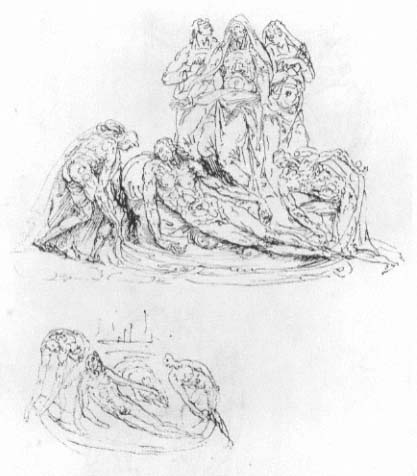
Figure 77.
Guglielmo della Porta, study for a Deposition, c. 1555–59, no. 152,
Kunstmuseum, Düsseldorf, Graphische Sammlung.
of his Passion cycle to such patrons as Cardinal Farnese, Grand Duke Cosimo I de' Medici, and Pope Gregory XIII. Della Porta's preoccupation, even obsession, with the theme of Christ's Passion was so powerful that he intended to carry all his sketches and modelli of the subject to Porlezza, his home, where he wished to spend his last years. Death intervened, and they remained in Rome. One can only speculate whether his obsession had to do with his own spiritual concerns or with the reform interests of the Catholic church. Mostly likely the two were interconnected.
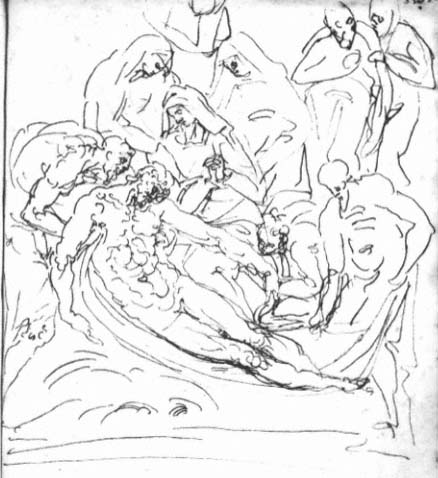
Figure 78.
Guglielmo della Porta, study for a Deposition, c. 1555–59, no. 96,
Kunstmuseum, Düsseldorf, Graphische Sammlung.
Undoubtedly, Giambologna knew della Porta's designs for Passion scenes, and it seems likely that he drew either on his memory of them or even on an example when he composed his own Entombment (Plate 12) for the Grimaldi Chapel. Two drawings from the Düsseldorf sketchbook (nos. 152, 96; Figs. 77, 78), and a marble relief of the della Porta Deposition (Fig. 79) bear similarities to Giambologna's design. One of these similarities is the handling of the central group where Christ's body on the winding sheet is displayed by Nicodemus and Joseph of Arimathea. Both artists placed this central group of three close to the
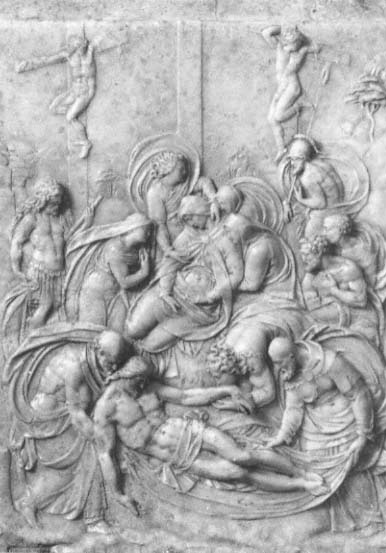
Figure 79.
Guglielmo della Porta, Deposition , marble relief. Museo d'Arte Antica, Milan.
picture plane and turned Christ's body so as to indicate its sacrificial role. This image on the front of the altar embodied for the worshiper the meaning of the mass being celebrated. Both artists used a sweeping curve, locking together the bodies of Nicodemus, Christ, and Joseph of Arimathea as the motif around which their designs are organized. In della Porta's drawings the swirling draperies and open curve of Christ's
body create a rhythmic excitement not present in Giambologna's. Although the draperies on Giambologna's figures hang more believably than those on della Porta's figures, the underlying similarity of the groupings prevails. The powerful physicality of the figures, especially the central three, is notable in both works. Giambologna, however, emphasized the dead weight of Christ's body, particularly his head, his left arm, and his right leg. In contrast, della Porta, even in drawing no. 152 (Fig. 77), where Christ's head falls back, suppressed the naturalistic requirements of the posture in favor of the rhythmic and ornamental. In Giambologna's panel, Nicodemus and Joseph of Arimathea strain harder to handle the heavy body of the dead Savior than their counterparts in della Porta's drawing, who are caught up in the swinging rhythm of the design.
Other differing elements, such as the clarification of space and the simplification of the composition in Giambologna's relief, are easily attributable to generational differences and to the works' different dates. The mood of quiet mourning in the Giambologna relief contrasts with the frenzied quality of the della Porta, with its dense, crowded design filled with billowing draperies and surface patterning. The della Porta belongs to an earlier moment in the history of style when the ideas of simplification and restraint were unacceptable.
Giambologna's redirection in sculpture is similar in principle to changes taking place in painting in the work of Santi di Tito (1536–1603), a competent, if not brilliant, artist seven years younger than Giambologna.[51] Santi's earliest statements in the reform style, Christ at Emmaus (1574) and The Resurrection of Lazarus (Fig. 80), predate the Grimaldi designs by only a few years. In these works Santi's departure from the dominant maniera painting of Rome and Florence constitutes a pioneering effort. The clarity of composition and rationalized light effects of The Resurrection of Lazarus give the spectator a straightforward reading of the event. This work stands in pronounced contrast to a painting like Vasari's Way to Calvary (Fig. 81) in Santa Croce, where exaggerations of posture and flickering light create a complex ornamental effect. Vasari's painting also contrasts strikingly with Giambologna's relief of the same subject (Fig. 5). Whereas Vasari has several centers of interest, Giambologna, like Santi, focuses on the one important confrontation, between Christ and Veronica. Giambologna exploits the emotional power inherent in the meeting between Christ and Veronica; Vasari dilutes it to the point of negation.
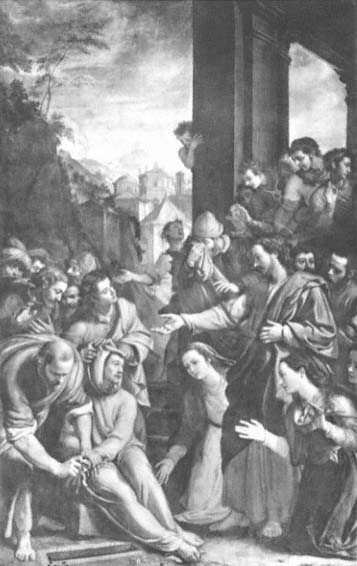
Figure 80.
Santi di Tito, The Resurrection of Lazarus , 1576.
Santa Maria Novella, Florence.
Since Santi di Tito's reform works date from the 1570s, Giambologna's reliefs seem to be among the early works to manifest this change. Other examples in relief sculpture, such as the papal tombs of Sixtus V (1585–90) and Paul V (1605–21) in Santa Maria Maggiore that represent a revival of Lombard narrative style, are later.[52] Their flat-footed narrative tradition, moreover, contains few hints of developments to come
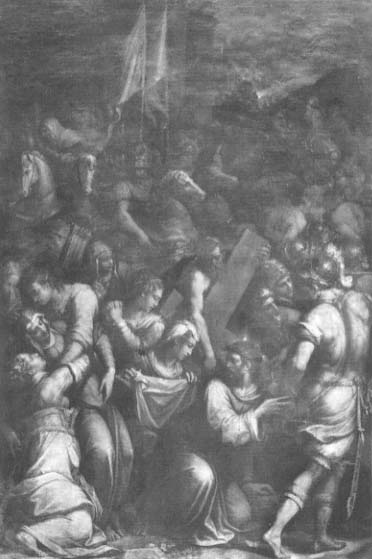
Figure 81.
Giorgio Vasari, The Way to Calvary , 1568.
Santa Croce, Florence.
in the seventeenth century; Giambologna, in contrast, heralded developments that would evolve in the new century. In his Grimaldi cycle, he made a bold statement about the changing relationship between the spectator and the work of art. His strategy addressed one of the main concerns of the Catholic Reformation, that the faithful participate physically and emotionally in the act of worship.
Epilogue
In considering Giambologna from a new perspective, I have focused on his part in creating historical narrative, concentrating on the program of the Grimaldi Chapel, especially the Passion cycle, and presenting a fresh view of his work in the context of the post-Tridentine church. This context included a renewed devotion to the cult of relics, to the sacraments of penance and the Eucharist, and to the doctrine of justification. To involve the devout more deeply in the act of worship, church spokesmen required that images, in addition to conforming to church doctrine, be easily identifiable and narratives readily understandable. I have proposed the part that Luca Grimaldi, motivated by his religious and sociopolitical aspirations, played in conceiving this program and have explicated Giambologna's strategy in carrying it out.
Other issues I have only touched on or suggested: Did Genoa have a strong devotion to the Passion? Were sermons delivered and confraternity activities held there that would yield such information, particularly about practices at San Francesco di Castelletto?
In some sense, the Grimaldi Chapel was a Florentine chapel transplanted into a Genoese setting, thus combining elements from both contexts. The dynamics of this interaction might come to light in a juxtaposition of the Grimaldi with Giambologna's Salviati Chapel.[1] Following the Grimaldi Chapel, there was a spate of family chapels in Genoa that would bear study for what they might reveal about this post-Tridentine type and about the interaction of artists from different parts
of Italy working in Genoa. Some came from cultural centers like Florence and Milan, others from lesser-known areas like Lucca and Pisa. This brings to mind the dual concept of the "center" and "periphery" discussed by Enrico Castelnuovo and Carlo Ginzburg in an article of 1979.[2] They challenge the traditional idea of scholars like Kenneth Clark that creativity originated in cultural centers and radiated out to the provinces, an idea that presumes a unified style that was then taken up and modified by local artists. Castelnuovo and Ginzburg see the situation as far more complex. For example, to understand Genoese art in the sixteenth century, one must look at it in the context of political, economic, religious, historical, and cultural circumstances. Genoa was neither a provincial outpost nor a center like Florence or Rome. Artists were attracted to Genoa in numbers, however, presumably by commissions. There were always Lombard artists working there—the della Porta, for example—and in the sixteenth century, as mentioned earlier, some artists from central Italy: Perino del Vaga, Giulio Romano, Giovanni Montorsoli, Galeazzo Alessi, and Giambologna himself. How the Genoese government and Luca Grimaldi persuaded Grand Duke Francesco de' Medici to lend them Giambologna remains a frustrating puzzle, whose solution, however, must lie in the political and economic ties between Genoa and Florence. Imagine how impressed the Genoese must have been when the reigning sculptor in Europe was allowed to come to their city to work for a member of their nobility. Even Andrea Doria had not lured as famous an artist to work for him.
As for what happened to bronze relief after Giambologna, we can mention several later artists. Giambologna's scenographic brand of bronze pictorial relief was carried to foreign lands by Adriaen de Vries (c. 1560–1626), who studied with Giambologna and was his assistant from about 1574 to 1588.[3] De Vries's large Martyrdom of Saint Vincent (1614) in the cathedral of Warsaw is an elaborated version of the relief style Giambologna created for the Grimaldi Chapel. De Vries's energized spiral figures, the extensive background in which they interact, and the possibility for multiple views all show his debt to Giambologna. Closer to home, Ferdinando Tacca (1619–1656), son of Pietro, the heir to Giambologna's studio, produced an impressive antependium, Saint Stephen Suffering His Martyrdom, in 1656 for the high altar of Santo Stefano, Florence, developing Giambologna's type of relief into an extensive river landscape teeming with figures from the immediate foreground to the distant background. Giambologna's legacy surfaces again
in the work of the gifted Tuscan Massimiliano Soldani Benzi (1656–1740), who was sent to Rome in 1678 by Cosimo III to study at the Grand Ducal Academy, where he remained for four years.[4] The modest-size reliefs he did for the chapel in the Sansedoni Palace in Siena (c. 1692–1700) recall strongly Giambologna's way of relating figures and background. But Soldani's reliefs are clearly late baroque in their overt emotional display: swirling draperies, straining figures, flamboyant gestures, and a dramatic play of light and dark.
Several distinguishing elements of the Grimaldi reliefs are worth noting again since they seem to link Giambologna to seventeenth-century interests. First, his pictorial technique blurred distinctions between sculpture and painting. Furthermore, his clear exposition of the story produced a continuously unfolding narrative, in relation to which the spectator assumed a more active role. Multiple views and a multipoint perspective gave the spectator the opportunity to read the story from several vantages, each with a different shade of meaning. Mutability of meaning signifies the passage of time and the awareness of its transitory character, a major concern of the seventeenth century. Bernini's capture of the momentary and his incorporation of narrative into freestanding sculpture are legendary. His David, for example, not only embodies an instant but also implies the moment before and the moment after the release of the slingshot—an unfolding narrative in which the spectator plays a necessary part. If time has become an ingredient in the Grimaldi reliefs, its concomitant—space—has also been conceived as continuous, as indeed it is in Bernini's works. In each of the Grimaldi panels the implication of infinite spatial extension is clear, as Pilate Washing His Hands (Plate 11, Figs. 56a–c) demonstrates.
The change in Giambologna's art in the 1580s needs to be charted in his other works, among them the Salviati Chapel, the Soccorso Chapel, the Acts of Francesco I, the Jerusalem panels, the Equestrian Monument of Cosimo I, the Saint Luke, and Hercules and the Centaur . It is hoped that this study is a first step in reassessing the meaning of Giambologna's sculpture.
Appendix 1—
Grimaldi Chapel Documents
Many of the translations that follow the original documents in the appendixes are intentionally literal and archaic in order to retain the flavor of the original. For the abbreviations used in the source notes for the documents, see the list at the beginning of the notes.
A—
Contract
ASG, Notaio Giacomo Ligalupo, 1579 2°, filza 14 (24 July 1579).
Promissio
In nomine Domini amen. Dominus Ioannes Bologna, scultor Ser.mi magni Ducis Etrurie, sponte etc. et omni modo etc. promissit et promittit magnifico domino Luce de Grimaldis, filio quondam Francisci, presenti et acceptanti etc., facere construere et fabricare in civitate Florentie infrascripta laboreria pro dicto magnifico domino Luca et eius nomine, videlicet: sex statuas eneas scilicet Fidei, Spei, Caritatis, Iusticie, Fortitudinis et Prudentie, que statue esse debeant altitudinis palmorum septem pro qualibet statua et habeant in qualibet parte suam debitam proportionem, pro pretio scutorum tricentorum quinquaginta de libris quatuor monete Genue singulo scuto pro qualibet statua, et in summa pro pretio scutorum duorum millium centum de libris quatuor singulo scuto.
Item sex tabulas aeneas, super quibus sit impressa Passio Domini nostri Iesu Christi, figuris quas appellant di basso rilievo, repartita hoc modo, videlicet: in una quando ductus fuit ad Pilatum, in alia quando fuit flagellatus ad collumnam, in alia quando imposuerunt ei coronam spineam, in alia quando pre-
sentaverunt eum populo dicendo Ecce Homo, in alio quando Pilatus lavit manus coram populo, et in alio quando Dominus noster portabat crucem. Que sex tabule sint et esse debeant altitudinis palmorum duorum cum dimidio, et latitudinis palmorum trium, et ipsas sex tabulas pro pretio scutorum centum octoaginta singula tabula, et in summa scutorum mille octoaginta de libris quatuor singulo scuto.
Item sex statuas aeneas angelorum nudorum cum eorum alis, pro illis apponendis super frontispicia trium tabullarum picture, que esse debeant altitudinis palmorum quatuor in circa, pro pretio scutorum centum sexaginta similium singula statua angeli et in summa scutorum noningentorum sexaginta.
Item tres epitaphios aeneos cum eorum ornamentis prout melius dicto domino Ioanni videbitur, pro illis apponendis sub icona et sub duobus quadris picture ab utroque latere altaris, pro pretio scutorum viginti singulo et in summa scutorum sexaginta similium.
Et ipsa omnia laboreria statuarum, tabularum, angelorum et aliorum predictorum facere de illa pulchriori qualitate aeris coloris aurei et illiusmet qualitatis cuius est statua aenea raptus mulieris Sabine, quam dictus dominus Iohannes transmissit Ser.mo Duci Parme et Placentie, et omnia quidem expolite et diligenter quam fieri possunt et in ipsis adhibere omnem eius scientiam, artem, curam, studium et diligentiam, et ea facere, finire et perficere intra annos quinque proxime venturos, salvo tamen iusto et legitimo impedimento quatenus a prefato Ser.mo magno Duce Etrurie sibi non mandaretur in contrarium.
Et que omnia pretia omnium predictorum laboreriorum, que in totum ascendunt ad summam sevtorum quatuor millium ducentorum de libris quatuor monete Genue singulo scuto, dictus magnificus dominus Lucas solvere promissit et promittit dicto Ioanni in hunc modum, videlicet: scutos sexcentum similes semper et quando dictus dominus Ioannes appulerit in civitatem Florentie ad omnem eiusdem domini Ioannis voluntatem et simplicem requisitionem, ad hoc ut ex eis possit dictus dominus Ioannes emere aes et alia neccessaria pro faciendo dicto opere. Residuum vero dicti pretii dictus magnificus dominus Lucas solvere promittit in dies, ad ratam laboreriorum per eum faciendorum indicio magnifici Bartolomei de Furnariis nunc existentis Florentie, vel alterius nominandi per dictum magnificum dominum Lucam, omni exceptione etc. Declarato tamen quod ante exbursationem alicuius partis dictorum pretiorum seu in actu ipsius exbursationis, teneatur dictus Ioannes prestare fideiussionem seu fideiussiones in satisfactione ipsius magnifici domini Luce vel dicti magnifici domini Bartolomei seu alterius nominandi seu eligendi a dicto magnifico domino Luca, pro summa seu summis que eidem Ioanni solventur ad computum dicti pretii, qui fideiussores sese obligent pro observatione presentis contractus quantum pro summa pro qua sibi solvetur, quia ita etc.
Acto pacto etc. quod postquam erunt finite dicte statue, tabule et alia predicta et quodlibet predictorum, dictus dominus Ioannes teneatur ea consignare
Florentie cui mandabit dictus dominus Lucas. Ceterum omnes expense que fieri continget tam in apponendis dictis laboreriis in capsiis quam in illis expediendis et transmittendis sint oneri dicti magnifici domini Luce, ita ut dictus dominus Ioannes ad aliud non teneatur preter ad consignationem ipsarum in dicta civitate Florentie ad ordinem ut supra: intellecto semper quod omnia dicta laboreria consignentur bene finita, perfecta et expolita, omni adhibita diligentia ut supra, quia ita etc. Que omnia etc. promiserunt etc. iuraverunt etc. habere rata etc. sub pena dupli etc. et cum restitutione etc. Rat[hisficavit] etc. Proinde etc. Renuntiantes etc. De quibus omnibus etc. per me Iacobum Ligalupum notarium.
Actum Genue, in una ex cameris sale domus habitationis diti magnifici domini Luce, site in contrata Peliparie, anno a Nativitate Domini millesimo quingentesimo septuagesimo nono, indictione sexta secundum Genue morem, die Veneris XXIIII iulii in vesperis, presentibus domino Luca Cambiasio pictore et Baldassare Morovilla quondam domini Martini, cive Leodiense et Lucense, testibus ad premissa vocatis specialiter et rogatis.
Promissory
In the name of the Lord, Amen. Lord Giovanni Bologna, sculptor of the Most Serene Grand Duke of Tuscany, voluntarily, etc., and in every way, etc., promised and does promise to create, construct, and fashion, in the city of Florence, the works named below for and in the name of the magnificent Lord Luca Grimaldi, son of the late Francesco, patron and recipient, etc., namely, six bronze statues, to wit, of Faith, Hope, Charity, Justice, Fortitude, and Prudence, which must be of the height of 7 palms each and must have in each of their parts the necessary proportions, for the price of 350 scudi at 4 lire of Genoese coin per scudo for each statue, in sum, for the price of 2,100 scudi at 4 lire per scudo.
Likewise, [he promises to make] six bronze panels on which the Passion of Our Lord Jesus Christ is sculpted in figures they call bas-relief, and divided into the following scenes, to wit: one when he was led before Pilate, another when he was scourged at the column, another when they placed the thorny crown on him, another when they presented him to the people saying "Ecce Homo," another when Pilate washed his hands before the people, and another when Our Lord was carrying the cross. These six panels should and must be 2 1/2 palms high and 3 palms wide. And these same panels [are to be done] for a price of 180 scudi per panel, in sum 1,080 scudi at 4 lire per scudo.
Likewise [he promises to make] six bronze statues of nude, winged angels [which] are to be added above the frontispieces of the three panels of the painting and must be around 4 palms high, for the price of 160 similar scudi for each statue of an angel, in sum, 960 scudi.
Likewise [he promises to make] three bronze epitaphs with their ornaments as will seem best to the aforementioned Lord Giovanni, to be added under the icon and at the two corners of the painting at each side of the altar, for a price of 20 scudi each, in sum, 60 similar scudi.
Likewise [he promises] to create all these works, of statues, panels, angels, and other things mentioned, out of that more beautiful quality of gilded bronze, and of the same quality as the bronze statue of the rape of the Sabine woman that the aforementioned Lord Giovanni sent to the Most Serene Duke of Parma and Piacenza, and, to be sure, all as diligently and smoothly polished as possible, and to apply to them all of his knowledge, skill, care, zeal, and diligence, and to finish and complete them within the next five years, provided that in the interval nothing is entrusted to him to the contrary by the aforementioned Most Serene Grand Duke of Tuscany [that constitutes] a proper and legitimate hindrance.
And all these prices for all the aforementioned works, which in all amount to the sum of 4,200 scudi at 4 lire of Genoese coin per scudo, the aforementioned magnificent Lord Luca promised and does promise to pay to the aforesaid Giovanni in the following way, namely 600 similar scudi each time Giovanni arrives in the city of Florence, in accordance with every wish and simple request of the same Lord Giovanni for the purpose of buying these and other necessary things for the making of the aforementioned work[s] from these payments.
But the remainder of the aforementioned price the aforementioned magnificent Lord Luca promises to pay daily, according to the rate of the work that is to be done by him in accordance with the judgment of the magnificent Bartolomeo Fornari, now living in Florence, or of another person to be named by the aforementioned magnificent Lord Luca, with every limitation, etc. This having been declared, nevertheless [there is the further requirement] that before the disbursement of any part of the aforementioned price, or in the actual disbursement of it, let the aforementioned Giovanni be obliged to present surety or sureties to the satisfaction of the aforementioned Lord Luca or to the aforementioned magnificent Lord Bartolomeo or to another person named or chosen by the aforementioned magnificent Lord Luca, for the sum or sums that are being paid to the same Giovanni, to the total of the aforementioned price that the sureties oblige themselves to do, in observance of this present contract, inasmuch as thus, etc.
The contract having been performed, etc., [there is the further requirement] that after the aforementioned statues, panels, the other things and whatever of the aforementioned have been finished, the aforementioned Giovanni is obliged to have them delivered to Florence to whomever the aforementioned Lord Luca will commission. But all expenses that will happen to accrue both in the placement of the aforementioned works in repositories and in arranging
and dispatching them, let these be the burden of the aforementioned magnificent Lord Luca, so that Lord Giovanni is not obligated to anything beyond the delivery of them to the aforementioned city of Florence as required above. Let it be understood continually that all the aforementioned works will be delivered well finished and polished with all diligence as [required] above, because thus, etc., all these things, etc., they promised, etc., they swore, etc. to have fulfilled, etc., under double penalty, etc., and with restitution, etc. Henceforth, etc., giving notice, etc., concerning all these things, etc., by me, Iacopo Ligalupo, Notary.
Negotiated at Genoa, in one of the chamber rooms of the living establishment of the aforementioned magnificent Lord Luca, situated on Pellicceria Street, in the year 1579, from the birth of Our Lord, in the sixth indiction according to the Genoese fashion, on Friday, 24 July, in the evening, in the presence of witnesses especially summoned and convoked as witnesses to the premised [information], Luca Cambiaso, painter, and Balthasar Morvill, the son of the late Lord Martino, citizen of Leiden and Lucca.
B—
Letters Between Francesco De' Medici and the Genoese Government
ASF, Mediceo, 2836 (Lettere della Repubblica di Genova, 1541–1621), no pagination.
Serenissimo Signor
Si bisognerìa in questa città dell'industria et della presenza di Giovan Bologna scultore et architetto di Vostra Altezza, per qualche pochi giorni, et perché sappiamo per isperienza quanto la sia inclinata a favorirci, non habbiam voluto mancare di significarglielo. Et però la preghiamo a farci gratia di dar licenza al detto Giovanni che puossi venire qua et stàrci per quindeci giorni, che noi sentendone molto obligo all'Altezza Vostra l'aggiungeremo agl'altri che le habbiamo, et le basciamo le mani.
Di Genova a'VIII di Maggio del MDLXXVIIII.
A' serviggi di Vostra Altezza
Il Duce e Governatori della republica di Genova
vidit Antonio Iofredus Spinola
Al Ser.mo Sig.or il Sig.or
Gran Duca di Toscana
Most Serene Lord
We have need in this city of the ingenuity and presence of Giovanni Bologna, sculptor and architect of Your Highness, for a few days, and because we know from experience how much you are inclined to favor us, we have not hesitated to make this known to you. Therefore we beg you to do us the favor of giving permission to said Giovanni Bologna to come here and stay a fortnight, for which we feel very obliged to Your Highness and which we add to all of the other favors, and we kiss your hands.
From Genoa, 8 May 1579
At the service of Your Highness
The Duke and Governors of the Republic of Genoa
Witnessed by Antonio Giofreddi Spinola
To the Most Serene Lord
Grand Duke of Tuscany
ASF, Mediceo, 250 (Registro di lettere del Granduca, 1578–79), fol. 142r.
Alla Signorìa di Genova
de' 26 detto [May 1579]
Ill.mi et Ecc.mi Sig.ri
Giovambologna mio scultore et architetto ha fra mano alcune cose mie, le quali però doverà haver finite fra pochi giorni, et allhora per compiacerne l'eccellenze vostre con il mio desiderio di gratificarle et far loro servitio dovunque io possa, gli concederò il venir da loro et il servirle per quindici giorni, che poi è necessario che torni, stando l'opera sua del continuo impiegata in miei lavori et occorrentie. E con questo m'offero et raccomando ben di cuore all' Eccellenze Vostre e desidero loro ogni prosperità.
Da Fiorenza alli 26 di Maggio 1579.
Per servir Vostre Ecc.mo El Gran Duca di Tna
To the Signoria of Genoa
26 of said (May 1579)
Illustrious and Most Excellent Lords
Giovanni Bologna, my sculptor and architect, has in hand some things of mine, which, however, he should have finished in a few days, and then to please Your Excellencies with my desire to win your favor and serve you in any way I can, I will permit him to come to you to serve you for a fortnight, after which it is necessary that he return, given that he continually has work of mine to occupy him. And with this I offer with all my heart and convey to Your Excellencies every good wish and success.
From Florence, 26 May 1579
To serve Your Highest Excellency the Grand Duke of Tuscany
ASF, Mediceo, 253 (Registro di lettere del Granduca, 1579–80), fol. 10r-v.
Alla Signorìa di Genova,
detto di[*] [10 June 1579]
Ill.mi et Ecc.mi Sig.ri
Maestro Giovan Bologna se ne viene per servir l'Eccellenze Vostre conforme al loro desiderio per quei XV giorni, et oltr'a quel che farebbe per se stesso, tiene anco comandamento da me di servirle con ogni affetione e diligenza maggiore, e mi prometto che elle habbino a restare sodisfatte dell'opera e della virtù sua. Egli ha seco un Baldassarre Morvill fiammingo, suo compatriotta, che desidererebbe in una sua causa costà giustitia sommaria, et espedita, però lo raccomando strettamente all'Eccellenze Vostre et voglio saper loro grado molto accetto d'ogni favore et giusto aiuto che gli faranno porgere per la sua speditione.
Da Fiorenza el di X di Giugno, 1579.
Per servir Vostre Ecc.me
El Gran Duca di Tna
To the Signoria of Genoa,
said day (10 June 1579)
Most Illustrious and Excellent Lords
Master Giovanni Bologna comes to you to serve Your Excellencies, according
to your request, for a fortnight, and other than that which he will do himself, he has my instructions to serve you devotedly and most diligently and promises me that you will be satisfied with his work and his virtù . He has with him Balthasar Morvill, a Fleming, his countryman, whom he would like to have there so that all will be conducted in complete fairness. Therefore I recommend him absolutely to Your Excellencies, and I will be most grateful for every favor and proper assistance that you can provide for their expedition.
From Florence, 10 June 1579
To serve Your Excellency the Grand Duke of Tuscany
ASF, Mediceo, 2836 (Lettere della Repubblica di Genova, 1541–1621), no pagination.
Serenissimo Signor
Giovanni Bologna scultore, di cui li giorni passati Vostra Altezza ci fece gratia, venne et ha sodisfatti benissimo a quello che si desiderava. Ma sopravenendo il bisogno dell'industria et giudicio suo sopra certe capelle che si fabricano, si è trattenuto un poco più di quello che si credeva, ancorchè l'opera ricercassi per qualche tempo di più la sua presenza per certi adornamenti o figure di bronzo che vi bisognano. Hora egli se ne ritorna, et però ringratiando Vostra Altezza del favore, la preghiamo ad havere per iscusato il sodetto Giovanni del tempo trascorso, et insieme concederli che puossi comandare o dar ordine a quelle figure o adornamenti di bronzo che si han da fare per compimento delle capelle. Et con questo fine si raccomandiamo all'Altezza Vostra et le preghiamo felicità.
Di Genova a' XXVII di luglio del MDLXXVIIII.
A' serviggi di Vostra Altezza
Il Duce e Governatori della republica di Genova
vidit Antonio Octavianus d'Oria
[address]
Al Ser.mo Sig.or il Sig.or Gran Duca di Toscana, Firenze
Most Serene Lord
Giovanni Bologna, sculptor, whom Your Highness permitted us to have during these recent days, came and satisfied very well what was desired. But unexpect-
edly the need arose for his ingenuity and advice about certain chapels that we are building, so he stayed a bit longer than originally planned; even the work originally requested for certain decorations or bronze figures required him to stay longer. Now he returns home, and therefore, thanking Your Highness for the favor, we beg you to excuse the said Giovanni for the extra time, and at the same time to permit him to direct and order those figures and decorations of bronze which he has to do to finish the chapels. And with this conclusion we salute Your Highness and convey our good wishes.
From Genoa, 27 July 1579
At the service of Your Highness
The Duke and Governors of the Republic of Genoa
Witnessed by Antonio Octavio D'Oria
(address)
To the Most Serene Lord the Grand Duke of Tuscany, Florence
C—
Order and Letter Relating to Luca Grimaldi's Mission to Duke Francescoi De' Medici in 1577
ASG, Instructiones et relationes, 2707 D, no. 81 (text written on outside), and no. 80 (copies inside of the credential for the grand duke and the instruction given Luca Grimaldi for the mission to Florence; text of the instruction is given below [with my ellipses]).
[outside ]
"+1577 die 13 Iunii. Expeditio nobilis Luce Grimaldi missi ad Magnum Ducem Hetrurie Gaudii officium functuri ob natalem diem Ser.mi Principis"
[inside ]
Duce Governatori et procuratori dela Republica di Genova
Mag.co nostro gentilhomo. Il gran Duca di Thoscana ha fatto compimento di ralegrarsi con noi per la natività del Principe suo figlolo col mezo di un gentilhomo mandato a questo effetto, et noi habbiamo deliberato di fare con sua Altezza il medesimo . . . [L]a somma della vostra legatione è il ralegrarsi in nome nostro della natività del principe et di mostrarne quella contentezza che si conviene all'amicitia et buona intelligenza che è tra la nostra Republica et il gran Duca. . . . Visitarete ancora la gran Duchessa . . . [S]e vi fosse l'Ill.mo Car.le
Medici o altre persone di conto non mandrarete di far con loro quel compimento di visite che si conviene . . . [D]al nostro Ducal Palazzo a' XIII di Giugno 1577.
(outside )
"13 June 1577. Mission of the nobleman Luca Grimaldi sent to the Grand Duke of Tuscany to congratulate him on the birth of the Most Serene Prince"
(inside )
Duke, Governors, and Procurators of the Republic of Genoa
Our magnificent Gentleman. The Grand Duke of Tuscany has done us the favor of sharing the joyful news of the birth of his son the Prince through the offices of a gentleman sent for this purpose, and we have decided to do the same for His Highness. . . . The purpose of your mission is to convey our heartfelt congratulations on the birth of the Prince and to express to him the satisfaction that comes from the friendship and good understanding that exist between our Republic and the Grand Duke. . . . Pay a call also on the Grand Duchess. . . . If the Most Illustrious Carlo de' Medici or other persons of note are there, do not neglect paying our respects if it is convenient. . . .
From our ducal palace, 13 June 1577
ASG, Litterarum, 1969, 12.
[outside ]
All'Ecc.mo et Ill.mi sig.r li sig.ri Duce, Govern.ri , Procur.ri dell'Ecc.ma Rep.ca di
Genova [miei] oss.mi
[inside ]
Ecc.mo et Ill.mi sig.ri padroni miei osservandissimi
Arrivai qui sabato matino, dove non trovai il Gran Duca ch'er'andato a Pratolino. Ritornò a me 22'hora di notte ché più tosto non intese della venuta mia dal suo maggiordomo al quale subito si era fatto sapere perché gliene avisasse. Et perché l'Ambasc.re di Savoia era gionto venerdi[*] et havea di già fatto domandare udienza, si hebbe risposta di darla la domenica matina a esso, et il dopo desinare a me, come seguì, havendomi mandato il detto maggiordomo a levare di casa et accompagnatomi a Palazzo.
S. Altezza mi fece gratissime accoglienze; gli esposi quanto da V. Ecc.za et Sig.rie Ill.me mi fu ordinato. Li è stato sommamente caro questo segno di allegrezza, havendo mostrato in molti ragionamenti c'ha passato rurco, ogni volontà et dispositione d'animo di buona corrispondenza in tutte le occasioni che si offerissero, come di presenza più a pieno farò rellatione a V.S.rie Ill.me Non possendo pero'[*] tacerle che per esser stato scritto dal S.r Ciro Alidosio che costì non si è tenuto quel conto di lui che desiderava (secondo si è potuto investigare) è stato cagione di farne pattire a me, che non sono stato alogiato in Palazzo, come S. Alt. suole fare et ha fatto all' Ambasc.re di Savoia. Sono in casa di messer Bartolomeo Fornari, che mi ha ricevuto con ogni prontezza d'animo, facendomi insieme gli honori et carezze quanto più potrei dire. Al tardi poi visitai la Ser.ma Gran Duchessa, dalla quale medesimamente sono stato visto molto volentieri et havuto risposte di gran cortesia, si come ha fatto il Sig.r Don Pietro che vengo hora da visitare.
Domani farò domandare udienza per licentiarmi, et poì me ne ritornarò a dar conto a V.S.rie Ill.me , alle quali desiderando ognì felicità et argumento di maggiore stato, bacio con riverenza le mani. Di Firenze li XXIII di[*] Giugno 1577.
D.V. Ecc.za et Sig.rie Ill.me
Servitor obedientissimo
Luca Grimaldo
(outside )
To the Most Excellent and Illustrious Gentlemen the Duke, Governors, and Procurators of the Most Excellent Republic of Genoa
(inside )
Most Excellent and Illustrious Gentlemen, my most worthy masters
I arrived here Saturday morning, where I did not find the Grand Duke, who had gone to Pratolino. He returned to me at eleven o'clock at night, perhaps because he did not know of my arrival, even though I had advised his butler of it as soon as I arrived. And because the Ambassador of Savoy had come Friday and had already asked for an audience, which he [the grand duke] was disposed to give him Sunday morning, after dining [that is at noon on Sunday] the Duke met with me, having sent the butler to pick me up and accompany me to the palace.
His Highness welcomed me most graciously; I conveyed to him everything in accordance with the orders given me by you, most Excellent and Illustrious Gentlemen. To him this sign of our happiness was extremely welcome, as he has shown in many past discussions a willingness and disposition of mind to
have good relations on all occasions that presented themselves. When in your presence I will report more fully to you, Illustrious Gentlemen. However, I cannot remain silent, for Mr. Ciro Alidosio has recorded that nobody there took care of what he had requested (insofar as it could be ascertained), and for this reason I had to endure not being lodged in the palace, as Your Highness wished and was done for the Ambassador of Savoy. I am in the house of Mr. Bartolomeo Fornari, who received me wholeheartedly, giving me altogether every honor and care that one could imagine. In the afternoon I called on the Grand Duchess, who similarly received me most willingly and responded with great courtesy just as she had done to Mr. Don Pietro, who comes now to call.
Tomorrow I will request an audience to say farewell, and then I will return to report to you, most Illustrious Gentlemen, to whom I send every good wish, I respectfully kiss you hands. From Florence, 23 June 1577.
Your most obedient servant
Luca Grimaldi
D—
Last Will and Testament of Luca Grimaldi
ASG, Notaio Zaccaria Vadorno, scansia 524, filza 1.
+1611, die V Iunii. Testamentum Ill.mi domini Lucae Grimaldi quondam domini Francisci.
In nomine Domini amen. Cum nichil sit certius morte nichilque incertius hora illius, quae in animo cuiuslibet prudentis semper debet esse suspecta, hoc igitur considerans Ill.mus dominus Lucas Grimaldus quondam domini Francisci ex Procuratoribus perpetuis huius Serenissimae Reipublicae, sanus Dei gratia mente sensu loquela et intellectu ac in sua bona et sana memoria existens, licet corporea gravetur infirmitate, qua iacens languens in lecto detinetur, cupiens tamen dum apud se est, de se bonisque suis disponere, ideo per presents suum nuncupativum testamentum, quod sine scriptis dicitur, de se bonisque suis statuit disponit et ordinat in omnibus ut infra.
In primis animam suam nunc et in hora mortis devote commendavit et commendat Sanctissime et individue Trinitati, summo Deo Patri omnipotenti, Domino et Salvatori nostro Iesu Christo filio eius unigenito, Sanctoque paraclito Spiritui, beatae et immaculatae Matri semperque Virgini Mariae, Sanctissimo Precursori Ioanni Baptistae, Sanctis Apostolis Petro et Paulo et Divo Francisco, ac omni celesti Curiae, rogando omnes ut pro ipso et anima eius orent et intercedant apud Deum et Dominum.
Cadaver vero suum sepeliri voluit in ecclesia S. Francisci presentis civitatis, in monumento capellae ipsius Ill.mi testatoris Sanctissimo Crucifixo dicatae, et ad tumulum deferri associatum tantummodo presbiteris parrocchiae S. Lucae Genuae et reverendis fratribus dictae ecclesiae S. Francisci, expendique in caeteris pro funere quid et quomodo videbitur magnificae Ceciliae filiae ipsius Ill.mi testatoris, uxori magnifici domini Ioannis Hieronymi di Marinis, marchionis Castrinovi Scriviae. Item dotavit et dotat et legavit et legat dictae capellae sub titulo Sanctissimi Crucifixi, fabricatae per ipsum Ill.mum testatorem in dicta ecclesia S. Francisci et ad ipsum spectantem, loca quadraginta comperarum S. Georgii.
[Other legacies omitted]
Heredem suum universalem instituit et esse voluit oreque proprio nominavit et nominat magnificum Franciscum, eiusdem Ill.mi testatoris et quondam Nicoletae filiae quondam magnifici Baptistae Grimaldae quondam Hieronimi eius coniugis, filium legitimum et naturalem, solum et in solidum, cui tamen prohibet quicquam tangere nec disponere de bonis et hereditate ipsius nisi completa aetate annorum vigintiquinque.
[Other legacies omitted; curators and testamentary executors are appointed: Grimaldi's son-in-law, Girolamo Marini; Corrado Grimaldi; and Agostino Spinola.]
The fifth day of June 1611. The will of the Illustrious Lord Luca Grimaldi, son of Lord Francesco.
In the name of the Lord, amen. Since nothing is more certain than death, and nothing more uncertain than its hour, the thought of death should always be kept in the mind of every prudent person. Therefore, in consideration of this fact, the Illustrious Lord Luca Grimaldi, son of Lord Francesco of the perpetual procurators of this most serene republic, being of sound mind, sense, speech, and intellect (God be thanked), and still having a good and healthy memory—although he is gravely afflicted with bodily infirmity, by which he is kept lying and languishing in his bed—desires nevertheless while he is still himself to make disposition of himself and his goods. Therefore, by this present nominating testament, which is dictated by him and not written, he determines, disposes, and ordains concerning himself and his goods in all respects as given below.
First, he has devoutly commended and does commend, both now and in the hour of his death, his soul to the most holy and undivided Trinity; to God the supreme and omnipotent Father; to Our Lord and Savior Jesus Christ, his only-begotten Son; and to the Holy Ghost the Paraclete; to the blessed and
immaculate Mother Mary, ever Virgin; to the most holy precursor John the Baptist; to the holy apostles Peter and Paul; and to the blessed Francis; and to the entire heavenly court, asking them all to pray and intercede for himself and his soul before God and the lord.
The illustrious testator has desired that his body be buried in the Church of San Francesco of this city, in the monument of his own chapel dedicated to the Most Holy Crucifix. He wishes his body to be carried to the tomb accompanied only by the priests of the parish of Saint Luke of Genoa, and by the reverend friars of the said Church of San Francesco. The illustrious testator wishes that there be expended on other requirements for his funeral whatever seems appropriate to the magnificent Cecilia, his daughter, wife of the magnificent Lord Giovanni Hieronimo di Marinis, marquess of Castronuovo-Scrivia. In particular, he has endowed and does endow, and he has bequeathed and does bequeath to the said Chapel of the Most Holy Crucifix (built by the illustrious testator himself in the said Church of San Francesco, with himself in mind) forty shares of the company of Saint George (Banco di San Giorgio).
This illustrious testator has orally named as his sole heir the magnificent Francesco, legitimate and natural son of himself and the late Nicoleta Baptista Grimaldi, daughter of the late magnificent Hieronimo. He wishes Francesco to be, and has established him as, his heir alone and in entirety. Nevertheless, he prohibits Francesco from touching or disposing of any part of these goods and this inheritance until he reaches the age of twenty-five years.
E—
Poem and Inscription Placed in the Chapel by Luca Grimaldi
From Giulio Pasqua, Memorie e Sepolcri, vol. 49.
Mirus amor Christi pro terris astra reliquit
Ut facilem terris sternat ad astra viam
Nec satis hoc insons dire subcumbere morti,
Et voluit rigide ligna subire Crucis,
Scilicet ut primi sanet contagia ligni
Sumptibus, et nobis mors, sua, vita foret,
Quique mare, et tellus magnus, cui servit Olimpus,
Quem flegetuntei gurgitis unda timet
Mortales artus mortalia funera passus
Mortali ut claustrum celi aperiret iter
Equis erit tam corde feros, tam pectore durus
Irrita qui efundi munera tantu sinat,
Qui non corde pio Christum non pectore toto
Auctorem vite tempus in omne colat
Sacre Crucis, eis spine corone plurimisque
Sanctorum reliquus templo nuper huc
Translatis, Lucas Grimaldus Francisci
Filius, sacrarium hoc P.C.A.S.
[in margin ] Subtus Capellam S.mi Crucifixi
Christ's wondrous love left the stars for earth, so that it might light an easy path from earth to the stars. Nor was this all. The guiltless one wished to succumb to dire death and to endure the wood of the unbending cross so that he might heal the infections of the first wood and so that, these things having been undertaken, his death would be life for us. He whom the earth and the sea and great Olympus serve, he whom the billow on the Phlegethontean flood fears, took upon himself human limbs and a human death so that he might open to mortals the closed path to heaven. Indeed, is there anyone so fierce in spirit or so hard of heart as to allow such great gifts to be expended in vain, or who would not worship Christ, the author of life, with his entire soul and devout heart for all time? Luca Grimaldi, son of Francesco, piously set up and dedicated this shrine for several relics of the saints, and of his holy cross and crown of thorns, recently transferred here to this chapel.
Appendix 2—
Soccorso Chapel Contract and Addendum
ASF, Conventi Soppressi. 119 (S.ma Annunziata di Firenze), 66 (Contratti, 1550–99), no pagination.
[in margin ] Capella della Vergine del Soccorso
In Dei nomine amen. Anno Dominice Incarnationis 1594, inditione octava, die vero quarta mensis Decembris, Clemente octavo summo Pontifice et Ser.mo Domino Ferdinando Medices Etrurie magno Duce dominante. Cum sit prout infrascripte partes asseruerunt, quod Magnificus dominus Ioannes Bononia, alterius quondam Ioannis Bononie, Belgius sculptor famosissimus, Florentie degens, habens in animum aliquod egregium opus facere pro augumento divini cultus et zelo devotionis, modo tamen infrascripto, quod pluries requisierit Rev.mum Patrem Generalem totius ordinis Servorum ac Rev.dos Priorem et fratres conventus dive Annuntiate de Florentia, dicti ordinis, de concedendo sibi Altare seu Aram sub titulo et immagine sacratissime Virginis Marie Succursus, sic denominatam, et retro Altare maius et chorum dicte Ecclesie existentem, et se sponte obtulerit Altare predictum ad honorem Virginis Marie de suis propriis pecuniis decorandi et in alium statum meliorem reducendi et alia in predictis necessaria faciendi prout similis pia actio requirit. Et cum dicti Rev.di Prior et fratues dicti conventus fuerint et sint contenti, accedente tamen consensu dicti Rev.mi Patris Generalis prout infra exprimetur, concessionem dict Altaris in forma valida eidem domino Ioanni Bononie facere, consensu etiam et licentia infrascripti Michaelis Angeli Mathei de Martinis, civis Florentini, heredis quondam Dominici Mar[ci] de Dulcibus, qui modo et forma infrascriptis consentire intendit. Hinc est quod hodie, hac presenti suprascripta die, convocati congregati et insimul capitulariter coadunati dicti et infrascripti
Rev.di Prior et fratres capituli et conventus beate Marie Annunciate, ordinis Servorum, de Florentia, ad sonum campanule capitularis ac alias, servatis servandis ut eorum moris est, et de mandato et ad requisitionem Rev.di Patris Magistri Arcangeli florentini, moderni Prioris dicti conventus, quorum quidem fratrum sic, ut supra, congregatorum nomina in fine presentis instrumenti describentur, omnes fratres professi dicti ordinis et in capitulo dicti conventus vocem habentes, asserentes esse ultra duas tertias partes omnium fratrum professorum et vocem in capitulo dicti conventus habentes, et in eis sic congregatis consistere et residere omnem vim et potestatem cuncta pro dicto conventu utiliter faciendi. Affirmantes de et super premissis et infrascriptis matura colloquia inter se habuisse et pluries pertractasse et tandem resolutionem accepisse dictam et infrascriptam Altaris concessionem dicto domino Ioanni Bononie faciendi, consensu tamen et licentia dicti Michaelis Angeli de Martinis, heredis dicti quondam Dominici de Dulcibus. Eapropter facientes omnia et singula infrascripta in presentia et cum consensu, verbo et licentia dicti Michaelis Angeli Mathei de Martinis, heredis dicti quondam Dominici Marci de Dulcibus ibidem presentis et consentientis et eius, dicto nomine consensum pariter et assensum in predictis prestantis etc. Ac etiam accedente consensu et beneplacito in omnibus et singulis infrascriptis Rev.mi Patris Generalis eorum ordinis infra duos menses proxime futuros expensis omnibus dictorum fratrum impetrantium et obtinentium, quem impetrare promiserunt et dictis nominibus sponte etc., animo deliberato, per se et suos in dicto conventu successores etc., viva voce, nullo eorum penitus discrepante etc., et alias omni meliori modo etc., dederunt et libere concesserunt etc. dicto Magnifico domino Ioanni Bononie, ibidem presenti etc. et pro se et suis heredibus etc. recipienti et acceptanti etc. dictum Altare et Aram beate Marie Virginis Succursus, et situm et locum Altaris et Are predicte, retro Altare maius et chlorum dicte eorum Ecclesie existente, cum facultate et potestate quatenus ei videatur dictum Altare et Cappellaniam intus, foris et circum circa, amovendi et in aliam formam etiam ampliorem versus conventum et monasterium dictorum fratrum eius arbitrio reducendi, cum figuris eneis, marmoreis et sculptis in forma tamen licita, eamdemque Aram et Cappellaniam circum circa, intus et foris ornandi et decorandi nunc et in futurum et quandocunque eidem domino Ioanni Bononie videbitur et placebit, eiusdem domini Ioannis Bononie sumptibus et expensis, et etiam apponendi arma et insignia dicti domini Ioannis Bononie, cum inscriptione nominis et aliis licitis et honestis. Cum pacto, solemni stipulatione vallato, quod casu quo dictus dominus Ioannes Bononia moreretur (quod Deus avertat) inchoato sed nondum perfecto hedificio, tali casu voluit et obligavit eius heredes et successores eorumque bona mobilia et immobilia ad perficiendum quam primum et infra annum hedificium inceptum, arbitrio tamen periti sculptoris, alias voluit et licentiam dedit dictis venerabilibus Priori et fratri, presentibus etc., elapso dicto anno et non perfecto hedificio, habeant
auctoritatem et baliam, absque decreto alicuius iudicis, capiendi tot ex eius bonis mobilibus et immobilibus, pecuniis et semoventibus, quod sufficiant ad perficiendum opus inceptum. Et obligavit eius heredes et successores ad tacendum et nullo modo contradicendum, sub pena privationis eius hereditatis. Promictentes dicti Prior et fratres ut supra congregati, sub hypoteca omnium et singulorum bonorum presentium et futurorum, ipsum dominum Ioannem Bononiam eius heredes et successores, nullo unquam tempore molestare neo aliquo modo inquietare in faciendo, reficiendo, decorando et adaptando dictum Altare et Cappellaniam, nec etiam in refectis, adaptatis et redecoratis, et [non] contrafaciendi modo aliquo vel sub aliquo quesito colore, directe vel indirecte, promiserunt sub obligatione iam dicta, dictum dominum Ioannem Bononiam presentem, eius heredes et successores conservare indemnes et penitus sine danno, et restituere precium et valorem refectionis, adornationis et redecorationis, ad beneplacitum ipsius domini Ioannis Bononie et eius successorum. Et insuper, attenta bona voluntate dicti domini Ioannis Bononie erga dictam eorum Ecclesiam et conventum, libere eidem concesserunt ad eius beneplacitum et voluntatem faciendi, construendi et hedificandi ad pedes Altaris et Cappellanie prefate vel ibi circum circa, dummodo non deturbetur Cappella contra formam Sacri Concilii Tridentini, unum sepulcrum pro se ipso et suis successoribus et ad eorum usum, eo modo et forma prout sibi placuerit etc. Promictentes prefati Rev.di Prior et fratres, ut supra capitulariter congregati, omnia et singula onera sibi et dicto eorum conventui relicta per dictum olim Dominicum Marci de Dulcibus occasione dicte Cappellanie Succursus, exequi et facere prout tenentur omni meliori modo etc. Et hec omnia fecerunt dicte partes cum expressa declaratione quod dictus dominus Ioannes Bononia non intendit aut vult quicquid predictorum aggredi aut aliquod opus inchoare nisi prius amoveantur e dicta cappella arma et insignia dicti olim Dominici de Dulcibus, iuxta licentiam obtentam a Ser.mo Domino Ferdinando Medices, Etrurie magno Duce, de qua in filza supplicationum 54 Magnificorum dominorum Capitaneorum Partis, n.o 192. Et in super volentes dicti R.di Prior et fratres sese gratos reddere dicto Michaeli Angelo de Martinis, sponte etc. per se et suos in dicto conventu successores etc. et alias omni meliori modo etc. dederunt concesserunt etc. dicto Michaeli Angelo Mathei de Martinis, ibidem presenti etc., pro se et suis heredibus etc. recipienti et acceptanti etc., cappellaniam sub titulo Pietatis, que est in anditu dicte eorum ecclesie inter sacristiam et campanile, cum facultate murandi removendi et alterandi et alias, prout eidem Michaeli Angelo videbitur conveniente, insimul per pactum solemni stipulatione vallatum, quod dicti Rev.di Prior et fratres teneantur omnibus eorumdem fratrum sumptibus et expensis infra duos annos proxime futuros mittere in dicto altari suprascripte cappelle Pietatis unam tabulam pictam, similem quoad altitudinem et ornamentum tabule illorum de Macinghis que reperitur in Capitulo dictorum fratrum. Et infra dictum tempus duorum annorum, expensis omnibus dictorum fratrum fieri debeant sepulcrum pro usu dicti Michaeli Angeli et suis
heredibus et successoribus, cum onere etiam dictis fratribus iniuncto, ponendi arma dicti Michaeli Angeli de Martinis in dicto sepulcro et ornamentis dicte tabule, et etiam ponendi arma et insignia dicti quondam Dominici de Dulcibus, que nunc reperiuntur marmorea in dicta cappella Virginis Marie Succursus, in dicta Cappella Pietatis. Et ulterius dicti Rev.di Prior et fratres, ut supra capitulariter congregati, promiserunt etc. attendere etc. sub pena dupli etc. que etc. qua etc., pro quibus etc. obligaverunt etc. Renuntiantes etc. Quibus per guarantigiam etc. Rogantes etc.
Nomina vero dictorum fratrum, qui interfuerunt sunt hec, videlicet [list omitted]. Actum Florentie, in dicto conventu Servorum, loco eorum soliti capituli, praesentibus ibidem nultum Mag.co et exc.ti d.no Ioanne quondam Francisci de Venturis, iuris utriusque doctori ac cive et advocato florentino, et Mag.co d.no Benedicto quondam Bartolomei de Gondis, cive florentino, testibus etc.
[1594/5 FEBRUARY 8]
In Dei nomine amen. Anno dominice Incarnationis 1594, inditione octava, die vero tertia mensis februarii, Clemente octavo summo Pontifice et Ser.mo D.no Ferdinando Medices Etrurie magno Duce dominante. Rev.mus Pater magister Lelius Ballionus, sacre pagine professor et ad presens totius ordinis Servorum Prior Generalis, asserens habuisse et habere notitiam qualiter usque sub die quarta mensis Decembris proxime preteriti 1594 Rev.di Patres Provincialis, Prior et alii magistri sui conventus dive Annuntiate ordinis Servorum de Florentia, capitulariter congregati et alias servatis servandis, ut eorum moris, in presentia et cum consensu, verbo et licentia Michaelis Angeli Mathei de Martinis, civis florentini, uti heredis quondam Dominici Marci de Dulcibus, dederunt et concesserunt Mag.co domino Ioanni Bononie alterius quondam Ioannis Bononie, Belgio, sculptori famosissimo, Florentie degenti, ibidem presenti etc. Altare et Aram beate Virginis Marie Succursus. . . . Rathificavit approbavit emologavit et omnium et singulorum in dicto instrumento contentorum observantiam promisit. . . .
Actum Florentie, in dicto conventu dive Annuntiate et in mansionibus dicti Rev.mi Patris Generalis, presentibus [etc.].
Ego Paulus quondam Francisci de Paulinis, civis et notarius florentinus, de predictis duobus concessionis et rathificationis respective instrumentis rogatus in fidem subscripsi.
Collationtum per me Iacobum Bindium ex ministris Archivi publici florentini die 29 Martii 1659.
In the name of God, amen. In the year of the Lord's Incarnation 1594, the eighth indiction, on the fourth day of the month of December, Clement VIII
the Supreme Pontiff, Serene Lord Ferdinando de' Medici, grand duke of Etruria, ruling. Be it provided, as the parties written below have asserted, that the magnificent Lord Giovanni Bologna, son of another Giovanni Bologna, most celebrated Belgian sculptor residing at Florence, intending to do some work for the increase of divine worship and out of the zeal of his devotion, in the manner written below, has frequently asked the Most Reverend Father General of the whole order of Servites and the Reverend Prior and brothers of the convent of the Virgin of the Annunciation of Florence to concede to him the high altar or the altar beneath the inscription and likeness of the most sacred Virgin Mary of Succor, as it is named, and behind the larger high altar and the existing choir of said church; and he has himself voluntarily offered to decorate the aforesaid high altar to the glory of the Virgin Mary from his own monies and to restore it to another, better, state and to do other necessary things in the aforementioned place just as pious action requires. And since the said Reverend Prior and the brothers of the convent were and are content, with the added agreement of said Reverend Father General as will be printed below, to concede said high altar in valid form to the same Lord Giovanni Bologna, and also by agreement and consent of the subscribing Michele Angelo Matteo de' Martini, a Florentine citizen, heir of the late Dominicus Marcus of Dulces, who intends to agree in manner and form to the things written below. Hence it is that on this present day as written above, called together, congregated, and at the same time united by chapters, the said and subscribing Reverend Prior and the chapter brothers and convent of Blessed Mary of the Annunciation of the order of Servites of Florence, at the sound of the chapter bell and otherwise, the things to be observed having been observed as is their custom, according to the mandate and request of the Reverend Father Master Archangelo Florentine, the present prior of said convent, the names of those brothers as above congregated shall be written down at the end of the present document.
All professed brothers of said order in the chapter of said convent who have a voice declare that they are two-thirds part of all professed brothers having a voice in the chapter of said convent, and that in them, thus congregated, consists and resides all force and power of doing everything useful for said convent. And they affirm that concerning the things premised and subscribed they have had timely conferences among themselves and frequently have considered and at last have accepted the said and subscribed resolution conceding the high altar to said Giovanni Bologna, with the agreement and consent of said Michele Angelo de' Martini, heir of said late Dominico de' Dulces. Therefore, they do all things and the items written below in the presence and with the agreement, word, and consent of said Michele Angelo Matteo de' Martini, heir of said late Dominico Marco de' Dulces, in the same place with those present and with the agreement and assent of him of said name in the aforementioned presence,
etc. And also with the forthcoming consent and agreement, in each and every thing written herein, of the Most Reverend Father General of their order, within the next two months, with all expenses of the said brothers accompanying and obtaining, that which they promised to fulfill with said names of their own free will, etc., and with their spirit resolved through themselves and their successors and said convent, with no living voice opposed, etc., and otherwise in every better way, etc., they gave and fully conceded, etc., to said magnificent Lord Giovanni Bologna, present in the same place, etc., and for himself and his heirs, etc., receiving and accepting, etc., said high altar and altar of the Blessed Virgin Mary of Succor and the site and place of the high altar and aforementioned altar, behind the larger high altar and choir of their said existing church, with the faculty and power, as far as to him should seem best, to remove and restore more amply, said high altar and little chapel facing the convent and monastery of said brothers within, without, and round about, by his own judgment, with bronze figures, and marble sculpted in the legitimate form, and to embellish and decorate the same altar and little chapel round about, within and without now and in future and whenever it will seem to please the same Giovanni Bologna, and of the same Giovanni Bologna the outlays and expenses both for adding the coat of arms and insignia of said Lord Giovanni Bologna, with the name and other legitimate and proper inscriptions.
With the contract and solemn stipulation fortified, in case the said Lord Giovanni Bologna should die (which may God avert), the building having been begun but not yet finished, in such case the same Giovanni Bologna wished and obligated his heirs and successors, and their movable and immovable goods, to finish, as soon as possible and within a year, at the judgment of a skilled sculptor, the building that is begun; otherwise he wished and gave license to said venerable Prior and brother, present, etc., that said year having elapsed and the building not having been finished, they may have authority and power, without the decree of any judge, for taking so much from his movable and immovable goods and setting aside monies that may suffice for finishing the work begun. And he obligated his heirs and successors to keep silent and in no way be contradictory, under penalty of privation of his legacy. The said Prior and brothers in congregation, as mentioned above, promise under the pledge of each and every item of their present and future property, never at any time to molest Lord Giambologna and his heirs and successors, nor in any manner to disquiet them in making, restoring, decorating, and adapting the said altar and chapel, nor in regard to these restorations, adaptations, and redecorations to do anything contrary in any way or under any pretext, direct or indirect. They have promised, under the already mentioned obligation, to preserve the said and present Lord Giambologna and his heirs and successors uncharged and completely without loss, and to restore the price
and value of the restoration, adornment, and redecoration, in accordance with the goodwill of this same Lord Giambologna and his successors. Moreover, having retained the goodwill of said Lord Giovanni Bologna toward their church and convent, they have freely conceded to the same to construct and build as he pleases and decides at the foot of the high altar and aforementioned little chapel or thereabouts, so long as the chapel will not be pulled down contrary to the rules of the Sacred Tridentine Council, one tomb for himself and his successors, and for their use, in a way and fashion that will be pleasing to him, etc. The aforesaid Most Reverend Prior and brothers in the chapter congregation, as mentioned above, promise to execute and perform, just as they are held, in every best manner, each and every burden left to themselves and to their said convent by the once-mentioned Domenico Marco de' Dulces on the occasion of the shaking [earthquake?] of the said chapel, etc.
And said parties did all these things with the express declaration that said Lord Giovanni Bologna does not plan or wish to approach any of the aforesaid or to include any work unless the coat of arms and insignia of said former Lord Dominico de' Dulces are removed from said chapel, after authority has been obtained from the Serene Lord Ferdinando de' Medici, grand duke of Etruria, concerning which authority is in the file of supplications [numbered] 54 of the magnificent Lord Captains Party number 192. Moreover, said Reverend Prior and brothers wishing to render themselves gracious to said Michele Angelo de' Martini, of their own accord, etc., and otherwise in every way, etc., they gave and conceded, etc., to said Michele Angelo Matteo de' Martini, present in the same place, etc., for himself and his heirs, etc., to receive and accept, etc., the little chapel under the inscription of Piety that is located in said church between the sacristy and bell tower, with the power to furnish it with walls, removing and altering and doing otherwise as seems convenient to Michele Angelo; at the same time, by means of the contract fortified by a solemn stipulation, let the said Most Reverend Prior and brothers be required, at their own expense and cost, to send within the next two years to the said altar of the above-written Chapel of Piety a painted piece, similar in height and ornamentation to the piece of Macinghi that is found in the chapter of the said brothers. And within the said time of two years of all the outlays of said brothers they are obliged to make a sepulcher for the use of said Michele Angelo and his heirs and successors, with the burden also charged to said brothers of placing the coat of arms, etc., of said Michele Angelo de' Martini in said sepulcher and the ornaments of said tablet, and also of placing the coat of arms and insignia of the said late Domenico de' Dulces, the marble ones that are now found in said Chapel of the Virgin Mary of Succor, and in said Chapel of Piety. And further, said Reverend Prior and brothers congregated by chapters as above promised, etc., to attend, etc., under double penalty, etc., which, etc., by which, etc., for whom, etc., they obligated, etc., renouncing, etc., to whom
by means of guarantee, etc., asking, etc. The names of said brothers who were present are the following [list omitted]. Enacted at Florence, in said convent of Servites in the place of their accustomed chapter, with those witnesses present there, —— magnificent and excellent Lord Giovanni, son of Francesco de' Ventura, doctor of laws, both citizen and advocate, (and) magnificent Lord Benedetto, son of Bartolomeo Gondi, Florentine citizen, etc.
In the name of God, amen. In the year of the Lord's Incarnation 1594, the eighth indiction, on the third day of February, Clement VIII Supreme Pontiff, in the rule of the Serene Lord Ferdinando de' Medici, grand duke of Etruria. The Most Reverend Father Lelio Balliono, professor of the Sacred Page and at present the prior general of the whole order of Servites, asserting that he had and has notice of how at about the fourth day of the month of December of the past year 1594, the reverend fathers, provincial prior, and other masters/officers of the convent of the Virgin of the Annunciation of the order of Servites of Florence, congregated by chapters and otherwise all things to be observed having been observed, as is their custom, in the presence of and with the consensus, word, and license of Michele Angelo Matteo de' Martini, a Florentine citizen, as heir of the late Dominico Marco de' Dulces, gave and conceded to the magnificent Lord Giovanni Bologna, son of another late Giovanni Bologna, of Belgium, most famous sculptor residing at Florence, present there, etc., the high altar and altar of the Blessed Virgin Mary of Succor. . . . He ratified, approved, swore, and promised to perform each and every thing contained in said document. . . .
Enacted at Florence, in said convent of the Virgin of the Annunciation and in the quarters of said Most Reverend Father General with those present. . . . I, Paolo, son of Franceso de' Paolina, a Florentine citizen and notary, having been asked, subscribe to the two aforementioned documents of concession and ratification.
Collated by me, Jacopo Bindio, from the ministries of the public Archives of Florence, on 29 March 1659.
Appendix 3—
Passion Cycles in Italy
Passion cycles, whether paintings or sculpture, usually occur in specialized contexts, decorating chapels and buildings dedicated to the Sacrament or the Passion. They are also found on objects of religious furniture whose function is related to the Eucharist and on innumerable altarpieces featuring the Crucifixion or Lamentation. The dedication to the Sacrament of a group of chapels in the Veneto and Lombardy probably determined that these chapels' iconography illustrate the Passion. Maurice E. Cope, in The Venetian Chapel of the Sacrament in the Sixteenth Century: A Study in the Iconography of the Early Counter Reformation (New York, 1979), 256–60, discusses two examples—the cycles of Bernardino Luini in San Giorgio al Palazzo in Milan, 1516, and of Tintoretto in San Cassiano in Venice, 1595. Both illustrate the general theme of the Passion even if their emphasis differs, Luini stressing the physical sacrifice of Christ—the Flagellation, the Ecce Homo, the Crowning with Thorns, the Crucifixion—and Tintoretto the theme of salvation: the Crucifixion, the Resurrection, Christ in Limbo.
A Passion cycle must have been chosen for the Oratorio del Gonfalone in Rome, completed in the 1570s, because of the special devotion of the confraternity there to the cult of the Passion. This cycle relates in twelve scenes the major historical events leading to Christ's sacrifice: the Entry into Jerusalem, the Last Supper, the Agony in the Garden, the Capture of Christ, Christ before Caiaphas, the Flagellation, the Crowning with Thorns, the Ecce Homo, the Way to Calvary, the Crucifixion, the Descent into Limbo, and the Resurrection. Guglielmo della Porta's plan for Passion scenes in relief on the equestrian monument to Charles V, a commission he received around 1549–50, may have directly reflected Tridentine concerns. The monument, never executed,
would have been an impressive combination of imperial and religious imagery, a Christianized parallel to the Marcus Aurelius monument. The reliefs della Porta designed were to have decorated the interior walls of an oval chapel formed by the base of the monument. All that remains of this project is the sketchbook of della Porta, thoroughly treated by Werner Gramberg, Die Düsseldorfer Skizzenbücher des Guglielmo della Porta (Berlin, 1964) vol. 1, 17, 54–56, cat. no. 59; 81–86, cat. nos. 141–44. For my discussion of the possible relationship between these designs and Giambologna's Entombment relief (Plate 12) see Chapter 5.
The most notable examples of church furniture decorated with a Passion cycle are Donatello's San Lorenzo pulpits. Liturgical practice determined their program, as Irving Lavin has pointed out in "The Sources of Donatello's Pulpits in San Lorenzo: Revival and Freedom of Choice in the Early Renaissance," AB 41 (1959): 19–38. Other furnishings similarly decorated are the Corpus Domini silver casket in Genoa and the marble ciborium Jacopo del Duca made for the high altar of Santa Maria degli Angeli in Rome. The Corpus Domini casket, begun in the 1550s and now in the Cathedral Treasury of Genoa, was made specifically to contain the Sacrament in the annual Feast of Corpus Domini; thus the Passion cycle decorating its sides directly reflects its function. Even more than the Gonfalone cycle, the Corpus Domini cycle illustrates the historical events leading to Christ's sacrifice: the Last Supper, the Agony in the Garden, the Betrayal, Christ before Caiaphas, Christ before Pilate, the Flagellation, the Crowning with Thorns, the Ecce Homo, the Way to Calvary, the Crucifixion, the Deposition, and the Entombment. Luca Grimaldi must have known this casket; it was a civic commission and one of the cathedral's treasured objects. Although the choice of scenes does not seem to relate closely to that in the Grimaldi Chapel, some of the designs do; these are discussed in Chapter 5. In contrast to the Corpus Domini casket and the Grimaldi Chapel, Jacopo del Duca's marble ciborium in Rome eliminates any references to the trial of Christ, depicting the Last Supper, the Agony in the Garden, the Flagellation, the Way to Calvary, the Crucifixion, the Deposition, the Lamentation, and the Resurrection, stressing the suffering of Christ rather than the historical events of the Passion. The iconography of del Duca's ciborium, dating from 1570, appears to be a rare example of an immediate response to Carlo Borromeo's directive calling for the depiction of Passion cycles on ciboria. For the complete text of this see Carlo Borromeo, "Instructiones fabricae et supellectis ecclesiasticae," cap. 13 "De tabernaculio Sanctissimae Eucharistiae," in Paola Barocchi, Trattati d'arte del cinquecento (Bari, 1961), vol. 3, 22.
Passion cycles are also found sometimes in contexts where the Crucifixion or Lamentation is the central scene. The Passion cycle by Callisto Piazza (c. 1500–1561), made in the 1530s for the Church of the Incoronata in Lodi,
decorates the Chapel of the Crucifixion; see G. Panazza, Mostra di Girolamo Romanino (Brescia, 1965), 189–91, 264–66. This cycle was painted between 1534 and 1538, according to Rossana Bossaglia, "Le fonti di Callisto Piazza e le parafrasi düreriane," Arte Lombarda 9 (1964): 106–11. Piazza's more famous contemporary, Romanino, did an extensive Passion cycle in the Church of Santa Maria della Neve in Pisogne (Brescia), now in a ruinous state, and participated with Pordenone and Altobello Melone in another cycle for the cathedral of Cremona. Two altarpieces by Lodovico Brea show a similar emphasis. One, dated 1485, in the church of Cimiez, province of Nice, depicts the Crucifixion in the center, surrounded by smaller scenes of the Betrayal, the Flagellation, the Crowning with Thorns, the Way to Calvary, and the Man of Sorrows. Another, done in 1505 for the priest of the cathedral of Monaco, places the Lamentation in the center, surrounded by the Agony in the Garden, the Betrayal, the Flagellation, the Crowning with Thorns, the Way to Calvary, and the Crucifixion. For Brea see L. H. Labande, Les Brea (Nice, 1937), 71–77, pls. 15, 16. Another painter active in the Maritime Alps was Giovanni Canavesio, who painted at least one Passion cycle, in 1482, in a church outside Pigna in San Bernardo. See Colette Dufour et al., La pittura a Genova (Genoa, 1970), 168–69, figs. 96–98. Still another northern Italian Passion cycle, in sculpture, Tomaso Rodari's marble ancona of about 1519 in the cathedral of Como, depicts the Crucifixion as the central scene, surrounded by the Betrayal, the Flagellation, the Crowning with Thorns, the Way to Calvary, and the Deposition. All four of the cycles just mentioned include the Betrayal, the Flagellation, the Way to Calvary, the Crucifixion, and either the Crowning with Thorns or the Deposition—a similarity striking enough to suggest a common source; their programs stress the physical suffering of Christ, omitting any trial scenes or post-Crucifixion miracles.
The only other significantly large group of Passion cycles in Italy is the remote precedent of those found on Tuscan painted crosses of the dugento. On these, narrative scenes of the Passion accompany the large devotional image of Christ on the cross. The number of scenes varies from six to ten, as does the selection of events, which depends on the thematic focus of each cross. For instance, Pisa no. 20 focuses on the divine and miraculous attributes of Christ by illustrating the Descent from the Cross, the Lamentation, the Entombment, the Three Marys at the Tomb, the Super at Emmaus, and Christ Appearing to Saint Thomas. Another, Uffizi no. 432, eliminates all miraculous events and stresses the pain and suffering of the last day by representing the Washing of the Feet, the Betrayal, the Flagellation, the Deposition, the Entombment, and Limbo. Only occasionally is the trial of Christ depicted, as in the cross in San Frediano, Pisa. See Evelyn Sandberg-Vavala, La croce dipinta italiana (Verona, 1929), chapter 8, especially 242–57, for a lengthy discussion of Passion iconog-
raphy on these crosses. When the image of the enthroned Madonna and Child, popular in fourteenth-century Italy, replaced the painted crosses, instances of the Passion cycle in Italy became less frequent. The emphasis had shifted from a suffering Savior to a joyful divine infant full of hope and promise. The popularity of Passion cycles in northern Europe, in contrast to Italy, suggests a sustained and consistent interest, particularly in the areas that are now Germany, Belgium, and Holland, where Passion cycles proliferated from about 1400 on. The opportunity they afforded of depicting the suffering of Christ is evident in images of Christ as the Lamb of Sacrifice and of the Christ of Pity. These images were produced in manuscripts, stained glass, reliefs, and textiles, as well as in painting and sculpture. An excellent discussion of the retables is found in Michael Baxandall, The Limewood Sculptors of Renaissance Germany (New Haven, 1980). See also T. Müller, Sculpture in the Netherlands, Germany, France, and Spain, 1400–1500 (Harmondsworth, 1966); W. Paatz, Süddeutsche Schnitzaltäre der Spätgotik (Heidelberg, 1963); J. Roosval, "Retables d'origine néerlandaise dans les pays nordiques," Revue Belge 3 (1933): 136–58. Several short books by J. de Borchgrave d'Altena cover the Flemish work: La Passion dans la sculpture en Hainaut de 1400 à 1700 (Mons, 1971); La Passion du Christ dans la sculpture en Belgique du XIe au XVIe siècles (Paris and Brussels, 1946); Les Retables brabançons, 1450–1550 (Brussels, 1942); La Passion du Christ dans l'art ancien au pays mosan (Liège, 1935).
Wooden retables depicting the Passion of Christ decorated altars in churches all over northern Europe; they were so popular that workshops in Brussels and Antwerp produced them for export as well as for local markets. The selection and number of Passion scenes vary among the many extant examples, but similarities are more striking than differences. The altar of Jan Borman the Younger in Saint-Denis, Liège, may be considered typical of the wooden retables of this time and place. In this work the large central scene of the Crucifixion is surrounded by five episodes—the Flagellation, the Crowning with Thorns, the Way to Calvary, the Deposition, and the Lamentation—all emphasizing the physical suffering of Christ. In the predella five scenes depict the capture and trial of Christ, thus relegating the judgment scenes to a less important position. The centers of production of these retables were only a few hours from Douai, Giambologna's birthplace, and from Mons, the place of his apprenticeship. If he saw them, as we can assume he did, he must have found their lively narrative qualities memorable.
Passion cycles in the graphic arts of northern Europe were understandably popular—as witness the many examples by Schongauer, Dürer, and Lucas van Leyden. The whole Passion story could be recounted in detail. Dürer's Small Passion, for example, consists of thirty-seven scenes. Furthermore, because these graphic works circulated easily, their designs became known throughout
Europe. Pontormo's fresco for the Certosa di Galuzzo (1523–24), depicting Christ before Pilate, is only one instance of the influence of Dürer's graphic designs in Italy.
What emerges from this survey of Passion cycles is that they were more consistently popular as well as more numerous in northern Europe than in Italy. Although Passion cycles appeared in Italy during the fifteenth century and the early sixteenth, especially in the Veneto and Lombardy, they were confined largely to areas that were easily in contact with northern Europe and thus perhaps influenced by northern taste.
Appendix 4—
Studies and Other Versions of the Passion Reliefs
In addition to the original set of six reliefs, introduced in Chapter 2, and discussed in Chapter 5, two other sets exist, and four wax models for the Grimaldi bronzes are known. Besides the reliefs now at the University of Genoa and the set that decorates the sculptor's own burial chapel, the Soccorso Chapel (Figs. 82–87) in Santissima Annunziata in Florence, a third set is now in the Bayerisches Nationalmuseum in Munich (Hans Weihrauch, Die Bildwerke in Bronze und in anderen Metallen , Katalog des Bayerischen Nationalmuseums, vol. 13, no. 5 [Munich, 1956], nos. 115–20). Of the surviving wax models (Charles Avery, "The Sketch Models of Giambologna," in Avery and Radcliffe, eds., Giambologna, Sculptor to the Medici , 48–49), three (Christ before Pilate , Fig. 88; Ecce Homo , Fig. 89; and Pilate Washing His Hands , Fig. 90) are in the Victoria and Albert Museum, London, while the fourth (The Flagellation , Fig. 91), is in the Queensland Art Gallery, Brisbane, Australia. Differences between the Grimaldi reliefs and the other two sets remain largely ones of detail, not affecting either the placement of the figures or the settings, which are identical in all three.
The modeling in the Annunziata reliefs, compared with that of the Grimaldi panels, has been simplified, especially in the clothing and the settings. For example, in the Annunziata version of the first scene, Christ before Pilate (Fig. 82), the strap around the neck of the soldier second from left lacks detail, and fewer weapons are shown above the group of soldiers in the center of the scene. The drapery is relatively flatter, the folds creating knifelike shapes. In addition, the window in the right wall nearest Pilate has been eliminated. Such simplifications are typical of the Annunziata reliefs. In some, such as Christ Crowned with Thorns (Fig. 84), more details in setting have been eliminated. Here the ceiling is barely articulated. Some of these changes in detail, such as
the finishing of drapery folds, can be attributed to chasing. Others, such as elimination of windows and ceiling beams, must be due to alterations either in the wax models used for the casting or in the molds into which the molten bronze was poured. See Richard E. Stone, "Antico and the Development of Bronze Casting in Italy at the End of the Quattrocento," Metropolitan Museum of Art Journal 16 (1982): 87–116.
The drapery folds of the Munich reliefs (Figs. 92, 93) are closer to those of the Grimaldi (Plates 7, 10) than to those of the Annunziata, although details of the setting are frequently omitted. In Christ before Pilate (Fig. 93), for example, all the windows in the wall behind the central group of soldiers have been eliminated.
The four wax studies for the Grimaldi reliefs are very close to the finished panels. Subtle variations, however, produce nuances of meaning. The only notable differences between the waxes and the reliefs occur in Christ before Pilate (Fig. 88 and Plate 7) and Pilate Washing His Hands (Fig. 90 and Plate 11). In the wax of Christ before Pilate the position of the soldier at the extreme left is slightly different from that in the relief: he turns inward toward Pilate, whereas in the final version he turns his head away and looks out of the relief. In the wax of Pilate Washing His Hands , the relationship between Pilate and the water pourer differs from that in the bronze: in the wax, Pilate looks across toward Christ's back while the water pourer looks at the basin; in the bronze, Pilate looks at his own hands while the water pourer looks into Pilate's face. The significance of Pilate's action is thus highlighted in the final version.
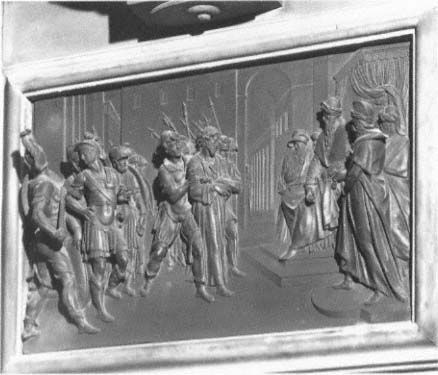
Figure 82.
Giambologna, Christ before Pilate , c. 1585–87. Bronze, 47 × 71 cm.
Soccorso Chapel, Santissima Annunziata, Florence.
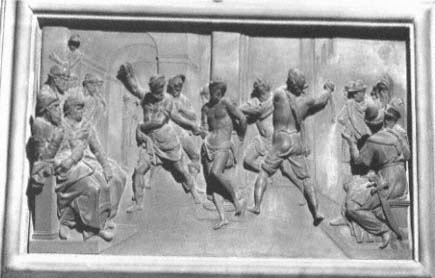
Figure 83.
Giambologna, The Flagellation , c. 1585–87. Bronze, 47 × 71 cm.
Soccorso Chapel, Santissima Annunziata, Florence.
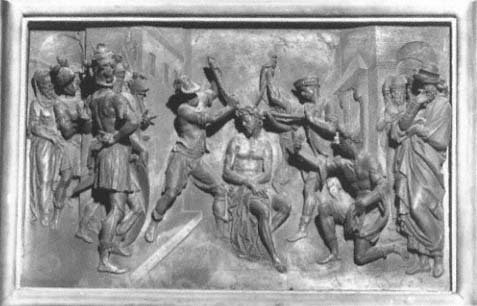
Figure 84.
Giambologna, Christ Crowned with Thorns , c. 1585–87. Bronze, 47 × 71 cm.
Soccorso Chapel, Santissima Annunziata, Florence.
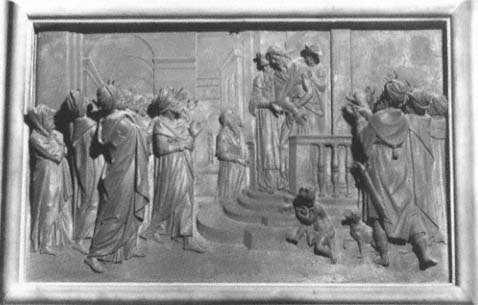
Figure 85.
Giambologna, Ecce Homo , c. 1585–87. Bronze, 47 × 71 cm. Soccorso Chapel, Santissima Annunziata, Florence.
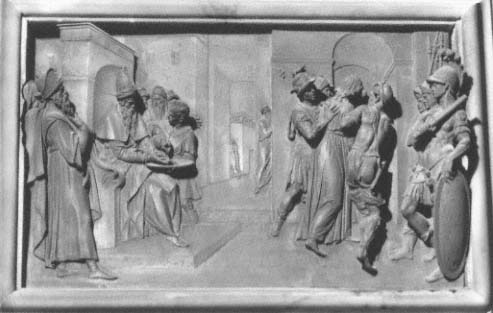
Figure 86.
Giambologna, Pilate Washing His Hands , c. 1585–87. Bronze, 47 × 71 cm.
Soccorso Chapel, Santissima Annunziata, Florence.
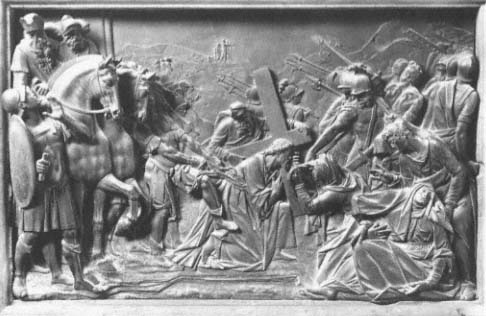
Figure 87.
Giambologna, The Way to Calvary , c. 1585–87. Bronze, 47 × 71 cm.
Soccorso Chapel, Santissima Annunziata, Florence.
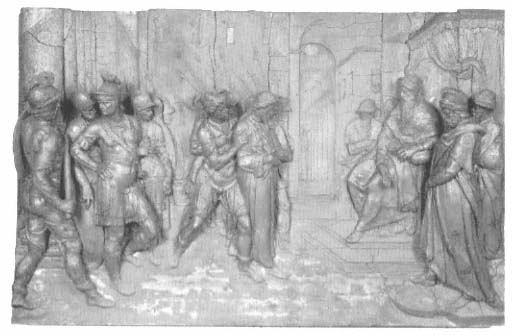
Figure 88.
Giambologna, Christ before Pilate , 1580. Wax model, 48 × 74 cm.
Victoria and Albert Museum, London.
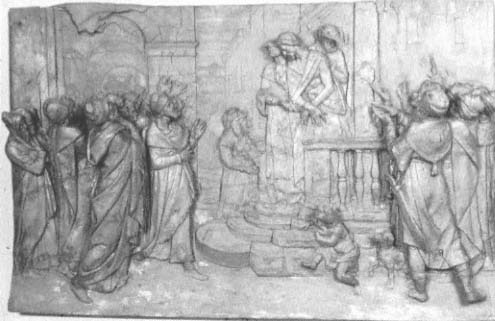
Figure 89.
Giambologna, Ecce Homo , 1580. Wax model, 48 × 74 cm.
Victoria and Albert Museum, London.
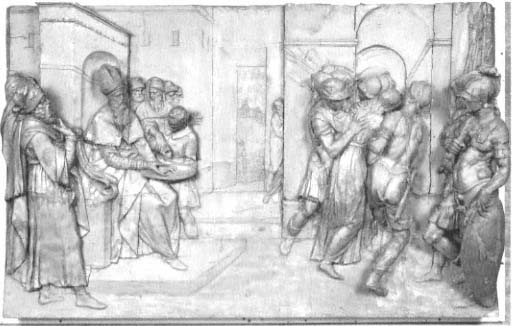
Figure 90.
Giambologna, Pilate Washing His Hands , 1580. Wax model, 48 × 74 cm.
Victoria and Albert Museum, London.
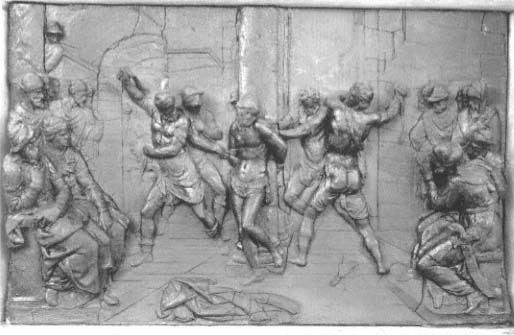
Figure 91.
Giambologna, The Flagellation , 1580. Wax model, 48 × 74 cm.
Queensland Art Gallery, Brisbane, Australia.
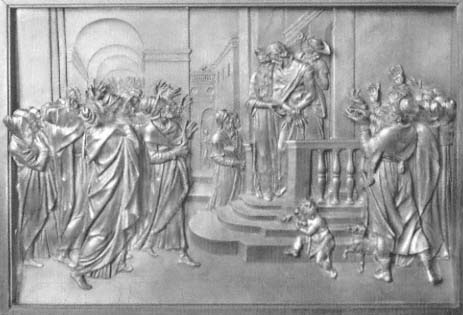
Figure 92.
Giambologna, Ecce Homo .
Bayerisches Nationalmuseum, Munich.
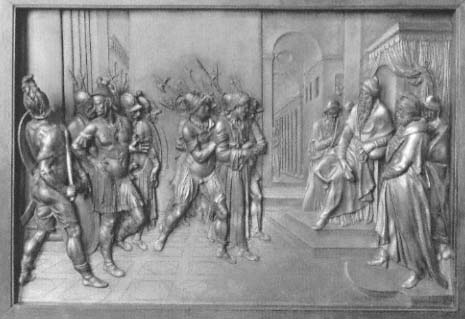
Figure 93.
Giambologna, Christ before Pilate .
Bayerisches Nationalmuseum, Munich.
Notes
Chapter 1— Preview
1. Giambologna's Flemish name, Jehan Boullongne, or Jean Boulogne, was italianized to Giovanni Bologna, though the artist was more commonly called Giambologna by his Italian contemporaries. The misnomer Giovanni da Bologna, which lives on sporadically to this day, was occasionally used by contemporaries, and was perpetuated by Burckhardt, who, as James Holderbaum points out in The Sculptor Giovanni Bologna (New York, 1983), 5, erred in translating von , denoting Giambologna's knighthood, into da , meaning "from."
For assessments of Giambologna's art, see, for example, Charles Avery, Giambologna (Mt. Kisko, N.Y., 1987), 9-10; John Shearman, Mannerism (Baltimore, 1967), 30-31, 86-91, 162-63. Studies like Richard Tuttle's (not yet published), of Giambologna's Neptune Fountain in Bologna will help correct this skewed evaluation. See Irving Lavin, Past-Present: Essays on Historicism in Art from Donatello to Picasso (Berkeley and Los Angeles, 1993), 63-83, for a revaluation of this monument that incorporates Tuttle's discoveries.
2. Avery, Giambologna , 97. On the interpretation of Renaissance pictures, Creighton Gilbert, "On Subject and Not-Subject in Italian Renaissance Pic- soft
tures," AB 34 (1952): 202-16, argues for a broader, more inclusive, approach than either a strictly stylistic or an iconological analysis allows. His view is equally applicable to sculpture and accords with my assessment of meaning in Giambologna's work.
3. Raffaello Borghini, Il riposo (Florence, 1584), 72-73. The setting of this dialogue on art was the villa Il Riposo of Bernardo Vecchietti, Giambologna's first Florentine patron. According to Borghini, who obviously knew Giambologna, the sculptor himself suggested that the group, complementing as well as rivaling Cellini's Perseus (1553), represented another incident in the Perseus story. No doubt Giambologna intended his work to compete with and surpass Cellini's as well as to join the other civic monuments in the Piazza della Signoria. Margaret D. Carroll's provocative analysis of Giambologna's statue in her article "The Erotics of Absolutism: Rubens and the Mystification of Sexual Violence," Representations 25 (1989): 7-11, argues that multiple meanings are subsumed in the work. Pointing out that Francesco de' Medici thought of it as an emblem of dynastic achievement, Carroll also shows that it could have served as "an empathetic bond between ruler and ruled that spans divisions of class and wealth by affirming their commonly held values in the domain of gender." For further thoughts on this subject from a feminist perspective, see Yael Ewen, "The Loggia dei Lanzi: A Showcase of Female Subjugation," Woman's Art Journal 12 (1991): 10-14.
4. I have profited from discussing with Leatrice Mendelsohn the figura serpentinata and the paragone . On their relationship, see John David Summers, " Maniera and Movement: the Figura Serpentinata," Art Quarterly 35 (1972): 269-301.
5. For a comprehensive treatment of the paragone debate, see Leatrice Mendelsohn, Paragoni: Benedetto Varchi's "Due Lezzioni" and Cinquecento Art Theory (Ann Arbor, 1982). For Varchi's Lezzioni , including Cellini's reply, see Due Lezzioni di M. Benedetto Varchi (Florence, 1549), in Paola Barocchi, ed., Trattati d'arte del cinquecento fra manierismo e controriforma (Bari, 1961), vol. 1, 3-82; and John Pope-Hennessy, Cellini (New York, 1985), 170.
6. John Pope-Hennessy, Italian High Renaissance and Baroque Sculpture (New York, 1970), 52.
7. Two studies on specific aspects of the chapel have appeared recently: Silvana Macchioni, "Le sculture del Giambologna," in Il Palazzo dell'Università di Genova. Il Collegio dei Gesuiti nella strada dei Balbi (Genoa, 1987), 359-84; Michael Bury, "The Grimaldi Chapel of Giambologna in San Francesco di Castelletto, Genoa," MKIF 26 (1982): 85-127.
8. I am grateful to Stephen Zwirn for sharing with me his thoughts on narrative. Without attempting to produce a comprehensive bibliography on recent narrative studies, I mention a few that I have found helpful: Roland Barthes, "Introduction to the Structural Analysis of Narrative," New Literary continue
History 6 (1975): 237-72; Hans Belting, "The New Role of Narrative in Public Painting of the Trecento: Historia and Allegory," in Pictorial Narrative in Antiquity and the Middle Ages, ed. Herbert L. Kessler and Marianna Shreve Simpson, Studies in the History of Art, 16 (Washington, D.C., 1985), 151-68; Richard Brilliant, Visual Narratives (Ithaca, N.Y., 1984); Vidya Dehejia, "On Modes of Visual Narration in Early Buddhist Art," AB 72 (1990): 374-92; Paul Ricoeur, "Narrative Time," in On Narrative, ed. W.J. Thomas Mitchell (Chicago, 1981), 165-86; Hayden White, "The Value of Narrativity in the Representation of Reality," in On Narrative, ed. W.J. Thomas Mitchell (Chicago, 1981), 1-23; Irene J. Winter, "After the Battle Is Over: The Stele of the Vultures and the Beginning of Historical Narrative in the Art of the Ancient Near East," in Pictorial Narrative in Antiquity and the Middle Ages, ed. Herbert L. Kessler and Marianna Shreve Simpson, Studies in the History of Art, 16 (Washington, D.C., 1985), 11-32.
9. I discuss the preparatory studies and two other versions of these reliefs in Appendix 4. Two of the six angels were stolen in 1982 and have not yet turned up (Macchioni, 394 n. 121).
10. For indulgences, the practice of granting remission of sin in return for acts of penance that included contributions to church buildings, see P.F. Palmer, "Indulgences," New Catholic Encyclopedia, vol. 7 (1967), 482-84. Ennio Poleggi, Strada Nuova (Genoa, 1972), fig. 8, shows the location of San Francesco at the end of the fifteenth century; fig. 10 gives its ground plan in relation to the plans of other churches in the area.
11. For a complete history of the church, see the unpublished eighteenth-century manuscript of Niccolò Perasso, "Chiese di Genova," ASG, Ms 836. See also Domenico Cambiaso, S. Francesco e il Terz' Ordine in Genova e Liguria (Genoa, 1916); and Alfonso Casini, Cento conventi (Genoa, 1950), 319-31. More recently, there is a good summary by Giorgio Rossini, "San Francesco di Castelletto: Dagli inizi alle demolizioni ottocentesche," in the exhibition catalogue edited by Max Seidel, Giovanni Pisano a Genova (Genoa, 1987), 229-61.
12. Cambiaso, S. Francesco, 68; Vincenzo Promis, "Libro degli Anniversarii del Convento di San Francesco di Castelletto in Genova," ASLSP, vol. 10 (1874), 404.
13. This monument was the subject of a major exhibition held in Genoa in 1987; see Seidel, ed. Giovanni Pisano a Genova .
14. La scultura a Genova e in Liguria dalle origini alle cinquecento, vol. 1 (Genoa, 1987), 197-98.
15. Perasso, "Chiese di Genova," fol. 2; and Rossini, "San Francesco di Castelletto," 229-61, especially 235-43 and 258 n. 62.
16. See Poleggi, Strada Nuova, for the history of this street, including full documentation. break
17. I am grateful to George Gorse for his illuminating comments about the complex problem of Alessi's part in the design of the Strada Nuova and for sending me his essay "A Classical Stage for the Old Nobility: The Strada Nuova and Sixteenth Century Genoa," to appear in Absolutism and Urban Space in Early Modern Italy, ed. R. Litchfield and John Marino (forthcoming). See E. De Negri, "Considerazioni sull'Alessi a Genova," in Galeazzo Alessi e l'architettura del cinquecento . Atti del Convegno internazionale di Studi (Genoa, 1974), 289-97, especially 294-95. Poleggi ( Strada Nuova ) does not believe that Alessi was involved in planning the Strada Nuova, but both the consensus and circumstantial evidence for Alessi's contribution, whether as consultant or mastermind, seems overwhelmingly against that view. See also E. De Negri, Galeazzo Alessi architetto a Genova (Genoa, 1957).
18. Records of the family's stock may be found in ASG, Banco di San Giorgio, Pandetta no. 17, Sala no. 20, Cartulario delle Colonne, no. 1459 "P," anno 1611; idem, no. 1459 "C," anno 1611; idem, no. 1464 "B," anno 1611; no. 1465 "PN," anno 1611.
19. See Poleggi, Strada Nuova, 301-26, for the history of Nicolò Grimaldi's palace, now Il Municipio. The lot Nicolò bought from Luca Grimaldi (son of Gerolamo) was more than three times the size of any of the other lots designated for palaces on the Strada Nuova.
20. In a notary document of 29 July 1568 (Poleggi, Strada Nuova, 323) the chapel in San Francesco is referred to as the chapel of Francesco Grimaldi, Luca's father.
21. Several Grimaldis maintained ties to San Luca, their parish church, as well as to the mendicant Church of San Francesco di Castelletto, as we learn from an anonymous manuscript in the state archives, ASG, Ms 446, "Le chiese di Genova," n.d., fol. 63v. On the death of the parish priests of San Luca in 1563 and 1581, cousins of Luca Grimaldi presented the newly selected replacement for investiture. And in 1605 Luca, who was referred to as one of the "governatori e procuratori delli Grimaldi," was one of the presenters (fol. 63v).
22. Poleggi, Strada Nuova, 81-90, 90 n. 11, discusses the history of the palace and distinguishes between the two Lucas. Luigi Levati, Dogi biennali di Genova dal 1528 al 1699, pt. 1 (Genoa, 1930) 304-5, summarizes what can be gleaned from the archives about "our" Luca Grimaldi. The rebuilding of San Pietro di Banchi, begun in 1581 although projected earlier, was undoubtedly motivated by the plague of 1577. See La scultura a Genova, 326-27 (figs. 345-47), 344-45 (figs. 384-87); and Bury, "The Grimaldi Chapel," 88, 118 n. 27.
23. Promis, "Libro degli Anniversarii," 420.
24. Ibid., 406-7.
23. Promis, "Libro degli Anniversarii," 420.
24. Ibid., 406-7.
25. Licia Collodi Ragghianti, "Luca Cambiaso disegnatore," Critica d'Arte, no. 3 (1954): 239-62, believes that Uffizi 1749 may be a preparatory study for the lost painting for San Francesco. break
26. After the conclusion of the Council of Trent in 1563, apostolic visitations were gradually instituted for all of Italy. These inspections included a minute examination of the physical condition of the churches and their decoration. In Genoa, for example, the visitation in 1582 by Monsignore Francesco Bossio, which is well documented, seems to have omitted nothing. Among the many instructions he left for San Francesco di Castelletto were the following: that the roof of the church be repaired as soon as possible, that all altars be enlarged or reduced according to fixed measures, and that each have an altarpiece and a marble balustrade ("Visita pastorale delle chiese della diocesi di Genova, fatta da Monsignore Francesco Bossio, 1582," ASG Ms 547, fol. 109); see also Synodi Dioecesanae et Provinciales, editae atque ineditae S. Genuensis Ecclesiae, accedunt Acta et Decreta Visitationis Francisci Bossii, Ann. MDLXXXII (Genoa, 1833); Francesco Bossio, Decreta Generalia ad exequendae Visitationis Genuensis usum (Milan, 1584).
27. The progressive denuding and demolition are recounted in Rossini, "San Francesco di Castelletto," 254-55.
28. Raffaelo Soprani, Le vite de' pittori, scultori, et Architetti genovesi e de' Forastieri che in Genova operarono con alcuni ritratti di gli stessi (Genoa, 1674), 291, is the earliest published reference to the Grimaldi Chapel. Soprani says of it: "Quali opere sono di cosi fina maestria, che non solo cagionano stupore in coloro, che s'imbattono a considerarle: ma quando Giovanni non havesse dato al mondo altro saggio del suo valore, meritarebbe ad ogni modo di esser honorato col titolo d'ottimo, e di eccellente maestro." See also Carlo Giuseppe Ratti, Instruzione di quanto può vedersi di più bello in Genova in pittura, scultura, ed architettura (Genoa, 1780), 248-50, which lavishly praises the Grimaldi Chapel in listing many of the contents of San Francesco:
Le tavole che l'adornano meritano qualche osservazione, e per vederle con alcun ordine, la prima a destra di S. Girolamo è di Bernardo Castello; l'altra che segue con la Beata Vergine e vari Santi si può dire che fosse, ma non già che sia di Perin del Vaga, perché molto rovinata dal tempo, e quella di S. Caterina tra le ruote è d' Andrea Semino . La cappella degli Spinoli ben architettata in marmo ha una tavola col Presepe dello stesso Semino ed un deposito di marmo d'Andrea Spinola, colla sua figura giacente su di un'urna, ed una Vergine al di sopra col Putto, scultura del Cambiaso ovvero del Castello Bergamasco. Sono in essa alcuni ritratti in marmo di nobili Spinoli, tra i quali quello d'Andrea Doge e quello di Clelia sua consorte, di Carlo e di altri, tutti di buona maniera. Nella capella che dopo questa s'incontra, la tavola del transito della Madonna è del Sarzana, e in quella che viene appresso, la tavola con S. Francesco è di mano di Camillo Procaccino, fratello di Giulio Cesare. Troverete ora la cappella Grimaldi nobile per architettura, marmi e bronzi, celebratissimo lavoro di Giovanni Bologna, che di tal materia gittò sei belle statue di Virtù, sette bassirilievi con misteri della Passione, e sei graziosi putti, ed anche l'effigie del Crocifisso all'altare. Le due tavoline però, una colla vendita di Giu- soft
seppe, e l'altra col sagrificio d'Isacco, sono del Lomi . All'altar maggiore potrete ammirare un Crocifisso in legno di Giovannandrea Torre .
(The panels that decorate it deserve some comment. To see them in some order, the first to the right of Saint Jerome is by Bernardo Castello; of the next, with the Blessed Virgin and various saints, one could speculate but not say with certainty that it was by Perino del Vaga, because it has been so ravaged by time; and that of Saint Catherine on the wheel is by Andrea Semino. The chapel of the Spinola, well constructed in marble, has a panel of the Nativity by the same Semino, a monument of marble by Andrea Spinola with his recumbent figure on an urn, and a Virgin above with an angel, a sculpture by Cambiaso or by Giovanni Battista Castello, Il Bergamasco. There are in this chapel some marble portraits of noble Spinoli, among them Doge Andrea and his wife, Clelia, [as well as] Carlo and others, all in a good style. In the chapel after this one, the panel of the Dormition of the Virgin is by Sarzana, and in the next, the panel with Saint Francis is by Camillo Procaccini, brother of Giulio Cesare. Next is the Grimaldi Chapel, with noble architecture, marbles, and bronzes, a most celebrated work of Giovanni Bologna, who in that material [i.e., bronze] cast six beautiful statues of Virtues, seven bas-reliefs with mysteries of the Passion, six charming putti as well as the image of the crucifix on the altar. The two panels, however, one with the Selling of Joseph, the other with the Sacrifice of Isaac, are by Lomi. On the high altar one can admire a wooden crucifix by Giovannandrea Torre.)
Elisabeth Dhanens, Jean Boulogne (Brussels, 1956), 241-53, includes the Grimaldi bronzes in her catalogue of Giambologna's oeuvre. Holderbaum, The Sculptor Giovanni Bologna, 210-14, 261-76, gives a perceptive, if brief, formal analysis of the Grimaldi bronzes. Bury, "The Grimaldi Chapel," deals only with the chapel's reconstruction. Avery, Giambologna, briefly considers the reliefs and Virtues in the context of relief sculpture and religious works. Macchioni gives the most comprehensive account to date.
29. Filippo Baldinucci, Notizie dei professori del disegno da Cimabue in qua, book 3 (Florence, 1681-88), 120-36.
30. For a study of the sculpture in Sainte-Waudru, see R. Hedicke, Jacques Dubroeucq von Mons: Ein niederländischer Meister aus der Frühzeit des italienischen Einflusses (Strasbourg, 1904), published in French as Jacques Dubroeucq de Mons, trans. Emile Dony (Brussels, 1911). See also the essay in the catalogue Jacques Du Broeucq (Mons, 1985), published in connection with the exhibition in Sainte-Waudru, 1 October to 24 November 1985. Werner Gramberg, Giovanni Bologna: Eine Untersuchung über die Werke seiner Wanderjahre (Berlin, 1936), discusses Giambologna's early years to 1567.
31. Ignace Vandevivere and C. Perier-d'Ieteren, Belgique Renaissance (Brussels, 1973); Jacques Debergh, "Echos de l'antiquité romaine dans l'oeuvre de Du Broeucq," in Jacques Du Broeucq, 125-44.
32. This and the other figures and reliefs from the rood screen are illustrated in Jacques Du Broeucq, 56-84. break
33. Debergh, "Echos de l'antiquité romaine," 125-44.
34. Baldinucci, Notizie, book 3, 7, 89.
35. The relation between Giambologna and Gugliemo della Porta is discussed in Chapter 5. Della Porta's shop was the center of bronze casting in Rome when Giambologna was there, and it was also a gathering place for Flemish artists.
36. Michael Bury, "Bernardo Vecchietti, Patron of Giambologna," I Tatti Studies 1 (1985): 13-56.
37. Baldinucci, Notizie, book 3, 88: "Di questa sorte per certo non potè dolersi Gio. Bologna celebre Scultore Fiammingo, mercè l'avere nel suo primo arrivó a Firenze dato alle mani d'un Principe de' più magnanimi, che contasse allora quella sua età, e fu questi la Gl. Mem. del Granduca Francesco, sotto i cui auspici ritrovò egli non pure perfezione nell'arte sua, e buone ricchezze, ma eziandio qualla fama, che per sempre lo renderà immortale, siccome ora so io per raccontare."
38. See the exhibition catalogue edited by C. Avery and A. Radcliffe, Giambologna, 1529-1608: Sculptor to the Medici (London, 1978).
39. See Malcolm Campbell and Gino Corti, "A Comment on Prince Francesco de' Medici's Refusal to Loan Giovanni Bologna to the Queen of France," Burlington Magazine 115 (1973): 507-12.
40. Dhanens, 56-63, 355.
41. I am using the term "Catholic Reformation" in this study instead of the more traditional term "Counter-Reformation" in recognition of the modern historical view, which interprets the Catholic reform of the sixteenth century as much more than a reaction to the Protestant Reformation. See John O'Malley, "Catholic Reform," in Reformation Europe, ed. Steven Ozment (St. Louis, Mo., 1982); Henry Outram Evenett, The Spirit of the Counter Reformation (Cambridge, 1968); Hubert Jedin, Katholische Reformation oder Gegenreformation? Ein Versuch zur Klärung der Begriffe (Lucerne, 1946).
42. Both treatises are in Barocchi, ed., Trattati, vol. 2, 1-509. The Council of Trent had reaffirmed the value of images in aiding worship in its twenty-fifth session, held in 1563; see H.J. Schroeder, ed., Canons and Decrees of the Council of Trent (London, 1941), 215-17.
Chapter 2— The Setting
1. My intention here is not to undertake an exhaustive reconstruction of the Grimaldi Chapel. For previous reconstructions, see Bury, "The Grimaldi Chapel"; and Macchioni.
2. The contract, found in ASG, Notaio Giacomo Ligalupo, 1579 2°, filza 14 (24 July 1579), was published by Dhanens, 243 n. 2; for a new transcription by Gino Corti, with an English translation prepared by Michael Sollenberger, continue
see Appendix 1A. For information on the extant studies and other versions of the reliefs, see Appendix 4. For the problem of The Entombment and my attribution, see also Chapter 5.
The first to mention the seventh relief is Soprani, Le vite de' pittori, 291. The subject of the relief was first identified by Carlo Giuseppe Ratti, ed., Le Vite de' Pittori, Scultori, e Architetti Genovesi di Raffaello Soprani con note e continuazione in questa seconda edizione rivedute accresciute ed arricchite di note da Carlo Ratti, vol. 1 (Genoa, 1768), 423.
3. Ratti ( Le Vite de' Pittori, vol. 1, 423) is the first to mention the crucifix. Apparently it was taken to the University of Genoa along with the other bronzes from the chapel and has since disappeared; see Luigi Tommaso Belgrano, "Rendiconto dei lavori fatti della Società Ligure di Storia Patria negli anni accademici MDCCCLXIV," ASLSP, vol. 3 (1864), cxxv. Macchioni (368, 373) envisions the lost crucifix as similar in size, date, and type ( Cristo vivo ) to the one for Giambologna's own burial chapel in Santissima Annunziata, Florence.
Paintings by Aurelio Lomi in the Grimaldi Chapel are first mentioned by Soprani, Le vite de' pittori, 318. Ratti ( Instruzione di quanto, 250) identifies the paintings as The Sacrifice of Isaac and Joseph Sold into Egypt . Vittorio Belloni, Pittura genovese del seicento, vol. 1 (Genoa, 1969), 108-9, discovered the two Lomi paintings in the Convent of Sant-Antonio, Gaggiola, La Spezia. Maria Clelia Galassi, "Aurelio Lomi a Genova," in Roberto Paolo Ciardi, Maria Clelia Galassi, and Pierluigi Carofano, Aurelio Lomi (Ospedaletto, 1989), especially 88-89, dates them about 1597. Although the painting in La Spezia shows Joseph standing by the well, Ratti gave its title as Joseph Sold into Egypt; Bury ("The Grimaldi Chapel," 123 n. 74) attributes the discrepancy to a mistake by Ratti. In fact, Ratti may have been using the title Joseph Sold into Egypt as a general one to designate the entire episode related in Genesis 37. See also Louis Réau, Iconographie de l'art chrétien, vol. 2 (Paris, 1955) 156-62; and Lexikon der christlichen Ikonographie, ed. Englebert Kirschbaum (Rome, 1970), vol. 2, 424-34.
4. Giulio Negrone, Ragionamento fatto nella Chiesa Catedrale di S. Lorenzo, dopo la Coronatione del Signor Luca Grimaldo (Genoa, 1605), 44.
5. That this was a public invitation from the Genoese government is certain from the letters it exchanged with Duke Francesco, now in ASF, whose transcriptions, by Gino Corti, can be found in Appendix 1B. They show that the doge and governors of Genoa, not Luca Grimaldi, were the correspondents. Previous errors, published by Dhanens, 342-44, and followed by Bury ("The Grimaldi Chapel"), have clouded this issue somewhat.
6. La scultura a Genova, 215-393; Elena Parma Armani, Perin del Vaga, l'anello mancante (Genoa, 1986), especially 73-152. break
7. See De Negri, "Considerazioni sull'Alessi a Genova," in Galeazzo Alessi e l'architettura del cinquecento, 289-97, and De Negri, Galeazzo Alessi architetto a Genova .
8. La scultura a Genova, 290-303; Pietro Boccardo, Andrea Doria e le arti: Commitenza e mecenatismo a Genova nel rinascimento (Rome, 1989), 89-104; Paolo Montano, "La piazza, la chiesa e il chiostro di San Matteo," Quaderno, Università degli Studi di Genova, Facoltà di Architettura. Istituto di Elementi di Architettura e Rilieva dei Elementi, no. 4 (September 1970), 167-99; Jacopo D'Oria, La chiesa di San Matteo in Genova (Genoa, 1860).
9. Levati (297) mentions this mission. In the correspondence (ASG, Instructiones et relationes, 2707 D, 80 and 81; Litterarum, 1969, 12) the Lunigiana problem is not mentioned, only the birth of the grand duke's son. Both assignments may have been carried out at the same time.
10. Grimaldi named Fornari in the contract as the person to oversee payments from Genoa for the chapel bronzes as they were cast and completed in Florence.
11. Negrone, Ragionamento, 43-44:
Quella bellissima Cappella fabricata in S. Francesco, ricca di finissimi marmi sopara & sotto; ornata di statue di bronzo: per li stucchi, per l'oro, per le pitture vaga a maraviglia, & ragguardevole: piena di divotione per le molte, & grandi Indulgenze. Questa per essere stata fra le più belle, & ricche se non erro, la prima che fabricata si sia nella città nostra, valso ha d'esempio a molti di Pietà, & risvegliata la divotione nel petto de gli altri nostri cittadini, i quali poscia con una santa gara hanno abbellite, & tuttavia vanna adornando le Chiese di Genova.
(This very beautiful chapel in San Francesco, richly built with fine marbles above and below, decorated with bronze statues: because of its stuccos, its gold, and its wondrously graceful and remarkable paintings, full of devotion for many grand indulgences. This chapel, having been among the most beautiful, rich, and, if I am not mistaken, the first to have been built in our city, was valued as an example of piety to many and has reawakened devotion in the breast of many other citizens, who, as if waging a holy war, adorned, and are still adorning, the churches of Genoa.)
12. If, as is highly probable, Grimaldi visited Giambologna's workshop while in Florence to congratulate the grand duke and duchess on the birth of their son, he could have seen several statuettes in preparation-- Mercury, Nessus and Deianira, and Labors of Hercules --as well as larger works: the Bacchus of Lattanzio Cortesi, the Fiorenza made for the Tribolo Fountain at Villa Castello (now at the Villa Petraia), the Apollo (Fig. 43) for the Studiolo (all reproduced in Avery, Giambologna ), and perhaps the Rape of the Sabine statuette (see Fig. 19) ordered by Ottavio Farnese, duke of Parma. break
13. See Dhanens, 343-44, for Giambologna's letter to Ottavio Farnese of 13 June 1579. In it he writes that during his work in Genoa he is going to personally deliver the bronze statuette to the duke in Parma, or if that is not possible, he will send someone from Genoa to deliver it. Macchioni (379) points out that the golden color of the bronzes is due not to gilding but to the composition of the metal itself; she made this observation after examining the interior cavities of the angels and places on the Virtues and reliefs where the opaque patina, probably added in the nineteenth century, has worn off.
14. The Elder Pliny's Chapters on the History of Art, trans. K. Jex-Blake (Chicago, 1976); Pomponius Gauricus, De Sculptura (1504), ed. and trans. André Chastel and Robert Klein (Geneva, 1969).
15. In 1598 Paggi painted a Nativity for Giambologna's burial chapel in Santissima Annunziata. See Ciardi, Galassi, and Carofano, Aurelio Lomi, 80, 86 n. 52; and Franco Renzo Pesenti, La pittura in Liguria, artisti del primo seicento (Genoa, 1986), chap. 1.
16. In his letter to Ottavio Farnese, 13 June 1579, Giambologna's reference to his prospective work in Genoa--"et opera mia in edificare, et ornare di Statue, certa chiesa che hanno deliberato di fare" (and my work in building and decorating with statues a certain church they have decided to build)--indicates that he expected to design architecture for a church. Because Giambologna's written Italian is far from correct, we cannot be sure whether he meant a church or a chapel. Both the letter from the Genoese to Grand Duke Francesco de' Medici requesting the services of Giambologna and the duke's reply call Giambologna "scultore et architetto" (ASF, Mediceo, 2836 [Lettere della Repubblica di Genova, 1541-1621, n.p.], 8 May 1579, and ASF, 250 [Registro di lettere del Granduca, 1578-79], fol. 142r, 26 May 1579). Another letter, dated 28 July 1579 from Genoa to Florence that reports on Giambologna's stay there refers to him as "Giovanni Bologna scultore" and mentions "il bisogno dell'industria et giudicio suo sopra certe capelle che si fabricano" (the need of his work and judgment concerning certain chapels being built). Whether his advice was sought only in his capacity as sculptor or extended also to architectural matters is not clear. Macchioni (371-72) suggests that the "certe capelle" may refer to the Doria chapels (under reconstruction at this time) to the left and right of the main altar in San Matteo. Giambologna's reputation as court artist to the Medici and his work for the Salviati Chapel, already begun at this time (see n. 17), make his responsibility for the architectural design of the Grimaldi Chapel likely.
17. In Disegni di architetti fiorentini, 1540-1640, Andrew Morrogh suggests that the architecture of the Salviati Chapel (San Marco, Florence) may be Giambologna's adaptation of a design by Palladio ([Florence, 1985], especially fig. 59). If it was, the architectural design for the Grimaldi Chapel, which resembles continue
the Salviati in so many ways, was probably also based on Palladio's ideas. Giambologna stayed in Genoa for a little more than two weeks when he went there to present plans and conclude the contract for the Grimaldi Chapel. Even if he brought with him ideas for the architectural decoration, he needed someone to supervise the execution. Undoubtedly this task was undertaken by Pietro Francavilla, who accompanied him to Genoa (Baldinucci, Notizie, book 3, 128) and stayed several years (Ratti, Le Vite, vol. 1, 423-24), independently acquiring Grimaldi and Senarega as patrons; see Michael Bury, "The Senarega Chapel in San Lorenzo, Genoa; New Documents about Barocci and Francavilla," MKIF 31 (1987): 327-56.
18. Pisa, Salviati Archives, "Libro della fabrica della cappella di Santo Antonino in San Marco, Segnato A, 1579-1592," fol. IV:
+MDLXXVIIII
Maestro Iacopo di Zanobi Piccardi, scarpellino da Rovezano, per conto di andare a Carrara a cavare marmi per servizio della fabrica della nostra cappella di S. to Antonino, de' dare addì 13 di giugnio scudi 100 d'oro, per noi da Averardo [e] Antonio Salviati e C. di bancho.
19. Bury's assumption that the Grimaldi Chapel was the earlier one and that therefore two later Genoese chapels, the Serra and Pinelli in San Siro, are primary evidence for the appearance of the Grimaldi Chapel reverses the chronology, missing the crucial place of the Salviati Chapel in putting the pieces of the puzzle together. For casting records of the Grimaldi bronzes, which stretched from about 1582 to 1590, see Bury, "The Grimaldi Chapel," appendix 2, 115-16, and 97-99, 120 nn. 56-60, 121 nn. 61-62. The execution of the Salviati bronzes, as recorded in the Salviati archives in Pisa, covered the period from 1580 to 1588.
20. The associative and symbolic aspects of marble are discussed by Steven Ostrow, "Marble Revetment in Late Sixteenth-Century Roman Chapels," in IL60: Essays Honoring Irving Lavin on His Sixtieth Birthday (New York, 1990), 253-66. Andrew Morrogh, "Vasari and Coloured Stones," in Giorgio Vasari tra decorazione ambientale e storiografia artistica, ed. Gian Carlo Garfagnini (Florence, 1985), 309-20, points out Grand Duke Cosimo's passion for "coloured stones," which Vasari shared.
21. Pope-Hennessy, Italian High Renaissance and Baroque Sculpture, 376-77, fig. 69. The Chigi Chapel in Santa Maria del Popolo, designed by Raphael but still not finished at the time of Giambologna's first visit to Rome, is an even earlier precedent, although the program has nothing to do with the Grimaldi. Among studies of various aspects of the Chigi are those by John Shearman, "The Chigi Chapel in S. Maria del Popolo," JWCI 24 (1961): 129- hard
60 (on the sculptures), and by Kathleen Weil-Garris Brandt, "Cosmological Patterns in Raphael's Chigi Chapel in S. Maria del Popolo," in Raffaello a Roma: Il convegno del 1983 (Rome, 1986), 127-60.
22. John David Summers, "The Sculptural Program of the Cappella di San Luca in Santissima Annunziata," MKIF 14 (1969): 67-90.
23. G. B. Castello, Il Bergamasco (c. 1510-c. 1569), was commissioned to decorate this chapel in 1565. He also worked for a Grimaldi relative in San Francesco di Castelletto; see Colette Dufour et al., La pittura a Genova e in Liguria dagli inizi al cinquecento (Genoa, 1970), 256, 310-11. The Prudence is generally given to Cambiaso. Franco Lercari, a member of the old nobility and the patron of the Lercari Chapel, also had one of the grand palaces on the Strada Nuova (Poleggi, 349-58).
24. See Bury, "The Senarega Chapel"; for the Immacolata and San Giovanni Battista chapels in San Pietro, see La scultura a Genova, 341-45; for the Pinelli and Serra chapels see Bury, "The Grimaldi Chapel," 92-94, figs. 5, 6. Francavilla, who had assisted Giambologna in both the Salviati and Grimaldi chapels, worked in the Senarega, whose altar was radically changed in the early nineteenth century. But the Senarega's side walls, which retain their original appearance, show a greater subordination of parts to whole, further projection of the pediments, and a greater vertical emphasis than those in the Salviati Chapel. The same is true of the Chapel of the Immacolata in San Pietro. As for the Pinelli Chapel, the altar wall has an aedicula with engaged columns and a broken pediment much more bold in profile and ornament than the corresponding aedicula in the Salviati Chapel, whereas the lateral walls of the chapel have an aedicula with only a molding to frame the painting and a broken segmental pediment. Presumably, columns were omitted on the lateral walls to make space for the sculptural niches, which do not exist on the altar wall. The angels holding instruments of the Passion on the pediment of the altar wall sit very upright, unlike those for the Grimaldi Chapel, whose corkscrew postures seem to require a curved surface. The design for Giovanni Domenico Cappellino's painting The Flagellation, as well as that for Giambologna's Flagellation relief in the Grimaldi Chapel, reflects Luca Cambiaso's treatment of the subject. This argument is pursued in Chapter 5.
25. Soprani, Le vite de' pittori, 291. Soprani (1612-1672) took orders after his wife died in 1670; he himself was buried in San Francesco di Castelletto. Referring to Giambologna's work in the Grimaldi Chapel, he says:
Vene egli in Genova circa l'anno 1580 chiamatovi dal Signor Luca Grimaldi, acciochè adornar dovesse con l'Arte sua una sontuosa Capella, che in honore della Croce Santissima haveva edificata nella Chiesa di San Francesco; per lo che volendo Giovanni far pompa del suo talento, & acquistarsi honor, rappresentò in sei figure di tondo rilievo grandi quanto il naturale la Fortezza, la Giustitia, la Temperanza, & altre virtù simili, che si vedono collocate ne suoi nicchi di marmo, continue
a quali aggionse sei putti sedenti sopra alcune cornici; e sette historiette di basso rilievo, nelle quali espresse i più principali misteri della Santissima Passione di Nostro Signore.
(He came to Genoa about the year 1580, called there by Signor Luca Grimaldi, so that he could adorn with his art a sumptuous chapel, built in honor of the most holy cross in the Church of San Francesco. For this reason, Giovanni, wishing to make a great show of his talent and to acquire much honor for himself, represented six life-size figures in the round—Fortitude, Justice, Temperance, and other, similar, virtues—which are seen all together in their marble niches, to which he added six putti sitting on cornices; seven small stories in relief, in which are represented the principal mysteries of the most Holy Passion of Our Savior.)
Regarding Lomi he says (ibid., 318): "Quindi è che in gran numero si vedono per le Chiese di Genova l'opere di quest'aventuroso artefice; com'il Sant' Antonio di Padova posto nella Chiesa di San Francesco, nella quale sono anche di sua mano le pitture ad oglio nella Capella del Signor Luca Grimaldi" (Therefore one sees in great number in the churches of Genoa works of this bold craftsman, as in [the painting of] Saint Anthony of Padua located in the Church of San Francesco, where the paintings in oil in the chapel of Signor Luca Grimaldi are also by him).
26. Ratti, Le Vite , vol. 1, 423, and 450 for mention of the paintings.
27. For other discussions of the change from Prudence to Temperance, see Bury, "The Grimaldi Chapel," 112-13, 126 nn. 115 and 121, and 127. Dhanens (249) and Holderbaum ( The Sculptor Giovanni Bologna, 213) believe that the statue represents both virtues because she holds a compass and ruler in addition to the reins of Temperance. Erwin Panofsky, Tomb Sculpture (New York, 1964), 75-76, figs. 326, 327, refers to examples of Prudence with a compass in a group of French Renaissance monuments. Lynn White, Jr., "The Iconography of Temperantia and the Virtuousness of Technology," in Action and Conviction in Early Modern Europe, ed. Theodore K. Rabb and Jerrold E. Seigel (Princeton, 1969), 207, points out that Andrea Orcagna's Assumption tabernacle of 1359 at Orsanmichele has the rare image of Temperance with a compass. The subject of the first relief in the chapel is discussed in Chapter 4, n. 42.
28. Mary Carruthers, The Book of Memory (Cambridge, 1990), especially 64-71; Jennifer O'Reilly, Studies in the Iconography of the Virtues and Vices in the Middle Ages (New York, 1988), 113-55; Lynn White, "The Iconography of Temperantia "; Frances Yates, The Art of Memory (Chicago, 1966), 57-75.
29. Giovanni Giorgio Boggiano, Oratione, Recitata nel Senato il Primo di Luglio (Genoa, 1605); Negrone, Ragionamento .
30. Réau, vol. 2, 156-62. The Joseph scene is not nearly so common as the Isaac. An extensive examination of the eucharistic meaning of the chapel and its connection to Tridentine thought can be found in Chapter 4. break
31. For the Soccorso contract, see Appendix 2. I can find no information in any of the literature regarding the purpose for which Grand Duke Ferdinando had originally ordered this set, which was cast for him in about 1585-87. See Avery, Giambologna, 271; Dhanens, 295-97.
32. ASF, Conventi Soppressi. 119 (S. ma Annunziata di Firenze), 66 (Contratti, 1550-99). See Appendix 2.
Et insuper, attenta bona voluntate dicti domini Ioannis Bononie erga dictam eorum Ecclesiam et conventum, libere eidem concesserunt ad eius beneplacitum et voluntatem faciendi, construendi et hedificandi ad pedes Altaris et Cappellanie prefate vel ibi circum circa, dummodo non deturbetur Cappella contra formam Sacri Concilii Tridentini, unum sepulcrum pro se ipso et suis successoribus et ad eorum usum, eo modo et forma prout sibi placuerit . . .
(Moreover, having retained the goodwill of said Lord Giovanni Bologna toward their church and convent, they have freely conceded to the same to construct and build as he pleases and decides at the foot of the high altar and aforementioned little chapel or thereabouts, so long as the chapel will not be pulled down contrary to the rules of the Sacred Tridentine Council, one tomb for himself and his successors, and for their use, in a way and fashion that will be pleasing to him . . .)
Giambologna's chapel occupied the most honored site in the church.
A further measure of Giambologna's high prestige may be found in Settimanni's report (Diario Fiorentino, ASF, 6, 1596-1608, fols. 89, 128) that on 6 May 1598 Grand Duke Ferdinando and Grand Duchess Cristina took part in a large and devout procession at the Annunziata for the installation, in the choir of the church, of the statue representing the Madonna del Soccorso, whose chapel the celebrated sculptor Giambologna made as a sign of his piety. The chapel itself was unveiled on 24 December of the same year.
33. Federico Federici, "Scrutinio della nobiltà Ligustica composta da me," seventeenth century, ASG 798, fol. 50r; Giulio Pasqua, Memorie e Sepolcri che sono nelle chiese e ne'suburbj di Genova raccolte dal Signor Giulio Pasqua l'anno 1610 (abstract by Jacopo Doria, 1870), vol. 49, CBBG, Mr.XV.5.5. The date 1544 next to this entry must be a mistake because the genealogy of Carolo de Venasque, Genealogica et Historica (Paris, 1647), fol. 110, records this same Francesco Grimaldi as ambassador to the emperor in 1547, and Giacomo Giscardi, "Notizia di pitture, statue et altro in diverse chiese e palazzi della città e contorni di Genova, con la relazione dell'origine delle medesime chiese," Biblioteca Franzoniana, Genoa, Ms C. 54, 43, seventeenth century, lists a Last Supper painted by Luca Cambiaso in 1574 for Francesco Grimaldi.
34. The inscription originally in the crypt, surviving only from a rubbing (Domenico Piaggio, "Monumenta Genuensia," CBBG, Mr.V.3.3., fol. 237, early nineteenth century), states that there were relics there. It is reproduced and translated in Appendix 1E. break
35. D'Oria, La chiesa di San Matteo in Genova, 75-80, 83-86.
36. In view of the reforms concerning burial instituted at the Council of Trent (Carlo Borromeo, "De sepulcis et coemiteriis," in Trattati, ed. Barocchi, vol. 3, 74-77), the presence of sarcophagi in the Grimaldi Chapel may be questioned, but the practice apparently continued. Giovanni Antonio Senarega, the patron of the Senarega Chapel in the cathedral of Genoa, was granted permission to build tombs in his chapel when he acquired it on 23 April 1579 (Bury, "The Grimaldi Chapel," 118 n. 32). If Luca Grimaldi had desired tombs in his chapel, he too could undoubtedly have obtained permission.
During his apostolic visit to Genoa in 1582, Monsignore Bossio instructed that wall tombs not be too close to altars; he was specific about tombs in the floor (ASG, Ms 547, fol. 11r,v):
Ea sepulchra quae in ecclesiae pavimento concamerato opere condita sunt, queque sepulcrale os habentnimis altaribus adiunctum, si palmis quinque ad altarium scabellis non distent, sepelliendi usu interdicuntur et humo oppleantur adaequato solo.
Et item opercula, quae imagines habent vel familiarium insignia vel litteras aut aliud omnino quicquam, quod extet atque emineat, accommodentur sex mensium spatio, cum et pavimentum deturpent et convenientium ad ecclesiam pedes offendant, atque ipsa opercula e polito lapide sint atque ita comprese adhereant ut nullo unquam tempore foveant, et si quis effigiendum sit (quod prius Rev. mi Ordinarii iudicio probetur) tesselato opere fiat, nihilque omnino superemineat. Quae peracto sex mensium spatio ad eam rationem accommodata non fuerint, amoveantur obstruanturve omnino.
Sepultura parieti inclusa prope portam maiorem eminens ad octavum diem tollatur, quod si praestitum non fuerit, ecclesia sit tamdiu interdicta donec prestitum fuerit.
(Tombs in the pavement and in the wall of the church, if their openings are too close to the altars and not at least 5 palms from the altar stools, may not be used for burial and must be filled with enough soil to make them flush with the ground.
In addition, tomb covers with family coats of arms and inscriptions that project are to be adjusted within six months' time because they disfigure the pavement and create an impediment to people walking in the church; they are to be made with flat marble so that there are no hollows. If something has to be represented on them (with the prior approval of the Most Reverend Archbishop), it has to be done in mosaic, without any projection. Those [tombs] not adjusted in this way within six months' time are to be removed or completely walled up.
The tomb standing out in the wall near the main door must be removed within eight days, and if this order is not complied with, the church will be put under interdict until such time as the order is executed.)
37. Dhanens also favors an island altar for the Grimaldi Chapel, an arrangement used for both the Salviati and Annunziata chapels. Bury, however, believes that the altar in the Grimaldi Chapel was attached to the wall, implying continue
that it did not have a sarcophagus. He cites the preservation of relics of the cross and crown of thorns in the chapel crypt as the reason for changes between the signing of the contract and the final execution, including the substitution of a wall altar for an island altar. More discussion of sarcophagi locations can be found in Macchioni, 372-73.
38. Pilate washes his hands only in the Gospel of Matthew, where the episode occurs before the Flagellation. For the Canonical Office see Karl Young, The Drama of the Medieval Church (Oxford, 1933) vol. 1, 44-75.
39. For the medieval tradition, see O'Reilly, 269; and Rosemond Tuve, "Notes on Virtues and Vices," JWCI 26 (1963): 264-303. Later in the seventeenth century, in the Protestant Netherlands, visual links between a specific virtue and a Passion scene emerge sporadically. Rembrandt's etching Ecce Homo, in which the figure of Justice Bound stands in the tribune behind Christ, is discussed by E. Winternitz, "Rembrandt's Christ Presented to the People, 1655: A Meditation on Justice and Collective Guilt," Oud Holland 84 (1969): 177-90; see also Margaret D. Carroll, "Rembrandt as Devotional Printmaker," AB 63 (1981): 585-610. Pilate Washing His Hands, a painting attributed to Cornelis Bisschop (1630-1674), shows a statue of Justice dramatically silhouetted against the sky in the center middle ground of the painting. The linking of Justice to two different Passion scenes indicates that no conformity existed here either. The Bisschop, attributed also to Barend Fabricius by H. De Groot, is illustrated in Oud Holland 65 (1950): 139 (fig. 5), 148.
40. The Catechism of the Council of Trent, trans. T. A. Buckley (London, 1852), 54. Although these virtues do not correspond exactly to the traditional seven, they are all aspects of them. Humility was considered an aspect of temperance, for example, and obedience, an aspect of justice (Tuve, "Notes on Virtues and Vices," 277).
41. The Mons rood screen is discussed in Chapter 4.
42. Angelo Meli, Bartolomeo Colleoni nel suo mausoleo (Bergamo, 1966); Francesco Malaguzzi-Valeri, Giovanni Antonio Amadeo (Bergamo, 1904), 57, 64-75.
43. Schroeder, ed., Canons and Decrees, 32-34.
44. See Panofsky, Tomb Sculpture, 74.
45. For Bury's proposal, see "The Grimaldi Chapel," 106-9. Macchioni (361-66) agrees with Bury in the placement of the Virtues except that she places Charity on the inside of the right wall of the chapel instead of at the entrance, but she radically reorders the sequence in the Passion cycle, according to what in my opinion is a mistaken argument.
46. In the Salviati Chapel the two statues on the altar wall have their weight on the inside legs, although it does not necessarily follow that the same must have been true for the Grimaldi. break
Chapter 3— Faith, Good Works, and the Catholic Reformation
1. O'Reilly contains a mine of information on virtues and vices in the Middle Ages.
2. See Seidel, ed., Giovanni Pisano a Genova; John Pope-Hennessy, Italian Gothic Sculpture (New York, 1972), 185-86, pls. 34, 35, for early fourteenth-century royal tombs by Tino di Camaino in Naples.
3. For a good summary of the situation, see Steven Ozment, The Age of Reform, 1250-1550 (New Haven, 1980), especially 374-80 and 398-409.
4. La scultura a Genova, 334-36.
5. For the Anjou family tombs in Naples, see Pope-Hennessy, Italian Gothic Sculpture, 17, 185-86, pl. 35, fig. 28. The tombs were made for members of the family of Charles the Wise. In general, the specific Virtues vary from monument to monument; in the case of the Anjou family, the tombs of the male members of the family include all seven Virtues, both theological and cardinal, and the tombs of the female members include only the three theological Virtues. (Were females thought not to need the cardinal Virtues because their lives were not concerned with secular power?) The monument to Margaret of Brabant, queen of Luxembourg, originally in San Francesco di Castelletto in Genoa, however, included all four cardinal Virtues. This tomb was significant for two reasons: it commemorated a queen, and it was created by a famous artist, Giovanni Pisano. Thus the monument was undoubtedly the most distinguished in the Church of San Francesco and might well have stimulated Luca Grimaldi to think of Virtues for his chapel.
6. Pope-Hennessy, Italian Gothic Sculpture, 12-13, 181; Stefano Bottari, L'arca di S. Domenico in Bologna (Bologna, 1964), fig. 2. Beside the Saint Dominic tomb (1267), another well-known example is the tomb of Saint Peter Martyr (1338) in San Eustorgio in Milan. In both monuments, freestanding Virtues act as caryatids supporting the sarcophagus above. Saint Peter Martyr's tomb includes Obedience along with the customary seven Virtues, bringing the total to eight, four on the front of the tomb and four on the back.
7. Donatello and Michelozzo's tomb for the antipope John XXIII has three Virtues standing in shell niches below the sarcophagus--a position different from that of Virtues on the late medieval tombs of royal personages and saints, where Virtues serve as caryatids.
The number of Virtues found on tombs varies greatly, depending presumably on the requirements of program and design. Only three appear on the tomb of John XXIII, for example, whereas seven are included in Pollaiuolo's tombs for Sixtus IV and Innocent VIII. Sansovino's Basso and Sforza tombs both have four Virtues standing in niches.
The elaborate Venetian monuments of doges commonly have Virtues. The Tron tomb and Vendramin tomb are significant examples of the tradition. See continue
Pope-Hennessy, Italian Renaissance Sculpture (New York, 1971), fig. 154; and Debra Pincus, "The Tomb of Doge Nicolo Tron and Venetian Renaissance Ruler Imagery," in Art the Ape of Nature: Studies in Honor of H. W. Janson, ed. Mosche Barasch and Lucy Freeman Sandler (New York, 1981), 127-50, for discussion of Antonio Rizzo's Tron tomb in Santa Maria dei Frari, begun in 1476. And see Pope-Hennessy, ibid. fig. 162, for a discussion of Tullio Lombardo's Vendramin tomb in Santi Giovanni e Paolo, early 1490s. Several sets of freestanding Virtues decorate four of the five stages of the Tron tomb. In a departure from tradition, the seven theological and cardinal Virtues stand in niches above the sarcophagus, rather than beside or below it. Tullio Lombardo's Vendramin tomb is more conventional in that it has only the traditional seven Virtues, arranged on the same level as the sarcophagus, five in niches actually on the sarcophagus and two flanking the monument.
8. See Panofsky, Tomb Sculpture, 74-76. The Giustis' tomb in Saint-Denis includes a Virtue seated on each of the four corners of the freestanding monument. Jean Mone, a countryman of Giambologna's who did many sepulchral monuments for royal personages and rich burghers, is the subject of a long essay in Paul Clemen, Belgische Kunstdenkmäler (Munich, 1923), vol. 2. The continuation of this tradition can be illustrated by several examples: Francesco Primaticcio and Germain Pilon's tomb of Henry II and Catherine de' Medici in Saint-Denis, 1563-70 (Anthony Blunt, Art and Architecture in France, 1500-1700 [Harmondsworth, 1973], 147-52, fig. 68); Guglielmo della Porta's tomb of Paul III in Saint Peter's, 1550s (Pope-Hennessy, Italian High Renaissance and Baroque Sculpture, 390-91, fig. 145); Nicola Cordier's Aldobrandini tomb in the family chapel in Santa Maria Sopra Minerva, commissioned from Giacomo della Porta in 1600 (Pope-Hennessy, ibid., 422, fig. 147); Bernini's tomb of Urban VIII, Saint Peter's, 1624-47 (Pope-Hennessy, ibid., 430, pl. 146).
9. Some distinguished Catholic churchmen and reformers, such as Gasparo Contarini and Girolamo Seripando, came perilously close to advocating Luther's Augustinian brand of justification.
10. Schroeder, ed., Canons and Decrees, 34.
11. Ibid., 36.
12. Ibid., 40-42.
10. Schroeder, ed., Canons and Decrees, 34.
11. Ibid., 36.
12. Ibid., 40-42.
10. Schroeder, ed., Canons and Decrees, 34.
11. Ibid., 36.
12. Ibid., 40-42.
13. O'Reilly, 83-107.
14. Gabriele Paleotti, Discorso intorno alle imagini sacre e profane diviso in cinque libri, book 2, chaps. 43-44, in Barocchi, ed., Trattati, vol. 2, 452-61.
15. Catechismus, Ex Decreto Concilii Tridentini, Ad Parochos. Pii Quinti Pont. Max. Iussu Editus Romae, In aedibus Populi Romani apud Paulum Manutium, 1566, 48-49:
Ut in hac una passione omnium virtutum clarissima exempla habeamus; nam et patientiam, et humilitatem, et eximiam caritatem, et mansuetudinem, et obedi- soft
entiam, et summam animi constantiam, non solum in perferendis propter iustitiam doloribus, sed etiem in morte oppetenda, ita ostendit, ut vere dicere possimus, Salvatorem nostrum, quaecunque vitae praecepta toto praedicationis suae tempore verbis nos docuit, ea omnia uno passionis die in se ipso expressisse.
16. O'Reilly, 200. For an explanation of the two virtue traditions and their relationship in the later Middle Ages, see idem, 163-205.
17. Ibid., 131-32.
16. O'Reilly, 200. For an explanation of the two virtue traditions and their relationship in the later Middle Ages, see idem, 163-205.
17. Ibid., 131-32.
18. Levati, 296. The medal, given in recognition of Grimaldi's successful completion of long years of study, has, unfortunately, not turned up, nor have any archives of this branch of the family been located.
19. John W. O'Malley, Praise and Blame in Renaissance Rome (Durham, N.C., 1979); Frederick J. McGuiness, "Rhetoric and Counter-Reformation Rome: Sacred Oratory and the Construction of the Catholic World View, 1563-1621," Ph.D. dissertation, University of California, Berkeley, 1982; John M. McManamon, Funeral Oratory and the Cultural Ideals of Italian Humanism (Chapel Hill, N.C., 1989).
20. Boggiano, Oratione, 7-9.
21. Ibid., 10-21.
20. Boggiano, Oratione, 7-9.
21. Ibid., 10-21.
22. Negrone, Ragionamento, 42-46.
23. La scultura a Genova, figs. 230, 298. The Chapel of Saint John the Baptist is treated by Hanno-Walter Kruft, "La cappella di San Giovanni Battista nel duomo di Genova," Antichità viva 9, no. 4 (1970): 33-50, and "La decorazione interna della cappella di San Giovanni Battista nel duomo di Genova," Antichità viva 10, no. 1 (1971): 20-27.
24. Negrone, Ragionamento, 57.
25. Federico Federici, "Scrutinio della nobiltà Ligustica composta da me," seventeenth century, ASG 798, fol. 50r; Soprani, Le vite de' pittori, 291; Giscardi, "Notizia," Ms C. 54, 43; Francesco Maria Accinelli, "Cronologia dei Pontefici Genovesi, delli Dogi, Vescovi, ed arcivescovi di Genova," CBBG, Ms 493 (1777), 177; Carlo Giuseppe Ratti, Descrizione de Genova e del Genovesato (Genoa, 1780), 111; Ratti, Instruzione di quanto, 249; Gaetano Avignone, "Medaglie dei Liguri e della Liguria," ASLSP, vol. 8 (1872), 527; Antonio Roccatagliata, Annali della Repubblica di Genova dall'anno 1581 all'anno 1607 (Genoa, 1873), 324; Federico Alizeri, Guida illustrativa del cittadino e del forastiero per la città di Genova (Genoa, 1875), 429; Santo Varni, Ricordi di alcuni fonditori in bronzo (Genoa, 1879), 24; Achille Neri, "Giovanni Bologna a Genova," Giornale Ligustico di Archeologia, Storia, e Letteratura, anno 13 (Genoa, 1886), 229-32; Levati, 304-5.
26. Dhanens, 144-45 and fig. 47.
27. Jacques Du Broeucq, 33; 37-39. break
28. The sources for Giambologna's figural sculpture would constitute another major study.
29. O'Reilly, especially 74-75, 114, 122-24, 129.
30. Lynette M. F. Bosch, "Time, Truth, and Destiny: Some Iconographical Themes in Bronzino's Primavera and Giusticia, " MKIF 28 (1983): 73-82.
31. Negrone speaks of the importance of justice at length, specifying its various components (68-82). Several times he says that the judge/ruler must exercise justice with strength ( fortezza, 82-83), and at one point he personifies justice as an armed knight (95).
32. For the detailed argument see Bury, "The Grimaldi Chapel," 112-14. Grimaldi himself may well have had a personal library including emblem books. Not only was he well educated, but he also had access to such books in his elite circle.
33. Boggiano, Oratione, 26 (by means of a light [Luca] one could make oneself shining and luminous, and in this way . . . could become like crystal).
34. Shroeder, ed., Canons and Decrees, 34.
Chapter 4— Salvation and the Council of Trent
1. Bossio, "Visita pastorale," ASG, Ms 547, fol. 109.
2. A fictionalized re-creation of the political situation in the Holy Land during Jesus' life by the biblical scholar Hugh J. Schonfield ( The Passover Plot [New York, 1965]) presents a plausible and fascinating account of the necessity for the Crucifixion.
3. See Appendix 3 for a survey of locations and contexts of Passion cycles.
4. F. Piel, La Cappella Colleoni e il Luogo Pio della Pietà in Bergamo (Bergamo, 1975); Meli; Malaguzzi-Valeri. In 1969 Colleoni's remains were found in the lower sarcophagus, under a layer of mortar. Apparently the upper sarcophagus was not opened at that time; it is thought by some that Colleoni's wife's remains are there. The four Virtues along the front of the Colleoni sarcophagus are Justice, Charity, Temperance, and Faith. I thank JoAnne Bernstein for sharing her knowledge about the Colleoni monument with me. She informs me that there is no real basis for believing that Colleoni's wife is interred in the upper sarcophagus.
5. Pieces of the monument are found in the Villa Borromeo at Isola Bella, the Ambrosiana and Castello Sforzesco in Milan, the Villa Taccioli Modigliani in Varese, and the Certosa at Pavia. The extant Passion scenes are The Agony in the Garden, Christ before Caiaphas, Christ before Pilate, Christ Tied to the Column, The Flagellation, Christ Despoiled, Christ Crowned with Thorns, Ecce Homo, Pilate Washing His Hands, Christ and the Pious Women, The Way to Calvary, and The Crucifixion . For further information, see Diego Sant'Ambrogio, I sarcofagi Bor- soft
romeo ed il monumento del Birago all'Isola Bella (Milan, 1897); Gustave Clausse, Les Tombeaux de Gaston de Foix et de la famille Birago par Agostino Busti (Paris, 1912); and Giorgio Nicodemi, Il Bambaia (Milan, 1945), 29-39. Janice Shell, who is engaged in a study of this monument, reports that a reliable reconstruction is not possible because too many pieces are missing and there is too little information.
Vasari reports that in 1556 he saw six Virtues on the monument, but none has been securely matched with extant statues.
6. Hedicke, Jacques Du Broeucq de Mons, gives a complete history of the Mons screen, including documents, and a reconstruction based on extant drawings of the project and the sculptures that survive. For further discussion of rood screens, see Jean-Baptiste Thiers, Dissertations ecclésiastiques sur les principaux autels des églises: Les Jubés des églises La Clôture du Choeur des églises (Paris, 1688); Marcia Hall, Renovation and Counter-Reformation (Oxford, 1979), 84-85; and "The Tramezzo in Santa Croce, Florence, Reconstructed," AB 56 (1974): 325-41.
7. For Borromeo's reforming zeal as well as other aspects of his life, see John Headley, ed., San Carlo Borromeo: Catholic Reform and Ecclesiastical Politics in the Second Half of the Sixteenth Century (Washington, D.C., 1987); Giuseppe Alberigo et al., Il grande Borromeo tra storia e fede (Milan, 1984); Pallavicino's synod is published in Synodi Diocesanae, 56ff.
8. Schroeder, ed., Canons and Decrees, 215-17. Although the veneration of relics was strongly upheld, close supervision by bishops and clergy was mandated.
9. Bossio, "Visita pastorale," ASG, Ms 547, fols. 2-3.
10. Domenico Piaggio, "Monumenta Genuensia," CBBG, Mr.V.3.3, fol. 237, early nineteenth century.
11. Promis, 420.
12. Karl Young, Drama of the Medieval Church (Oxford, 1933), vol. 1, 102, 112-20, discusses this ceremony; see also his "Dramatic Associations of the Easter Sepulchre," University of Wisconsin Studies in Language and Literature 10 (1920): 5-130; and Pamela Sheingorn, The Easter Sepulchre in England (Kalamazoo, Mich., 1987), 6-32.
13. John Wilkinson, Egeria's Travels (London, 1971).
14. Domenico Cambiaso, "L'anno ecclesiastico e le feste dei Santi in Genova nel loro svolgimento storico," ASLSP, vol. 48 (1917), 45-46. He also reports that in 1588 Good Friday was declared an official feast day in Genoa.
15. The description of this ceremony is taken from Young, Drama of the Medieval Church, vol. 1, especially 118-20, and his "Dramatic Associations of the Easter Sepulchre," 19-29, where the Latin text of the Saint Athelwold ceremonial is reproduced in addition to several texts from Roman ordines .
16. Schroeder, ed., Canons and Decrees, 144-46. break
17. James Broderick, Robert Bellarmine (London, 1961), 83; Robert W. Richgels, "The Pattern of Controversy in a Counter-Reformation Classic: The Controversies of Robert Bellarmine," Sixteenth Century Journal 11 (1980): 3-15.
18. Wilfred Francis Dewan, "Eucharist (Biblical Data)," New Catholic Encyclopedia, vol. 5 (1967), 604.
19. Schroeder, ed., Canons and Decrees, 73.
20. Joseph Andreas Jungemann, The Mass of the Roman Rite: Its Origin and Development (Missarum Sollemnia), trans. from the German by Francis A. Brauner, vol. 1 (New York, 1951), 132-33.
21. Catechismus, 40; Catechism of the Council of Trent, 1852, 150.
22. Catechism of the Council of Trent, 50.
23. Schroeder, ed., Canons and Decrees, 147: "The holy council wishes indeed that at each mass the faithful who are present should communicate, not only in spiritual desire but also by the sacramental partaking of the Eucharist."
24. Saint Ambrose, Theological and Dogmatic Works, trans. Roy J. Deferrari, vol. 44 (Washington, D.C., 1963), 317. For Borromeo see Cesare Orsenigo, Life of St. Charles Borromeo (London, 1943), 291; Carlo Borromeo's intense devotion to the Eucharist manifested itself in a number of actions, such as his direction to pastors and preachers at the First Provincial Council to exhort the faithful to receive the Holy Eucharist frequently. He was instrumental, moreover, in starting a Confraternity of the Blessed Sacrament in his diocese, and he promoted the spread of the Guilds of the Corpus Domini; Pius XI (Ambrogio Damiano Achille Ratti), Essays in History, trans. E. Bullough (Freeport, N.Y., 1967), 212-13.
25. Wilfred Francis Dewan, "Eucharist (as Sacrament)," New Catholic Encyclopedia, vol. 5 (1967), 608.
26. Edoardo Grendi, "Un esempio di arcaismo politico: Le conventicole nobiliari a Genova e la riforma del 1528," Rivista Storica Italiana 78 (1966), 962-64. Grendi's work is based on extensive archival research.
27. For Francesco Grimaldi's will, see ASG, "Atti del Notaro Chiavari Leonardo (Lomellino)," N.Ord. 9-Ord. Gen. 2496; for the relevant document in the records of the Banco di San Giorgio, see ASG, Pandetta no. 17, Sala no. 20, Cartulario delle Colonne, no. 1459 "C," anno 1611.
28. ASG, Pandetta no. 17, Sala no. 20, Cartulario delle Colonne, no. 1465 "PN," anno 1611.
29. Carlo Borromeo, "Instructiones fabricae et supellectilis ecclesiasticae," chap. 13, "De Tabernaculio Sanctissimae Eucharistiae," in Barocchi, ed., Trattati, vol. 3, 22. Borromeo, in his zeal, also commissioned a treatise on the Passion, Francesco Panigarola, Cento Ragionamenti sopra la Passione di Nostro Signore (Genoa, 1585). Jacopo del Duca's ciborium (1570) for Santa Maria degli Angeli appears to be a response to Borromeo's directive. More generally, the continue
Passion cycles in the naves of the cathedral of Orvieto and in the Church of Santa Croce in Florence reflect renewed emphasis on the Passion. A brief discussion of the Orvieto cycle may be found in Rosamond E. Mack, "Girolamo Muziano and Cesare Nebbia at Orvieto," AB 56 (1974): 410-13; there is an extensive discussion of the renovation of Santa Croce and its relationship to the religious climate in Hall, Renovation and Counter-Reformation, 13-15. The Orvieto cycle, executed between 1556 and 1575, includes The Betrayal, Christ before Pilate, The Flagellation, The Crowning with Thorns, Ecce Homo, The Way to Calvary, The Crucifixion, The Raising of Lazarus, and The Marriage at Cana . The cycle at Santa Croce (executed in the 1560s and 1570s) includes The Entry into Jerusalem, Ecce Homo, The Flagellation, The Way to Calvary, The Crucifixion, The Deposition, The Resurrection, Christ in Limbo, The Supper at Emmaus, Pentecost, The Doubting Thomas, and The Ascension . The timing of these and two other cycles (the paintings in the Oratorio del Gonfalone in Rome [1569-75] and the reliefs for the Corpus Domini silver casket made for the cathedral in Genoa [1560s], discussed in Chapter 5) may relate to Tridentine concerns as well.
30. Documents in ASCG concerning the silver casket are as follows: 50 (cartulario 1565), n.p. (26 June 1565); (22 December 1565); 651 (Padri del Comune, Decreti, 1562-72, 23 April 1571); 652 (Padri del Comune, Decreti, 1572-75, 8 August 1574); 653 (Padri del Comune, Decreti, 1575-76, 6 June 1575); (28 May 1576). See also Cornelio Desimoni and Luigi Tomaso Belgrano, "Documenti ed estratti inediti o poco noti riguardanti la storia del commercio e delle marina ligure, Brabante, Fiandra e Borgogne," ASLSP, vol. 5 (1867), 492-93, 546; Santo Varni, Della Cassa per la processione del Corpus Domini (Genoa, 1867); Orlando Grosso, "Il Tesoro del duomo di Genova," Dedalo 1, anno 5 (1924-25): 550-73; Carlo Ceschi, Chiese di Genova (Genoa, 1966); Caterina Marcenaro, Il museo del tesoro della cattedrale a Genova (Milan, 1969). Varni and Marcenaro mention documents that fix the commissioning of sixteen scenes from the Old and New Testament for the casket in 1553. Varni says that these were changed to the twelve present scenes representing the Passion of Christ. I have not been able to verify the document of the 1553 commission to the Milanese jeweler Francesco de Rochi but have found records of payments to Cambiaso in 1565 for designs and subsequent references to Flemish executants of the work. Francesco apparently did not carry out the commission, and the execution of the casket reliefs was ultimately left to the Flemish silversmiths Tomaso Opluten, Raniero Fochs, Baldassare Martines, and Davide Scaglia.
31. For Borromeo's connections to Genoa, see Galassi, "Genova alla fine del cinquecento," in Ciardi, Galassi, and Carofano, Aurelio Lomi, 74-80. See also O. A. Biandrà, "Lettere tra il doge di Genova e il cardinale Carlo Borromeo," in La Storia dei Genovesi, atti del convegno di studi sui ceti dirigenti nelle istituzioni della Repubblica di Genova, vol. 5 (1984), 115-37. break
32. Schroeder, ed., Canons and Decrees, 30-31.
33. Ibid., 33.
32. Schroeder, ed., Canons and Decrees, 30-31.
33. Ibid., 33.
34. Henk Van Os, "Saint Francis of Assisi as a Second Christ in Early Italian Painting," Simiolus 7 (1974): 115-32.
35. Bonaventure Anthony Brown, "Way of the Cross," New Catholic Encyclopedia, vol. 14 (1967), 832-34.
36. The problem of the authorship of the Meditationes is presented by Jaime R. Vidal, "The Infancy Narrative in Pseudo-Bonaventure's 'Meditationes Vitae Christi': A Study in Medieval Franciscan Piety," Ph.D. dissertation, Fordham University, 1984, 19-26; Vidal does not, however, definitively attribute the manuscript to John of Caulibus, a Franciscan from San Gimignano.
But C. Mary Taney, in her paper "Developing a Critical Text of the Meditationes Vitae Christi, and Its Implications for Scholarship and Spirituality," delivered at the 1990 meeting of the Medieval Institute in Kalamazoo, explained that a consensus now exists attributing the Meditationes to John of Caulibus.
37. Bonaventura (pseud.), Meditations on the Life of Christ, ed. Isa Ragusa and Rosalie Green (Princeton, 1961), 317-64, and especially 317-18.
38. Ibid., 329.
37. Bonaventura (pseud.), Meditations on the Life of Christ, ed. Isa Ragusa and Rosalie Green (Princeton, 1961), 317-64, and especially 317-18.
38. Ibid., 329.
39. A history of the stations of the cross can be found in Herbert Thurston, The Stations of the Cross (London, 1914).
40. Among modern scholars, Rudolf Wittkower, "Montagnes sacrées," L'Oeil 59 (November 1959): 54-61, 92, drew attention to the phenomenon of sacri monti, Varallo being the earliest among many in northern Italy. More recently, William Hood has written a provocative essay on Varallo and its connection to Franciscan devotions: "The Sacro Monte of Varallo: Renaissance Art and Popular Religion," in Monasticism and the Arts, ed. Timothy Verdon (Syracuse, N.Y., 1984), 291-311. The bibliography continues to increase with such works as A. Bossi, C. Deliaggi, S. Pinetta, and S. Stefani Perrone, eds., Monumenti di fede e di arte in Varallo (Varallo, 1984); Atti del I convegno internazionale sui sacri monti (Varallo, 1980); and Sergio Gensini, ed., La "Gerusalemme" di San Vivaldo e i sacri monti in Europa (Ospedaletto, 1989). My own research on the sacri monti is focusing on the Tuscan site of San Vivaldo.
41. Alessi was heavily involved in designs for the Sacro Monte at Varallo, and even though his schema for the whole was never realized, his plans for several of the chapels were used. See F. Fontana and P. Sorrenti, Sacri monti, itinerari di devozione fra archittetura, figurativa e paesaggio (Varallo, 1980). Pellegrino Tibaldi, Borromeo's favorite architect, was also involved in several of the individual chapels.
42. Confusion and ambiguity have arisen in the literature concerning the subject of the first relief of the cycle, designated Christ before Pilate in the contract. In 1768 Ratti, in his edition of Soprani's Le Vite de' Pittori, vol. 1, 423, called this scene Christ "presentato al sommo Sacerdote," that is, Caiaphas. continue
Then Varni, Ricordi, 29, called the relief "Gesù dinanzi Caifa." In more recent literature Dhanens, 241-43, follows the contract, calling the relief Christ before Pilate . Pope-Hennessy, Italian High Renaissance and Baroque Sculpture, 384-86, is inconsistent. He refers to the bronze as Christ before Pilate but to the wax study for the same relief as Christ before Caiaphas . Avery and Radcliffe, Giambologna, no. 122, 155, perpetuate this misidentification, as does Avery in Giambologna, 271.
The reason for the confusion appears to lie in the different hats the judge wears in the first relief (Plate 7) and in Pilate Washing His Hands (Plate 11), about which there can be no dispute. Since Caiaphas is almost always shown rending his robe, as in Matthew 26:65, it is unlikely that this scene represents him. The other possibility is that it represents Annas, a figure in a minor encounter in the Passion who is not usually represented in short cycles but is more likely to be found in longer ones. Dürer included an Annas scene in his Small Passion woodcut cycle of thirty-seven scenes, and Giovanni Stradano (see Günter Thiem, "Studien zu Jan Van Der Straet, genannt Stradanus," MKIF 8 [1958]: 88-111, 155-66, especially 103-6), a Flemish contemporary of Giambologna's working in Florence, also included an Annas scene in his pen and ink Passion cycle of thirty-eight scenes, dated around 1585.
The problem of hats is puzzling, however. In Dürer's small woodcut cycle, Pilate wears a tall turbanlike hat, while in his small engraved cycle Pilate wears a soft hat with a rolled brim. Within each cycle the style of Pilate's hat is consistent. The inconsistency in the Grimaldi cycle, therefore, is a problem. But the Ecce Homo scene offers a solution, for here, when Pilate shows Christ to the people, his hat is like that the judge wears in the first scene of the cycle.
There are two possible explanations for the unusual tall pointed hat Pilate wears in the hand-washing scene. In John 19:13, Pilate goes to sit in the seat of judgment when he realizes that the time has come for Jesus to be condemned; the different hat and seat would then make this change explicit. Or Giambologna may not have taken iconographical consistency into account and, liking Pilate's tall turban in Dürer's woodcut scene of the hand washing, he simply adapted it. This would not be surprising, since the rest of Dürer's composition seems to have been a source for Giambologna's relief. For a different argument, see Macchioni, 365, who likens Pilate's hat in the hand-washing scene to a miter and his cape to a tallith, or prayer shawl, items associated with Jewish priestly attire. Since there can be no doubt that it is Pilate in this scene, Macchioni attributes the anomaly to the intention to put the blame for Christ's condemnation prominently on the shoulders of the Jews by dressing Pilate as one. This still does not account for the similarity of hats in the first relief, Christ before Pilate in my opinion, and Ecce Homo . In any case, what emerges from this excursus is that the subject as specified in the contract by the patron, Christ before Pilate, is the scene intended. break
43. Panigarola, Cento Ragionamenti . This treatise, intended to be several volumes but never completed beyond the first, summarizes views on the events in the last days of Christ's life that constitute the Passion proper.
44. Panofsky, Tomb Sculpture, 41, discusses these parallels, as does Réau, vol. 2, 160-61.
45. See Barbara Wollesen-Wisch, "The Archiconfraternita del Gonfalone and Its Oratory in Rome: Art and Counter-Reformation Spiritual Values," Ph.D. dissertation, University of California, Berkeley, 1985.
46. Cesare Baronius, Annales ecclesiastici . Una cum critica Historico-Chronologica. D. Antonii Pagii (Lucca, 1738), 137b; Maura Judge, "Passion of Christ, I," New Catholic Encyclopedia, vol. 10 (1967), 1053-57.
47. Baronius, 134b.
48. Ibid., 136.
47. Baronius, 134b.
48. Ibid., 136.
49. Baronius's ancient sources included Josephus, Philo, Eusebius, Tacitus, Acts of Pilate, Ambrose, Strabo, Tertullian, Gregory of Tours, Plutarch, Pliny, Suetonius, Dio Cassius, Lucian, and Hegesippus. Although Baronius meticulously cites them to validate his historical account, he casts doubt on the reliability of some when they disagree with Tridentine church doctrine. In particular, he relies heavily on Josephus to corroborate the events of Christ's Passion but declares him unreliable for failing to realize that the devastating defeat of the Jews by Titus was punishment for the death of Christ.
50. Catechism of the Council of Trent, 53; Catechismus, 39-40.
51. The literature on Pilate is extensive. Good accounts of attitudes toward him throughout history are found in Renata von Stoephasius, Die Gestalt des Pilatus in den mittelalterlichen Passionspielen (Würzburg, 1938); Arnold Williams, The Characterization of Pilate in the Towneley Plays (East Lansing, Mich., 1950) (with an extensive bibliography); J. Blinzler, Der Prozess Jesu (Stuttgart, 1951), published in English as The Trial of Jesus, trans. I. McHugh and F. McHugh (Westminster, Md., 1959); Irving Lavin, "The Sources of Donatello's Pulpits in San Lorenzo: Revival and Freedom of Choice in the Early Renaissance," AB 41 (1959): 19-38; Selma Pfeiffenberger, "Notes on the Iconology of Donatello's Judgment of Pilate at San Lorenzo," Renaissance Quarterly 20 (1967): 437-54; Schonfield, 143-57, 265-67. Even in Luke's terse account of Christ's trial before Pilate it is obvious that the blame for Christ's Crucifixion lies with the crowd and not with Pilate.
52. For some of these early accounts, see The Works Now Extant of S. Justin the Martyr, trans. Rev. G. J. Davie, Library of the Fathers of the Church (Oxford, 1861), 27-29, 36-38; Eusebius, The Ecclesiastical History, trans. K. Lake, vol. 1, Loeb Classical Library, 1959, 73-79, 111, 121-27; Tacitus, The Annals, trans. J. Jackson, vol. 16, Loeb Classical Library, 1951, 44; Saint Ambrose, "Opera," in Corpus scriptorum ecclesiasticorum latinorum, vol. 32, pt. 3, Expositio evangelii secundum Lucam, edited by Carolus Schenkl (Vienna, 1902), 493-94. break
53. Edgar Hennecke, New Testament Apocrypha, ed. W. Schneemelcher, trans. R. McL. Wilson, vol. 1 (Philadelphia, 1963), 444-70.
54. Among the infrequent historical instances in which Pilate is portrayed as evil, in addition to Josephus and Philo, are a group of late fifteenth-century English cycle plays from Towneley that treat Pilate as a manipulator of the law and a symbol of the maladministration of justice. According to Williams (75) this attitude toward Pilate results from the social orientation of the author, for whom Pilate is a vehicle to expose the oppression of the poor by the upper classes.
55. Saint Ambrose, "Opera," 493-94. I am grateful to Joseph Salemi for help in translating this passage.
56. Baronius, 134b, 136b. For help with this translation I am grateful to Michael Sollenberger.
57. Ibid., 136b.
56. Baronius, 134b, 136b. For help with this translation I am grateful to Michael Sollenberger.
57. Ibid., 136b.
58. Paleotti, Discorso, in Barocchi, ed., Trattati, vol. 2, 364-70; Paolo Prodi, "Ricerche sulla teorica delle arti figurative nella riforma cattolica," Archivio Italiano per la storia della Pietà 4 (Rome, 1962), especially 132-37 and 146-58. Prodi comprehensively surveys and analyzes the major writers on this subject, including Carlo Borromeo and, especially, Gabriele Paleotti. Prodi (137 n. 1) quotes the following important passage from Borromeo, Acta Ecclesiae Mediolanensis, vol. 2 (Milan, 1565), cols. 1442-44:
Praeterea sacris imaginibus pingendis sculpendisve, sicut nihil falsum, nihil incertum apocryphumque, nihil superstitiosum, nihil insolitum adhiberi debet: ita quidquid profanum, turpe vel obscoenum inhonestum, procacitatemve ostentans omnino caveatur: et quidquid item curiosum, quodque non ad pietatem homines informet, aut quo fidelium mentes oculique offendi possint, prorsus vitetur item.
(Furthermore, in the painting and sculpting of sacred images, just as nothing false, uncertain, apocryphal, superstitious, or unusual ought to be displayed, so let there be a thorough caution against showing anything profane, foul, obscene, or disreputable or any depiction of shamelessness. In addition, whatever is curious, or does not dispose men to piety, or might offend the minds and eyes of the faithful is to be wholly avoided.)
59. For Pallavicino's synod, see Synodi Diocesanae, 58ff.
60. Bossio, Decreta Generalia .
61. Bossio, "Visita pastorale," ASG, Ms 547, fols. 108-10.
62. Young, Drama of the Medieval Church, is still the basic invaluable survey of the subject; see especially the chapter on the Passion play in volume 1 and the conclusion in volume 2, as well as notes, 492-539. Sandro Sticca, The Latin Passion Play: Its Origins and Development (Albany, N. Y., 1970), although more limited than Young, is helpful for its more recent bibliography. See also Carl continue
J. Stratman, Bibliography of Medieval Drama, 2 vols. (New York, 1972). For Italian sacred drama, Alessandro D'Ancona, Origini del teatro italiano, 2d. ed., rev., 2 vols. (Turin, 1891), remains the basic work, but in the past twenty years many regional studies have appeared. See Kathleen C. Falvey, "Italian Vernacular Religious Drama of the Fourteenth through the Sixteenth Centuries: A Selected Bibliography on the Lauda drammatica and the Sacra rappresentazione, " Research Opportunities in Renaissance Drama 26 (1983): 125-44.
63. For the Montecassino play, see Sticca, 51; and for Perugia, Kathleen C. Falvey, "Scriptural Plays from Perugia," Ph.D. dissertation, State University of New York, Stony Brook, 1974. In addition, see Alessandro D'Ancona, ed., Sacra rappresentazione dei secoli XIV, XV, e XVI, 3 vols. (Florence, 1872); and Falvey, "Italian Vernacular Religious Drama." Much research is now under way, especially in the area of confraternities and their connection to sacred drama. The newsletter of the Society for Confraternity Studies, Confraternitas, edited by William R. Bowen and Konrad Eisenbichler, University of Toronto, is a good source for current research.
64. Emile Mâle, "Une influence des mystères sur l'art italien du XVe siècle," Gazette des Beaux-Arts 35 (1906): 89-94; Alois M. Nagler, The Medieval Religious Stage (New Haven, 1976), 89-105. Nagler reviews scholarly opinion on whether the plays influenced the visual arts or vice versa; he cites the Viennese Passion Play of 1505-12 and Wilhelm Rollinger as an example of the precedence of the visual arts over the dramatic. Settling the issue, however, seems less important than continuing to investigate the details of the relationship. In connection with the proliferation of Passion cycles in drama and on painted crosses it is apposite to recall that confraternities devoted to the Eucharist began to appear in the twelfth century and that Innocent III declared Transubstantiation official dogma in 1215 at the Fourth Lateran Council. See Ozment, The Age of Reform, 90.
65. Falvey, "Scriptural Plays from Perugia." According to Falvey, the play, P 63, "Signore scribe," was probably a Good Friday play based on the Gospel of John, with some deviations. Of the 462 verses that make up the play, 189 take place either in Pilate's court or moving toward or away from it. The play has only six locations but twelve scenes, of which five are concerned with Christ and Pilate, so that Pilate's confrontation with Christ dominates this play as it does the much shorter Grimaldi cycle. The six locations used for the play were the courts of Caiaphas, Annas, Pilate, and Herod; the place where women are gathered; and the Mount of Olives.
66. Cambiaso, "L'anno ecclesiastico," 49; Luigi Tommaso Belgrano, "Dei giuochi e delle feste dei genovesi," Archivio Storico Italiano, ser. 3 (1872): 417; D'Ancona, Origini, vol. 1, 184-207.
67. Cambiaso, "L'anno ecclesiastico," 49.
68. A parallel instance in sixteenth-century England is treated by Williams, as discussed in note 54. break
69. Boggiano, Oratione, 11. Levati records the major offices and duties Grimaldi filled, information gleaned from the Genoese State Archives.
70. J. B. G. Galiffe, Le Refuge italien de Genève aux XVIe et XVIIe siècles (Geneva, 1881); M. Rosi, "La riforma religiosa in Liguria e l'eretico umbro Bartolomeo Bartoccio," ASLSP, vol. 24, fas. 2 (1892), 557-663; M. Rosi, "Storia delle relazioni fra la Repubblica di Genova e la Chiesa Romana specialmente considerate in rapporto alla riforma religiosa," in Memorie della Accademia Nazionale dei Lincei 6, ser. 5 (1899), Rome, Scienze, morali, storiche e filologiche: 169-231. Rosi's articles, a mine of information, are based on documents he examined, many of which he published in the two works just cited. Additional material from the archives is analyzed by G. Bertora, "Il tribunale inquisitorio di Genova e l'inquisizione romana nel '500," La Civiltà Cattolica 2 (1953): 173-87. The tension between Genoa and the papacy comes through clearly in these documents.
71. Ludwig Pastor, History of the Popes (London, 1929), vol. 17, 315-20.
72. Rosi, "La riforma religiosa," especially 619-32. Perhaps a look at Inquisitional records and notarial documents would uncover another intriguing character like Menocchio, the miller protagonist of The Cheese and the Worms: The Cosmos of a Sixteenth-Century Miller, by Carlo Ginzburg, trans. John Tedeschi and Anne Tedeschi (New York, 1982), originally published as Il formaggio e i vermi: Il cosmo di un mugnaio del '500 (Milan, 1976).
73. William Bouswsma, Venice and the Defense of Republican Liberty (Berkeley and Los Angeles, 1968).
74. Bertora, "Il tribunale," explains how the Inquisition worked in Genoa.
Chapter 5— Giambologna's Narrative Method
1. Hayden White, 1-23.
2. Walter Friedlaender, Mannerism and Anti-Mannerism in Italian Painting, introduction by Donald Posner (New York, 1973), originally published as two separate essays in Repertorium für Kunstwissenschaft 46 (1925) and in Vorträge der Bibliotek Warburg 9 (1928-29).
4. Brilliant, Visual Narratives, 21-52.
5. Dehejia, especially 386-88.
6. Jack Greenstein, "Alberti on Historia: A Renaissance View of the Structure of Significance in Narrative Painting," Viator 21 (1990): 273-99.
7. For Giambologna's shop, see Katherine Watson, "Giambologna and His Workshop: The Later Years," in Avery and Radcliffe, eds., Giambologna, Sculptor to the Medici, 33-42.
8. For Margaret Carroll's analysis of the Sabine statue as political allegory see Chapter 1, n. 3. break
9. My thanks to Leatrice Mendelsohn for discussing this concept with me and providing references. See her Paragoni, 47-52, on virtù and the sixteenth-century understanding of it. Federico Zuccaro, in his lectures on disegno to the Roman Academy in 1593-94 (Federico Zuccaro, "Idea de' pittori, scultori et architetti," Turin, 1607, in Paola Barocchi, ed. Scritti d'arte del cinquecento, vol. 8 [Turin, 1979], 2072), connects virtù and art when he says that the artist becomes virtuous through the ability to conceive the idea that produces the work of art. Virtuosity, according to sixteenth-century theorists, resulted from the ability of artists to overcome difficulty, an ability that in turn derived from virtù . Francesco de' Medici, in his letter of 10 June 1579 to the Signoria of Genoa (see Appendix 1B), relates Giambologna's promise that the Genoese will be satisfied with his work and his virtù . Michael Baxandall ( Painting and Experience in Fifteenth Century Italy [London, 1972], 141) points out that Lorenzo de' Medici, in praising the sonnet form, stresses its difficulty--the difficulty, according to the ancients, constituting virtù .
10. John David Summers, " Maniera and Movement," and "Contrapposto: Style and Meaning in Renaissance Art," AB 59 (1977): 336-61, discusses parallels between Renaissance rhetoric, which was based on ancient rhetoric, and art, especially the sixteenth-century figura serpentinata, of which the Sabine statue is a prime example.
11. The general directive from Trent concerning art seems to have stimulated other, more specific, instructions from theologians such as Gabriele Paleotti, Giovanni Andrea Gilio, Carlo Borromeo, and Johannes Molanus. See Schroeder, ed., Canons and Decrees, 215; for Paleotti, Discorso, see Barocchi, ed., Trattati, vol. 2, 117-509; for Gilio, "Dialogo nel quale si ragiona degli errori e degli abusi de' pittori circa l'istorie," see Barocchi, ed., Trattati, vol. 2, 1-115; for Borromeo, see Prodi, "Ricerche sulla teorica"; for Molanus, see his De Picturis et Imaginibus Sacris (Louvain, 1570).
12. Greenstein, 283.
13. Ibid., 297.
12. Greenstein, 283.
13. Ibid., 297.
14. Santi di Tito, Supper at Emmaus, Santa Croce, 1574; Jacopo da Empoli, Madonna in Glory with Saint Luke and Saint Ives, Paris, Louvre, 1579. See Sydney Freedberg, Painting in Italy, 1500-1600 (Harmondsworth, 1975), 620-25, 630-31, and fig. 280.
15. Pamela Askew first suggested to me a number of years ago the possible parallel between Andrea's Scalzo frescoes and the Grimaldi reliefs. For Andrea del Sarto, see Sydney Freedberg, Andrea del Sarto (Cambridge, Mass., 1963), 28-34; and John Shearman, Andrea del Sarto (Oxford, 1965): 52-77.
16. Eva Borsook, The Mural Painters of Tuscany, from Cimabue to Andrea del Sarto (Oxford, 1980), 127-31; Marilyn Aronberg Lavin, The Place of Narrative (Chicago, 1990), 244-49, 365 n. 27. Lavin suggests that the choice of the grisaille technique derives from Pliny, who says that the first painting was monochromatic. Sydney Freedberg ( Painting of the High Renaissance in Rome and Flor- soft
ence [New York, 1972], vol. 1, 443-44), attributes the choice of grisaille to the penitential nature of the Scalzo confraternity.
17. See Marco Dezzi Bardeschi, Lo Stanzino del Principe in Palazzo Vecchio (Florence, 1980); Luciano Berti, Il Principe de lo Studiolo (Florence, 1967).
18. Leon Battista Alberti, On Painting, trans. John R. Spencer (New Haven, 1956), 78.
19. On the question of views, see Vita di Benvenuto Cellini: Testo critico con introduzione e note storiche, ed. O. Bacci (Florence, 1901), 408, line 25, and Cellini, Trattati, ed. Gaetano Milanesi (Florence, 1857), 231, 273, 321, etc.; Benedetto Varchi, "Lezzione della maggioranza delle arti," in Barocchi, ed., Trattati, vol. 1, 3-83; Giorgio Vasari, Le vite de' più eccellenti pittori, scultori, ed archittetori, ed. Gaetano Milanesi (Florence, 1906), vol. 1, 101, and vol. 4, 98; Borghini, 25-53; Rudolf Wittkower, "Le Bernin et le baroque romain," Gazette des Beaux-Arts 11 (1934): 327-41; Joy Kenseth, "Bernini's Borghese Sculptures: Another View," AB 63 (1981): 191-210, challenges Wittkower's analysis, presenting a convincing one of her own. The concept of multiple views is really part of the whole paragone debate that surfaced in the 1540s. See also Mendelsohn.
20. The documents Holderbaum discovered and his masterful analysis of the multiple-view aspects of this statuette place it firmly in the same years as the Grimaldi Chapel bronzes ("A Bronze by Giovanni Bologna and a Painting by Bronzino," Burlington Magazine 97 [1956]: 439-45). Giambologna's accomplishment in creating statues with multiple views is attested by the statuette Apollo (Fig. 43), made for Prince Francesco's Studiolo in 1573-75. Of the eight made for that place only the Apollo was mounted on a revolving pedestal (Avery and Radcliffe, 88).
21. As mentioned in Chapter 1, in freestanding sculpture the issue of multiple viewing is closely related to the figura serpentinata, which in turn relates to contrapposto . See Summers (" Maniera and Movement," 269-91, and Michelangelo and the Language of Art [Princeton, 1981], 77-96), for a discussion of the relationship of contrapposto to figura serpentinata .
22. Mendelsohn, 39.
23. Leatrice Mendelsohn has communicated to me her disagreement with Holderbaum's contention. She points out that the format of Bronzino's painting suggests the idea of two views of the figure of Morgante but in different "guises," representing different personae. Had Bronzino set out to "supersede" sculpture in this painting, he could have done so in a far more sophisticated way on one side of the canvas, as he did in other works. Bronzino was apparently on good terms with Cellini, and in his Morgante painting may instead be demonstrating the limitations of painting with regard to three-dimensionality. According to Mendelsohn, the work is more of a joke or tour de force--carnival style--than a didactic demonstration piece.
24. I thank Leatrice Mendelsohn for pointing this out to me. break
25. Two recent studies of narrative, Janetta Rebold Benton, "Perspective and the Spectator's Pattern of Circulation in Assisi and Padua," Artibus et historiae 19 (1989): 37-52; and William E. Wallace, "Narrative and Religious Expression in Michelangelo's Pauline Chapel," Artibus et historiae 19 (1989): 107-21, focus on the spectator's position and point of view in relation to the images.
26. Pope-Hennessy ( Italian High Renaissance and Baroque Sculpture, 70) points to two Flemish sources for Giambologna's Grimaldi narratives: his work with Du Broeuq on the rood screen at Mons in the 1540s and his presumed knowledge of Cornelis Floris's rood screen for the cathedral of Tournai (1570-73). Floris's rood screen (Robert Hedicke, Cornelis Floris und die Florisdekoration, 2 vols. [Berlin, 1913]) juxtaposes reliefs of Old Testament and Passion scenes; these reliefs, like Giambologna's, place figures in elaborate architectural settings. Relationships between figures and architecture and between figures and spatial caesuras, however, are not dramatically integrated in the Floris as they are in the Giambologna. Avery ( Giambologna, 179-81) finds the origins of the Grimaldi relief style in Flemish wooden retables, which Giambologna certainly would have known as a young man. The steeply sloping ground, the figures arranged in compact groups, and the spectator involved as part of the multitude are all signs, for Avery, of this connection. Although Giambologna's early experience undoubtedly laid the foundation for his subsequent development, he found the major sources for his relief style in Italy.
27. Reproduced by Margarete Bieber, The Sculpture of the Hellenistic Age (New York, 1961), fig. 18.
28. I am indebted to Derek Pearsall for observations he made when we discussed the narrative aspects of these reliefs.
29. For evidence of Giambologna's trips to Rome in 1553, 1564, 1572, 1579, 1584, and 1588, see Dhanens, 33-40.
30. Borghini, Il riposo, 585. Presumably many of these models were copies of ancient as well as modern works.
31. Richard Brilliant, Roman Art (London, 1974), 247. Craig Hugh Smyth, Mannerism and Maniera (New York, 1962), presents an illuminating discussion of the influence of antique art, especially relief, on sixteenth-century maniera artists. As he points out, specific quotations are usually impossible to find because sixteenth-century artists transformed antique motifs and sometimes even adopted them secondhand from a contemporary. Thus the pose of the Magdalen figure in Giambologna's Way to Calvary resembles that of Vasari's Magdalen in his Camaldoli Deposition as much as it does that of any antique work. Furthermore, the Greek and Roman worlds in Giambologna's time were not distinct but part of one ancient past. See also the invaluable handbook of ancient sources, Phyllis Pray Bober and Ruth Olitsky Rubinstein, Renaissance Artists and Antique Sculpture (Oxford, 1986).
32. See Summers (" Maniera and Movement," and Michelangelo and the Language of Art, 75-96) for a discussion of contrapposto in the sixteenth century. break
33. I have profited from discussions with Lewis Andrews about perspective and vanishing areas and from reading his dissertation, "A Space of Time: Continuous Narrative and Perspective in Quattrocento Tuscan Art," Columbia University, 1988. See also John White, The Birth and Rebirth of Pictorial Space (New York, 1972), especially chapters 11 and 13, for an analysis of the manipulation of viewpoints in Donatello and Ghiberti. Samuel Edgerton, The Renaissance Rediscovery of Linear Perspective (New York, 1975), discusses the discovery of the vanishing point and its use in the fifteenth century. Bernini urged stage designers not to create vistas to be seen from only one viewpoint and praised Annibale Carracci for avoiding them in the Farnese Gallery. See Irving Lavin, Bernini and the Unity of the Visual Arts (New York, 1980), vol. 1, 45.
34. See Smyth, Maniera and Mannerism; John Shearman, "Maniera as an Aesthetic Ideal," in Studies in Western Art, Acts of the Twentieth International Congress of the History of Art , vol. 2 (Princeton, 1963), and Mannerism .
35. John Pope-Hennessy, Cellini , 163-213, discusses the conception and the making of the Perseus .
36. Pope-Hennessy, Italian High Renaissance and Baroque Sculpture , 68, 360-61.
37. John David Summers, "The Sculpture of Vincenzo Danti: A Study in the Influence of Michelangelo and the Ideals of the Maniera," Ph.D. dissertation, Yale University, 1969, 68-88, 106-18.
38. It is well known that Andrea del Sarto and Pontormo also looked to Dürer and Lucas van Leyden for inspiration: Freedberg, Andrea del Sarto , 33; Shearman, Andrea del Sarto , 66.
39. See Chapter 4, n. 30, for references to documents concerning this casket. The excerpt referring to Cambiaso, I reproduce here from ASCG, 50 (cartulario 1565), unnumbered folios:
Die XXVI Junii [1565]
Capsa argentea. Pro Baldasarre Martines, pro manifattura sei mercede faciendi quadrum argenti cum istoria quando Dominus Noster Yesu Christus conductus fuit ad Pilatum, iuxta extinuationem magnifici affiti proces L. VII
Die 22 dicti [= Decembris 1565]
Capsa argentea. Pro Johanne Baptista de Franchis solutis Luce Cambiaxio pictori. pro sua mercede diversarum immaginum factorum pro dicta capsa, statis eius filio et deliberatis per offitium---soldos quadraginta L. II
40. The commission for the Last Supper is recorded by Giscardi, "Notizia," Ms C. 54, 43.
41. Lauro Magnani, "Luca Cambiaso tra due 'riforme,'" Arte Lombarda 50 (1978): 87-94.
42. Ultimately, this Flagellation design probably goes back to Sebastiano del Piombo's painting in San Pietro Montorio. break
43. Those who have ascribed The Entombment to Giambologna include Soprani ( Le vite , 291); Ratti ( Le Vite , 423); Varni ( Ricordi , 32-33); Holderbaum ( The Sculptor Giovanni Bologna , 272-76); Avraham Ronen, "Portigiani's Bronze 'Ornamento' in the Church of the Holy Sepulchre, Jerusalem," MKIF 14 (1970): 415-42; and Avery, Giambologna . Federico Alizeri, Notizie dei professori del disegno in Liguria delle origine al secolo XVI , vol. 2, (Genoa, 1873), 113; and Dhanens (247) suggest Adriaen de Vries as the artist; Bury ("The Grimaldi Chapel," 98, 121 n. 64) favors Francavilla. What little is known of Francavilla's work in relief may be deduced from four panels ( The Raising of the Cross, The Crucifixion, The Deposition , and The Resurrection , all c. 1590), generally attributed to him, made for the "Ornamento" of the Church of the Holy Sepulcher in Jerusalem and the four he did for the doors of the cathedral of Pisa ( The Visitation, The Baptism of Christ, The Capture of Christ, The Way to Calvary , all c. 1596). Since the Jerusalem panels are closer in date to the Grimaldi Entombment and the Pisa panels rely heavily on the six original Grimaldi reliefs, the former seem more relevant for discussion. A comparison of the Jerusalem Raising of the Cross with the Grimaldi Entombment reveals a stylistic disparity that can be accounted for only by two different artistic hands. The horror vacui, adherence of figures to the picture plane, lack of space, intrusion of detail, and consequent absence of dramatic unity are characteristics of the Jerusalem panel that The Entombment does not display. Holderbaum, basing his attribution to Giambologna on casting records, believes The Entombment was cast either in February 1586 or in July 1587.
44. On della Porta's workshop in Genoa and his move to Rome, see A. Roth and Hanno-Walter Kruft, "The della Porta Workshop in Genoa," Annali della Scuola Normale Superiore di Pisa , vol. 3, pt. 3 (1973), 893-954; Vasari ( Le vite , vol. 7, 225, 545) says that della Porta moved to Rome in 1537.
45. Werner Gramberg, Die Düsseldorfer Skizzenbücher des Guglielmo della Porta (Berlin, 1964), vol. 1, 119, is the best source of information about della Porta's activities. A summary of the artist's life (11-19) provides information about the Roman workshop.
46. See Chapter 1 for this story.
47. In 1574, in a letter to Giovanni Antonio Dosio in Florence, della Porta mentions sending a sketch "fatto per servizio dell'altare principale di S. Pietro in Roma, dove si possono locare li 14 misteri della passione de Jesu Christo" (made to serve the main altar of St. Peter's in Rome, where the fourteen mysteries of the Passion of Jesus Christ can be placed); Gramberg, Die Düsseldorfer Skizzenbücher , 103. Still another sketch--of a "molino" (mill)--he wished to sell to Niccolò Gaddi, Dosio's patron. At the very end of this letter della Porta writes: "Salutate M. Gio: di Bologna et adoperatelo in questo negotio se bisognarà" (Give my greetings to Giovanni Bologna and enlist his help in this negotiation if needed); Gramberg, 104. From this exchange we can assume continue
that Guglielmo della Porta and Giambologna knew each other reasonably well and that, consequently, the younger artist must also have known della Porta's works at first hand.
48. See Gramberg, Die Düsseldorfer Skizzenbücher , 54-56, 118-20, for valuable information about this aborted project.
49. Ibid., 119.
48. See Gramberg, Die Düsseldorfer Skizzenbücher , 54-56, 118-20, for valuable information about this aborted project.
49. Ibid., 119.
50. Egon Verheyen, "A Deposition by Guglielmo della Porta," Museum of Art Bulletin (University of Michigan) 4 (1969): 1-9, discusses the bronze Deposition now in the museum of the University of Michigan. Others include a marble relief in the Museo d'Arte Antica, Milan; a bronze and a cartapesta in Berlin-Dahlem (formerly Figdor Collection, Leo Planiscig, Venezianische Bildhauer der Renaissance [Vienna, 1921], 631-39, figs. 704, 705, 710).
51. Jack Spalding, Santi di Tito (New York, 1982).
52. Pope-Hennessy, Italian High Renaissance and Baroque Sculpture , 90, 421-22. Valsoldo was the principal sculptor of these tombs.
Epilogue
1. See Michael E. Flack, "The Salviati Chapel of Giambologna," Ph.D. dissertation, Columbia University, 1986.
2. Enrico Castelnuovo and Carlo Ginzburg, "Centro e periferia," Storia dell'arte italiana , ed. Giovanni Previtali, pt. 1, vol. 1 (1979), 287-352.
3. Zygmunt Wazbinski * , "Adriano de Vries e la sua scuola di scultura in Praga," Artibus et historiae 7 (1983): 41-67, especially 57, figs. 1, 2; Lars Olaf Larsson, Adrian de Vries (Vienna and Munich, 1967). De Vries was a prominent artist at the court of Rudolph II in Prague.
4. On Soldani see Klaus Lankheit, Florentinische Barockplastik, 1670-1743 (Munich, 1962), 110-60, but especially 89-92 for the Sansedoni Chapel, and figs. 37-43. break
Selected Bibliography
Accinelli, Francesco Maria. "Cronologia dei Pontefici Genovesi, delli Dogi, Vescovi, ed arcivescovi di Genova." Civica Biblioteca Berio, Genoa, 1777.
The Age of Vasari. Exhibition catalogue. Notre Dame, Ind., 1970.
Alberigo, Giuseppe. "Studi e problemi relativi all' applicazione del concilio di Trento in Italia." Rivista storica italiana 70 (1958): 239-98.
———. I vescovi italiani al concilio di Trento, 1545-1547. Florence, 1959.
Alberigo, Giuseppe, Agostino Borromeo, Enrico Cattaneo, Filippo Maria Ferro, and Davide Maria Turaldo. Il grande Borromeo tra storia e fede. Milan, 1984.
Alberti, Leon Battista. On Painting. Translated by John R. Spencer. New Haven, 1956.
Alessi. See Galeazzo Alessi e l'architettura del cinquecento .
Algeri, G. Chiesa di San Matteo. Genoa, 1976.
Alizeri, Federico. Notizie dei professori del disegno in Liguria delle origine al secolo XVI. 6 vols. Genoa, 1870-1880.
———. Guida illustrativa del cittadino e del forastiero per la città di Genova. Genoa, 1875.
Ambrose, Saint. Expositio evangelii secundum Lucam. Edited by J. P. Migne. Patrologiae cursus completus series Latina, vol. 15. Paris, 1844-1905.
———. "Opera." In Corpus scriptorum ecclesiasticorum latinorum , vol. 32, pt. 3, Expositio evangelii secundum Lucam . Edited by Carolus Schenkl. Vienna, 1902.
———. Theological and Dogmatic Works. Translated by Roy J. Deferrari. Vol. 44. Washington, D.C., 1963.
Andrea del Sarto, 1486-1530: Dipinti e disegni a Firenze. Florence, 1987.
Andreucci, Ottavio. Chiesa della Nunziata. Florence, 1857.
Andrews, Lewis. "A Space of Time: Continuous Narrative and Perspective in Quattrocento Tuscan Art." Ph.D. dissertation, Columbia University, 1988.
Armand, A. Les Medailleurs italiens des quinzième et seizième siècles. Vol. 2. Paris, 1883.
Armani, Elena Parma. Perin del Vaga, l'anello mancante. Genoa, 1986.
Armani, Elena Parma, Ida Maria Botto, Colette Dufour Bozzo, Rita Cavalli, Graziella Conti, Anna Dagnino, Clario Di Fabio, Franco Renzo Pesenti, Laura Tagliaferro, and Rosa Lopez Torrijos. La scultura a Genova e in Liguria dalle origini al cinquecento. Genoa, 1987.
Arnolds, G. Santi di Tito. Arezzo, 1934.
Aschengreen, Cristina Piacenti. Il museo degli argenti a Firenze. Florence, 1967.
Augustine, Saint. "Homilies on the Gospel of John." In A Select Library of the Nicene and Post-Nicene Fathers, edited by Philip Schaf. Vol. 7. Grand Rapids, Mich., 1956.
Avery, Charles. "Phalaris and the Bull of Perillus." Museum Studies, Art Institute of Chicago 6 (1971): 22-23.
———. "Giuseppe de Levis of Verona." Connoisseur 184 (1973): 87-97.
———. Giambologna. Mt. Kisco, N.Y., 1987.
Avery, Charles, and Anthony Radcliffe, eds. Giambologna, 1529-1608: Sculptor to the Medici. Exhibition catalogue. London, 1978.
Avignone, Gaetano. "Medaglie dei Liguri e della Liguria." Atti della Società Ligure di Storia Patria. Vol. 8, 1872, 527.
Baldinucci, Filippo. Notizie dei professori del disegno da Cimabue in qua. Book 3. Florence, 1688.
Bardeschi, Marco Dezzi. Lo Stanzino del Principe in Palazzo Vecchio. Florence, 1980.
Barocchi, Paola, ed. Trattati d'arte del cinquecento fra manierismo e controriforma. 3 vols. Bari, 1961.
Baroni, Cesare. Scultura gotica lombarda. Milan, 1944.
Baronius, Cesare. Annales ecclesiastici. Una cum critica Historico-Chronologica. D. Antonii Pagii. Lucca, 1738.
Barthes, Roland. "Introduction to the Structural Analysis of Narrative." New Literary History 6 (1975): 237-72.
Bassi, Elena. "Genova nel 1779." Arte Lombarda 10 (1965): 191-96.
Battilana, Natale. Genealogie delle famiglie nobili di Genova. Genoa, 1825.
Battisti, Eugenio. Rinascimento e barocco. Turin, 1960.
Baxandall, Michael. "A Masterpiece by Hubert Gerhard." Bulletin of the Victoria and Albert Museum 1 (1965): 1-17.
———. Painting and Experience in Fifteenth Century Italy. London, 1972.
———. The Limewood Sculptors of Renaissance Germany. New Haven, 1980.
Belgrano, Luigi Tommaso. "Cartario Genovese." Vol. 2 of Atti della Società Ligure di Storia Patria. Pt. 1, 1860.
———. "Rendiconto dei lavori fatti della Società Ligure di Storia Patria negli anni accademici MDCCCLXIV." Atti della Società Ligure di Storia Patria. Vol. 3, 1864.
———. "Dei giuochi e delle feste dei genovesi." Archivio Storico Italiano, ser. 3 (1872): 417-77.
Belloni, Vittorio. Pittura genovese del seicento. Vol. 1. Genoa, 1969.
Belotti, B. "Le origini della Cappella Colleoni in Bergamo." Emporium 54 (1921): 289-302.
Belting, Hans. "The New Role of Narrative in Public Painting of the Trecento: Historia and Allegory." In Pictorial Narrative in Antiquity and the Middle Ages, edited by Herbert L. Kessler and Marianna Shreve Simpson, 151-68. Studies in the History of Art, 16. Washington, D.C., 1985.
Bennett, Bonnie A., and David Wilkins. Donatello. Mt. Kisko, N.Y., 1984.
Benton, Janetta Rebold. "Perspective and the Spectator's Pattern of Circulation in Assisi and Padua." Artibus et historiae 19 (1989): 37-52.
Berner, Samuel. "Florentine Political Thought in the Late Cinquecento." Il Pensiero Politico 3, no. 2 (1970): 177-99.
Bernstein, J. A. Gitlin. "A Reconsideration of Amadeo's Style in the 1470s and 1480s." Arte Lombarda 13 (1968): 33-42.
Berti, Luciano. Il Principe dello Studiolo. Florence, 1967.
Bertolotti, A. Artisti lombardi a Roma nei secoli XV, XVI et XVII. Milan, 1881.
Bertora, G. "Il tribunale inquisitorio di Genova e l'inquisizione romana nel '500." La Civiltà Cattolica 2 (1953): 173-87.
Biandrà, O. A. "Lettere tra il doge di Genova e il cardinale Carlo Borromeo." La storia dei Genovesi, atti del convegno di studi sui ceti dirigenti nelle istituzioni della Repubblica di Genova 5 (1984): 115-37.
Bieber, Margarete. The Sculpture of the Hellenistic Age. New York, 1961.
Bigongiari, Piero, Mina Gregori, Marco Chiarini, Anna Maria Petrioli Tofani, Claudio Pizzorusso, Anthea Brook, Kirsten Aschengreen Piacenti, Paolo Fiori, and Alfredo Forti. Il seicento fiorentino: Arte a Firenze da Ferdinando I a Cosimo III. 3 vols. Florence, 1986.
Bjürström, B. Drawings in Swedish Public Collections. Stockholm, 1971.
Blinzler, J. Der Prozess Jesu. Stuttgart, 1951. Published in English as The Trial of Jesus. Translated by I. McHugh and F. McHugh. Westminster, Md., 1959.
Blunt, Anthony. Artistic Theory in Italy, 1450-1600. Oxford, 1962.
———. Art and Architecture in France, 1500-1700. Harmondsworth, 1973.
Bober, Phyllis Pray, and Ruth Olitsky Rubinstein. Renaissance Artists and Antique Sculpture. Oxford, 1986.
Boccardo, Pietro. Andrea Doria e le arti: Commitenza e mecenatismo a Genova nel rinascimento. Rome, 1989.
Boggiano, Giovanni Giorgio. Oratione, Recitata nel Senato il Primo di Luglio. Genoa, 1605.
Bonaventura (pseud.). Meditations on the Life of Christ. Edited by Isa Ragusa and Rosalie Green. Princeton, 1961.
Borchgrave d'Altena, Comte J. de. Notes et documents pour servir à l'histoire de l'art et de l'iconographie en Belgique. Liège, 1926.
———. La Passion du Christ dans l'art ancien au pays mosan. Liège, 1935.
———. Les retables brabançons, 1450-1550. Brussels, 1942.
———. La Passion du Christ dans la sculpture en Belgique du XIe au XVIe siècles. Paris and Brussels, 1946.
———. Art Mosan. Brussels, 1951.
———. La Passion dans la sculpture en Hainaut de 1400 à 1700. Mons, 1971.
Borghini, Raffaello. Il riposo. Florence, 1584.
Borromeo, Carlo. "De sepulcis et coemiteris." In Trattati d'arte del cinquecento fra manierismo e controriforma. Edited by Paola Barrochi. Vol. 3. Bari, 1961, 74-77.
———. "Instructiones fabricae et supellectis ecclesiasticae." In Trattati d'arte del cinquecento fra manierismo e controriforma . Edited by Paola Barocchi. Vol. 3. Bari, 1961.
Borsook, Eve. "Art and Politics at the Medici Court. I: The Funeral of Cosimo I de' Medici." Mitteilungen des Kunsthistorischen Institutes in Florenz 12 (1965): 31-54.
———. "Art and Politics at the Medici Court. II: The Baptism of Filippo de' Medici in 1577." Mitteilungen des Kunsthistorischen Institutes in Florenz 13 (1967): 95-114.
———. The Mural Painters of Tuscany, from Cimabue to Andrea del Sarto. Oxford, 1980.
Bosch, Lynette M. F. "Time, Truth, and Destiny: Some Iconographical Themes in Bronzino's Primavera and Giusticia ." Mitteilungen des Kunsthistorischen Institutes in Florenz 28 (1983): 73-82.
Bossaglia, Rossana. "La pittura del cinquecento--i maggiori e i loro scolari." In Storia di Brescia, vol. 2, 1088-97. Milan, 1963.
———. "Le fonti di Callisto Piazza e le parafrasi düreriane." Arte Lombarda 9 (1964): 106-11.
Bossio, Francesco. Decreta Generalia ad exequendae Visitationis Genuensis usum. Milan, 1584.
———. "Visita pastorale delle chiese della diocesi di Genova," ASG, Ms 547, fols. 11r, v. 108-10.
Bossy, John. "The Counter Reformation and the People of Catholic Europe." Past and Present 47 (1970): 51-70.
———. "The Mass as a Social Institution, 1200-1700." Past and Present 100 (1983): 29-61.
Bottari, S. L'arca di S. Domenico in Bologna. Bologna, 1964.
Bouwsma, William. Venice and the Defense of Republican Liberty. Berkeley and Los Angeles, 1968.
Braun, J. Der christliche Altar in seiner geschichtlichen Entwicklung. 2 vols. Munich, 1924.
Briganti, Giulio. Il manierismo e Pelegrino Tibaldi. Rome, 1945.
Brilliant, Richard. Roman Art. London, 1974.
———. Visual Narratives. Ithaca, N.Y., 1984.
Brinckmann, A. E. Barock-Bozzetti. 4 vols. Frankfurt, 1923-25.
Broderick, James. Robert Bellarmine. London, 1961.
Brooks, Neil C. "The Sepulcher of Christ in Art and Liturgy." University of Illinois Studies in Language and Literature 7 (1921): 145-248.
Bury, Michael. "The Grimaldi Chapel of Giambologna in San Francesco di Castelletto, Genoa." Mitteilungen des Kunsthistorischen Institutes in Florenz 26 (1982): 85-127.
———. "Bernardo Vecchietti, Patron of Giambologna." I Tatti Studies 1 (1985): 13-56.
———. "The Senarega Chapel in San Lorenzo, Genoa; New Documents about Barocci and Francavilla." Mitteilungen des Kunsthistorischen Institutes in Florenz 31 (1987): 327-56.
Camajani, G. C. "Il Liber Nobilitatis Genuensis e il Governo della Repubblica di Genova fino all' anno 1797." Archivio Genealogico 1 (June 1961).
Cambiaso, Domenico. S. Francesco e il Terz'Ordine in Genova e Liguria. Genoa, 1916.
———. "L'anno ecclesiastico e le Feste dei Santi in Genova nel loro svolgimento storico." Atti della Società Ligure di Storia Patria. Vol. 48, 1917.
Campbell, Malcolm, and Gino Corti. "A Comment on Prince Franceso de' Medici's Refusal to Loan Giovanni Bologna to the Queen of France." Burlington Magazine 115 (1973): 507-12.
Cantimori, Delio. Eretici italiani del cinquecento. Florence, 1939.
———. Prospettive di storia ereticale italiana del cinquecento. Bari, 1960.
Capelletti, C. Le chiese d'Italia. Vol. 13. Venice, 1857.
Cappellini, A. Dizionario biografico di Genovesi illustri e notabili. Genoa, 1932.
Carroll, Margaret D. "Rembrandt as Devotional Printmaker." Art Bulletin 63 (1981): 585-610.
———. "The Erotics of Absolutism: Rubens and the Mystification of Sexual Violence." Representations 25 (1989): 3-30.
Carruthers, Mary. The Book of Memory. Cambridge, 1990.
Casalini, E. "Due opere del Giambologna all'Annunziata di Firenze." Studi Storici dell'Ordine dei Servi di Maria 14 (1964): 261-76.
Casini, Alfonso. Cento conventi. Genoa, 1950.
Casoni, Filippo. Annali della Repubblica di Genova del Secolo Decimo Sesto. Genoa, 1708.
———. Annali della Repubblica di Genova. 6 vols. Genoa, 1799.
Caspary, H. Das Sakraments-Tabernakel in Italien bis zum Konzil von Trent. Munich, 1969.
The Catechism of the Council of Trent. Translated by T. A. Buckley. London, 1852.
Catechismus, Ex Decreto Concilii Tridentini, Ad Parochos. Pii Quinti Pont. Max. Iussu Editus Romae, In aedibus Populi Romani apud Paulum Manutium, 1566.
Cellini, Benvenuto. Trattati. Edited by Gaetano Milanesi. Florence, 1857.
———. Vita di Benvenuto Cellini: Testo critico con introduzione e note storiche. Edited by O. Bacci. Florence, 1901.
Ceschi, Carlo. Chiese di Genova. Genoa, 1966.
Chambers, E. K. The Medieval Stage. Oxford, 1961.
Chappell, Miles. "Ludovico Cigoli: Essays on His Career and Painting." Ph.D. dissertation, University of North Carolina, Chapel Hill, 1971.
Ciardi, Roberto Paolo, Maria Clelia Galassi, and Pierluigi Carofano. Aurelio Lomi. Ospedaletto, 1989.
Ciardi Duprè, M. G. "Alcuni aspetti della tarda attività grafica del Bandinelli." Antichità viva 5, no. 1 (1966): 22-31.
Ciasca, R. "Affermazioni de sovranità della Repubblica di Genova nel secolo XVII." Giornale storico e Letterario della Liguria 16 (1938): 81, 161-81.
Clausse, Gustave. Les Tombeaux de Gaston de Foix et de la famille Birago par Agostino Busti. Paris, 1912.
Clemen, Paul. Belgische Kunstdenkmaler. 2 vols. Munich, 1923.
Cochrane, Eric. "New Light on Post-Tridentine Italy." Catholic Historical Review 56 (1970): 291-320.
———, ed. The Late Italian Renaissance. London, 1970.
Cohen, Kathleen Rogers. Metamorphosis of a Death Symbol. Berkeley and Los Angeles, 1973.
Colonni, G. C. "Note su Alessandro Algardi a Genova." Arte Lombarda 10 (1965): 161-68.
Como, Ugo da. Girolamo Muziano. Bergamo, 1930.
Cope, Maurice E. The Venetian Chapel of the Sacrament in the Sixteenth Century: A Study in the Iconography of the Early Counter Reformation. New York, 1979.
Cornell, A. Biblia pauperum. Stockholm, 1925.
Coulton, G. C. Art and the Reformation. New York, 1958.
D'Ancona, Alessandro. Origini del teatro italiano. 2d ed., rev., 2 vols. Turin, 1891.
———, ed. Sacra rappresentazione dei secoli XIV, XV, e XVI. 3 vols. Florence, 1872.
De Ferrari, Ray J. The Fathers of the Church. Washington, D.C., 1963.
Dehejia, Vidya. "On Modes of Visual Narration in Early Buddhist Art." Art Bulletin 72 (1990): 374-92.
Dell'Acqua, G. A. "Problemi di scultura lombarda--Mantegazza e Amadeo." Proporzioni 3 (1950): 123-40.
De Negri, E. Galeazzo Alessi architetto a Genova. Genoa, 1957.
———. "Considerazioni sull'Alessi a Genova." In Galeazzo Alessi e l'architettura del cinquecento, 289-97. Edited by Corrado Maltese. Atti del Convegno internazionale di Studi. Genoa, 1974.
Deroo, A. Saint Charles Borromeo. Paris, 1963.
Desimoni, Cornelio, and Luigi Tommaso Belgrano. "Documenti ed estratti inediti o poco noti riguardanti la storia del commercio e delle marina ligure, Brabante, Fiandra e Borgogne." Atti della Società Ligure di Storia Patria. 5 (1867): 363-547.
Desjardins, Abel. La Vie et l'oeuvre de Jean Boulogne. Paris, 1883.
Dhanens, Elisabeth. Jean Boulogne. Brussels, 1956.
D'Oria, Jacopo. La chiesa di San Matteo in Genova. Genoa, 1860.
Du Cange, Charles. Glossarium mediae et infimae latinitatis. Graz, 1954.
Dufour, Colette, Fiorella Poleggi, Gian Vittorio Castelnovi, Elena Parma Armani, Franco Renzo Pesenti, and Piero Torriti. La pittura a Genova e in Liguria dagli inizi al cinquecento. 2d ed. Genoa, 1987, vol. 1.
Edgerton, Samuel. The Renaissance Rediscovery of Linear Perspective. New York, 1975.
Erffa, Hans M. von. "Das Programm der Westportale des Pisaner Domes." Mitteilungen des Kunsthistorischen Institutes in Florenz 12 (1965): 55-106.
Ettlinger, Leopold. "Pollaiuolo's Tomb of Sixtus IV." Journal of the Warburg and Courtauld Institutes 16 (1953): 239-74.
Eusebius. The Ecclesiastical History. Vol. 1. Translated by K. Lake. Loeb Classical Library. 1959.
Evenett, Henry Outram. The Spirit of the Counter Reformation. Cambridge, 1968.
Falvey, Kathleen C. "Scriptural Plays from Perugia." Ph.D. dissertation, State University of New York, Stony Brook, 1974.
———. "Italian Vernacular Religious Drama of the Fourteenth through Sixteenth Centuries: A Selected Bibliography on the Lauda drammatica and the Sacra rappresentazione. " Research Opportunities in Renaissance Drama 26 (1983): 125-44.
Febvre, Lucien. Au coeur religieux du XVIe siècle. Paris, 1957.
Ferrari, G. La tomba nell'arte italiana. Milan, n.d.
Ferrari, Gaudenzio. See Mostra di Gaudenzio Ferrari.
Ferrari, Girolamo F. de. "[Extract from] Storia della nobilità di Genova. " Giornale Araldico, anno 25 (1898).
Ferrari, M. L. Il Romanino. Milan, 1961.
ffolliott, Sheila. Civic Sculpture in the Renaissance: Montorsoli's Fountains at Messina. New York, 1984.
Fiocco, Giuseppe. "La Cappella del Crocifissione in San Marcello." Bolletino d'arte 7 (1913): 87-94.
———. "Luca Cambiaso, Gerolamo da Treviso e Pordenone." In Studi in onore
di Matteo Marangoni, 213-19. Studi di Storia dell'arte dell'Istituto di Storia dell'arte medievale e moderna dell'Università di Pisa. Florence, 1957.
Flanders in the Fifteenth Century. Catalogue of the exhibition Masterpieces of Flemish Art: Van Eyck to Bosch. Detroit, 1960.
Frabetti, G. "Aggiunte a Luca Cambiaso." In Studies in the History of Art Dedicated to William E. Suida on His Eightieth Birthday, 267-75. London, 1959.
Francqueville, Robert de. Pierre de Francqueville, sculpteur des Médicis et du roi Henri IV. Paris, 1968.
Frank, Grace. "Popular Iconography of the Passion." Publications of the Modern Language Association 46 (1931): 333-40.
Freedberg, Sydney. Andrea del Sarto. Cambridge, Mass., 1963.
———. "Observations on the Painting of the Maniera." Art Bulletin 47 (1965): 187-97.
———. Painting in Italy, 1500-1600. Harmondsworth, 1975.
Friedlaender, Walter. Mannerism and Anti-Mannerism in Italian Painting. Introduction by Donald Posner. New York, 1973.
Friedländer, Max J. Die altniederländische Malerei. 14 vols. Berlin, 1924-37.
Frigerio, F. Il duomo di Como. Como, 1950.
Fumi, Luigi. Il duomo di Orvieto. Rome, 1891.
Gabhart, Ann. "A Sixteenth Century Gold Relief." Journal of the Walters Art Gallery 31-32 (1968-69): 29-39.
Galeazzo Alessi e l'architettura del cinquecento. Atti del Convegno internazionale di Studi. Edited by Corrado Maltese. Genoa, 1974.
Galiffe, J. B. C. Le Refuge italien de Genève aux XVIe et XVIIe siècles. Geneva, 1881.
Gallaey, F. "Origine e sviluppo della festa del 'Corpus Christi.'" In Eucharistia, edited by Antonio Piolandi. Rome, 1957.
Garrison, Edward. Italian Romanesque Panel Painting. New York, 1976.
Gauricus, Pomponius. De Sculptura (1504). Edited and translated by André Chastel and Robert Klein. Geneva, 1969.
Gerson, H., and E. H. Ter Kuile. Art and Architecture in Belgium, 1600-1800. Harmondsworth, 1960.
Gibbons, Mary, and Gino Corti. "Documents Concerning Giambologna's Equestrian Monument of Cosimo I, a Bronze Crucifix, and the Marble Centaur." Burlington Magazine 120 (1978): 508-10.
Gibellino, Maria Krascenninikowa. Guglielmo della Porta. Rome, 1944.
Gilbert, Creighton. "On Subject and Not-Subject in Italian Renaissance Pictures." Art Bulletin 34 (1952): 202-16.
Gilio, Giovanni Andrea. "Dialogo nel quale si ragiona degli errori e degli abusi de' pittori circa l'istorie." In Trattati d'arte del cinquecento fra manierismo e controriforma, edited by Paola Barocchi, vol. 2, 1-115. Bari, 1961.
Ginzburg, Carlo. The Cheese and the Worms: The Cosmos of a Sixteenth-
Century Miller. Translated by John Tedeschi and Anne Tedeschi. New York, 1982.
Giscardi, Giacomo. "Notizia di pitture, statue et altro in diverse chiese e palazzi della città e contorni di Genova, con la relazione dell'origine delle metesime chiese," Biblioteca Franzoniana, Genoa, Ms C. 54, 43, seventeenth century.
Gori, Antonio. Descrizione della Cappella di S. Antonino. Florence, 1728.
Graeve, Mary Ann. "The Stone of Unction in Caravaggio's Painting for the Chiesa Nuova." Art Bulletin 40 (1958): 223-38.
Gramaccini, Norberto. "Zur Ikonologie der Bronze im Mittelalter." Städel-Jahrbuch 11 (1987): 147-70.
Gramberg, Werner. Giovanni Bologna: Eine Untersuchung über die Werke seiner Wanderjahre. Berlin, 1936.
———. "Die Hamburger Bronzenbüste Paul III Farnese von Guglielmo della Porta." In Festschrift für Erich Meyer zum 60. Geburtstag. Hamburg, 1957.
———. "Guglielmo della Porta, Coppe Fiammingo und Antonio Gentile da Faenza." Jahrbuch der Hamburger Kunstsammlungen 5 (1960): 31-52.
———. Die Düsseldorfer Skizzenbücher des Guglielmo della Porta. 3 vols. Berlin, 1964.
Greenstein, Jack. "Alberti on Historia: A Renaissance View of the Structure of Significance in Narrative Painting." Viator 21 (1990): 273-99.
Gregori, Mina. "Avant-propos sulla pittura fiorentina del seicento." Paragone, no. 145 (1962): 21-40.
Grendi, Edoardo. "Un esempio di arcaismo politico: Le conventicole nobiliari a Genova e la riforma del 1528." Rivista storica italiana 78 (1966): 948-68.
Grosso, Orlando. Genova nell'arte e nella storia. Genoa, 1913.
———. "Il tesoro del duomo di Genova--II. La tazza di smeraldo e la cassa del Corpus Domini." Dedalo 1, anno 5 (1924-25): 550-73.
———. Il palazzo San Giorgio. Edited by Ugo Silvestri. Genoa, 1968.
Hall, Marcia. "The Tramezzo in Santa Croce, Florence, Reconstructed." Art Bulletin 56 (1974): 325-41.
———. Renovation and Counter-Reformation. Oxford, 1979.
Hamilton, William P. C. "The Sources of Bernardino Poccetti's Style." Ph.D. dissertation, Johns Hopkins University, 1973.
Hanson, Anne. Jacopo della Quercia's Fonte Gaia. Oxford, 1965.
Harris, C. Dictionary of Architecture and Construction. New York, 1975.
Hartt, Frederick. "Power and the Individual in Mannerist Art." The Renaissance and Mannerism. Acts of the Twentieth International Congress of the History of Art. Vol. 2, 222-38. Princeton, 1963.
Haskell, Francis. Patrons and Painters. New Haven, 1980.
Headley, John, ed. San Carlo Borromeo: Catholic Reform and Ecclesiastical Politics in the Second Half of the Sixteenth Century. Washington, D.C., 1987.
Hedicke, Robert. Jacques Dubroeucq von Mons: Ein niederländischer Meister aus der
Frühzeit des italienischen Einflusses. Strasbourg, 1904. Published in French as Jacques Dubroeucq de Mons . Translated by Emile Dony. Brussels, 1911.
———. Cornelis Floris und die Florsdekoration. 2 vols. Berlin, 1913.
Heikamp, Detlef. "Zur Geschichte der Uffizien-Tribuna und der Kunstschränke in Florenz und Deutschland." Zeitschrift für Kunstgeschichte 26 (1963): 193-268.
———. "Baccio Bandinelli nel duomo di Firenze." Paragone 15, no. 175 (1964): 32-42.
———. "In margine alla vita di Baccio Bandinelli del Vasari." Paragone 17, no. 191 (1966): 51-62.
Hennecke, Edgar. New Testament Apocrypha. Edited by W. Schneemelcher. Translated by R. McL. Wilson. 2 vols. London and Philadelphia, 1963-65.
Heydenreich, Ludwig, and Wolfgang Lotz. Architecture in Italy, 1400-1600. Harmondsworth, 1974.
Hibbard, Howard. Bernini. Baltimore, 1965.
Hitchcock, Henry Russell. Netherlandish Scrolled Gables of the Sixteenth and Early Seventeenth Centuries. New York, 1978.
Holderbaum, James. "A Bronze by Giovanni Bologna and a Painting by Bronzino." Burlington Magazine 98 (1956): 439-45.
———. Giambologna. I maestri della scultura, 13. Milan, 1966.
———. The Sculptor Giovanni Bologna. New York, 1983.
Hütt, W. Albrecht Dürer, 1471 bis 1528: Das gesamte graphische Werk. Munich, 1971.
Jacob, Henriette s'. Idealism and Realism: A Study of Sepulchral Symbolism. Leiden, 1954.
Jacques Du Broeucq. Exhibition catalogue. Mons, 1985.
James, M. R. Speculum humanae salvationis. Oxford, 1926.
Janson, Horst. The Sculpture of Donatello. 2d ed. Princeton, 1979.
Jedin, Hubert. Katholische Reformation oder Gegenreformation? Ein Versuch zur Klärung der Begriffe. Lucerne, 1946.
Josephus. Jewish Antiquities. Vol. 9, Book 18. Translated by L. Feldman. Loeb Classical Library. 1969.
Jungemann, Joseph Andreas. The Mass of the Roman Rite, Its Origina and Development (Missarum Sollemnia). Translated from the German by Francis A. Brauner. 2 vols. New York, 1951. Reprint. Westminster, Md., 1986.
Justin Martyr. The Works Now Extant of S. Justin the Martyr. Translated by Rev. G. J. Davie. Library of the Fathers of the Holy Church. Oxford, 1861.
Katzenellenbogen, Adolf. Allegories of the Virtues and Vices in Medieval Art. London, 1939.
Keller, R. E. Das Oratorium von San Giovanni Decollato in Rom. Rome, 1976.
Kenseth, Joy. "Bernini's Borghese Sculptures: Another View." Art Bulletin 63 (1981): 191-210.
Keutner, Herbert. "Die Tabernakelstatuetten der Certosa zu Florenz." Mitteilungen des Kunsthistorischen Institutes in Florenz 5 (1955): 139-44.
———. "Der Giardino Pensile der Loggia dei Lanzi und seine Fontäne." In Kunstgeschichtliche Studien für Hans Kauffmann, edited by Wolfgang Braunfels, 240-50. Berlin, 1956.
———. "Über die Entstehung des Standbildes in Cinquecento." Münchner Jahrbuch der bildenden Kunst 7 (1956): 138-68.
———. Review of Elisabeth Dhanens, Jean Boulogne-Giovanni Bologna, Fiammingo, Douai 1529-Firenze 1608. Kunstchronik 11 (1958): 325-38.
———. "Die bronze Venus des Bartolommeo Ammannati: Ein Beitrag zum Problem des Torso in Cinquecento." Münchner Jahrbuch der bildenden Kunst 14 (1963): 79-92.
Kirschbaum, F. "L'influsso del concilio di Trento nell'arte." Gregorianum 26 (1945): 100-106.
Knipping, B. De Iconografie van de Contra-reformatie in de Nederlanden. Vol. 2. Hilversum, 1940.
Krautheimer, Richard. Lorenzo Ghiberti. 2d ed. 2 vols. Princeton, 1970.
Kriegbaum, F. "Der Bildhauer Giovanni Bologna." Münchner Jahrbuch der bildenden Kunst 3 (1952): 37-67.
Kruft, Hanno-Walter. "La cappella di San Giovanni Battista nel duomo di Genova." Antichità viva 9, no. 4 (1970): 33-50.
———. "La decorazione interna della cappella di San Giovanni Battista nel duomo di Genova." Antichità viva 10, no. 1 (1971): 20-27.
Labande, L. H. Les Brea. Nice, 1937.
Labò, Mario. The Palaces of Genoa. Genoa, 1914.
———. "Le depredazioni napoleoniche in Liguria." Gazzetta di Genova 8 (1921): 12-15.
———. "Opere d'arte emigrate da chiese genovesi." Il Comune di Genova 4 (July 1924): 884-87.
———. G. B. Castello. Rome, 1925.
———. Mostra centenaria di Luca Cambiaso. Genoa, 1927.
Lambert Lombard et son temps. Exhibition catalogue. Liège, 1966.
Lankheit, Klaus. Florentinische Barockplastik, 1670-1743. Munich, 1962.
Larsson, Lars Olaf. Adrian de Vries. Vienna and Munich, 1967.
———. Von allen Seiten gleich schön. Uppsala, 1974.
Lavagnino, E. La chiesa di Santo Spirito in Sassia e il mutamento del gusto al tempo del concilio di Trento. Rome, 1962.
Lavin, Irving. "The Sources of Donatello's Pulpits in San Lorenzo: Revival and Freedom of Choice in the Early Renaissance." Art Bulletin 41 (1959): 19-38.
———. "Bozzetti and Modelli." In Stil und Überlieferung in der Kunst des Abendlandes. Akten des 21. internationalen Kongresses für Kunstgeschichte in Bonn, 1964, vol. 3, 93-104. Berlin, 1967.
———. Bernini and the Unity of the Visual Arts. 2 vols. New York, 1980.
———. Past-Present: Essays on Historicism in Art from Donatello to Picasso. Berkeley and Los Angeles, 1993.
Lavin, Marilyn Aronberg. Piero della Francesca: "The Flagellation." New York, 1972.
———. The Place of Narrative. Chicago, 1990.
Lehmann, H. Lombardische Plastik in letzten Drittel des XV. Jahrhunderts. Berlin, 1928.
Lehner, Margot-Elizabeth. "Die Entwicklung des Reliefstils in Florenz nach den Jugendwerken des Michelangelo." Ph.D. dissertation, Ludwig-Maximilians Universität, Munich, 1969.
Leithe-Jasper, Manfred. "Bronzestatuetten, Plaketten, und Gerät der italienischen Renaissance." In the exhibition catalogue Italienische Kleinplastiken, Zeichnungen, und Musik der Renaissance, Waffen des 16. und 17. Jahrhunderts, 51-244. Vienna, 1976.
Levati, Luigi. Dogi biennali di Genova dal 1528 al 1699. Genoa, 1930.
Lexikon der christlichen Ikonographie. Edited by Engelbert Kirschbaum. Rome, 1970.
La Liguria delle Casacce, Devozione, arte, storia delle confraternite liguri. 2 vols. Genoa, 1982.
Loerke, William. "The Miniatures of the Trial in the Rossano Gospels." Art Bulletin 43 (1961): 171-94.
Macchioni, Silvana. "Le sculture del Giambologna." In Il Palazzo dell'Università di Genova. Il Collegio dei Gesuiti nella strada dei Balbi. Genoa, 1987.
McGuiness, Frederick J. "Rhetoric and Counter-Reformation Rome: Sacred Oratory and the Construction of the Catholic World View, 1563-1621." Ph.D. dissertation, University of California, Berkeley, 1982.
McManamon, John M. Funeral Oratory and the Cultural Ideals of Italian Humanism. Chapel Hill, N.C., 1989.
Mack, Rosamond E. "Girolamo Muziano and Cesare Nebbia at Orvieto." Art Bulletin 56 (1974): 410-13.
Magnani, Lauro. "Luca Cambiaso fra due 'riforme.'" Arte Lombarda 50 (1978): 87-94.
Malaguzzi-Valeri, Francesco. Giovanni Antonio Amadeo. Bergamo, 1904.
Mâle, Emile. "Une Influence des mystères sur l'art italien du XVe siècle." Gazette des Beaux-Arts 35 (1906): 89-94.
———. L'Art religieux après le concile de Trente. Paris, 1932.
———. L'Art religieux de la fin du moyen âge en France. Paris, 1949.
———. L'Art religieux de la fin du XVIe siècle, du XVIIe siècle, et du XVIIIe siècle, étude sur l'iconographie après le concile de Trente. Paris, 1951.
Manara, C. Montorsoli. Genoa, 1959.
Manning, Bertina Suida. "The Nocturnes of Luca Cambiaso." Art Quarterly 25 (1952): 197-220.
Manning, Bertina Suida, and William E. Suida. Luca Cambiaso. Milan, 1958.
Manning, Robert. The Drawings of Luca Cambiaso. Exhibition catalogue. New York, 1967.
Manning, Robert, and Bertina Suida Manning. Genoese Masters, Cambiaso to Magnasco, 1550-1750. Exhibition catalogue. Dayton, Ohio, 1962.
———. The Genoese Renaissance, Grace and Geometry: Paintings and Drawings by Luca Cambiaso from the Suida-Manning Collection. Exhibition catalogue. Houston, 1974.
Mansuelli, G. A. Gallerie degli Uffizi: Le sculture. Rome, 1958.
Marcenaro, Caterina. Luca Cambiaso e la sua fortuna. Exhibition catalogue. Genoa, 1956.
———. "Per la tomba de Margherita di Brabante." Paragone, no. 133 (1961): 3-17.
———. Il museo del tesoro della cattedrale a Genova. Milan, 1969.
Marcucci, Luisa. Mostra di disegni d'arte decorativa. Florence, 1951.
Matteocci, G. L'oratorio del Gonfalone. Rome, 1964.
Matthiae, Guglielmo. "L'attività romana di Guglielmo della Porta." Capitolium 11 (1935): 313-26.
Meli, Angelo. Bartolomeo Colleoni nel suo mausoleo. Bergamo, 1966.
Mendelsohn, Leatrice. Paragoni: Benedetto Varchi's "Due Lezzioni" and Cinquecento Art Theory. Ann Arbor, 1982.
Meyer, Alfred G. Lombardische Denkmaler des vierzehnten Jahrhunderts--Giovanni di Balduccio da Pisa und die Campionesen. Stuttgart, 1893.
Middeldorf, Ulrich. "Giovanni Bandini, detto Giovanni dell'Opera." Rivista d'arte 10 (1929): 481-518.
———. "A Bandinelli Relief." Burlington Magazine 57 (1930): 65-71.
———. "Two Wax Reliefs by Guglielmo della Porta." Art Bulletin 17 (1935): 90-97.
———. "A Renaissance Jewel in a Baroque Setting." Burlington Magazine 118 (1976): 157-59.
Molanus, Johannes. De Picturis et Imaginibus Sacris. Louvain, 1570.
Molfino, A. Oratorio del Gonfalone. Rome, 1964.
Montagu, Jennifer. Alessandro Algardi. New Haven, 1985.
Montano, Paolo. "La piazza, la chiesa e il chiostro di San Matteo." Quaderno, Università degli Studi di Genova, Facolta di Architettura, no. 4 (September 1970): 167-99.
Morassi, Antonio. Capolavori della pittura a Genova. Milan, 1951.
Morrogh, Andrew. Disegni di architetti fiorentini, 1540-1640. Florence, 1985.
———. "Vasari and Coloured Stones." In Giorgio Vasari tra decorazione ambientale e storiografia artistica, edited by Gian Carlo Garfagnini, 309-20. Florence, 1985.
Mostra di Gaudenzio Ferrari. Exhibition catalogue. Milan, 1956.
Müller, T. Sculpture in the Netherlands, Germany, France, and Spain, 1400-1500. Harmondsworth, 1966.
Nagler, Alois M. The Medieval Religious Stage. New Haven, 1976.
Nebbia, U. La scultura del Duomo di Milano. Milan, 1910.
Negrone, Giulio. Ragionamento fatto nella Chiesa Catedrale di S. Lorenzo, dopo la Coronatione del Signor Luca Grimaldo. Genoa, 1605.
Neri, Achille. "Giovanni Bologna e Genova." Giornale Ligustico di Archeologia, Storia e Letteratura, anno 13 (Genoa, 1886): 227-32.
———. "Saggio della corrispondenza di Ferdinando Raggi." Rivista Europea 5 , n.s. 9 (1878): 688.
Newcomb, Mary. Genovese Baroque Drawings. Binghamton, N.Y., 1972.
Nicodemi, Giorgio. Gerolamo Romanino. Brescia, 1925.
———. Il Bambaia. Milan, 1945.
"Nuovi acquisti dei musei e gallerie dello stato. Perin del Vaga. Cinque storie della passione di Cristo." Bolletino d'arte 37 (1952): 373.
Oertel, Robert. Early Italian Painting to 1400. London, 1968.
Olliver, M. J. "La Passion." Revue biblique 4 (1895).
———. "Ponce Pilate et les Pontii." Revue biblique 5 (1896): 247-54, 594-600.
O'Malley, John W. Praise and Blame in Renaissance Rome. Durham, N.C., 1979.
———. "Catholic Reform." In Reformation Europe, edited by Steven Ozment. St. Louis, Mo., 1982.
O'Reilly, Jennifer. Studies in the Iconography of the Virtues and Vices in the Middle Ages. New York, 1988.
Orsenigo, Cesare. Life of St. Charles Borromeo. London, 1943.
Orueta, R. La escultura funeraria en España. Madrid, 1919.
Osten, Gert von der. Painting and Sculpture in the Netherlands, 1500-1600. Harmondsworth, 1969.
Ostrow, Steven. "Marble Revetment in Late Sixteenth-Century Roman Chapels." In IL60: Essays Honoring Irving Lavin on His Sixtieth Birthday, edited by Marilyn Aronberg Lavin, 253-66. New York, 1990.
Ottino della Chiesa, A. La mostra di Bernardino Luini. Como, 1953.
Ozment, Steven. The Age of Reform, 1250-1550. New Haven, 1980.
Paatz, Walter. Süddeutsche Schnitzaltäre der Spätgotik. Heidelberg, 1963.
Paatz, Walter, and Elisabeth Paatz. Die Kirchen von Florenz. 7 vols. Frankfurt, 1952-55.
Paganetti, P. Pietro. Della storia ecclesiastica della Liguria descritta e illustrata. 2 vols. Genoa, 1765-66.
Paleotti, Gabriele. Discorso intorno alle imagini sacre e profane diviso in cinque libir (Bologna, 1582). In Trattati d'arte del cinquecento fra manierismo e controriforma, edited by Paola Barocchi, vol. 2. Bari, 1961.
Panazza, G. Mostra di Girolamo Romanino. Brescia, 1965.
Panigarola, Francesco. Cento Ragionamenti sopra la Passione di Nostro Signore. Genoa, 1585.
Panofsky, Erwin. The Life and Art of Albrecht Dürer. Princeton, 1955.
———. Tomb Sculpture. New York, 1964.
Pasqua, Giulio. Memorie e Sepolcri che sono nelle chiese e ne' suburbj di Genova raccolte dal Signor Giulio Pasqua l'anno 1610. Vol. 49. Civico Biblioteca Berio, Genoa, Mr.XV.5.5. Abstract by Jacopo D'Oria, 1870.
Pastor, Ludwig von. The History of the Popes. 40 vols. London, 1923-53.
Patrizi, P. Il Giambologna. Milan, 1905.
Peltzer, K. A. "Ein Bronzerelief von Giovanni da Bologna in der Barfüsserkirche zu Augsburg." Zeitschrift für bildenden Kunst 59 (1925-26): 187-92.
Perer, Maria Luisa Gatti. "Cultura e socialità dell'altare barocco nell'antica Diocesi di Milano." Arte Lombarda 42-43 (1975): 11-66.
Pfeiffenberger, Selma. "Notes on the Iconology of Donatello's Judgment of Pilate at San Lorenzo." Renaissance Quarterly 20 (1967): 437-54.
Philo X. Embassy to Gaius. Translated by F. H. Colson. Loeb Classical Library. 1962.
Piaggio, Domenico. "Monumenta Genuensia." Civica Biblioteca Berio, Genoa, Mr.V.33, fol. 237.
Piel, F. La Cappella Colleoni e il Luogo Pio della Pietà in Bergamo. Bergamo, 1975.
Pigler, A. Barockthemen. Budapest, 1974.
Pius XI (Ambrogio Damiano Achille Ratti). Essays in History. Translated by E. Bullough. Freeport, N.Y., 1967.
Planiscig, Leo. Venezianische Bildhauer der Renaissance. Vienna, 1921.
———. "Eine unbekannte Bronze Gruppe des Giambologna." Pantheon 2 (1928): 382-86.
Plon, Eugène. Leone Leoni et Pompeo Leoni. Paris, 1887.
Podestà, A. "Pittura in Liguria dal trecento al cinquecento." Emporium 104 (1946): 61-76.
Poleggi, Ennio. Strada Nuova. Genoa, 1972.
Poleggi, Ennio, and Fiorella Poleggi. Descrizione della città di Genova da un anonimo del 1818. Genoa, 1974.
Pope-Hennessy, John. Samson and a Philistine. London, 1954.
———. Assisted by Ronald Lightbown. Catalogue of Italian Sculpture in the Victoria and Albert Museum. 2 vols. London, 1964.
———. Renaissance Bronzes from the Samuel H. Kress Collection. London, 1965.
———-. "A New Work by Giovanni Bologna." Victoria and Albert Museum Bulletin 2 (1966): 75-77.
———. Essays on Italian Sculpture. London, 1968.
———. "Giovanni Bologna and the Marble Statues of the Grand-Duke Ferdinando I." Burlington Magazine 112 (1970): 304-7.
———. Italian High Renaissance and Baroque Sculpture. New York, 1970.
———-. Italian Renaissance Sculpture. New York, 1971.
———. Italian Gothic Sculpture. New York, 1972.
———. Fra Angelico. London, 1980.
———. Cellini. New York, 1985.
Pressouyre, S. "Sur la sculpture à Rome autour de 1600." Revue de l'art 28 (1974): 62-77.
Prodi, Paolo. "San Carlo Borromeo e la trattative fra Gregorio XIII e Filippo II sulla giurisdizione ecclesiastica." Rivista storica della chiesa in Italia 11 (1957): 195-240.
———. "Ricerche sulla teorica delle arti figurative nella riforma cattolica." Archivio Italiano per la Storia della Pietà 4 (Rome, 1962): 123-88, 191-212.
———. "Riforma cattolica e controriforma." Nuove questioni di storia moderna 1 (1964): 357ff.
Promis, Vincenzo. "Libro degli Anniversarii del Convento di San Francesco di Castelletto in Genova." Atti della Società Ligure di Storia Patria. Vol. 10, 1874, 384-453.
Ragghianti, Licia Collobi. "Andrea Semino disegnatore." Critica d'arte, no. 2 (1954): 133-43.
———. "Lazzaro Tavarone disegnatore." Critica d'arte, no. 5 (1954): 439-44.
———. "Luca Cambiaso disegnatore." Critica d'arte, no. 3 (1954): 239-62.
Ratti, Carlo Giuseppe. Descrizione de Genova e del Genovesato. Genoa, 1780.
———. Instruzione de quanto può vedersi di più bello in Genova in pittura, scultura, ed architettura. Genoa, 1780.
———, ed. Le Vite de' Pittori, Scultori, e Architetti Genovesi di Raffaello Soprani con note e continuazione in questa seconda edizione rivedute accresiute ed arricchite di note da Carlo Ratti. 2 vols. Genoa, 1768.
Ravalli, M. H. Alessandro Algardi Scultore. Rome, 1973.
Réau, Louis. Iconographie de l'art chrétien. 3 vols. Paris, 1955-58.
Reinach, S. Répertoire de reliefs grecs et romains. Paris, 1897-1930.
Renaissance Bronzes in American Collections. Exhibition catalogue. Northampton, Mass., 1964.
Richa, Giuseppe. Notizie istoriche delle chiese fiorentine divise ne' suoi quartieri. 10 vols. Florence, 1754-62.
Richgels, Robert W. "The Pattern of Controversy in a Counter-Reformation Classic: The Controversies of Robert Bellarmine." Sixteenth Century Journal 11 (1980): 3-15.
Ricoeur, Paul. "Narrative Time." In On Narrative, edited by W. J. T. Mitchell, 165-86. Chicago, 1981.
Ripa, Cesare. Iconologia. Rome, 1593; Venice, 1645.
-----. Baroque and Rococo Pictorial Imagery. The 1756-60 Hertel edition of Ripa's Iconologia . Translated by E. A. Maser. New York, 1971.
Robert, Carl. Die antiken Sarkophagreliefs. Berlin, 1890-95.
Roccatagliata, Antonio. Annali della Repubblica di Genova dell'anno 1581 all'anno 1607. Genoa, 1873.
Roli, Renato. "Le sculture di Guglielmo della Porta nella cattedrale di Genova." Arte Antica e Moderna 34-36 (1966): 209-22.
Ronen, Avraham. "Portigiani's Bronze 'Ornamento' in the Church of the Holy Sepulchre, Jerusalem." Mitteilungen des Kunsthistorischen Institutes in Florenz 14 (1970): 415-42.
Roosval, J. "Retables d'origine néerlandaise dans les pays nordiques." Revue Belge 3 (1933): 136-58.
Rosi, M. "La riforma religiosa in Liguria e l'eretico umbro Bartolomeo Bartoccio." Atti della Società Ligure di Storia Patria. Vol. 24, fas. 2, 1892, 557-663.
———. "Un' ambasceria genovese alla corte di Spagna." Studi storici 4 (Pisa, 1895).
———. "Un ricevimento regio al principio del settecento." Archivio Storico Italiano 18 n.s. (1896): 316-43.
———. "Storia delle relazioni fra la Repubblica di Genova e la Chiesa Romana specialmente considerate in rapporto alla riforma religiosa." In Memorie della Accademia Nazionale dei Lincei, 169-231. Scienze, morali, storiche e filologiche. Vol. 6, ser. 5. Rome, 1899.
Rossini, Giorgio. "San Francesco di Castelletto: Dagli inizi alle demolizioni ottocentesche." In Giovanni Pisano a Genova, edited by Max Seidel, 229-61. Genoa, 1987.
Roth, A., and Hanno-Walter Kruft. "The Della Porta Workshop in Genoa." Annali della Scuola Normale Superiore di Pisa. Vol. 3, pt. 3, 1973, 893-954.
Rotondi, Pasquale. "Note sul Cambiaso e sul Bergamasco in S. Matteo a Genova." Arte Lombarda 9 (1964): 115-24.
Röttgen, Herwarth. "Notes on the 'Oratorio del Gonfalone' in Rome." Burlington Magazine 110 (1968): 141-42.
Rumpf, A. "Römische historische Reliefs." Bonner Jahrbücher 155-56 (1955-56): 112-35.
Saginati, Liana. "L'organizzazione amministrativa a Genova e nel dominio nei secoli XV e XVI." Bolletino dei Musei Civici Genovesi 4, nos. 10-12 (1982): 75-81.
Sandberg-Vavala, Evelyn. La croce dipinta italiana. Verona, 1929.
Sant'Ambrogio, Diego. I sarcofagi Borromeo ed il monumento del Birago all'Isola Bella. Milan, 1897.
Savelli, Rodolfo. La Repubblica oligarchica. Milan, 1981.
Scavizzi, Giuseppe. "La teologia cattolica e le immagini durante il XVI secolo." Storia dell'arte 21 (1974): 171-213.
———. "Storia ecclesiastica e arte nel secondo cinquecento." Storia dell'arte 59 (1987): 29-46.
Schiaffino, Agostino. Anni ecclesiastici della Liguria. 5 vols. Genoa, seventeenth century.
Schiller, Gertrud. Ikonographie der christlichen Kunst. 5 vols. Gütersloh, 1966-76.
Schlosser, Julius von. "Aus der Bildnerwerkstatt der Renaissance." Jahrbuch der Kunsthistorischen Sammlungen der Allerhöchsten Kaiserhauses 31 (1913): 67-135 and (1914): 347-58.
Schonfield, Hugh J. The Passover Plot. New York, 1965.
Schroeder, H.J., ed. Canons and Decrees of the Council of Trent. London, 1941.
La scultura a Genova e in Liguria dalle origini alle cinquecento. Vol. 1. Genoa, 1987.
Seidel, Max, ed. Giovanni Pisano a Genova. Exhibition catalogue. Genoa, 1987.
Semeria, G. B. Storia ecclesiastica di Genova della Liguria. Turin, 1838.
———. Secoli cristiani della Liguria. 2 vols. Genoa, 1843.
Settimanni, F. Diario Fiorentino. Vol. 6. Archivio di Stato, Florence, 1596-1608.
Shearman, John. "Maniera as an Aesthetic Ideal." In Studies in Western Art, Acts of the Twentieth International Congress of the History of Art , vol. 2, 200-221. Princeton, 1963.
———. Andrea del Sarto. Oxford, 1965.
———. Mannerism. Baltimore, 1967.
Sheingorn, Pamela. The Easter Sepulchre in England. Kalamazoo, Mich., 1987.
Siebenhüner, Herbert. "Umrisse zur Geschichte der Ausstattung von St. Peter in Rom von Paul III bis Paul V (1547-1606)." In Festschrift für Hans Sedlmayr , 229-320. Munich, 1962.
Silli, Graziella. Una corte alla fine del 500: Artisti, letterati, scienzati nella reggia di Ferdinando I de' Medici. Florence, 1927.
Smyth, Craig Hugh. "The Earliest Works of Bronzino." Art Bulletin 31 (1949): 192-209.
———. Mannerism and Maniera. New York, 1962.
Soprani, Raffaello. Scrittori della Liguria. Genoa, 1667.
———. Le vite de' pittori, scultori, et Architetti genovesi e de' Forastieri che in Genova operarono con alcuni ritratti di gli stessi. Genoa, 1674.
Spalding, Jack. Santi di Tito. New York, 1982.
Staglieno, Marc. "Tempi passati: Aneddoti sul Sant'Ufficio in Genova nel secolo XVI." Strenna dei Rachitici. Vol. 6. Genoa, 1889.
Sticca, Sandro. The Latin Passion Play: Its Origins and Development. Albany, N.Y., 1970.
Stoephasius, Renata von. Die Gestalt des Pilatus in den mittelalterlichen Passionspielen. Würzburg, 1938.
Stone, Richard E. "Antico and the Development of Bronze Casting in Italy at the End of the Quattrocento." Metropolitan Museum of Art Journal 16 (1982): 87-116.
Stratman, Carl J. Bibliography of Medieval Drama. 2 vols. New York, 1972.
Summers, John David. "The Sculptural Program of the Cappella di San Luca in Santissima Annunziata." Mitteilungen des Kunsthistorischen Institutes in Florenz 14 (1969): 67-90.
———. "Maniera and Movement: The Figura Serpentinata." Art Quarterly 35 (1972): 269-301.
———. "Contrapposto: Style and Meaning in Renaissance Art." Art Bulletin 59 (1977): 336-61.
———. "Figure Come Fratelli: A Transformation of Symmetry in Renaissance Painting." Art Quarterly 1 n.s. (1977): 59-88.
———. The Sculpture of Vincenzo Danti. New York, 1979.
———. Michelangelo and the Language of Art. Princeton, 1981.
Synodi Diocesanae et Provinciales editae atque ineditae S. Genuensis Ecclesiae, accedunt Acta et Decreta Visitationis Francisci Bosii, Ann. MDLXXXII. Genoa, 1833.
Tacitus. The Annals. Vol. 16. Translated by J. Jackson. Loeb Classical Library. 1951.
Thiem, Günter. "Studien zu Jan Van Der Straet, genannt Stradanus." Mitteilungen des Kunsthistorischen Institutes in Florenz 8 (1958): 88-111, 155-66.
Thieme, Ulrich, and Felix Becker, eds. Allgemeines Lexikon der bildenden Künstler. 37 vols. Leipzig, 1907-50.
Thiers, Jean-Baptiste. Dissertations ecclésiastiques sur les principaux autels des églises: Les Jubés des églises La Clôture du Choeur des Eglises. Paris, 1688.
Thurston, Herbert. The Stations of the Cross. London, 1914.
Tolnay, Charles de. Michelangelo. 5 vols. Princeton, 1943-60.
Tonini, P. Il santuario della Santissima Annunziata di Firenze. Florence, 1876.
Torriti, Piero. "Dipinti inediti o poco conosciuti di Perino del Vaga a Genova." In Studies of the History of Art Dedicated to William E. Suida on His Eightieth Birthday , 196-204. London, 1959.
———. La Quadreria dell' Accademia Ligustica di Belle Arti. Genoa, 1963.
———. Luca Cambiaso disegni. Genoa, 1966.
Tuve, Rosemond. "Notes on Virtues and Vices." Journal of the Warburg and Courtauld Institutes 26 (1963): 264-303 and 27 (1964): 42-72.
Utz, H. "Vincenzo de' Rossi." Paragone , no. 197 (1966): 29-36.
———. "Giambologna e Pietro Tacca: Ritrovata il 'Crocifisso d'argento' con l'immagine del 'Cristo vivo.'" Paragone , no. 251 (1971): 66-80.
Valone, Carolyn J. "Giovanni Antonio Dosio and His Patrons." Ph.D. dissertation, Northwestern University, 1972.
Vandevivere, Ignace. Renaissance Art in Belgium. Brussels, 1973.
Vandevivere, Ignace, and C. Perier-d'Ieteren. Belgique Renaissance. Brussels, 1973.
Van Os, H. "St. Francis of Assisi as a Second Christ in Early Italian Painting." Simiolus 7 (1974): 115-32.
Varese, Carlo. Storia della Repubblica di Genova. Genoa, 1835-39. Vol. 6.
Varni, Santo. Della Cassa per la processione del Corpus Domini. Genoa, 1867.
———. Ricordi di alcuni fonditori in bronzo. Genoa, 1879.
Vasari, Giorgio. Le vite de' più eccellenti pittori, scultori ed architettori. Edited by Gaetano Milanesi. 9 vols. Florence, 1906.
Venasque, Carolo de. Genealogica et Historica. Paris, 1647.
Venturi, Adolfo. Storia dell'arte italiana. 11 vols. Milan, 1901-40.
Venturi, F. Il viaggio a Genova di Giambattista Biffi nel 1774. Genoa, 1958.
Verdon, Timothy, ed. Monasticism and the Arts. Syracuse, N.Y., 1984.
Verheyen, Egon. "A Deposition by Guglielmo della Porta." Museum of Art Bulletin (University of Michigan) 4 (1969): 1-9.
Vidal, Jaime R. "The Infancy Narrative in Pseudo-Bonaventure's 'Meditationes Vitae Christi': A Study in Medieval Franciscan Piety." Ph.D. dissertation, Fordham University, 1984.
Vigezzi, S. La scultura lombarda. Milan, 1929.
———. La scultura in Milano. Milan, 1934.
Vincens, M. Emile. L'Histoire de la république de Gênes. 3 vols. Paris, 1842.
Vitale, Vito. "Diplomatici e consoli della Repubblica di Genova." Atti della Società Ligure di Storia Patria. Vol. 63, 1934, v-341.
———. Breviario della storia di Genova. 2 vols. Genoa, 1955.
Volpicella, L. "I libri dei cerimoniali della Repubblica di Genova." Atti di Società Ligure di Storia Patria. Vol. 49, 1921, 1-464.
Voragine, Jacobus de. The Golden Legend. Translated by W. Caxton. 7 vols. London, 1900.
Voss, H. Die Malerei der Spätrenaissance in Rom und Florenz. 2 vols. Berlin, 1920.
Waal, Henri van de. Steps toward Rembrandt: Collected Articles, 1937-1972. Amsterdam, 1974.
Wachler, L. "Giovannantonio Dosio." Römisches Jahrbuch für Kunstgeschichte 4 (1940): 145-250.
Wallace, William E. "Narrative and Religious Expression in Michelangelo's Pauline Chapel." Artibus et historiae 19 (1989): 107-21.
Watson, Katherine. "Pietro Tacca, Successor to Giovanni Bologna: The First Twenty-five Years in the Borgo Pinti Studio." Ph.D. dissertation, University of Pennsylvania, 1972.
Weihrauch, Hans. Die Bildwerke in Bronze und in anderen Metallen. Bayerisches Nationalmuseum, vol. 13, no. 5. Munich, 1956.
Weise, G. "Il rinnovamento dell'arte religiosa nello Rinascita." La Rinascita 4 (1941): 659-80.
Weise, Georg, and Gertrud Otto. Die religiösen Ausdrucksgebärden des Barock und ihre Vorbereitung durch die italienische Kunst der Renaissance. Stuttgart, 1938.
White, Hayden. "The Value of Narrativity in the Representation of Reality." In On Narrative , edited by W.J. T. Mitchell, 1-23. Chicago, 1981.
White, John. The Birth and Rebirth of Pictorial Space. New York, 1972.
White, Lynn, Jr. "The Iconography of Temperantia and the Virtuousness of Technology." In Action and Conviction in Early Modern Europe , edited by Theodore K. Rabb and Jerrold E. Seigel, 197-219. Princeton, 1969.
Wiles, B. H. The Fountains of the Florentine Sculptors. Cambridge, 1933.
Wilkinson, John. Egeria's Travels. London, 1971.
Williams, Arnold. The Characterization of Pilate in the Towneley Plays. East Lansing, Mich., 1950.
Wilpert, J. I sarcofagi cristiani antichi. 3 vols. Rome, 1929-36.
Winter, Irene J. "After the Battle Is Over: The Stele of the Vultures and the Beginning of Historical Narrative in the Art of the Ancient Near East." In Pictorial Narrative in Antiquity and the Middle Ages , edited by Herbert L. Kessler and Marianna Shreve Simpson, 11-32. Studies in the History of Art, 16. Washington, D.C., 1985.
Winternitz, E. "Rembrandt's Christ Presented to the People , 1655: A Meditation on Justice and Collective Guilt." Oud Holland 84 (1969): 177-98.
Wittkower, Rudolf. "Le Bernin et le baroque romain." Gazette des Beaux-Arts 11 (1934): 327-41.
———. "Montagnes sacrées," L'Oeil 59 (November 1959): 54-61, 92.
———. Art and Architecture in Italy, 1600-1750. Harmondsworth, 1975.
———. Sculpture, Processes, and Principles. New York, 1977.
Wollesen-Wisch, Barbara. "The Archiconfraternita del Gonfalone and Its Oratory in Rome: Art and Counter-Reformation Spiritual Values." Ph.D. dissertation, University of California, Berkeley, 1985.
Wright, A. Federico Borromeo and Baronius. Reading, England, 1974.
Yates, Frances. The Art of Memory. Chicago, 1966.
Young, Karl. "The Dramatic Associations of the Easter Sepulchre." University of Wisconsin Studies in Language and Literature 10 (1920): 5-130.
———. The Drama of the Medieval Church. 2 vols. Oxford, 1933.
Zeri, Federico. Pittura e controriforma. Turin, 1957.
Photographic Credits
Art Resource/Scala: Fig. 61
Author: Figs. 2, 25, 26, 35, 44, 49
Bayerisches Nationalmuseum, Munich: Figs. 92, 93
Roberto Ciardi: Plate 13
Civica Biblioteca Berio, Sezione Conservazione: Figs. 9, 10
Collezione Topografica del Comune, Museo Sant'Agostino, Genoa: Fig. 11
E. Cortipassi Fotografo, Lucca: Fig. 24
Michel De Neve, Mons, Belgium: Figs. 12, 13
Dipartimento di storia delle arti dell'Università di Pisa: Fig. 16
Fratelli Alinari, Florence: Figs. 1, 3, 15, 34, 37, 38, 46, 52, 53, 64-68, 70, 80, 81
Gabinetto Disegni e Stampi degli Uffizi, Florence: Figs. 27, 75, 76
Gabinetto Fotografico, Soprintendenza alle Gallerie, Florence (photographs by Antonio Quattrone): Figs. 20-22, 26, 29, 32, 33, 36, 41, 43, 45, 47, 48, 50, 54, 55, 62, 82-87
Gabinetto Fotografico, Soprintendenza alle Gallerie, Naples: Fig. 19
Brian Henry: Fig. 23
Kunsthistorisches Institut, Florence: Fig. 31
Kunstmuseum, Düsseldorf, Graphische Sammlung: Figs. 77, 78
Arthur Lasky and Brian Henry: Figs. 17, 18
Ralph Lieberman: Figs. 51, 59, 60
The Metropolitan Museum of Art, New York: Figs. 71, 72 (Fletcher Fund, 1919), 73 (Purchase, Joseph Pulitzer Bequest, 1940)
Musei Vaticani, Archivio Fotografico, Rome: Figs. 14, 69
Museo d'Arte Antica, Milan: Fig. 79
Museo del Prado, Madrid: Fig. 40
Antonio Quattrone: Plates 1-12
Queensland Art Gallery (reproduced by permission from the collection), Brisbane: Fig. 91
Foto Ricaldone, Genoa: Fig. 30
SAGEP Editrice, Genoa: Fig. 8
Servizio Beni Culturali del Comune di Genova: Figs. 39, 74
Soprintendenza per i Beni Artistici e Storici della Liguria, Genoa (photographs by Antonio Quattrone): Figs. 4-7, 56abc-58abc, 63, 65abc
Richard Tuttle: Fig. 42
Trustees of the Victoria and Albert Museum, London: Figs. 88-90
Giorgio Vasari Fotostudio, Rome: Fig. 28
Photo Section
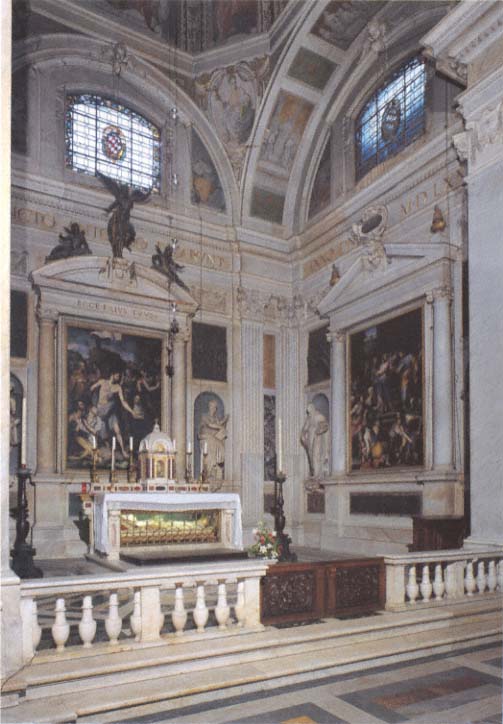
Plate 1.
Giambologna, Salviati Chapel. San Marco, Florence.

Plate 2.
Giambologna, Hope. Università, Genoa.
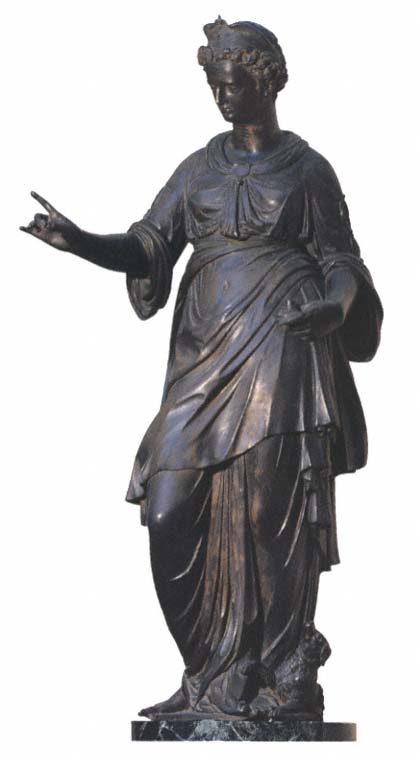
Plate 3.
Giambologna, Faith. Università, Genoa.
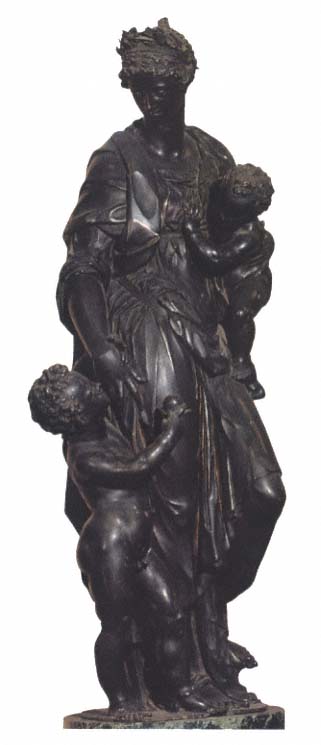
Plate 4.
Giambologna, Charity . Università, Genoa.
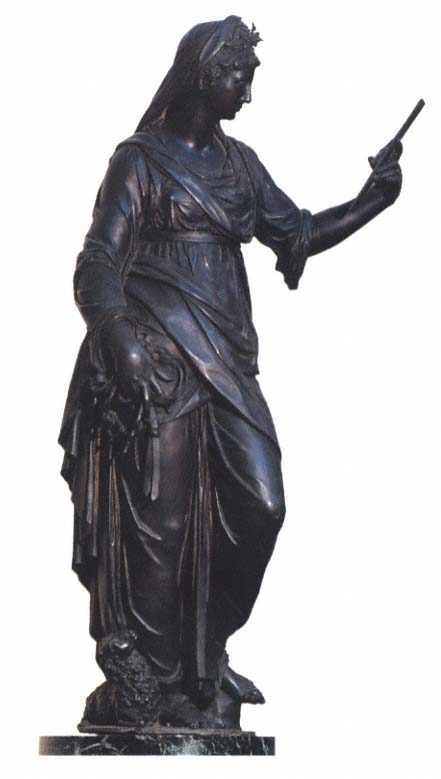
Plate 5.
Giambologna, Temperance . Università, Genoa.
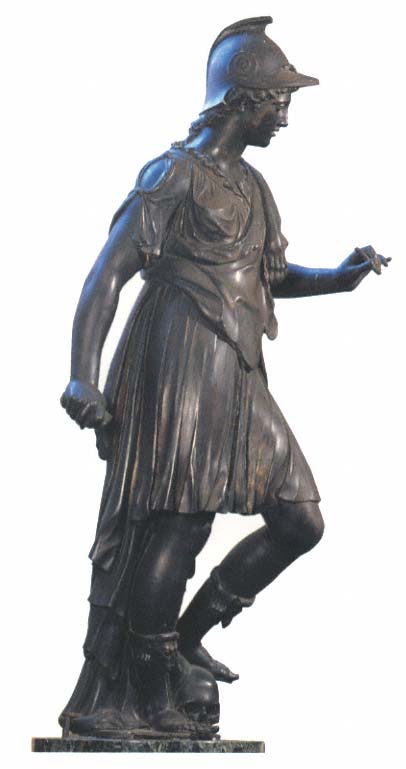
Plate 6.
Giambologna, Fortitude . Università, Genoa.
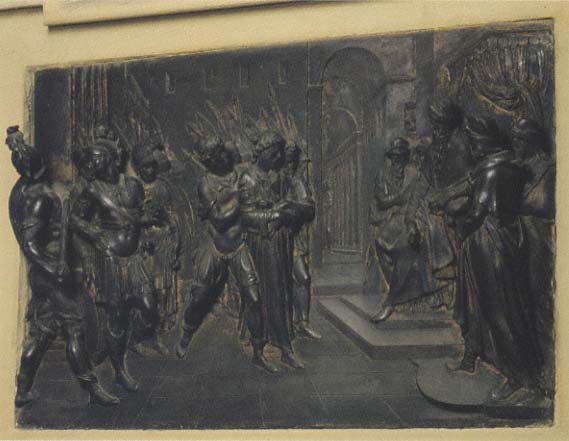
Plate 7.
Giambologna, Christ before Pilate . Università, Genoa.
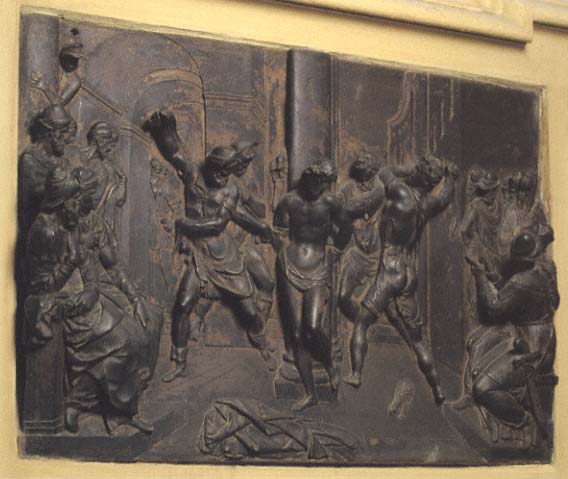
Plate 8.
Giambologna, The Flagellation . Università, Genoa.
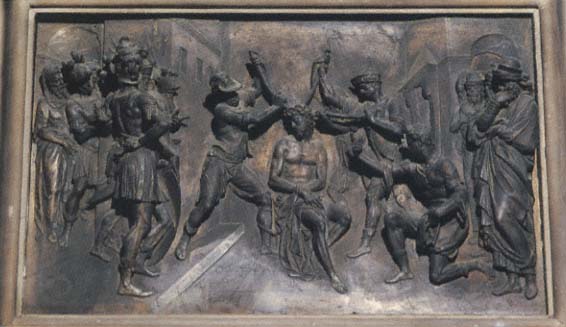
Plate 9.
Giambologna, Christ Crowned with Thorns . Università, Genoa.
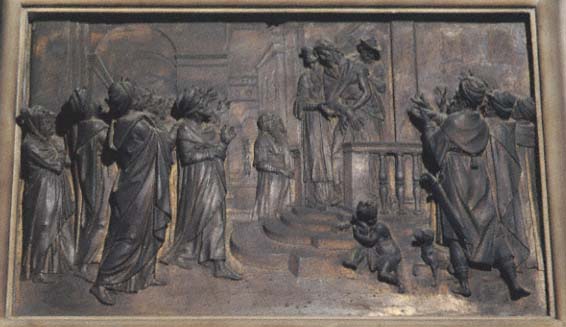
Plate 10.
Giambologna, Ecce Homo . Università, Genoa.
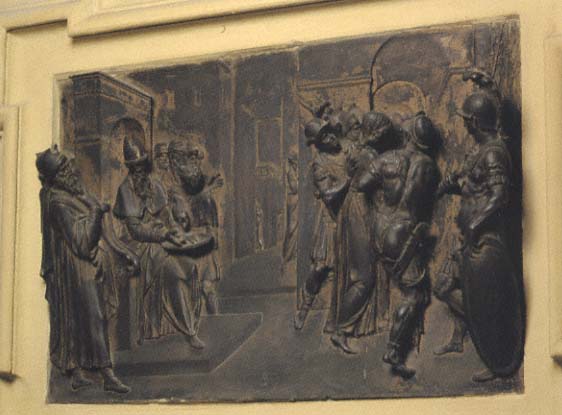
Plate 11.
Giambologna, Pilate Washing His Hands . Università, Genoa.
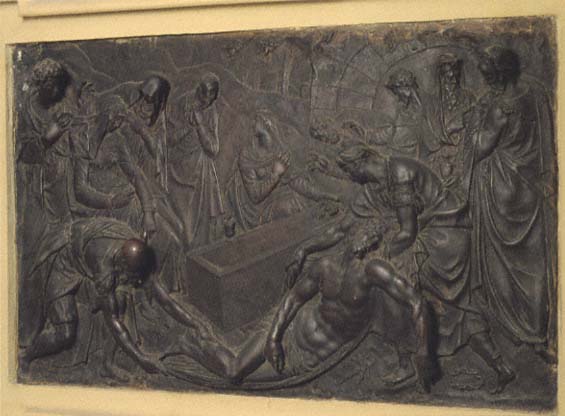
Plate 12.
Giambologna, The Entombment . Università, Genoa.
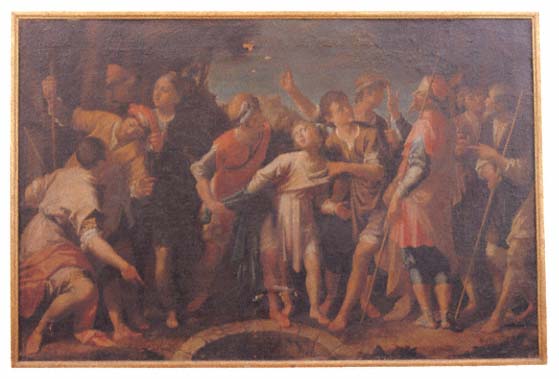
Plate 13.
Aurelio Lomi, Joseph Sold into Egypt . Convento di San Antonio, Gaggiola (La Spezia).
Index
A
Acts of Francesco I (Giambologna), 149
Acts of Pilate, apocryphal, 77 -78, 212 n48
Adoration of the Magi (Botticelli), 103
Aediculae:
in Altar of Liberty, 31 ;
in Del Monte Chapel, 36 ;
in Grimaldi Chapel, 31 , 31 , 35 , 38 , 41 , 47 ;
in later emulations of Grimaldi Chapel, 38 ;
in Salviati Chapel, 28 -29, 28-29 , 31 , 35
Aesthetic theory:
and critique of cultural-center theory, 148 ;
methodology of, 5 ;
and paragone debate, 4 , 109 , 217 n19;
and relationship of painting and sculpture, 4 , 35 -36, 43 -44, 88 , 95 , 108 , 109 , 149 , 217 n23;
subject matter distinguished from technique in, 1 , 4 ;
and virtù , 93 , 216 n9.
See also Viewers' relation to image
Alberghi , in Genoa, 6
Alberti, Leon Battista, 89 , 95 , 103
Aldobrandini tomb, 204 n8
Alessi, Galeazzo, 9 , 23 , 148 , 190 n17, 210 n41
Algardi, Alessandro, 88
Allegory of Prince Francesco de' Medici (Giambologna), 90 , 91 , 127
Altar of Liberty (Giambologna), in Lucca, 14 , 27 , 31 , 32 , 32 , 91
Altarpieces, design of, 43 -44
Altar walls:
in Grimaldi Chapel, 47 -48, 201 n37;
in Salviati Chapel, 30 , 31 , 32 , 35 , 202 n46;
in Soccorso Chapel, 46
Ambrose, Saint, 70 , 77 , 78 -79, 212 n49
Ammanati, Bartolommeo, 35 , 139
Andrea del Sarto, 60 , 95 -99, 216 n15, 219 n38
Angels. See Grimaldi Chapel, Giambologna's six angels for
Anjou family, royal tomb of, 55 , 203 n5
Annales ecclesiastici (Baronius), 76
Annas, depictions of, 133 , 134 , 211 n42
Anselm, Saint, 57
Apollo (Giambologna), 91 , 92 , 195 n12, 217 n20
Apostles' Creed, 71 , 77
Apostolic visitations, 13 , 40 , 63 , 80 , 191 n26, 201 n36
Aquinas, Thomas, 40 , 61
Architectural design:
of Del Monte Chapel, 35 -36;
of Immacolata Chapel, 198 n24;
of Lercari Chapel, 36 -37;
and paintings combined with sculptural niches, 35 -36;
of Pinelli Chapel, 198 n24;
of Senarega Chapel, 198 n24
Architectural design, by Giambologna:
and Altar of Liberty, 27 , 31 ;
and Grimaldi Chapel, 27 -28, 31 -32, 31 , 35 , 196 n16, 196 -97n17, 198 n24;
and Salviati Chapel, 27 -29, 31 -33, 35 , 35 , 196 -97n17, 198 n24;
and Soccorso Chapel, 27 , 31
Arch of Constantine, in Rome, 16
Arch of Titus, in Rome, 122 -23
Aristotle, 40 , 59
Askew, Pamela, 216 n15
Assumption of Saint John (Donatello), 126 , 127
Athelwold, Saint, 67
Augustine, Saint, 78 , 204 n9
Avery, Charles, 1 , 4 , 211 n42, 218 n26
B
Bacchus (Giambologna), 195 n12
Baldinucci, Filippo, 14 , 16 , 18 , 138
Il Bambaia. See Busti, Agostino
Banco di San Giorgio, in Genoa, 9 , 10 , 23
The Banquet of Herod (Andrea del Sarto), 97 , 98
The Baptism of Christ (Francavilla), 220 n43
Baptistery, in Florence, 115 , 118-19
Barabbas, 77 , 78
Baronius, Cesare, 76 , 77 , 79 -80, 212 n49
Bartoccio, Bartolomeo, 83 -84
Basso tomb, in Santa Maria del Popolo, 51 , 55 , 203 n7
Baths of Pozzuoli (Macchietti), 103 , 104
Baxandall, Michael, 216 n9
Bayerisches Nationalmuseum, in Munich, Giambologna's Passion cycle reliefs at, 178 -80, 186
Bellarmine, Robert, 68
Belloni, Vittorio, 194 n3
Benedetto da Maiano, 43 -44, 45
Bernini, Pietro, 18 , 19 , 88 , 149 , 204 n8, 219 n33
Bernstein, JoAnne, 206 n4
Biblia Pauperum , 48
Birago Chapel, in Milan, 64 , 206 -7n5
Bisschop, Cornelis, 202 n39
Boccanegra, Simone, 8
Boggiano, Giovanni Giorgio, 58 , 82
Book of Regensburg , 54
Bordoni, Gerolamo, 11
Borghini, Raffaello, 1 , 14 , 16 , 93 , 104 , 108 , 138 , 188 n3
Borman, Jan, the Younger, 177
Borromeo, Carlo, 66 , 69 , 70 , 74 , 175 , 208 n29;
on sacred art, 80 , 94 , 213 n58, 216 n11
Bossio, Francesco, 40 , 63 , 66 , 80 , 191 n26, 201 n36
Botticelli, Sandro, 103
Brea, Lodovico, 176
Breviarium Romanum , 69
Brilliant, Richard, 89
Bronze, aesthetic appeal of, 25 -26, 59
Bronze casting, in Guglielmo della
Porta's workshop, 18 , 138 , 193 n35
Bronzino, 61 , 104 , 107 , 109 , 217 n23
Buddhist art, 89
Burckhardt, Jakob, 187 n1
Bury, Michael, 62 , 194 n3, 197 n19, 201 n37, 202 n45
Busti, Agostino, 64
C
Caiaphas, depictions of, 75 , 210 -11n42
Caimi, Bernardino, 73 -74
Calvin, John, 68
Camaino, Tino di, 55
Cambiaso, Luca, 26 -27, 39 , 54 , 191 -92n28, 198 n23, 200 n33, 209 n30, 219 n39;
Giambologna's relations with, 88 , 133 -34, 135 ;
Giambologna's work compared with, 61 , 133 -37, 198 n24
Canavesio, Giovanni, 176
Canonical Office, 48
Cappellino, Giovanni Domenico, 198 n24
The Capture of Christ (Francavilla), 220 n43
Carracci, Annibale, 219 n33
Carroll, Margaret D., 188 n3
Castello, Bernardo, 59 , 191 -92n28
Castello, Giovanni Battista, 191 -92n28, 198 n23
Castelnuovo, Enrico, 148
Catechism of 1566, 48 , 57 , 69 , 71
Catherine, Saint, depictions of, 191 -92n28
Catholic Reformation:
and founding of Jesuit order, 54 ;
and Grimaldi Chapel, 6 , 19 , 65 , 68 , 79 , 87 , 88 , 135 , 145 ;
and narrative art, 19 , 87 , 213 n58;
and representation of virtues, 57 ;
and salvation doctrine, 53 -54;
and Salviati Chapel, 19 ;
and view of Pontius Pilate, 65 , 76 , 79 .
See also Council of Trent
Cavalori, Mirabello, 103
Cellini, Benvenuto, 4 , 93 , 108 , 109 , 127 -29, 188 n3, 217 n23
Chapel of Saint Antoninus, in Florence, (Salviati Chapel), 27
Chapel of Saint John the Baptist, in Genoa, 23 , 37 , 59
Chapel of the Holy Cross, in Genoa, (Grimaldi Chapel), 44 , 59
Charity (Giambologna), in Grimaldi Chapel, 21 , 51 -52, 60
Charity (Giambologna), in Santissima Annunziata, 58 -60
Charles V, 65 , 139 , 174
Chaucer, Geoffrey, 48
The Cheese and the Worms (Ginzburg), 215 n72
Chigi Chapel, in Rome, 197 n21
Christ at Emmaus (Santi di Tito), 143
Christ before Annas (Lucas van Leyden), 133 , 134
Christ before Caiaphas , in Corpus Domini cycle, 75
Christ before Caiaphas , in Gonfalone cycle, 75
Christ before Pilate , in Corpus Domini cycle, 71 , 75 , 134
Christ before Pilate (Giambologna), 21 , 40 , 48 , 80 , 210 -11n42;
diagonal groups in, 100 ;
other versions of, 179 , 180 , 181, 184 , 185 ;
spatial construction in, 101 -3;
tripartite compositional scheme of, 95 , 97 -98, 100 ;
vanishing area in, 127
Christ Crowned with Thorns (Giambologna), 21 , 48 , 76 , 100 , 138 ;
other versions of, 179 , 182
Christ in Limbo (Bronzino), 104 , 107
Ciboria, 70 , 175 , 208 n29
Cicero, 57
Civitale, Matteo, 23
Clark, Kenneth, 148
Clement XII, 73
Colleoni, Bartolommeo, 49 , 64
Colleoni Chapel, in Bergamo, 49 , 49 , 64 , 206 n4
Colloquy of Regensburg, 65
Column of Trajan, in Rome, 15 -16
Commissions:
of Cellini's work, 128 ;
of Danti's work, 131 ;
and Genoese engagement of nonlocal artists, 22 -23;
of Giambologna's work (see also Contract), 9 , 10 , 18 , 27 , 133 ;
of Lomi's work, 39
Como, cathedral of, 176
Confraternities, 70 , 96 , 147 , 208 n24, 214 nn63-64, 217 n16
Contarini, Gasparo, 204 n9
Contract, for Giambologna's Grimaldi Chapel work, 21 , 25 , 38 -41, 43 , 75 , 133 , 193 -94n2, 197 n17, 201 n37;
Luca Grimaldi's negotiations for, 10 , 19 , 22 -27, 84 ;
Passion cycle reliefs specified in, 21 , 38 , 41 , 43 , 48 , 63 ;
text of, 151 -55;
Virtues specified in, 21 , 38 , 48 , 63
Contract, for Giambologna's Soccorso Chapel work, 43 , 166 -73, 200 n13
Contrapposto , 60 , 61 , 124 , 127 , 217 n21
The Conversion of the Proconsul (Raphael), 96
Cope, Maurice E., 174
Cordier, Nicola, 204 n8
Corinthians, book of, 49 -50
Corpus Domini silver casket, in San Lorenzo, Genoa, 70 , 71 , 75 , 133 -34, 135 , 175 , 209 nn29-30
Corte, Niccolò da, 139
Cortesi, Lattanzio, 195 n12
Cosimo I:
and Bronzino's Innocence , 61 ;
and Cellini's Perseus Freeing Andromeda , 128 ;
colored marble favored by, 197 n20;
and Danti's Moses and the Brazen Serpent , 131 ;
and Giambologna's Equestrian Monument , 3 , 4 , 149 ;
and Pierino da Vinci's Cosimo I as Patron of Pisa , 129 , 130 , 131
Cosimo III, 149
Council of Trent:
and burial reforms, 201 n36;
and catechism of 1566, 48 , 57 , 69 ;
and Christ's Passion, 48 , 54 , 57 , 69 , 76 , 135 ;
and church renovation, 13 ;
church schism recognized by, 54 ;
and clerical reform, 65 -66;
and Colloquy of Regensburg, 65 ;
and doctrine of good works, 54 -55, 62 , 72 ;
and doctrine of justification, 50 , 55 -56, 62 , 65 , 68 , 72 ;
and doctrine of Transubstantiation, 68 ;
and narrative art, 43 , 80 , 94 , 147 , 213 n58, 216 n11;
and provincial synods, 66 ;
and Sacrament of the Eucharist, 65 , 68 -70;
and sacrament of penance, 56 ;
and standard missal, 69 ;
and synods, 66 , 80 , 94 ;
and veneration of relics, 40 , 65 ;
and virtues, 48 , 50 , 54 -57, 62 , 202 n40
Crucifix, by Giambologna, in Grimaldi Chapel, 21 , 40 -41, 63 , 194 n3
The Crucifixion , in Colleoni Chapel, 64
The Crucifixion (Francavilla), 220 n43
Crypts, 23 , 45 -46, 202 n37
Cyprian, Saint, 68
D
Dadoes:
in Grimaldi Chapel, 31 , 33 ;
in Salviati Chapel, 28-29 , 29 , 33
Danti, Vincenzo, 130 , 131
David (Bernini), 149
David, Niccolò di, 67
The Decollation of the Baptist (Andrea del Sarto), 97 , 99
Dehejia, Vidya, 89
De Hieroglyphica (Valeriano), 62
Della Porta, Gian Giacomo, 139
Della Porta, Guglielmo:
Aldobrandini tomb commissioned from, 204 n8;
Giambologna's Entombment relief influenced by, 88 , 138 -39, 141 -43;
Passion cycle of, 139 -43, 140-42 , 174 -75, 220 n47;
and relations with Giambologna, 18 , 138 -39, 221 n47;
work in Genoa by, 139 , 148 ;
workshop in Rome of, 18 , 138 , 193 n35
Del Monte Chapel, at San Pietro in Montorio, 35 -36, 36 , 54
De Pictura (Alberti), 89 , 95
The Deposition , in Colleoni Chapel, 64
The Deposition (della Porta), 139 , 140-42 , 141 -43, 221 n50
The Deposition (Francavilla), 220 n43
The Deposition (Vasari), 218 n31
Descent from the Cross (Fra Angelico), 95
De Sculptura (Pomponius Gauricus), 25
De Vries, Adriaen, 148 , 220 n43
Dhanens, Elisabeth, 199 n27, 201 n37, 211 n42
Diagonals:
in Dürer's works, 132 ;
in Giambologna's Grimaldi Chapel reliefs, 100 -101
Dio Cassius, 212 n49
Disputationes de controversiis (Bellarmine), 68
Doges, in Genoa, 6 , 8 , 9 , 21 , 22 , 23 , 58 -59, 84
Dominic, Saint, tomb of, 55 , 203 n6
Donatello, 101 , 102 , 105 , 115 , 126 , 127 , 128 , 175 , 203 n7
Doria, Andrea, 6 , 9 , 23 , 139 , 148 ;
funerary chapel of, 23 , 46 , 46
Dosio, Giovanni Antonio, 139 , 220 n47
Drama, religious, 80 -82, 213 -14nn
Du Broeucq, Jacques:
Giambologna's apprenticeship with, 14 -16, 48 , 60 , 64 , 218 n26;
Sainte-Waudru rood screen of, 14 -16, 15-16 , 48 , 49 , 60 , 64 , 207 n6, 218 n26
Duca, Jacopo del, 175 , 208 n29
Dürer, Albrecht, 75 , 131 -32, 132-33 , 177 -78, 211 n42, 219 n38
E
Ecce Homo , in Corpus Domini cycle, 134
Ecce Homo (Du Broeucq), 16 , 16
Ecce Homo (Giambologna), 21 , 48 , 114, 122 , 211 n42;
gradations of relief in, 118 -20;
other versions of, 179 , 182, 184 , 186 ;
spatial construction of, 102 ;
tripartite compositional scheme of, 100 ;
viewers' relation to image in, 106 , 112
Ecce Homo (Rembrandt), 201 n39
Eclecticism, 6 , 88 , 115
Empoli, Jacopo da, 95
Entablatures:
in Grimaldi Chapel, 31 , 33 ;
in Salviati Chapel, 28-29 , 29
The Entombment (Giambologna), 63 , 68 , 137 -43, 194 n2, 220 n43;
Guglielmo della Porta's influence on, 88 , 138 -39, 141 -43;
not specified in Grimaldi contract, 21 , 40 , 137 ;
tripartite scheme in, 138
The Entombment (Pontormo), 104 , 106
Equestrian Monument of Cosimo I (Giambologna), 4 , 5 , 149
Escorial, in Spain, 39 , 135
Ethics (Aristotle), 40
Etruscan art, 89
Eucharist, Sacrament of the, 65 , 68 -70, 72 , 147 , 208 nn23-24, 214 n64
Eusebius, 77 , 212 n49
F
Faith (Giambologna), 21 , 51 -52
Farnese, Ottavio, 195 n12, 196 nn
The Feast of Herod (Donatello), 101 , 102 , 115
Federici, Federico, 44
Female figures, in Giambologna's oeuvre, 59 -60
Fieschi, Andrea, 8
Figura serpentinata , 3 , 216 n10, 217 n21
Fiorenza (Giambologna), 195 n12
The Flagellation (Cambiaso), 135 -37, 136
The Flagellation (Cappellino), 198 n24
The Flagellation , in Colleoni Chapel, 64
The Flagellation , in Corpus Domini cycle, 71 , 134 , 135
The Flagellation (Ghiberti), 115 , 118
The Flagellation (Giambologna), 21 , 48 , 76 , 103 , 124 , 124-25 , 126 -27, 198 n24;
compared to Cambiaso's work, 136 -37;
compared to Ghiberti's work, 115 ;
other versions of, 179 , 181, 185 ;
tripartite compositional scheme of, 97 -98, 100 ;
vanishing area in, 98 , 127
Flanders:
Giambologna's early years in, 14 -16, 218 n26;
Italianate Renaissance style in, 14 -16;
rood screens in, 14 -16, 15-16 , 48 , 49 , 60 , 64 , 218 n26;
silversmiths in, 209 n30
Florence:
Giambologna's long-term residence in, 18 , 27 ;
Giambologna's workshop in, 18 , 195 n12.
See also Salviati Chapel; Soccorso Chapel
Floris, Cornelis, 218 n26
Fochs, Raniero, 209 n30
Fornari, Bartolomeo, 23 , 195 n10
Fornari, Giovanni Battista, 9
Fortitude (Giambologna), 21 , 51 , 60 , 198 -99n25
Fortitude, iconography of, 61
Fra Angelico, 95 , 103 , 105
Francavilla, Pietro, 197 n17, 198 n24, 220 n43
France:
Genoese victory against, 6 ;
and Napoleonic suppression of Franciscans, 14 ;
royal tombs in, 55
Francis, Saint, 8 , 72 -73
Francis I, 65
Franciscan order, 6 , 8 -9;
devotions of, 68 , 72 -74
Freedberg, Sydney, 216 -17n16
Frescoes:
and Andrea del Sarto's Scalzo cycle, 95 -96, 216 n15;
in Lercari Chapel, 54 ;
and Pontormo's Certosa di Galuzzo work, 178 ;
and Raphael's Vatican work, 16 , 95
Friedlaender, Walter, 88
G
Gaddi, Niccolò, 220 n47
Genealogica et Historica (Venasque), 200 n33
Genoa:
alberghi in, 6 ;
Banco di San Giorgio in, 9 , 10 , 23 ;
commerce in, 6 ;
devotion to Christ's Passion in, 147 ;
doges in, 6 , 8 , 9 , 21 , 22 , 23 , 58 -59, 84 ;
foreign aggression against, 6 , 9 ;
fortress of Castelletto in, 8 -9;
government of, 6 , 9 , 84 ;
Guelph party in, 9 ;
and negotiations for Giambologna's services, 22 -23, 155 -59;
nonlocal artists commissioned by, 22 -23, 147 -48;
Padri di Comune in, 9 , 23 ;
Palazzo del Principe in, 23 ;
Passion plays in, 81 -82;
plague of 1577 in, 10 , 58 , 190 n22;
San Pietro di Banchi in, 37 , 190 n22;
Strada Nuova in, 9 , 190 n17, 198 n23;
and struggle with papacy, 83 -84, 215 n70;
synods in, 13 , 66 , 81 -82
Ghiberti, Lorenzo, 115 -16, 118-20
Ghirlandaio, Domenico, 95 , 96
Giambologna, life of:
and appellation, 187 n1;
and apprenticeship to Du Broeucq, 14 -16, 48 , 60 , 64 , 218 n26;
and burial place in Florence, 27 , 31 ;
Genoese commission undertaken by, 9 , 10 , 18 , 22 -27, 133 , 148 , 196 n16;
and patronage given by Luca Grimaldi, 9 , 10 , 19 , 22 -27;
and patronage given by Medici family, 1 , 18 , 22 , 23 , 24 , 89 , 196 n16;
and patronage given by Bernardo Vecchietti, 18 , 188 n3;
and relations with Luca Cambiaso, 88 , 133 -34, 135 ;
and relations with Guglielmo della Porta, 18 , 138 -39, 221 n47;
and relations with Michelangelo, 18 , 138 ;
and relations with Giovan Battista Paggi, 27 ;
and residence in Florence, 18 , 27 ;
and residence in Rome, 16 , 18 , 122 , 138 -39, 197 n21;
trip to Italy undertaken by, 14 -16, 60 ;
and workshop in Florence, 18 , 89 , 195 n12
Giambologna, works of:
Acts of Francesco I , 149 ;
Allegory of Prince Francesco de' Medici, 90 , 91 , 127 ;
Altar of Liberty, 14 , 27 , 31 , 32 , 32 ;
Apollo , 91 , 92 , 195 n12, 217 n20;
Bacchus , 195 n12;
Equestrian Monument of Cosimo I ,4 , 5 , 149 ;
Fiorenza , 195 n12;
Hercules and the Centaur , 149 ;
Jerusalem panels, 149 ;
Labors of Hercules , 195 n12;
Mercury , 1 , 3 , 195 n12;
Morgante , 108 -9, 108 ;
Neptune Fountain, 91 , 91 , 187 n1;
Nessus and Deianira , 195 n12;
Oceanus Fountain, 90 , 91 ;
Rape of Europa, 90 , 91 ;
Rape of the Sabine statuette, 25 , 26 , 195 n12;
Rape of the Sabines relief, 92 , 93 , 94 ;
Rape of the Sabines statute, 1 , 2 , 3 , 4 , 92 -93, 107 , 108 ;
Saint Antoninus Reconciling the Signoria,41 , 42 , 43 ;
Saint Luke , 149 .
See also Grimaldi Chapel; Salviati Chapel; Soccorso Chapel
Gilbert, Creighton, 187 -88n2
Gilio da Fabriano (Giovanni Andrea), 19 , 216 n11
Ginzburg, Carlo, 148 , 215 n72
Giustis, and tomb of Louis XII, 55 , 204 n8
Gonfalone Oratory painting cycle, in Rome, 75 , 174 , 209 n29
Gonzaga, Don Ferrante, 70 -71
Good Friday:
and Passion plays, 81 , 214 n65;
rites in observance of, 67
Good works, doctrine of, 53 , 54 -55, 59 , 62 , 72
Gorse, George, 190 n17
Gothic architecture, of San Francesco di Castelletto, 6
Gregory of Tours, 212 n49
Gregory XIII, 65 , 83 , 140
Grimaldi, Francesco, 13 , 45 , 70 , 133 , 200 n33
Grimaldi, Luca, 9 -10, 13 ;
and ambassadorial mission to Florence, 23 , 24 , 158 -62;
coronation as doge, 21 , 40 , 58 , 84 ;
and Council of Trent, 63 , 65 , 66 ;
and Genoese struggle with papacy, 83 -84;
Giambologna contracted by, 10 , 19 , 22 -27, 84 , 148 ;
orations in praise of, 21 , 40 , 58 -59, 82 ;
personal library of, 206 n32;
and planning of Grimaldi Chapel, 63 , 65 , 147 ;
public offices held by, 82 -84;
sarcophagus of, 44 -45;
silver medal of, 57 -58, 205 n18;
statue of, 21 , 40 , 47 ;
will of, 44 , 162 -64
Grimaldi, Nicolò, 8 -10, 190 n19
Grimaldi Chapel:
Cambiaso's part in, 39 , 191 -92n28;
and Catholic Reformation, 6 , 19 , 65 , 68 , 79 , 87 , 88 , 135 , 145 ;
destruction of, 6 , 14 , 21 ;
Giambologna's (lost) crucifix in, 21 , 40 -41, 63 , 194 n3;
Luca Grimaldi's (lost) statute in, 21 , 40 , 47 ;
Luca Grimaldi's role in planning of, 63 , 65 ;
Lomi's paintings in, 21 , 22 , 39 , 46 , 63 , 68 , 75 , 191 -92n28, 194 n3, 199 n25;
masses celebrated in, 67 -68, 70 ;
Ratti's description of, 40 , 191 -92n28, 210 n42;
relics in, 23 , 40 , 66 -68, 147 , 165 , 200 n34, 201 n37;
sarcophagi in, 44 -47, 201 n36, 202 n37;
Soprani's description of, 14 , 38 -40, 191 -92n28, 194 nn2-3, 198 -99n25, 210 n42;
University of Genoa holdings from, 6 , 14 , 21 , 194 n3
Grimaldi Chapel, architectural design of:
aediculae in, 31 , 31 , 35 , 38 , 41 , 47 ;
altar wall in, 47 -48, 201 n37;
compared to Altar of Liberty, 32 ;
compared to Del Monte Chapel, 35 -36;
compared to Lercari Chapel, 36 -37, 47 -48;
compared to Salviati Chapel, 27 -28, 31 -32, 35 , 41 , 43 , 197 n19;
compared to Soccorso Chapel, 27 , 41 , 43 , 46 -47;
Giambologna's contribution to, 27 -28, 31 -32, 31 , 35 , 196 n16, 196 -97n17, 198 n24;
hypothetical reconstruction of, 21 , 22 , 24-25 , 28 , 35 , 40 -41, 43 -52, 193 n1;
island altar in, 47 -48, 201 n37;
later emulations of, 37 -38, 197 n19;
niches in, 35 , 38 , 39 , 47 , 51 , 54 ;
pediments in, 31 -32, 35 , 38 , 47
Grimaldi Chapel, Giambologna's freestanding Virtues in, 6 , 23 , 32 -33;
and change from Prudence to Temperance, 40 , 199 n27;
compared to Cambiaso's work, 61 ;
contract specifications for, 21 , 38 , 48 , 63 ;
and Council of Trent decrees, 54 , 55 , 57 , 62 ;
and doctrine of good works, 53 , 59 , 62 ;
figural aspects of, 59 -61;
iconography of, 61 -62;
interactive viewing of, 44 ;
and Mass of Good Friday, 68 ;
metallic composition of, 196 n13;
postures of, 51 , 60 -61;
Ratti's description of, 40 ;
reconstructed placement of, 24-25 , 41 , 43 , 48 , 51 -52, 202 n45;
related to Passion cycle, 48 , 54 , 57 , 62 ;
Soprani's description of, 38 -40, 191 -92n28,
198 -99n25;
sources of, 62 ;
University of Genoa holdings of, 21
Grimaldi Chapel, Giambologna's Passion cycle reliefs for:
artistic legacy of, 148 -49;
compared to Andrea's Scalzo frescoes, 95 -99, 216 n15;
compared to Birago Chapel cycle, 64 ;
compared to Cambiaso's works, 133 -37, 198 n24;
compared to Flemish art, 218 n26;
compared to Salviati Chapel reliefs, 41 , 43 , 92 ;
compared to Soccorso Chapel reliefs, 41 , 43 , 179 , 180 ;
compositional technique of, 88 , 94 -101;
contract specifications for, 21 , 38 , 41 , 43 , 48 , 63 ;
and Council of Trent decrees, 54 , 57 , 94 ;
diagonals in, 100 -101;
distinguished from maniera style, 88 , 104 -5, 127 , 128 , 131 , 143 -45;
and doctrine of salvation, 62 , 87 , 88 , 89 ;
and Franciscan devotions, 68 , 72 , 74 ;
and Genoese struggle against papacy, 84 ;
Ghiberti's influence on, 115 -16;
gradations of relief in, 118 -20, 122 ;
historico-political emphasis of, 74 -76, 77 , 84 , 89 , 93 ;
interactive viewing of, 19 , 44 , 94 ;
and Mass of Good Friday, 68 ;
metallic composition of, 196 n13;
multiple-view technique in, 19 , 88 , 93 , 94 , 106 -12, 115 -16, 118 , 124 , 126 -27, 148 , 149 ;
narrative structure of, 4 -5, 48 , 80 -81, 88 -89, 116 , 131 , 149 ;
orthogonals in, 110 , 111 , 127 ;
and Passion plays, 80 -82;
and prints by northern artists, 131 -33;
Ratti's description of, 40 , 191 -92n28, 210 n42;
reconstructed placement of, 41 , 43 , 48 , 202 n45;
related to Virtues, 48 , 54 , 57 , 62 ;
scholarly accounts of, 4 -6, 192 n28;
sequence of, 48 , 116 , 202 n45;
Soprani's description of, 39 , 40 , 198 -99n25, 210 n42;
spatial construction in, 88 , 101 -3, 132 -33, 137 ;
tripartite scheme in, 95 - 100 ;
University of Genoa holdings of, 21 ;
vanishing areas in, 98 , 110 , 127 ;
viewers' relation to image in, 43 , 88 , 103 -12, 115 -16, 118 , 124 , 126 -27, 145 ;
wax models of, 179 , 180 , 184-85
Grimaldi Chapel, Giambologna's six angels for, 6 , 10-11 ;
contract specifications for, 21 , 38 ;
metallic composition of, 196 n13;
postures of, 31 -32, 198 n24;
reconstructed placement of, 31 -32;
Soprani's description of, 191 -92n28, 199 n25;
University of Genoa holdings of, 21
Grisaille technique, 216 -17n16
Guelph party, 9
H
Hapsburgs, Spanish, 6
Hedicke, Robert, 64 , 207 n6
Hegesippus, 212 n49
Henry II, 204 n8
Hercules and the Centaur (Giambologna), 149
Heresy, religious, 83
Hildegard of Bingen, Saint, 48
Historia Naturalis (Pliny), 25
Holderbaum, James, 109 , 187 n1, 199 n27, 217 nn, 220 n43
Hood, William, 210 n40
Hope (Giambologna), 21 , 51 -52, 60
Humanism, and rhetoric, 58
I
Ignatius of Loyola, 54
Immacolata Chapel, in Genoa, 37 , 198 n24
Inchiesta (Varchi), 4 , 108 , 109
Indulgences, 189 n10
Innocence (Bronzino), 61
Innocent III, 214 n64
Innocent IV, 8
Innocent VIII, 55 , 203 n7
Inquisition, office of, 83 , 84
Isaac, depictions of, and Lomi's Sacrifice of Isaac , 21 , 40 , 41 , 46 , 63 , 68 , 75 , 191 -92n28, 194 n3
Island altars:
in Grimaldi Chapel, 47 -48, 201 n37;
in Salviati Chapel, 201 n37
J
Jacob and Esau (Ghiberti), 116 , 120
Jerome, Saint, depictions of, 191 -92n28
Jerusalem:
Francavilla's work for, 220 n43;
holy sites in, 73 -74
Jesuits, and Catholic Reformation, 54
John, book of, 48 , 67 , 77 , 81 , 211 n42, 214 n65
John of Caulibus, 210 n36
John the Baptist, depictions of, 96
John XXIII, 203 n7
Joseph of Arimathea, depictions of, 141 -43
Joseph Sold into Egypt (Lomi), 21 , 22 , 40 , 41 , 46 , 63 , 68 , 75 , 191 -92n28, 194 n3
Josephus, 78 , 212 n49, 213 n54
Justice (Giambologna), 7 , 21 , 51 , 60 , 61 , 198 -99n25
Justice, iconography of, 61
Justification, doctrine of, 50 , 55 -56, 62 , 65 , 68 , 72 , 147 , 204 n9
Justin Martyr, Saint, 77
K
Kenseth, Joy, 217 n19
L
Labors of Hercules (Giambologna), 195 n12
Laocoön , 16 , 17
Last Supper (Cambiaso), 13 , 133 , 137 , 137 , 200 n33
Lateran Council, Fourth, 56 , 214 n64
Lavin, Marilyn Aronberg, 216 n16
Lawrence of Porto Maurizio, 73
Lercari, Franco, 198 n23
Lercari Chapel, in San Lorenzo in Genoa, 36 -37, 38 , 47 -48, 59 , 61
Levati, Luigi, 21 , 195 n9
Leyden, Lucas van, 131 , 177 , 219 n38
Liber Scivias (Hildegard of Bingen), 48
Literary criticism, methodology of, 5
Lombardo, Tullio, 204 n7
Lomi, Aurelio, 39 , 199 n25;
Joseph Sold into Egypt by, 21 , 22 , 40 , 41 , 46 , 63 , 68 , 75 , 191 -92n28, 194 n3;
The Sacrifice of Isaac by, 21 , 40 , 41 , 46 , 63 , 68 , 75 , 191 -92n28, 194 n3
Louis XII, tomb of, 55
Loyola. See Ignatius of Loyola
Lucian, 212 n49
Luini, Bernardino, 174
Luke, book of, 77 , 78 , 212 n51
Luther, Martin, 53 , 65 , 68 , 204 n9
M
Macchietti, Girolamo, 103 , 104
Macchioni, Silvana, 194 n3, 196 nn, 202 n45, 211 n42
Madonna and Saints (Fra Angelico), 103 , 105
Maiano, Benedetto da, 95 , 96
Maniera , 1 , 88 , 104 -5, 127 , 128 , 131 , 143 , 218 n31
Marcenaro, Caterina, 209 n30
Margaret of Brabant (queen of Luxembourg), 8 , 53 , 203 n5
Martines, Baldassare, 209 n30
Martyrdom of Saint Vincent (de Vries), 148
Masaccio, 95
Mass, Catholic, 65 , 67 , 68 , 69
Matthew, book of, 202 n38, 211 n42
Maximilian II, 18
Medici, Catherine de', 204 n8
Medici, Cosimo de', 3 , 18 , 61 , 128 , 129 , 131 , 140 , 197 n20
Medici, Ferdinando de', 18 , 43 , 89 , 200 nn31-32
Medici, Francesco de', 18 , 60 , 93 , 216 n9;
Giambologna's allegorical relief of, 90 , 91 , 127 ;
and negotiations for Giambologna's services, 22 , 23 , 24 , 27 , 155 -62, 196 n16
Medici, Lorenzo de', 216 n9
Meditation, religious:
and Christ's Passion, 73 ;
and virtues, 53 , 61
Meditations on the Life of Christ , 73 , 74 , 210 n36
Melone, Altobello, 176
Memorie e Sepolcri (Pasqua), 45 , 200 n33
Mendelsohn, Leatrice, 216 n9, 217 n23
Mercury (Giambologna), 1 , 3 , 195 n12
Michelangelo:
Giambologna influenced by, 16 , 60 ;
Giambologna's encounter with, 18 , 138 ;
and Varchi's Inchiesta , 109 ;
Vatican frescoes of, 16
Michelozzo, 203 n7
Middle Ages, doctrine of virtues in, 48 , 53 , 54 , 55 , 57 , 61
Miracle of the Spini Child (Ghirlandaio), 95 , 96
Missal, standard, 69
Molanus, Johannes, 216 n11
Monaco, cathedral of, 176
Mone, Jean, 55 , 204 n8
Mons, Sainte-Waudru rood screen in, 14 -16, 15-16 , 48 , 49 , 60 , 64 , 207 n6, 218 n26
Montorsoli, Giovanni, 23 , 59 , 148
Morgante (Bronzino), 109 , 217 n23
Morgante (Giambologna), 108 -9, 108
Morrogh, Andrew, 27 , 196 n17
Moses and the Brazen Serpent (Danti), 130 , 131
Multiple-view technique:
and Giambologna's Apollo , 217 n20;
and Giambologna's Grimaldi Chapel reliefs, 19 , 88 , 93 , 94 , 106 -12, 115 -16, 118 , 124 , 126 -27, 148 , 149 ;
and Giambologna's Morgante , 108 -9;
and Giambologna's Rape of the Sabines , 3 -4, 93 , 107
Mystery plays, 80 -82, 213 -14nn
N
Nagler, Alois M., 214 n64
Napoleonic conquest, 14
Narrative art:
and Catholic Reformation, 19 , 87 , 213 n58;
and Council of Trent, 43 , 80 , 94 , 147 , 216 n11;
and doctrine of salvation, 87 , 88 ;
and Giambologna's Equestrian Monument of Cosimo I , 4 ;
and Giambologna's Grimaldi Chapel reliefs, 4 -5, 48 , 80 -81, 88 -89, 116 , 131 , 147 , 149 ;
and Giambologna's Rape of the Sabines , 93 ;
and Giambologna's Salviati Chapel reliefs, 4 , 41 , 42 , 43 , 92 ;
and histori-
Narrataive art (continued )
cal accuracy, 80 ;
maniera style of, 128 -29, 131 ;
scholarly study of, 5 -6;
and viewers' relation to images, 3 , 19 , 44 , 218 n25;
Hayden White's analysis of, 87
Nativity, Christ's, depictions of, 191 -92n28, 196 n15
Negrone, Giulio, 21 , 24 , 58 -59, 61 , 195 n11, 206 n31
Neptune Fountain (Giambologna), in Bologna, 91 , 91 , 187 n1
Nessus and Deianira (Giambologna), 195 n12
Netherlands, 201 n39
Niches:
in Chapel of San Luca, 36 , 37 ;
in Del Monte Chapel, 36 ;
in Grimaldi Chapel, 35 , 38 , 39 , 47 , 51 , 54 ;
in later emulations of Grimaldi Chapel, 38 ;
in Lercari Chapel, 36 , 38 ;
in Salviati Chapel, 28-29 , 29 , 31 , 35 , 54 ;
in Soccorso Chapel, 31
Nicodemus, depictions of, 141 -43
Nobility, old, in Genoa:
and Republican government, 6 ;
and San Francesco di Castelletto, 9 , 10 , 13 , 70 ;
Strada Nuova dwellings of, 9 , 198 n23
O
Oceanus Fountain (Giambologna), in Florence, 90 , 91
Opluten, Tomaso, 209 n30
Orations, at Luca Grimaldi's coronation, 21 , 40 , 58 -59, 82
Orcagna, Andrea, 199 n27
Orthogonals, in Giambologna's Grimaldi Chapel reliefs, 110 , 111 , 127
Orvieto Passion cycle, 209 n29
P
Padri di Comune, in Genoa, 9 , 23
Paggi, Giovan Battista, 27
Painted crosses, Tuscan, 176
Painting, in relation to sculpture, 4 , 35 -36, 43 -44, 88 , 95 , 108 , 109 , 149 , 217 n23
Palazzo del Principe, in Genoa, 23
Paleotti, Gabriele, 19 , 57 , 66 , 80 , 94 , 213 n58, 216 n11
Palladio, Andrea, 27 , 196 -97n17
Pallavicino, Cipriano, 80
Panigarola, Francesco, 74 , 208 n29, 212 n43
Panofsky, Erwin, 199 n27
Paragone debate, 4 , 109 , 217 n19
Parson's Tale (Chaucer), 48
Pasqua, Giulio, 45 , 200 n33
Passion, Christ's:
in catechism of 1566, 48 , 57 , 69 ;
and Council of Trent, 48 , 54 , 57 , 69 , 76 , 135 ;
and devotion to stations of the cross, 73 -74;
and doctrine of justification, 72 ;
and Franciscan devotions, 72 -74;
in Gospel of John, 48 , 67 , 81 , 214 n65;
historical veracity of, 71 -72, 76 -77, 80 ;
linked to virtues, 48 -49, 53 , 54 , 57 , 63 -64, 201 n39;
and Mass of Good Friday, 67 ;
Panigarola's treatise on, 74 , 208 n29, 212 n43;
and physical suffering of Christ, 72 -73;
relics of, 23 , 40 , 66 -68, 165 ;
and religious drama, 80 -82, 213 -14nn;
and Sacrament of the Eucharist, 68 , 70
Passion, Christ's, depictions of:
at Birago Chapel, 64 , 206 n5;
and Brea's works, 176 ;
and Cambiaso's works, 133 -37, 198 n24;
and Canavesio's works, 176 ;
at Colleoni Chapel, 49 , 49 , 64 ;
and Corpus
Domini silver casket, 70 , 71 , 75 , 133 -34, 135 , 175 , 209 nn28-30;
and del Duca's ciborium, 175 ;
and della Porta's works, 139 -43, 174 -75;
and Du Broeucq's Sainte-Waudru rood screen, 15 -16, 64 ;
and Dürer's works, 75 , 132 -33, 177 -78, 211 n42;
and Giambologna's Soccorso Chapel reliefs, 43 , 44 , 179 -80, 181-83 ;
and Gonfalone Oratory painting cycle, 75 , 174 , 209 n29;
and Luini's works, 174 ;
and Orvieto cycle, 209 n29;
and Callisto Piazza's works, 175 -76;
and Pontormo's fresco, 178 ;
and prints by northern artists, 131 -33, 177 -78;
and Rodari's works, 176 ;
and Romanino's works, 176 ;
and Santa Croce cycle, 209 n29;
and Stradano's drawings, 211 n42;
and Tintoretto's works, 174 ;
and Tuscan painted crosses, 176 ;
and van Leyden's works, 133 , 134 , 177 ;
and wooden retables by northern artists, 177 .
See also Grimaldi Chapel, Giambologna's Passion cycle reliefs for
The Passover Plot (Schonfeld), 206 n2
Patronage, of Giambologna:
by Luca Grimaldi, 9 , 10 , 19 , 22 -27;
by Medici family, 1 , 18 , 22 , 23 , 24 , 89 , 196 n16;
by Bernardo Vecchietti, 18 , 188 n3
Paul III, 54 , 65 , 138 , 204 n8
Paul V, 144
Pediments:
in Del Monte Chapel, 36 ;
in Grimaldi Chapel, 31 -32, 35 , 38 , 47 ;
in later emulations of Grimaldi Chapel, 38 ;
in Salviati Chapel, 29 , 31 , 32 , 35
Penance, sacrament of, 56 , 147
Pentecost , in Santa Croce cycle, 209 n29
Perino del Vaga, 9 , 23 , 139 , 148 , 191 -92n28
Perseus (Cellini), 93 , 188 n3
Perseus Freeing Andromeda (Cellini), 128 -29, 129
Perugia, Passion plays in, 81
Peter Martyr, Saint, tomb of, 203 n6
Philip II, 10 , 135
Philo, 78 , 212 n49, 213 n54
Piazza, Callisto, 175 -76
Pierino da Vinci, 129 , 130 , 131
Pilasters:
in Grimaldi Chapel, 31 , 33 ;
in Salviati Chapel, 28-29 , 29
Pilate Washing His Hands (Bisschop), 201 n39
Pilate Washing His Hands (Dürer), 132 , 132-33
Pilate Washing His Hands (Ghiberti), 118 , 119
Pilate Washing His Hands (Giambologna), 21 , 48 , 100 , 110, 112 -13 , 127 , 211 n42;
multiple-view technique in, 106 , 110 -12, 124 ;
other versions of, 179 , 180 , 183, 185 ;
spatial construction in, 102 -3, 149
Pilon, Germain, 204 n8
Pinelli Chapel, in Genoa, 37 , 39 , 197 n19
Piombo, Sebastiano del, 219 n42
Pisa, Francavilla's relief panels in, 220 n43
Pisano, Giovanni, 8 , 53 , 203 n5
Pius IV, 139
Pius V, 57 , 69 , 83
Plague of 1577, in Genoa, 10 , 58 , 190 n22
Pliny, 25 , 212 n49
Plutarch, 212 n49
Pollaiuolo, Antonio, 50 , 55 , 203 n7
Pomponius Gauricus, 25
Pontius Pilate, in church doctrine, 65 , 76 -79, 80
Pontius Pilate, depictions of:
and Bisschop's works, 202 n39;
and Du Broeucq's Ecce Homo , 16 , 16 ;
and Dürer's works, 132 , 132-33 , 211 n42;
and English Passion plays, 213 n54;
and Ghiberti's works, 118 , 119 ;
and Giambologna's Grimaldi Chapel reliefs, 21 , 40 , 48 , 75 -76, 77 , 80 -81, 82 , 84 , 100 -103, 110 -12, 124 , 211 n42
Pontormo, Jacopo da, 104 , 106 , 178 , 219 n38
Pope-Hennessy, John, 4 , 211 n42, 218 n26
Pordenone, 176
Praxiteles, 115
Primaticcio, Francesco, 204 n8
Prints, Christ's Passion depicted in, 131 -33
Procaccini, Camillo, 191 -92n28
Procession of Spoils of Jerusalem , Arch of Titus, 123 , 123
Prodi, Paolo, 213 n58
Protestantism, 53 , 55 , 66 , 68 , 72 , 83 , 201 n39
Prudence (Cambiaso), 54 , 61 , 198 n23
Prudence (Giambologna), 60
Prudence, iconography of, 199 n27
Prudentius, 61
The Punishment of Dirke,15 , 16
Putti. See Grimaldi Chapel, Giambologna's six angels for
Q
Queensland Art Gallery, in Brisbane, Giambologna's work at, 179 , 185
R
Radcliffe, Anthony, 211 n42
The Raising of the Cross (Francavilla), 220 n43
Rape of Europa (Giambologna), 90 , 91
Rape of the Sabine statuette (Giambologna), 25 , 26 , 195 n12
Rape of the Sabines (Giambologna), 1 , 2 , 3 , 4 , 92 -93, 107 , 108 ;
relief of, 92 , 93 , 94
Raphael:
Chigi Chapel designed by, 197 n21;
and Giambologna, 16 , 60 ;
School of Athens by, 95 ;
tapestry designs of, 95 ;
Vatican frescoes of, 16 , 95
Ratti, Carlo Giuseppe, 191 -92n28, 194 nn2-3, 210 n42
Reformation:
and doctrine of justification, 55 ;
and doctrine of salvation, 53 -54.
See also Catholic Reformation
Regularis Concordia (Athelwold), 67
Relics, 45 ;
in Doria chapel, 23 ;
in Grimaldi Chapel, 23 , 40 , 66 -68, 147 , 165 , 200 n34, 201 n37;
veneration of, 40 , 65 , 66 , 207 n8
Rembrandt, 202 n39
Replicas, of Giambologna's works, 1 , 43 , 89
Republican government, in Genoa, 6 , 58 , 59
The Resurrection , in Colleoni Chapel, 64
The Resurrection (Francavilla), 220 n43
The Resurrection of Lazarus (Santi di Tito), 143 , 144
Retables, depicting Christ's Passion, 177
Rhetoric, 58 , 93 , 104 , 216 n10
Il riposo (Borghini), 1 , 108 , 188 n3
Rizzo, Antonio, 204 n7
Rochi, Francesco de, 209 n30
Rodari, Tomaso, 176
Rollinger, Wilhelm, 214 n64
Romanino, 176
Romano, Giulio, 148
Rome:
Arch of Constantine in, 16 ;
Arch of Titus in, 122 -23;
Column of Trajan in, 15 -16;
Giambologna's residence in, 15 , 16 , 18 , 122 , 138 -39, 197 n21;
Santa Maria del Popolo in, 16 , 50 , 51 , 197 n21
Rood screens, in Flanders, 14 -16, 15 -16, 48 , 49 , 60 , 64 , 218 n26
Rudolf II, 19
S
The Sacrifice of Isaac (Lomi), 21 , 40 , 41 , 46 , 63 , 68 , 75 , 191 -92n28, 194 n3
Sacri monti , scholarly study of, 210 n40
Sacro Monte, in Lombardy, 74 , 210 nn40-41
Saint Antoninus Reconciling the Signoria (Giambologna), 41 , 42 , 43
Sainte-Waudru rood screen, in Mons (Du Broeucq), 14 -16, 15 -16, 48 , 49 , 60 , 64 , 207 n6, 218 n26
Saint Luke (Giambologna), 149
Saint Stephen Suffering His Martyrdom (Tacca), 148
Salmeron, Alphonsus, 69
Salvation, doctrine of, 53 , 56 , 62 , 84 -85;
and Giambologna's Grimaldi Chapel reliefs, 87 , 88 , 89
Salviati Chapel, in Florence, Giambologna's works in, 19 , 25 , 28 -30 ;
altar wall in, 30 , 31 , 32 , 35 , 202 n46;
architectural design of, 27 -29, 31 -33, 35 , 35 , 196 -97n17, 198 n24;
compared to Altar of Liberty, 31 ;
compared to Grimaldi Chapel, 27 -28, 31 -32, 35 , 41 , 43 , 92 , 147 , 197 n19;
compared to Pinelli Chapel, 198 n24;
compared to Senarega Chapel, 198 n24;
compared to Soccorso Chapel, 31 ;
crypt in, 45 ;
island altar in, 201 n37;
narrative reliefs in, 4 , 41 , 42 , 43 , 92 ;
niches in, 28-29 , 29 , 31 , 35 , 54
San Cassiano, in Venice, 174
San Domenico Maggiore, in Bologna, 55
San Francesco di Castelletto, in Genoa:
Bernardo Castello's work in, 191 -92n28;
Giovanni Battista Castello's work in, 191 -92n28;
demolition of, 14 ;
elite burials in, 8 ;
eucharistic revival in, 70 ;
Franciscan order at, 6 , 8 -9, 72 ;
Gothic architecture of, 6 ;
Grimaldi family as patrons of, 9 , 10 , 13 , 59 , 67 , 190 nn;
Grimaldi family's burial places in, 44 -45;
ground plan of, 13 ;
inspected by church authorities, 80 , 191 n26;
Margaret of Brabant's tomb in, 8 , 53 , 203 n5;
military attacks on, 8 -9;
Napoleonic expropriation of, 14 ;
old nobility's relations with, 9 , 10 , 13 , 70 ;
Perino del Vaga's work in, 191 -92n28;
Procaccini's work in, 191 -92n28;
Ratti's description of, 191 -92n28;
relics donated to, 67 ;
renovation of, 9 , 10 , 13 -14, 22 , 191 n26;
Sarzana's work in, 191 -92n28;
Semino's work in, 191 -92n28;
Spinola's work in, 191 -92n28;
Torre's work in, 192 n28.
See also Grimaldi Chapel
San Giorgio al Palazzo, in Milan, 174
San Lorenzo cathedral, in Genoa, 36 , 38 , 105 , 126 , 133 , 175
San Luca, Chapel of, in Florence, 36 , 37
San Marco church, in Florence, 25 , 27 , 28-30 , 103
San Matteo, in Genoa, 23 , 46 , 59 , 196 n16
San Pietro di Banchi, in Genoa, 37 , 190 n22
Sansedoni Palace, in Siena, 149
San Siro church, in Genoa, 37 , 39
Sansovino, Andrea, 16 , 23 , 43 , 50 , 51 , 55 , 60 , 203 n7
Sansovino, Jacopo, 60
Santa Croce, in Florence, 95 , 209 n29
Santa Maria Assunta, in Carignano, 23
Santa Maria degli Angeli, in Rome, 175
Santa Maria del Popolo, in Rome, 16 , 50 , 51 , 197 n21
Santi di Tito, 95 , 143 -44, 144
Santissima Annunziata, in Florence, 200 n32. See also Soccorso Chapel
Sarcophagi:
in Colleoni Chapel, 64 , 206 n4;
in Doria Chapel, 46 ;
in Grimaldi Chapel, 44 -47, 201 n36, 202 n37;
in Lercari Chapel, 36 , 54 ;
in Santa Maria del Popolo, 51
Sarzana, 191 -92n28
Sassetti Chapel, in Santa Trinità, Florence, 95
Scaglia, Davide, 209 n30
Scalzo frescoes, of Andrea del Sarto, 95 -96, 216 n15
Schiacciato , 119
Schonfeld, Hugh J., 206 n2
Schongauer, Martin, 131 , 177
School of Athens (Raphael), 95
Scrutinio della Nobilità (Federici), 44
Sculpture, in relation to painting, 4 , 35 -36, 43 -44, 88 , 95 , 108 , 109 , 149 , 217 n23
Semino, Andrea, 191 -92n28
Semiotics, 5
Senarega, Giovanni Antonio, 201 n36
Senarega Chapel, in Genoa, 37 , 198 n24, 201 n36
Seripando, Girolamo, 204 n9
Serra Chapel, in Genoa, 37 , 197 n19
Sforza tomb, in Santa Maria del Popolo, 50 , 51 , 55 , 203 n7
Shell, Janice, 207 n5
Sixtus IV, tomb of, 50 , 55 , 144 , 203 n7
Smyth, Craig Hugh, 218 n31
Soccorso Chapel (Giambologna's burial chapel), in Florence, 27 , 31 , 33 -34 , 41 , 46 -47, 47 , 89 , 194 n3, 196 n15, 200 n32;
contract for, 43 , 166 -73, 200 n13;
Passion cycle reliefs in, 43 , 44 , 178 -80, 181-83
Socles:
in Grimaldi Chapel, 31 ;
in Salviati Chapel, 28-29 , 29
Soldani Benzi, Massimiliano, 149
Soprani, Raffaello, Grimaldi Chapel described by, 14 , 38 -40, 191 n28, 194 nn2-3, 198 -99n25, 210 n42
Spain:
Escorial in, 39 ;
Hapsburgs in, 6
Spatial construction:
in Bernini's works, 149 ;
in Cambiaso's works, 137 ;
in Giambologna's Grimaldi Chapel reliefs, 88 , 101 -3, 132 -33, 137 , 149
Spinola, Andrea, 191 -92n28
The Spiritual Exercises (Ignatius of Loyola), 54
Stations of the cross, devotion to, 73 -74
Strabo, 212 n49
Stradano, Giovanni, 211 n42
Strada Nuova, in Genoa, 9 , 190 n17, 198 n23
Structuralism, 5
Suetonius, 212 n49
Summers, John David, 216 n10
Synods, 13 , 66 , 80 , 81 -82, 94
T
Tacca, Ferdinando, 148
Tacitus, 77 , 212 n49
Taney, C. Mary, 210 n36
Temperance, iconography of, 199 n27
Temperance (Giambologna), 21 , 40 , 51 -52, 60 -61, 198 -99n25
Tertullian, 212 n49
The Three Marys at the Tomb (Donatello), 127 , 128
Tibaldi, Pellegrino, 210 n41
Tintoretto, 174
Tombs:
church authorities' rules for, 201 n36;
papal, 50 , 55 , 144 , 203 n7;
virtues depicted on, 50 -51, 50 , 53 , 54 -55, 203 -4nn
Torre, Giovannandrea, 192 n28
Transubstantiation, doctrine of, 68 -69, 72 , 214 n64
Tribolo Fountain, at Villa Castello, 195 n12
Tribute Money (Masaccio), 95
Tripartite compositional technique, 94 -100
Tron, Nicolo, tomb of, 203 -4n7
Tuttle, Richard, 187 n1
U
University of Genoa, Giambologna's Grimaldi Chapel bronzes at, 6 , 14 , 21 , 194 n3
Urban VIII, 204 n8
V
Valeriano, Pierio, 62
Vanishing areas, in Giambologna's Grimaldi Chapel reliefs, 98 , 110 , 127
Varchi, Benedetto, 4 , 108 , 109
Varni, Santo, 209 n30, 211 n42
Vasari, Giorgio, 14 , 16 , 35 , 104 , 108 , 138 -39, 197 n20, 207 n5;
maniera style of, 143 , 218 n31
Vatican frescoes, 16 , 95
Vecchietti, Bernardo, 18 , 188 n3
Venasque, Carolo de, 200 n33
Vendramin tomb, 203 -4n7
Venice, and break with papacy, 83
Via Crucis , in Jerusalem, 72 , 73
Vices, 53 , 61
Victoria and Albert Museum, in London, Giambologna's work at, 179 , 184-85
Vidal, Jaime R., 210 n36
Vienna, Passion plays in, 214 n64
Viewers' relation to image, 3 -4, 19 , 43 , 44 , 218 n25;
Alberti's prescription for, 103 ;
in Giambologna's Grimaldi Chapel reliefs, 43 , 88 , 103 -12, 115 -16, 118 , 124 , 126 -27, 145 .
See also Multiple-view technique
Violence, representation of, in Giambologna's Rape of the Sabines , 3
Virgin Mary, depictions of, 54 , 103 , 105 , 191 -92n28
Virtù , 93 , 216 n9
Virtues:
Aquinas on, 40 ;
and Aristole's Ethics , 40 ;
in Birago Chapel, 207 n5;
in Colleoni Chapel, 49 , 49 , 64 , 206 n4;
Council of Trent on, 48 , 50 , 54 -57, 62 , 202 n40;
in Del Monte Chapel, 36 , 54 ;
and doctrine of good works, 53 , 54 -55, 59 , 62 ;
and doctrine of justification, 50 , 55 -56, 62 ;
and Du
Broeucq's Sainte-Waudru rood screen, 15 , 48 , 49 , 60 , 64 ;
and Grimaldi coat of arms, 40 ;
hierarchy of, 48 -51;
humanist rhetoric of, 58 -59, 206 n31;
iconography of, 61 -62, 199 n27;
in Lercari Chapel, 36 -37, 47 -48, 54 ;
medieval doctrine of, 48 , 53 , 54 , 55 , 57 , 61 ;
meditation on, 53 , 61 ;
Paleotti's treatise on, 57 ;
personification of, 61 ;
related to Christ's Passion, 48 -49, 53 , 54 , 57 , 63 -64, 201 n39;
and tomb decorative tradition, 50 -51, 51 , 53 , 54 -55, 203 -4nn.
See also Grimaldi Chapel, Giambologna's freestanding Virtues in
W
Wax models, of Giambologna's Passion cycle reliefs, 179 , 180 , 184-85
The Way to Calvary , in Colleoni Chapel, 64
The Way to Calvary (Francavilla), 220 n43
The Way to Calvary (Giambologna), 8 , 21 , 48 , 76 , 80 , 112 , 116-17, 121 ;
compared to Vasari's Deposition , 218 n31;
gradations of relief in, 119 , 120 , 122 ;
other versions of, 183 ;
tripartite scheme in, 100 , 138
The Way to Calvary (Vasari), 143 , 145
White, Hayden, 87
Wilhelm of Croy, tomb of, 55
Williams, Arnold, 213 n54
Wittkower, Rudolf, 210 n40, 217 n19
Wool Factory (Cavalori), 103
Z
Zuccaro, Federico, 216 n9
Zwingli, Huldrych, 68 -69
Zwirn, Stephen, 188 n8
Designer: Nola Burger
Compositor: Graphic Composition, Inc.
Text: 11/15 Bembo
Display: Bodoni
Printer: Malloy Lithographing, Inc.
Binder: John H. Dekker & Sons
Preferred Citation: Gibbons, Mary Weitzel. Giambologna: Narrator of the Catholic Reformation. Berkeley: University of California Press, c1995 1995. http://ark.cdlib.org/ark:/13030/ft9n39p3vz/